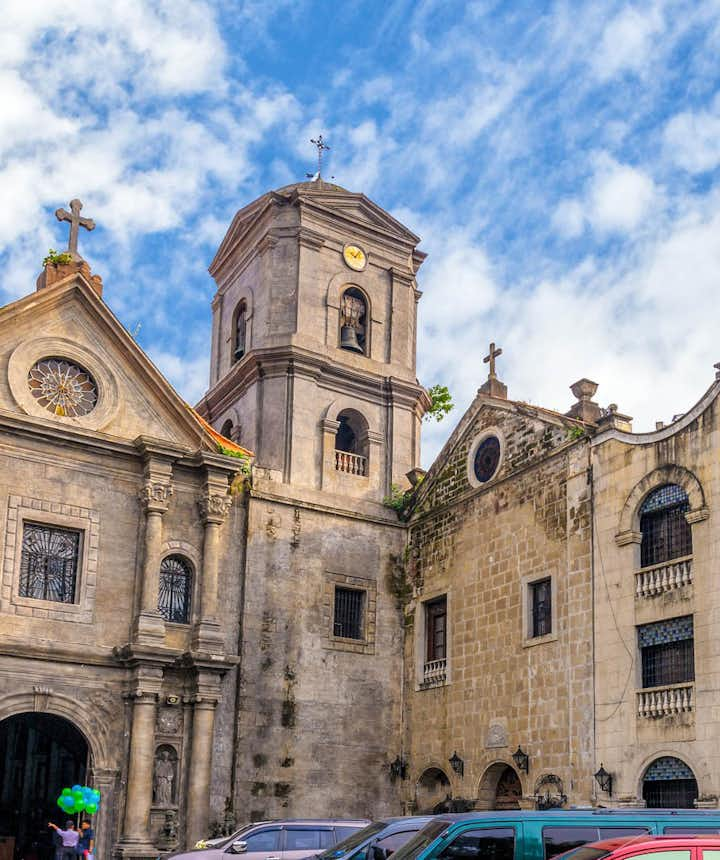

Top 23 Must-Visit Historical Places & Landmarks in the Philippines

- 23. Sheik Karim al Makdum Mosque, Tawi-Tawi
22. Leyte Landing Memorial Park
- 21. Sandugo Shrine, Bohol
- 20. Jose Rizal Shrine, Dapitan
- 19. Baler Church
18. Plaza Cuartel, Puerto Princesa
- 17. Emilio Aguinaldo Shrine, Kawit, Cavite
16. Mt. Samat, Bataan
15. tabon cave, palawan.
- 14. Basilica del Santo Niño, Cebu
13. Mactan Shrine, Cebu
12. edsa shrine, quezon city, 11. the ruins, talisay, negros occidental.
- 10. Fort San Pedro, Cebu
9. Binondo, Manila
8. tirad pass, ilocos sur, 7. barasoain church, bulacan.
- 6. Malacañang Palace, Manila
5. Fort Santiago, Manila
4. calle crisologo, vigan, 3. corregidor island, 2. rizal park, manila, 1. intramuros, manila.
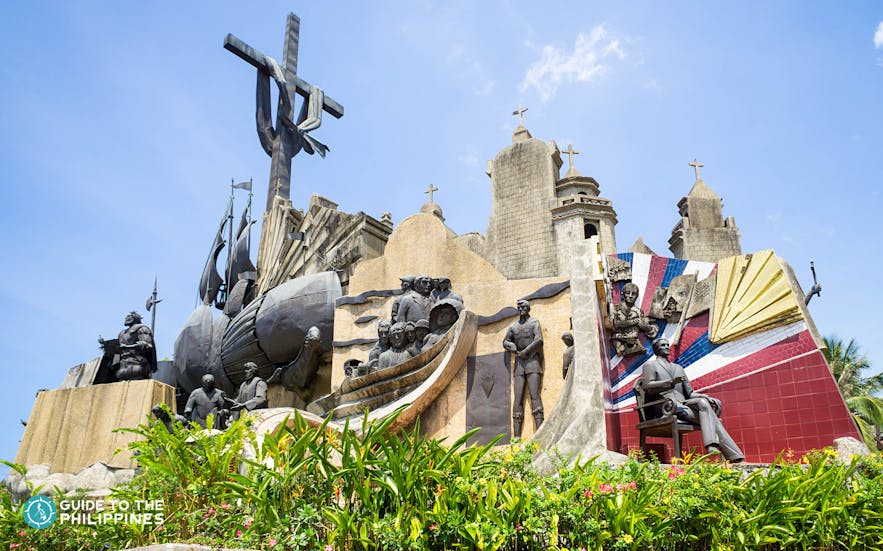
As the famous Filipina history buff Carmen Guerrero Nakpil said it, Philippine history can be described as “300 years in a convent and 50 years in Hollywood”. This nation of 7,000+ islands was colonised by the Spaniards for 333 years and by the Americans for almost half a century.
- Find the best history tours in the Philippines
Several landmarks across the country remain standing — with their walls, pillars, and grounds echoing stories of the Philippines’ tragic and triumphant past.
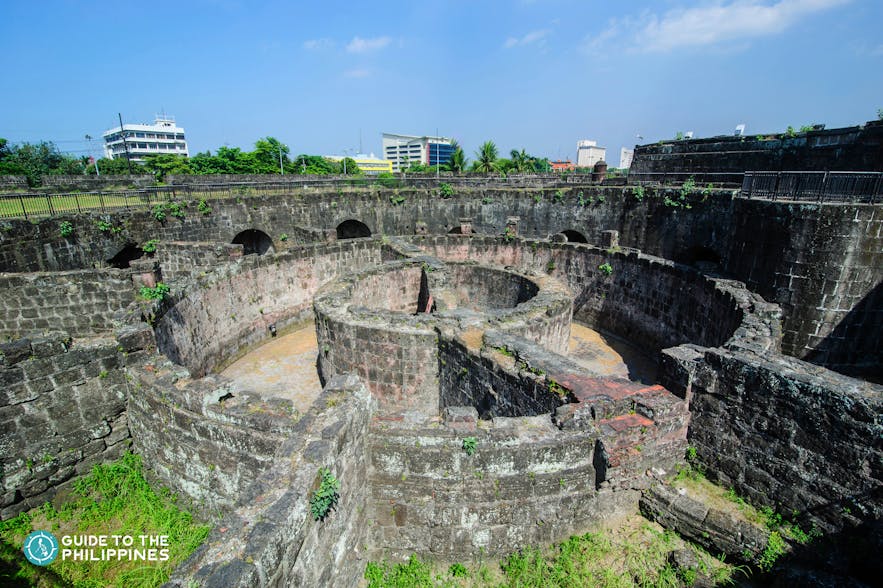
See our popular History Tours
Bohol chocolate hills countryside private tour with transfers & add-on loboc river cruise lunch, bohol countryside private tour with loboc river cruise lunch & transfers from cebu city, cebu city top attractions half-day private tour with transfers.
Aside from breathtaking beaches and awe-inspiring landscapes, here are some of the most notable historical places and important landmarks in the Philippines that are definitely a must-visit:
23. Sheik Karim al Makdum Mosque, Tawi-Tawi
Declared as a National Cultural Treasure, the Sheik Karim al Makdum Mosque in Simunul, Tawi-Tawi , is the oldest mosque in the Philippines.
Built in 1380 by Arab trader Sheik Makdum Karim, the mosque features pillars, made of Ipil hardwood, known to be some of the oldest Islamic artifacts in the entire country.
Islamic architecture and style is also popular for its intricate designs. A visit to this site gives you a glimpse of the colorful and rich Islamic culture that is prominent in the southern parts of the Philippines.
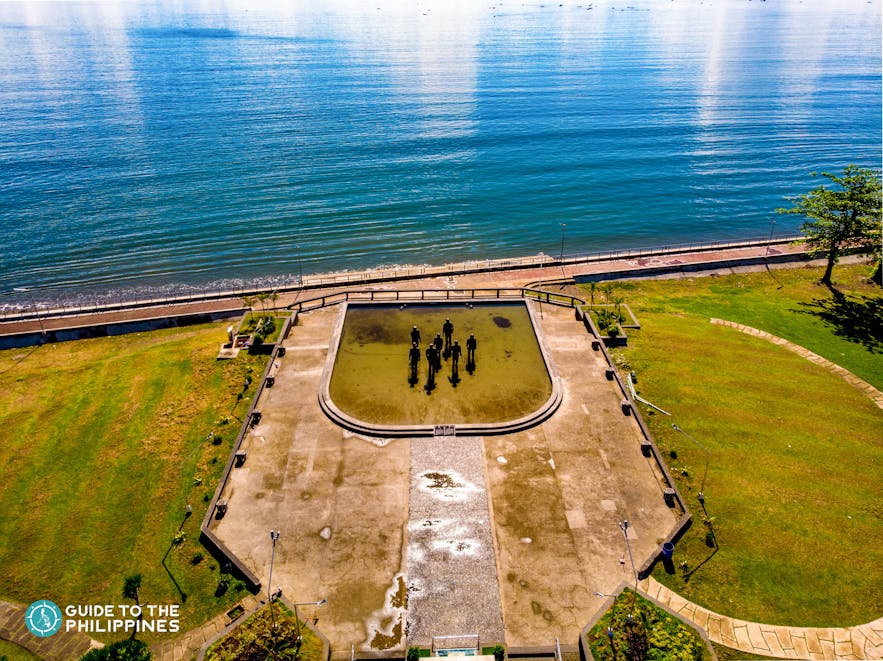
The Leyte Landing Memorial Park or also known as the MacArthur Landing Memorial Park in Palo, Leyte marks the site of General Douglas MacArthur’s return to the Philippines to fulfill his promise to the Filipinos in helping free the country from Japanese forces.
See our popular Leyte Tours and Activities
Kalanggaman island tour package from leyte with lunch, 21. sandugo shrine, bohol.
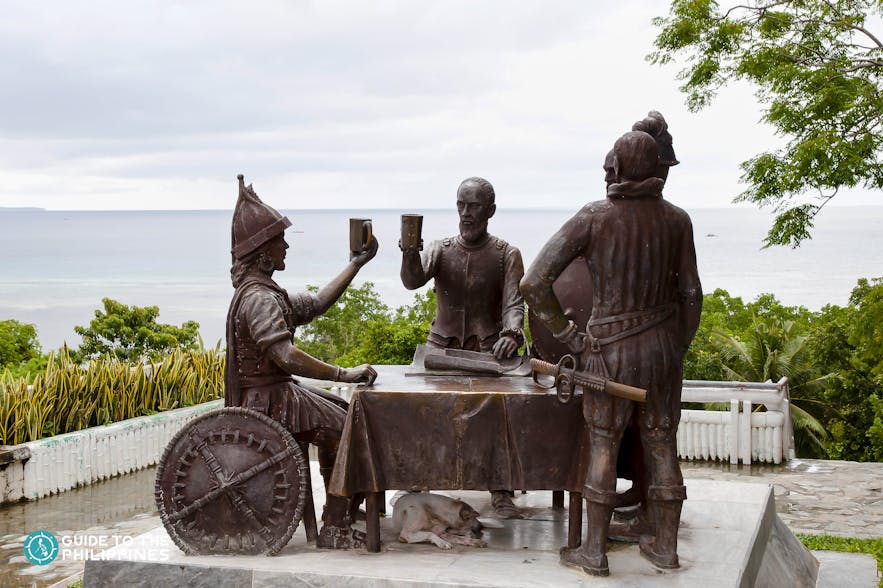
Browse Bohol tours for your trip
A bronze sculpture by National Artist Napoleon Abueva marks Sandugo Shrine, frequented by many tourists who come to Bohol , an island full of natural wonders such as the Chocolate Hills, Panglao Beach, and the world’s smallest primate, the tarsier.
See our popular Bohol Tours and Activities
Bohol countryside tour chocolate hills to loboc river cruise lunch with hotel transfers, bohol island hopping private tour to balicasag & virgin islands with dolphin watching & transfers, 20. jose rizal shrine, dapitan.
Down south of the Philippines is where you will find the Jose Rizal Memorial Protected Landscape, located in Dapitan, Zamboanga del Norte.
- Find the best tours and activities in Zamboanga
More commonly known as the Rizal Shrine, this area is where national hero Jose P. Rizal spent four years of exile when he was accused of planning the revolution against Spanish rule.
One of its most significant landmarks is the “Mi Retiro Rock” where Rizal spent time watching sunsets and where he penned one of his most beautiful poems w, Mi Retiro. Nearby the shrine is Dakak Park and Beach Resort.
See our popular Zamboanga Tours and Activities
Zamboanga pink sand sta. cruz island private tour with vinta ride, lunch & transfers, zamboanga city private historical day tour with transfers, dapitan zamboanga del norte day tour with optional side trip to dipolog city, 19. baler church.

Even after the declaration of Philippine independence, the Spanish fortified the church as a military post until they finally surrendered in 1899. It is said that the church’s structure was made from stones plastered by lime and honey.
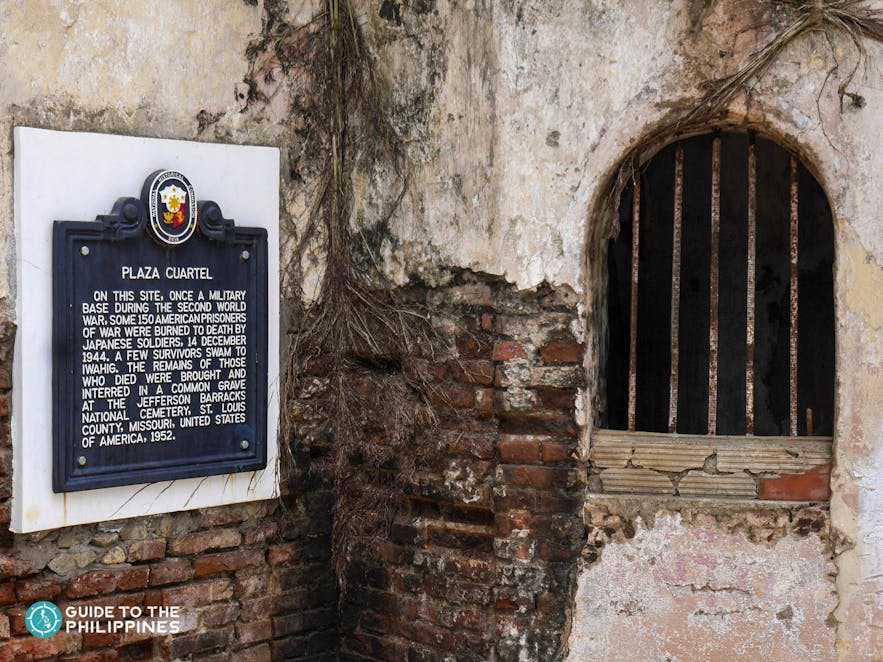
- Check out trips and experiences in Puerto Princesa
It previously served as a World War II garrison for Filipino and American soldiers. The landmark serves as a memorial for prisoners of war who were burned alive in an underground tunnel. It’s a tourist spot usually included in a day tour of Puerto Princesa .
See our popular Puerto Princesa Tours and Activities
Shared puerto princesa underground river tour in palawan with lunch & hotel transfers, private puerto princesa airport palawan to or from any puerto princesa city hotel transfer service, palawan puerto princesa honda bay island hopping tour with lunch | starfish, luli, & cowrie islands, 17. emilio aguinaldo shrine, kawit, cavite.
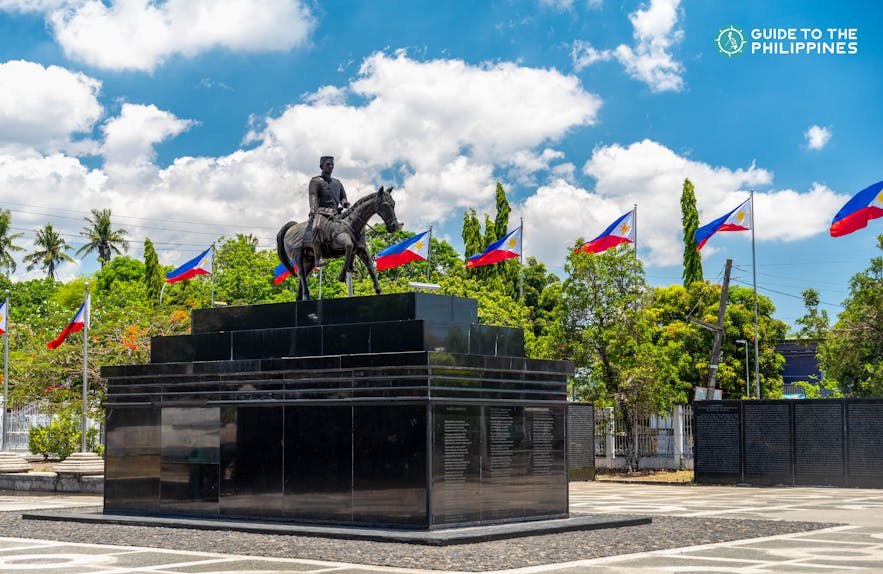
- Browse Cavite tours to explore this historical province
President Emilio Aguinaldo’s home is now a national shrine that also houses a museum filled with significant artifacts of the historic event.
Although the first Philippine flag was waved from one of its windows, a balcony was added in 1919. The house also features secret passageways and compartments, where important documents and weapons were once hidden. It’s a popular historic attraction included in a heritage tour in Cavite .
See our popular Cavite Tours and Activities
Coffee farm tour at amadeo cavite near manila & tagaytay with live brewing & tasting sampler.
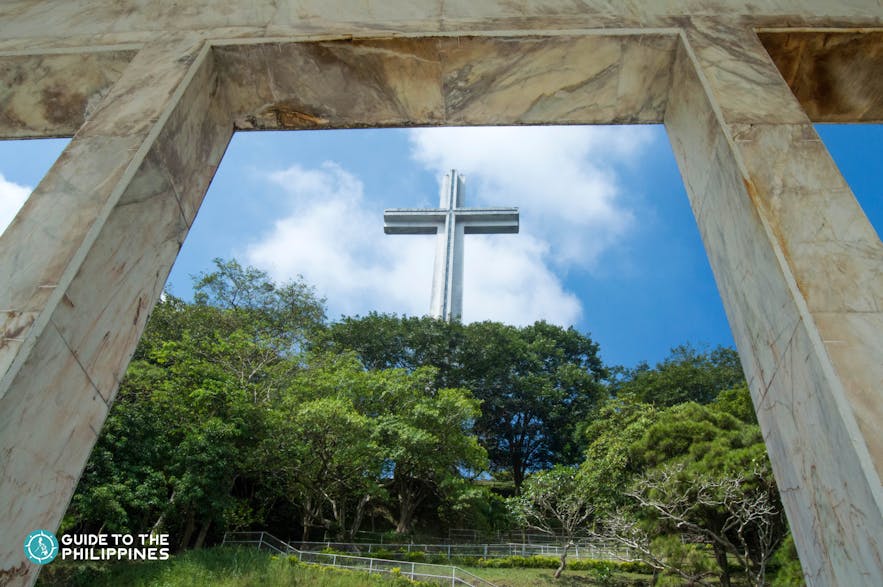
- Find the best Bataan tours to explore this province
This shrine was built to honor and commemorate all the Filipino and American soldiers who fought and died against Japanese forces during World War II.
The most prominent feature of the shrine is a large Memorial Cross, standing tall at 95 meters, finished with granolithic marble. This tourist spot is often combined with other heritage attractions in Bataan, such as Las Casas Filipinas de Acuzar.
See our popular Bataan Tours and Activities
Bataan & pampanga world war ii tourist spots shared day tour with transfers from manila, bataan las casas filipinas de acuzar shared heritage day tour with calesa ride & transfers, tarak ridge day hike in bataan from manila with papaya river side trip.
Dubbed as the Philippines’ Cradle of Civilization, the Tabon Caves in Palawan rose to fame when a skull cap, believed to be approximately 20,000 years old, was discovered in one of its sites.
Aside from the Tabon Man’s skull, several important artifacts such as stone tools, animal bones, and human fossils that date back to 47,000 years were also found in the caves.
A jar burial complex has also been found, with the Manunggul Jar featuring two figures on their journey to the after-life as the most famous find. Join a Tabon cave tour to explore this historical cave in Palawan.
See our popular Palawan Tours and Activities
Coron island hopping tour to kayangan lake & barracuda lake | palawan super ultimate package, private transfer - el nido palawan lio airport to/from any hotel in el nido town, 14. basilica del santo niño, cebu.
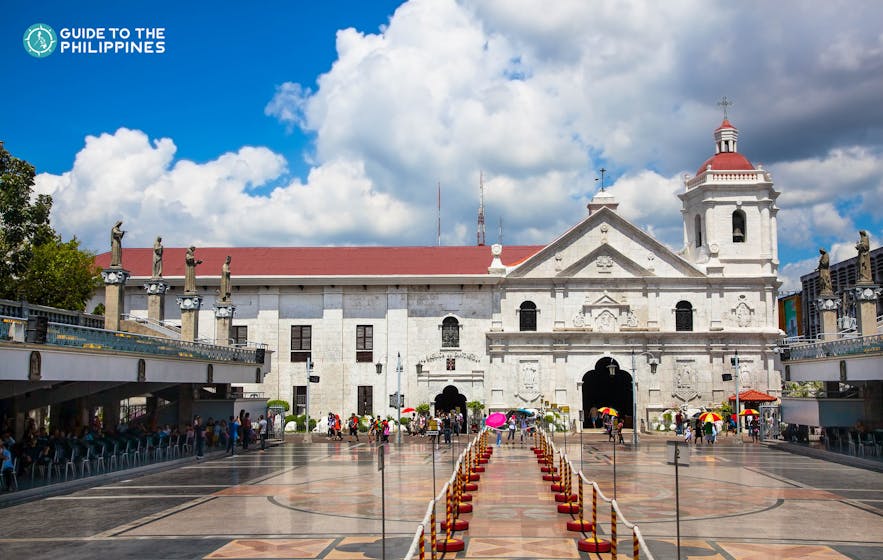
- Check out tours and activities to try in Cebu
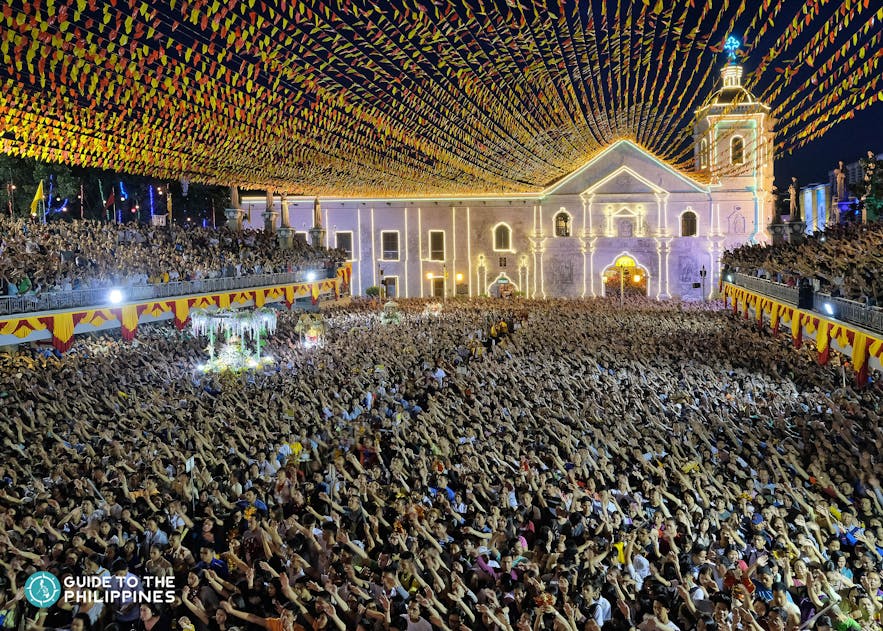
It houses a statue of the Child Jesus, the same one that Ferdinand Magellan gifted to then Queen Juana of Cebu. A visit to this magnificent historical and religious structure, surviving fires and a recent earthquake, is definitely one of the top things to do in the Philippines.
See our popular Cebu Tours and Activities
Private cebu airport to or from any cebu city hotel transfer service, cebu moalboal sardine run, pescador island & turtle bay tour with lunch & transfers from cebu city, cebu oslob whale shark watching & moalboal island hopping private day tour with lunch & transfers.

This Philippine landmark was erected in what is known to be the site of the Battle of Mactan, when the native leader defeated explorer Ferdinand Magellan in 1521.
While it mainly features a 20-meter bronze statue of Lapu-Lapu, a shrine for Magellan was also built, honoring him for bringing Christianity to the Philippines.
See our popular Mactan Island Tours
Cebu mactan parasailing, jet ski & banana boat watersports package with hotel transfers, cebu mactan jet ski, banana boat & parasailing watersports package, cebu mactan jet ski 1-hr rental.

Its original name is The Shrine of Mary, Queen of Peace, Our Lady of EDSA, but is more commonly known for its short name as it was built to remember the 1986 People Power Revolution that took place in the streets of Epifanio de los Santos Avenue or EDSA.
The revolution saw the ousting of then-President Ferdinand Marcos, who took the country under Martial Law. The most distinguishing feature of this landmark in Manila is a towering sculpture of the Virgin Mary atop the shrine’s church.
See our popular Manila Tours & Activities
Manila intramuros historical express 90-minute tour in eco-friendly bamboo bike + optional upgrades, manila binondo shared walking food tour with guide, manila intramuros shared half-day walking tour with guide.
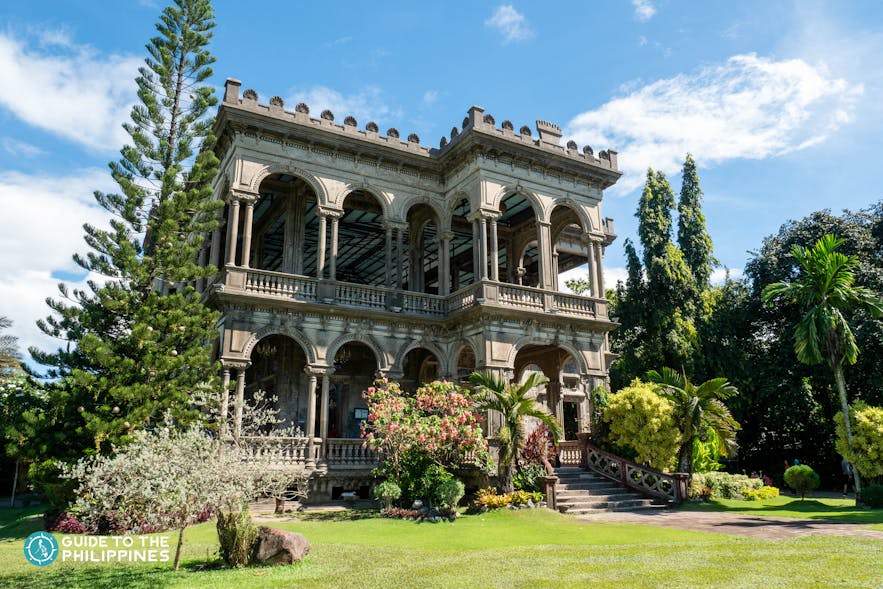
- Browse Bacolod tours that include The Ruins
Inspired by Italian architecture featuring Machuca-tiled floors and neoclassical pillars, the mansion was burned down by Filipino guerillas during World War II.
Its ruins remain a beautiful sight and has become a famous tourist spot included in a Bacolod sightseeing tour . Driving towards the landmark takes you through vast sugarcane plantations, which the province of Negros is known for.
See our popular The Ruins Tours
Bacolod city, the ruins & heritage houses history tour with lunch & transfers, bacolod, silay, talisay tri city tour with transfers | the ruins, campuestuhan resort, bacolod city half-day private tour with the ruins, lunch & transfers, 10. fort san pedro, cebu .
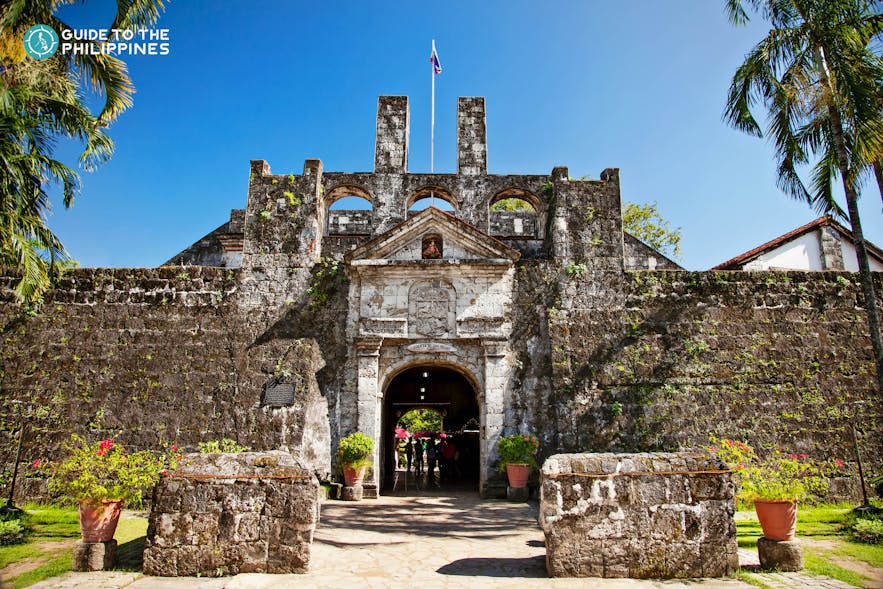
The fort houses a museum where you can find significant memorabilia, documents, and paintings highlighting the beginnings of Spanish rule in the Philippines.
As Cebu is becoming a highly urbanized metropolis, a trip to Fort San Pedro will make you realize that it’s a peaceful oasis in the city.
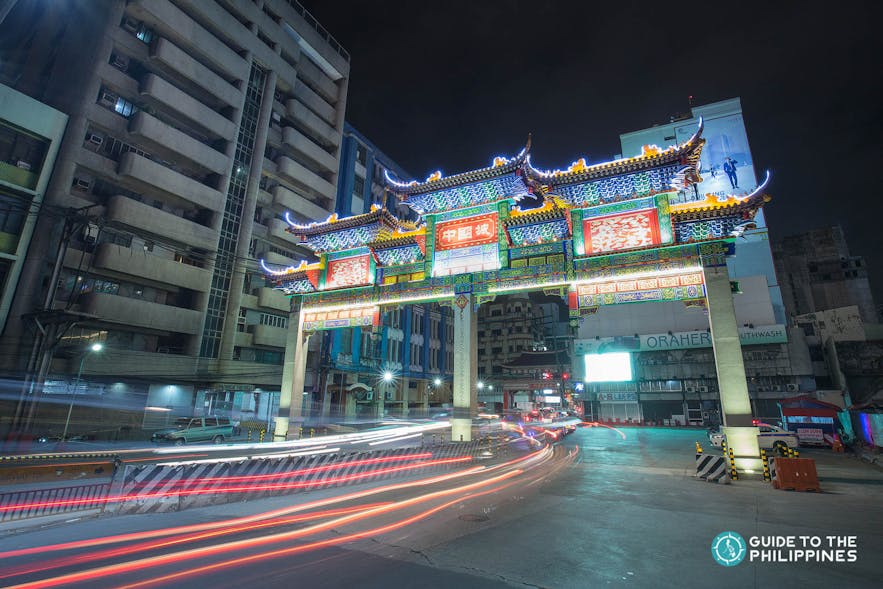
- Browse Binondo tours that you can join to explore the oldest Chinatown
Today, it is best enjoyed as a food tour destination in Manila, where you can sample signature fried chicken, fried siopao, noodle soups, and the most authentic dimsum you can ever find in the entire metro.
See our popular Binondo Tours
Manila binondo & intramuros full-day tour with guide & transfers, binondo manila basic photography lessons with light snacks | binondo church, dong bei dumplings.
What once was a bloodied war site has now become a favorite trail for adventure-seekers. The Tirad Pass in Mount Tirad, Ilocos Sur is of historic importance as it was the site of the 1899 Battle of Tirad Pass during the Philippine-American War.
- Check out tours in Ilocos for your trip
Epic mountain views and lush hills await those who hike up the trail, leading to the Shrine of Gregorio Del Pilar, in honor of the Filipino general who was killed during the battle.
See our popular Ilocos Tours and Activities
Ilocos sur vigan city heritage & sightseeing tour with horse-drawn carriage ride & transfers, vigan historical sightseeing city day tour with transfers & kalesa ride, laoag city heritage attractions, paoay lake, church & sand dunes day tour with transfers.
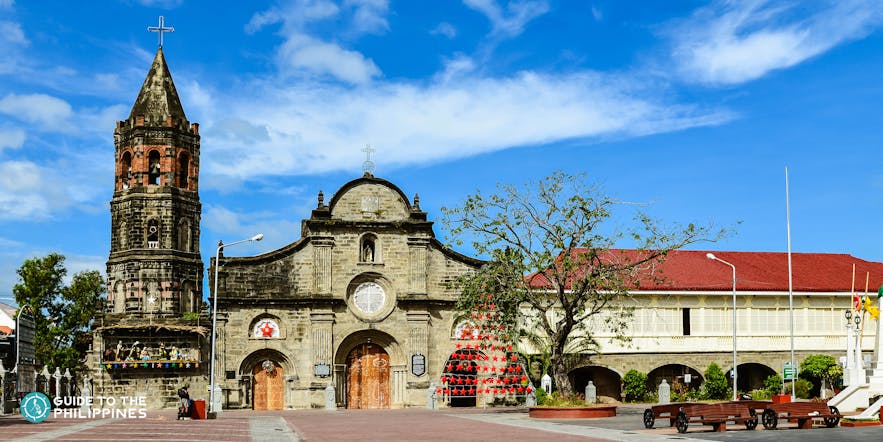
With its architecture reflecting Baroque and Neoclassical styles and features like rose windows, wood carvings, and painted domes, the Barasoain Church is not only a significant historic landmark but also one of the Philippines’ points of interest and structural beauty.
6. Malacañang Palace, Manila
Originally built in 1750 to house Spanish aristocrat, the Malacañang Palace has become the official residence and principal workplace of the president of the Philippines since 1935.
Open to the public is the Malacañang Museum, where you can visit the Presidential Museum and Library housing significant memorabilia and featuring awe-inspiring architecture.
A tour inside the palace complex also takes you to the San Miguel Parish Church, the only shrine in the entire world dedicated to the seven archangels. Tight security is to be expected in the entire area.
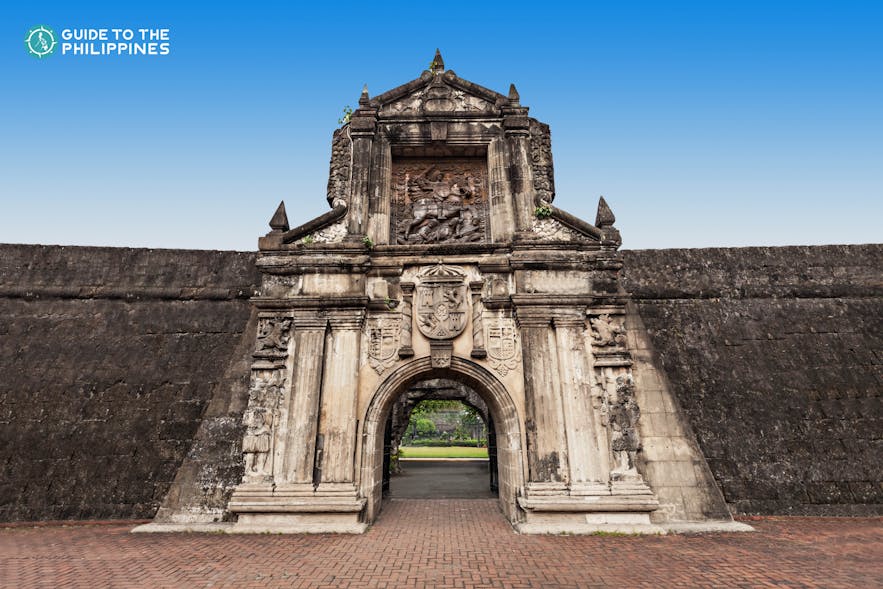
- Check out Fort Santiago tours in Manila
Ponds and fountains aside, it is most famously known for being the site of national hero’s Jose Rizal’s imprisonment shortly before he was executed in what is now known as the Rizal Monument in Rizal Park.
You can also find here the Baluarte de Santa Barbara, an 18th-century military barracks, if you’re planning to join tours in Intramuros .
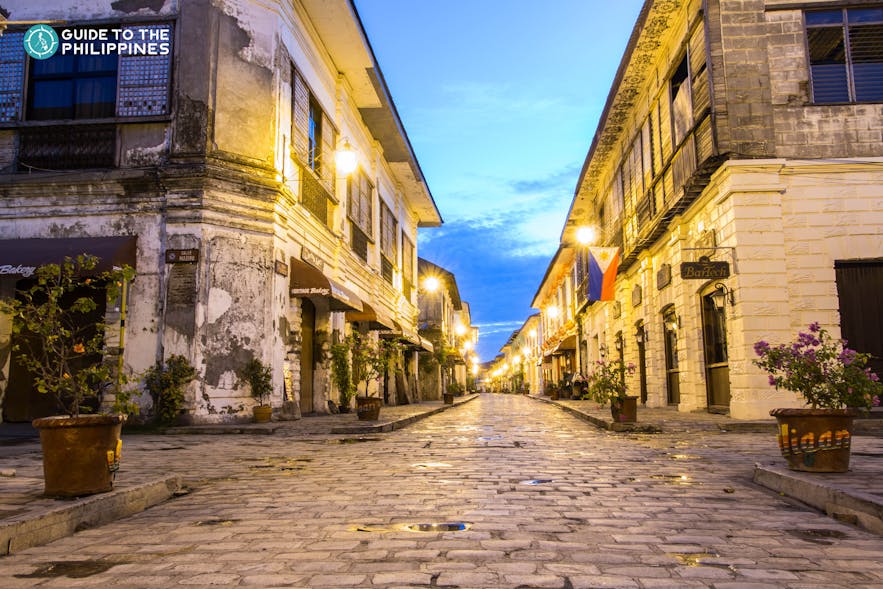
Travel back in time as you stroll through old-world charm, get mesmerized with Spanish colonial architecture, and enjoy delectable food such as the famous Ilocos Empanada.
While at it, buy a handicraft made of signature Abel Iloko weave in one of its many souvenir shops. So head up north, visit Vigan, and find some Calle Crisologo tours to try, as it’s one of the most beautiful attractions in the Philippines.
See our popular Calle Crisologo Tours
Ilocos sur tour to local production sites, weaving & empanada-making with transfers from vigan.
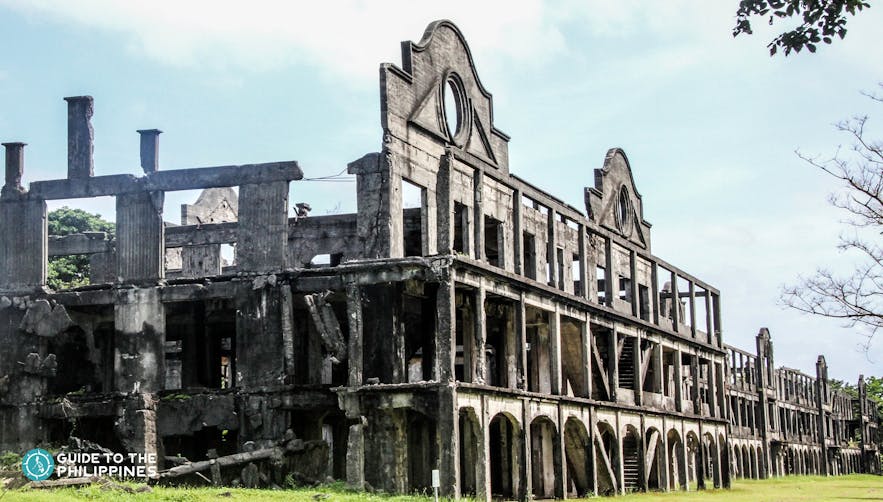
A day tour in Corregidor consists of visits to sites such as the Battery Way, Battery Hearn, and the Pacific War Memorial which was built in honor of all the Filipino and American soldiers who fought during World War II.
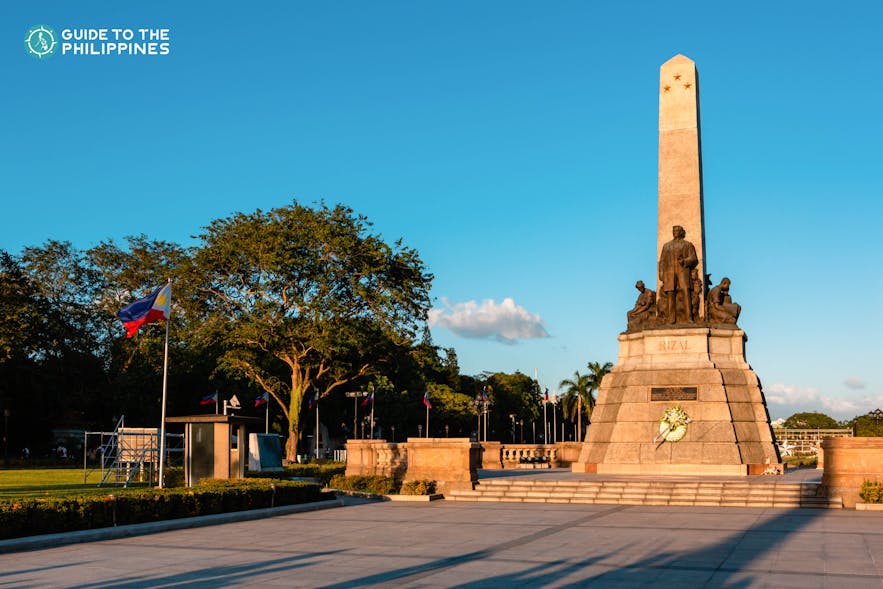
More commonly known as Luneta Park, this is where you will find the Rizal Monument, the actual site marking the execution of the Philippines’ national hero, Dr. Jose P. Rizal.
Some meters away from the monument takes you to the network of grand museums in the National Museum of the Philippines that must not be skipped.
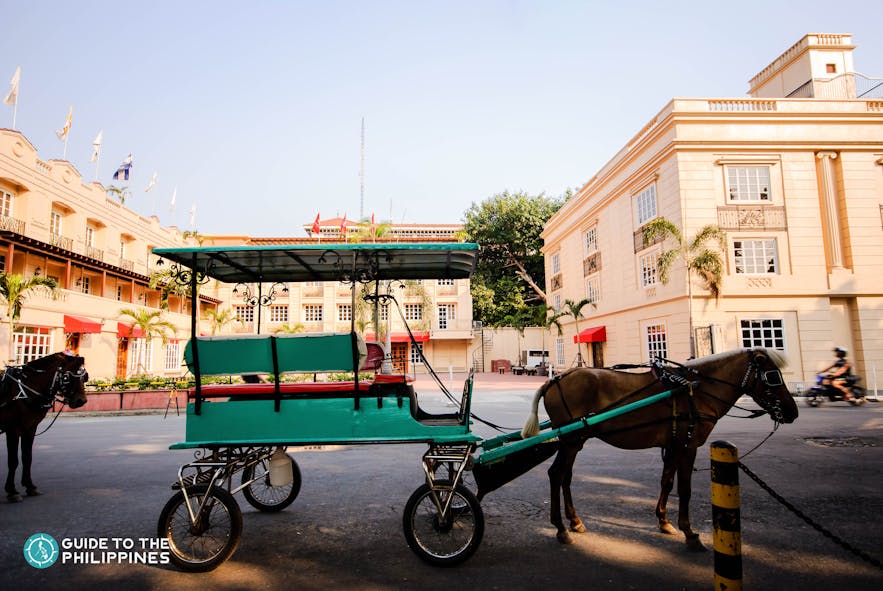
- Find the best Intramuros tours during your trip to Manila
Whether you're exploring by foot or on a bamboo bike tour , a wonderful time is guaranteed in this 64-hectare Spanish fortress erected during the Spanish era and finally destructed by the end of World War II.

See our popular Intramuros Tours
Manila intramuros half-day shared walking tour with guide.
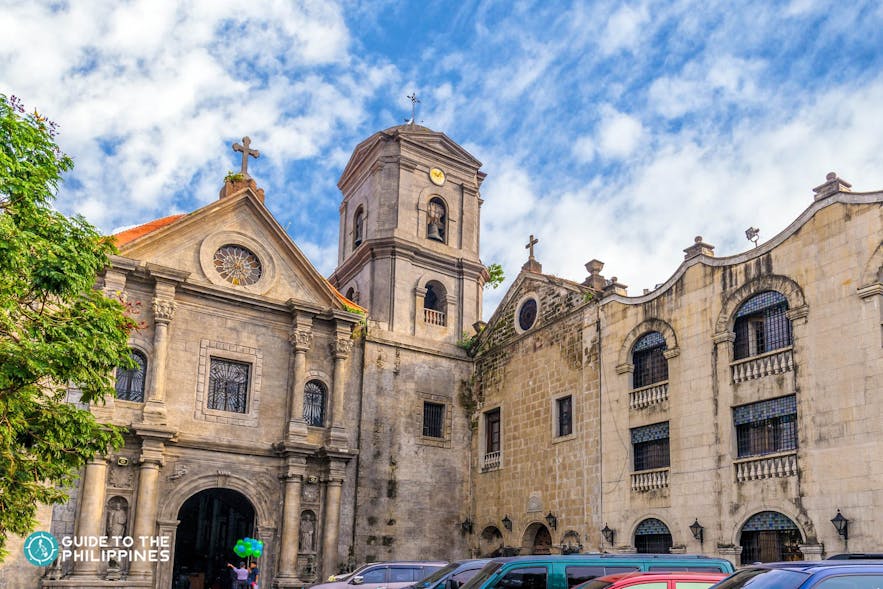
Popular articles

Best Palawan Guide: Top Tours, Where to Stay, How to Get Around
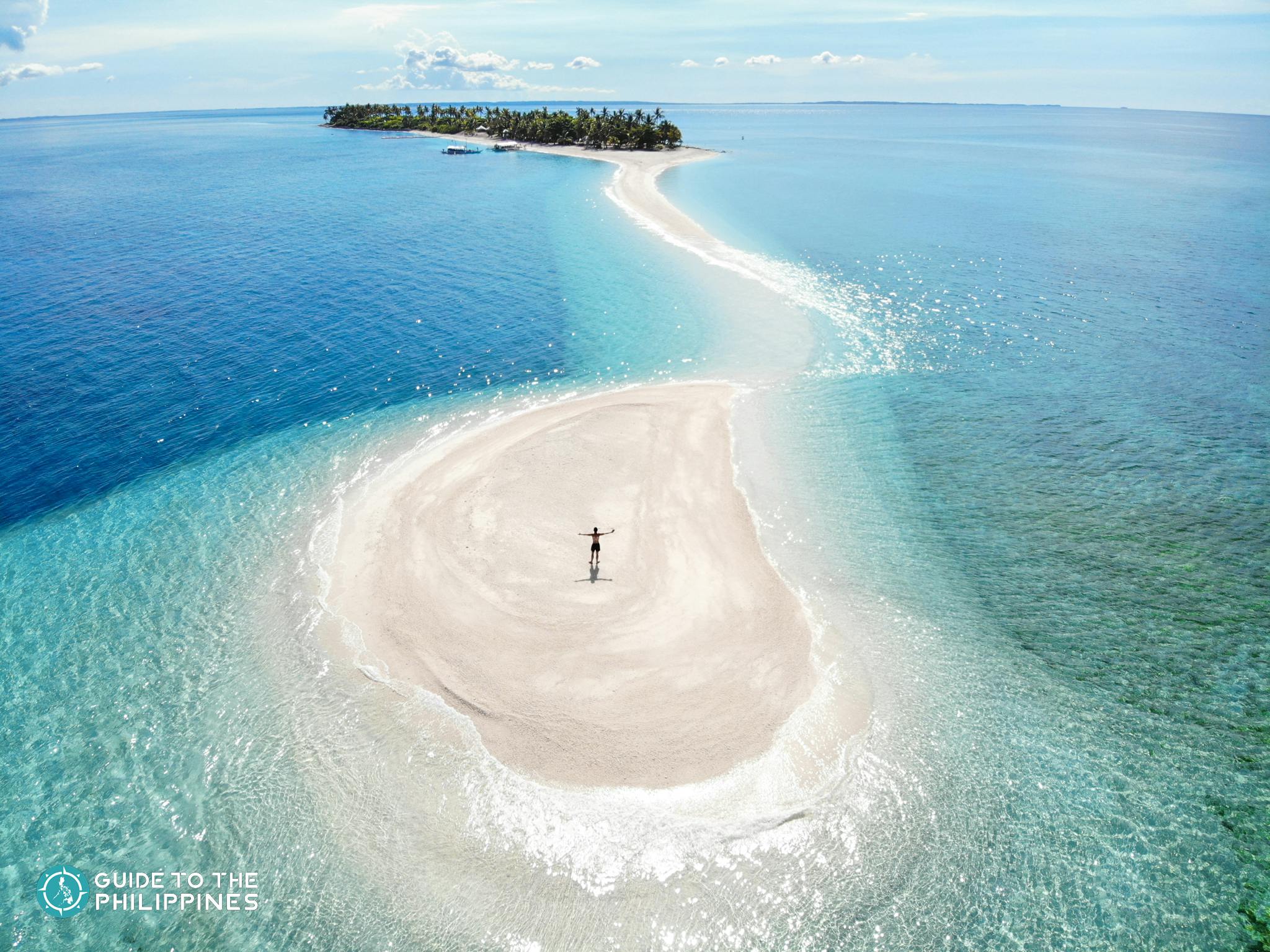
20 Most Beautiful Sandbars in the Philippines: White Sand, Longest, Vanishing
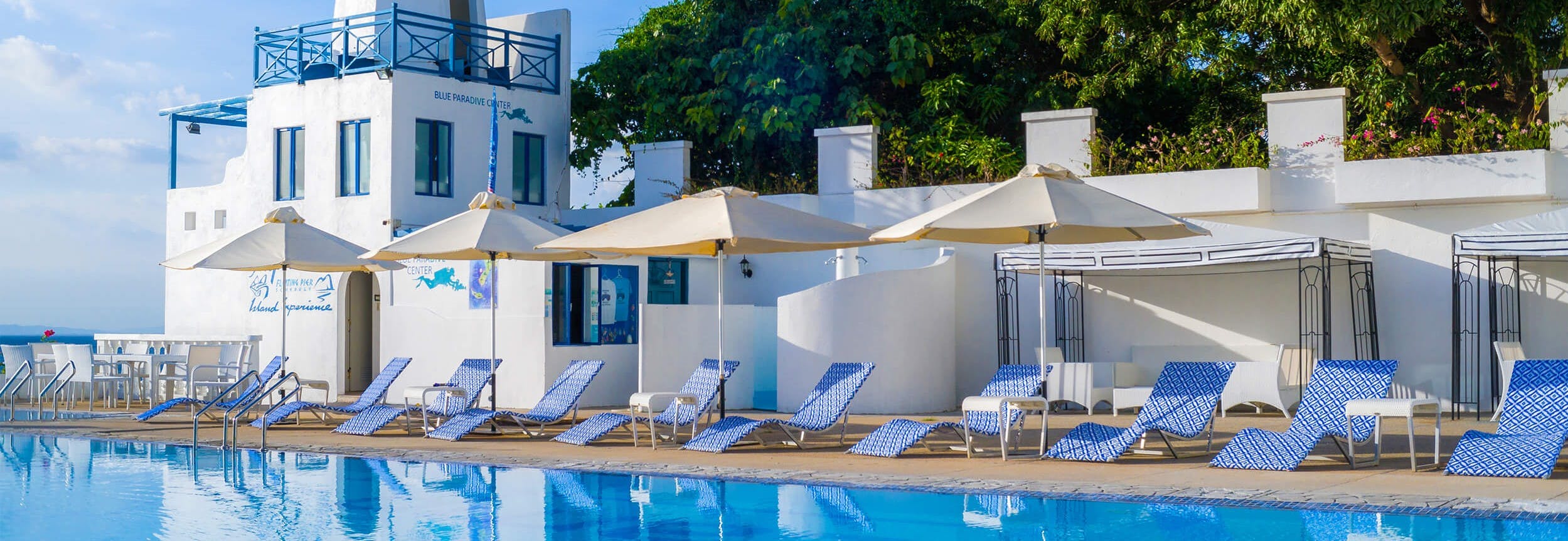
11 Best Santorini-Like Resorts in the Philippines: Near Manila, Cebu, Palawan, Vigan
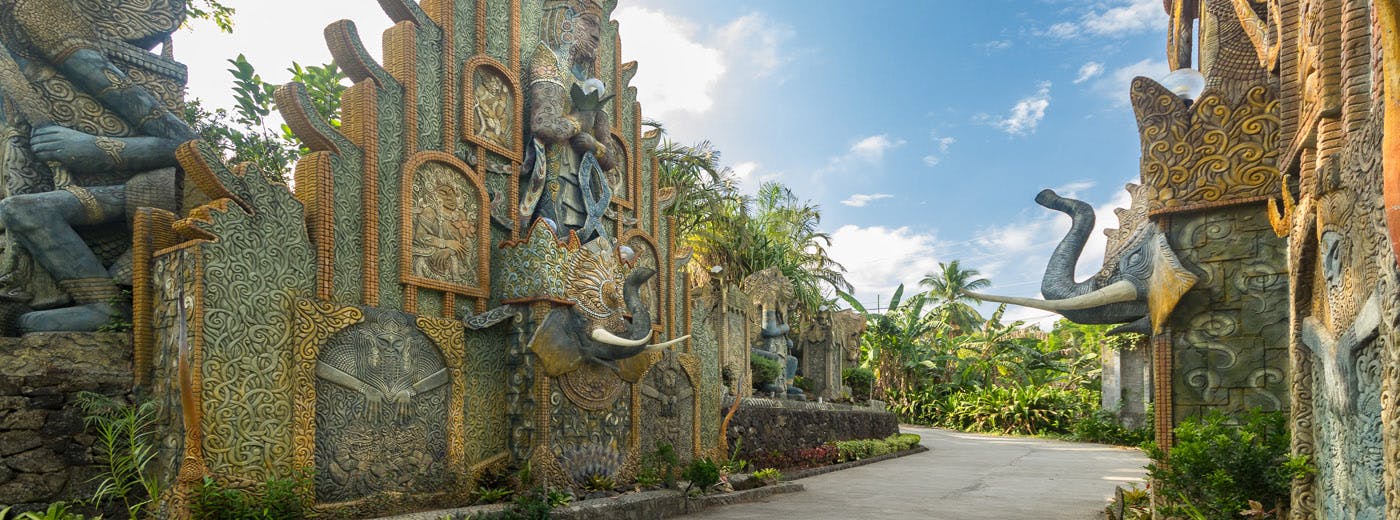
15 Best Tropical Bali-Like Resorts in the Philippines: Near Manila, Siargao, Cebu, Bohol
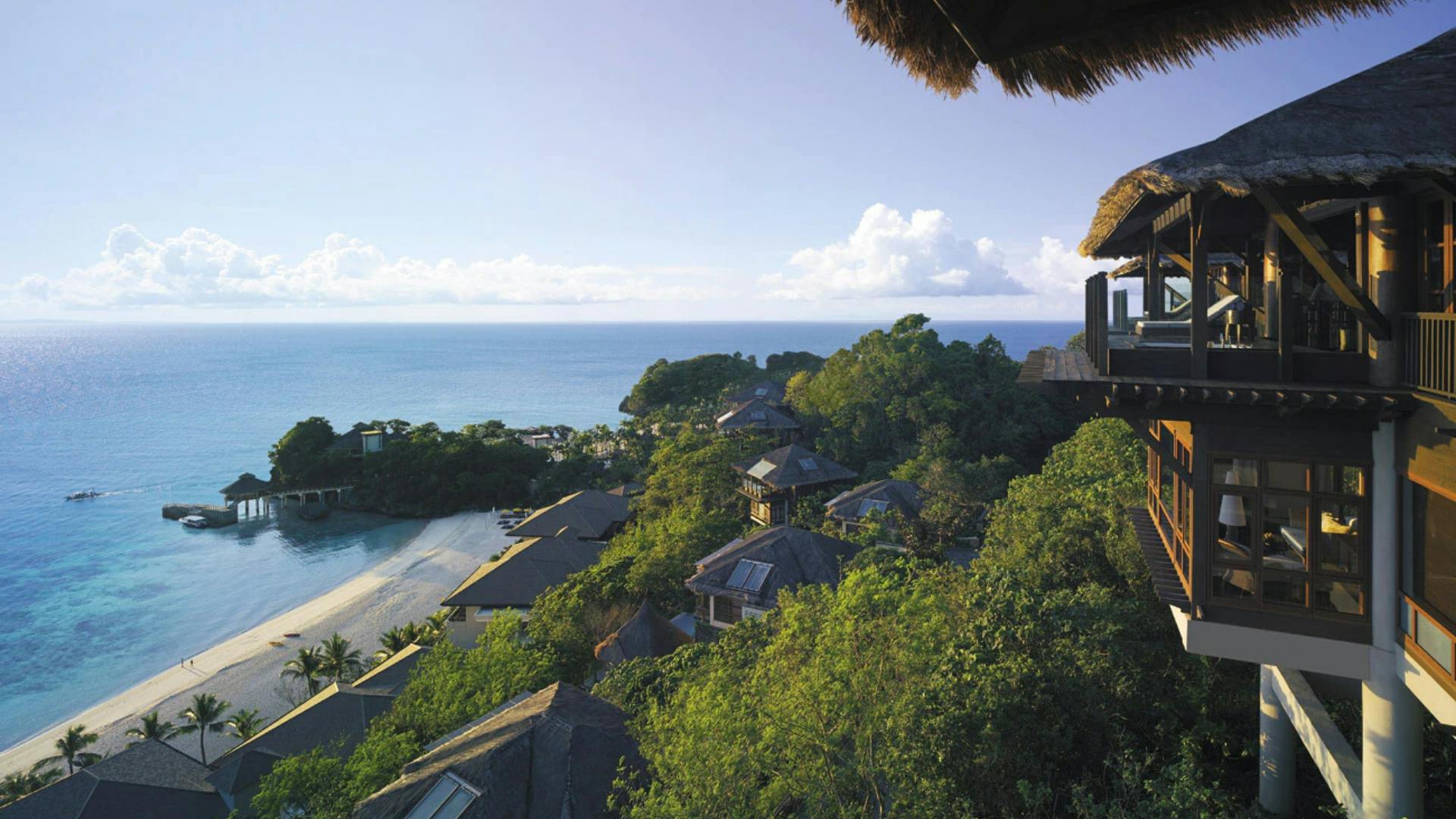
10 Best Treehouse Resorts in the Philippines for a Scenic Getaway at Mountains, Beaches & Rivers
Other interesting articles.
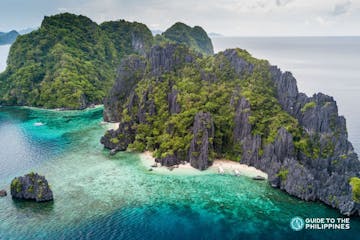
Best 2-Week Philippines Itinerary Guide: Visit Boracay, Palawan, Cebu and More!
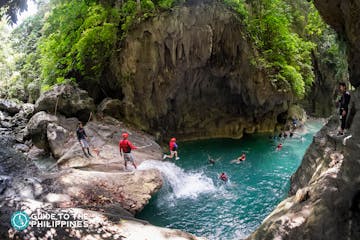
First Time in Cebu? Check Out These Top 5 Tourist Spots and Activities
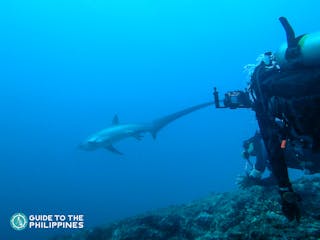
Top Things to Do in Malapascua Island: Thresher Sharks Diving & Beaches

Download the Philippines’ biggest travel marketplace to your phone to manage your entire trip in one place
Scan this QR code with your phone camera and press the link that appears to add the Philippines’ biggest travel marketplace into your pocket. Enter your phone number or email address to receive an SMS or email with the download link.
Top things to do in the Philippines
Discover all the adventures you can experience in the Philippines
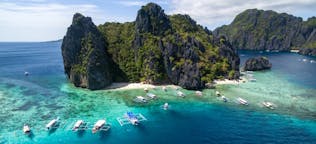
Philippines Tour Packages
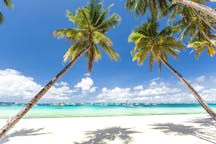
Boracay Island
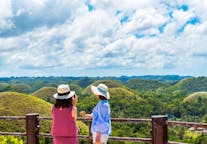
Bohol Island
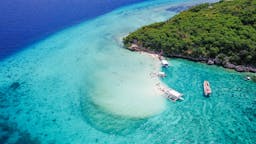
Cebu Island
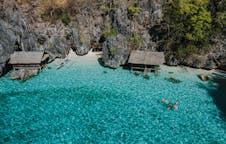
Coron Palawan
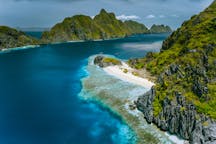
El Nido Palawan
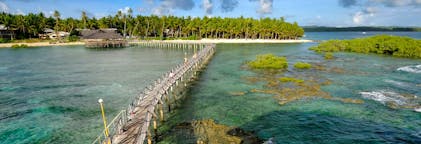
Siargao Island
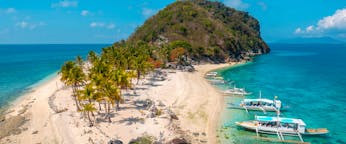
Iloilo City and Nearby
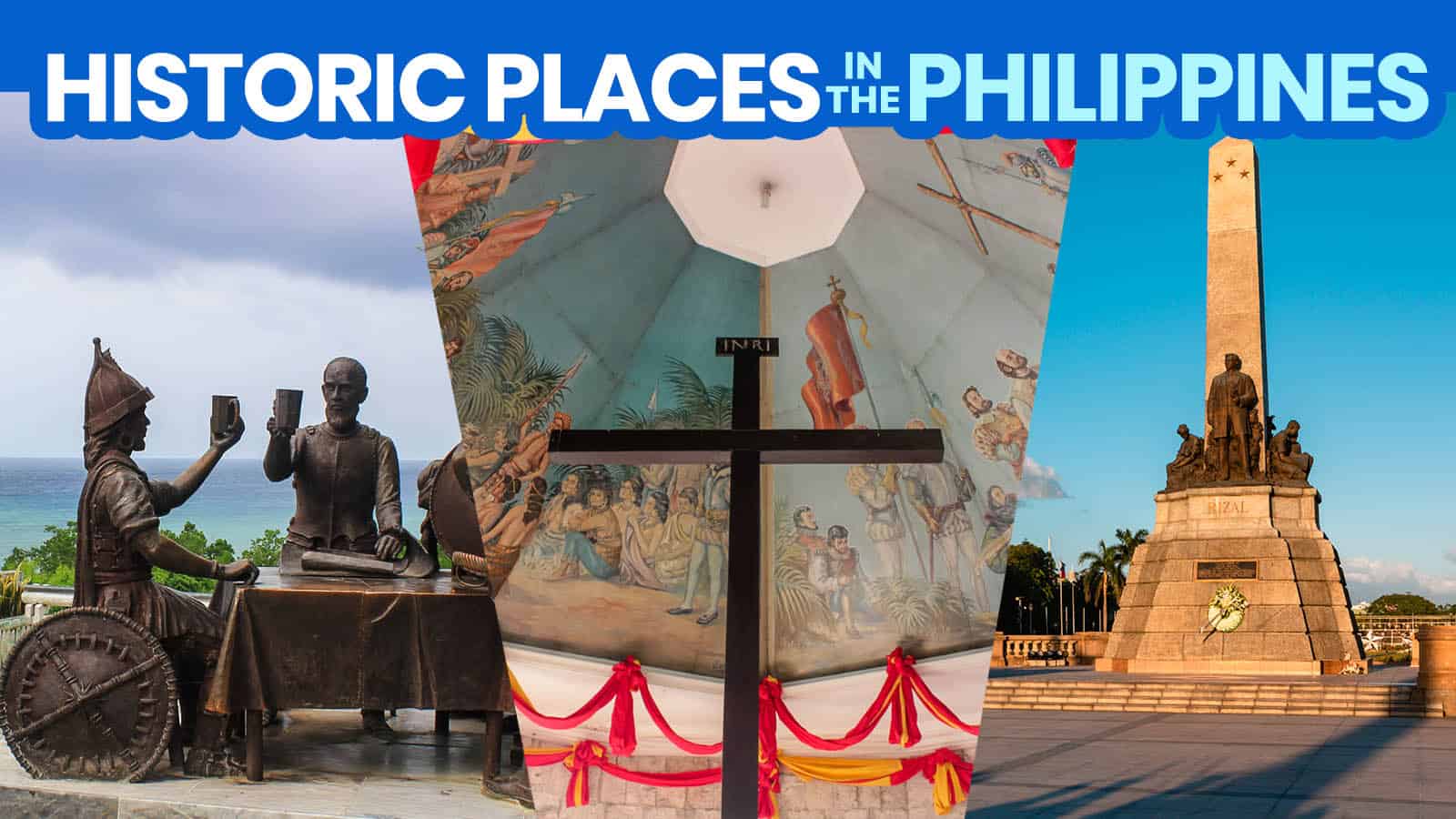
25 HISTORICAL PLACES IN THE PHILIPPINES in Araling Panlipunan / HEKASI Books

The very first travel flame in my young mind was sparked by textbooks. My first intense desire to go places was lit by HEKASI — Heograpiya, Kasaysayan at Sibika (Geography, History and Civics), which is now called Araling Panlipunan . In grade school, I was so fascinated by the photos of historic places. I’ve marveled about the lives of prominent personalities and notable events that shaped history.
Now that I’m a travel blogger, there’s always a sense of fulfillment whenever I set foot in a place that was featured in my elementary history books. Though it may sound privileged, travel is a great history teacher, and it reignites the lessons about the past that we learned when we were kids and those we need to relearn today.
If you are a history buff and looking for places in the Philippines to cross off your travel bucket list, here’s a list featuring some of the monumental sites in the country.
WHAT'S COVERED IN THIS GUIDE?
1. Intramuros, Manila
Considered the political, educational, and religious center of the Spanish Empire in the Philippines and the historic core of Manila, Intramuros used to be an opulent walled city, strategically located along the Manila Bay. It was the seat of Spanish rule from the late 16th century to the 19th century. The walls were constructed between 1590 and 1872, encompassing what was then the entire city of Manila.
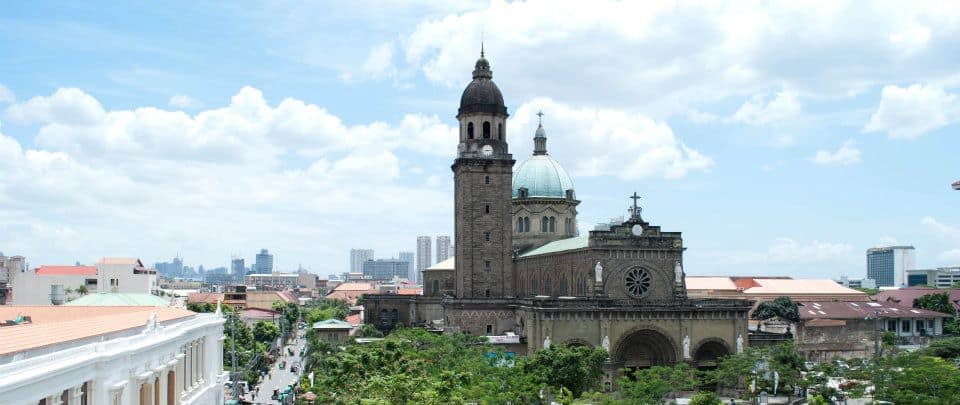
Up to this day, it houses many significant landmarks like the Manila Cathedral, San Agustin Church (UNESCO World Heritage Site), Casa Manila, Baluarte de San Diego, and Fort Santiago, where the national hero Jose Rizal was incarcerated.
The original campuses of the University of Santo Tomas and Ateneo de Manila used to be within the fortified city until the first half of the 20th century. There are still well-preserved structures like the cobblestone streets, parts of walls, and other buildings.
Location: Intramuros, 5th District of Manila, Manila, NCR
✅ JOIN A WALKING TOUR HERE!
2. Rizal Park, Manila
Situated on the southern border of Intramuros, Rizal Park is a 58-hectare historic urban park, one of the largest in Asia.
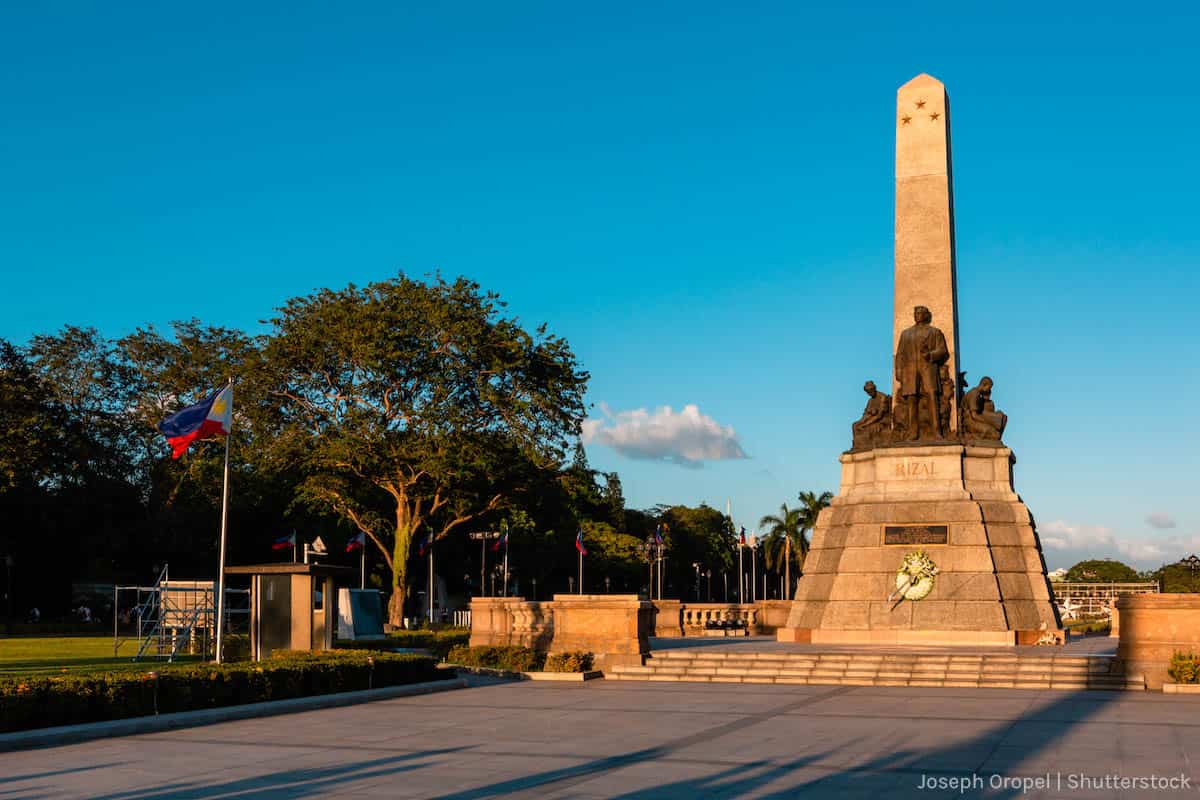
Its history dates back to 1820 when Paseo de Luneta was built on the former location of Bagumbayan . During the Spanish rule, especially in the 19th century, the park was the site of numerous public executions, the most notable were that of Rizal and the GomBurZa (Gomez, Burgos, and Zamora) priests. Other historic events held here were the declaration of Philippine independence from the United States in 1946 and the 1986 EDSA Revolution.
The most outstanding landmark of the park is the Rizal Monument , where his remains lie and marked by a statue made of bronze and granite. Declared a national park in 1955 as Luneta National Park , it was then renamed Rizal Park in 1967 in honor of the country’s national hero.
Other points of interest within the park are the National Museum Complex (National Museum of Natural History, the National Museum of Anthropology, National Planetarium), Independence Flagpole, Musical and Dancing Fountain, Botanical Garden, Quirino Grandstand, and San Lorenzo Ruiz Plaza.
Location: Roxas Boulevard, Ermita, Manila, NCR
3. Binondo, Manila
Driving further north of Intramuros, across the Pasig River through Jones Bridge, the huge and intricate New Binondo Chinatown Arch greets and bids commuters and city dwellers.
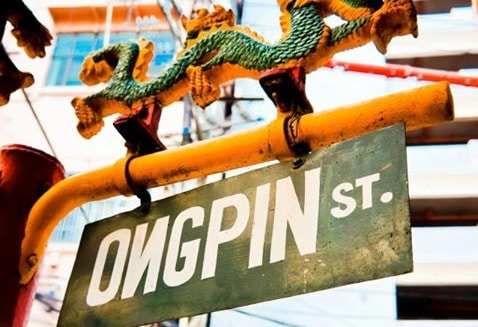
Established in 1594, Binondo is the first and the oldest Chinatown in the world. That alone makes this a worthy historical destination. The location just outside Intramuros was strategic in the sense that the Chinese Catholic immigrants could still continue trading while being monitored by the Spanish government in the 16th century. Up to this day, the area is a hubbub of trade and commerce, mostly run by Filipino-Chinese residents.
One of the main draws of Binondo is its colorful and delicious food scene. There are so many gastronomic gems scattered around this extensive food hub, most of which cannot be found anywhere else but in Binondo. Other famous products have branched out, but local tourists still visit the origin of their favorite Binondo grubs.
Other places of interest are Ongpin Street, Escolta Street, Plaza San Lorenzo Ruiz, and Binondo Church.
4. Rizal Shrine, Calamba, Laguna
Declared by the National Historical Commission of the Philippines as a national shrine, the structure stands on the same location of the Rizal family’s ancestral house.
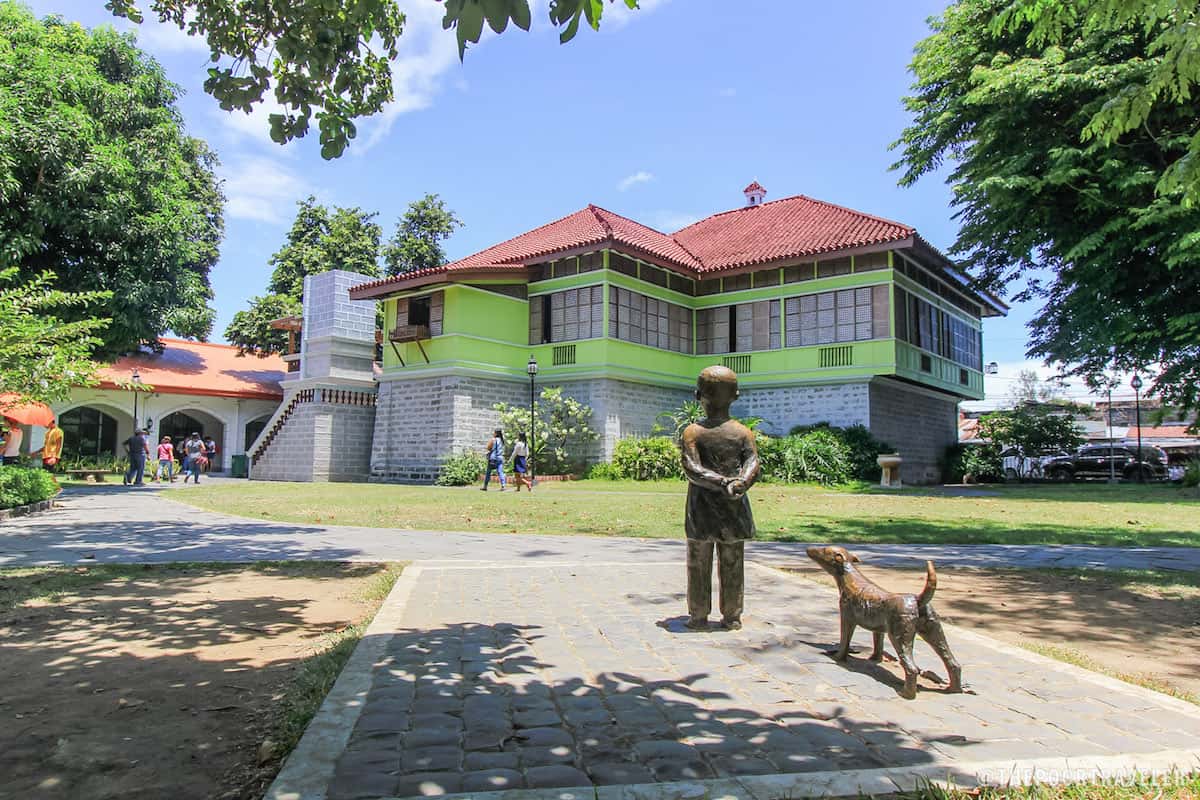
It is a reconstructed version of the original two-story Spanish-era bahay na bato . Using similar materials like hardwood, adobe stones, bricks, and capiz shells among others, the reconstruction began in 1949, as ordered by then-President Quirino, and was launched to the public on the 19th of June 1950, in time for the 89th birthday celebration of Rizal. The only deviation from the original exterior appearance is the walls painted in green instead of the original white.
As the birthplace of Rizal, it features collections and memorabilia that center around his childhood. The shrine also cradles the remains of Jose Rizal’s parents. The property also houses a library, a gallery, an audio-visual room, and a souvenir shop. Other landmarks near the shrine are St. John the Baptist Parish Church and the City College of Calamba.
Location: Corner of Rizal Street and Mercado Street, Poblacion 5, Calamba, Laguna
5. Banaue Rice Terraces, Ifugao
Built by the ancestors of the indigenous people of Ifugao centuries ago, the Banaue Rice Terraces was declared by the government as a National Cultural Treasure in 1973.
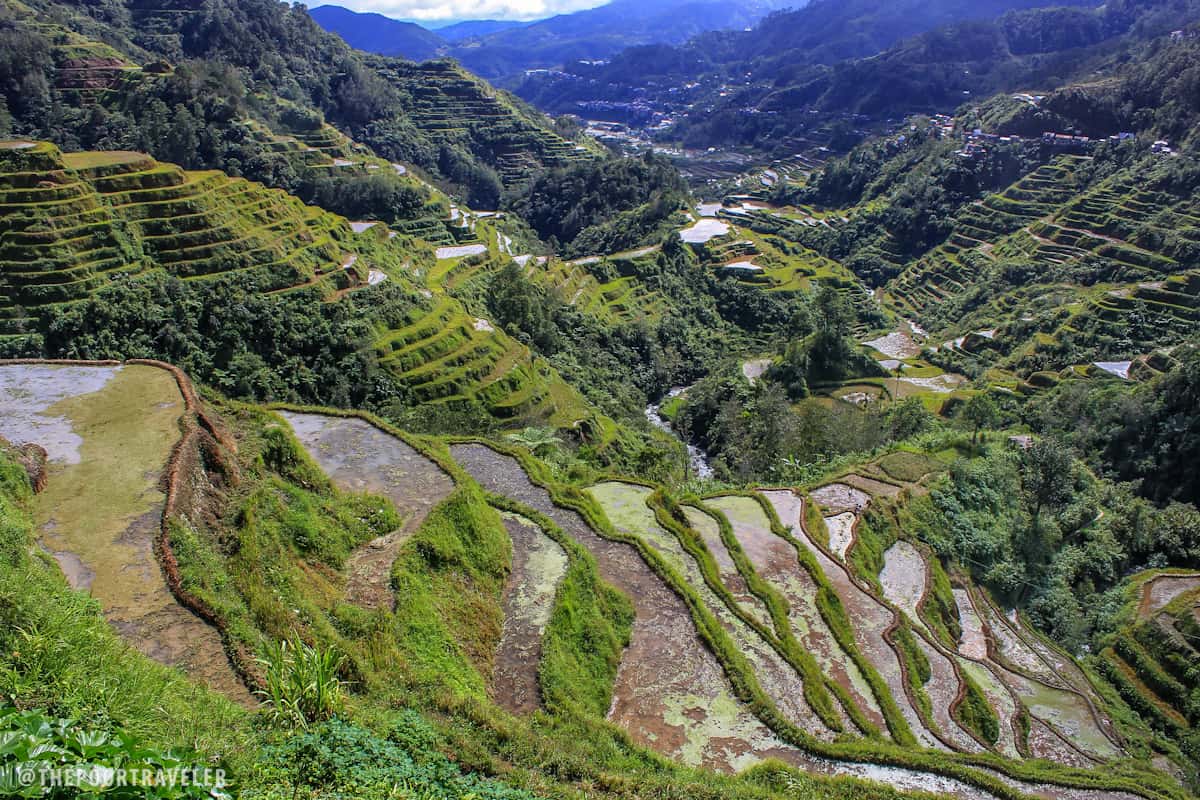
These terraces embody the culture of the Ifugao people, which was largely influenced by rice cultivation and agriculture. The importance of these terraces is evident in the many agricultural rites connected to rice production. The traditional and indigenous techniques applied in building the terraces reveal the extensive knowledge of the Ifugao people in earthwork, stonework, irrigation, and the preservation of the integrity of the rice terraces.
Interestingly, the Banaue Rice Terraces is not included in the UNESCO World Heritage List under the Rice Terraces of the Philippine Cordilleras due to the presence of modern structures in the area. However, two of the five listed are located not too far away — the Batad Rice Terraces and the Bangaan Rice Terraces. The Banaue Rice Terraces are the ones that can be seen from different view decks along the main road (Nueva Vizcaya-Ifugao-Mountain Province Road).
Location: Banaue, Ifugao, CAR
6. Tabon Cave Complex, Palawan
Situated on Lipuun Point in the town of Quezon on the southwestern part of Palawan Island, the cave complex is part of the Lipuun Point Reservation , protecting and preserving the cultural and historical artifacts within the area.
Cradling numerous important archeological artifacts like the Tabon Man , the oldest modern human bones in the Philippines; and the Manunggul Jar , a National Cultural Treasure and one of over a thousand burial jars discovered in the cave complex.
Designated as a National Cultural Treasure by the National Museum in 2011, the complex is said to have 215 caves, but only seven of these are accessible to the public including Tabon, Igang, and Liyang among others.
Location: Lipuun Point, Quezon, Palawan
7. Mactan Shrine, Cebu
Located along Punta Engaño Road on the northern part of Mactan Island in Cebu, the Mactan Shrine encompasses two monuments: the Lapu-Lapu Shrine on one end and the Magellan Marker (also Magellan Monument) on the other.
The site faces the Magellan Bay, a reminder of the Battle of Mactan, which took place in April 1521 between the Spanish troops led by Portuguese explorer Magellan and the Mactan natives led by Lapu-Lapu. The battle led to the defeat of the Spaniards, causing them to retreat.
If you get hungry while exploring the shrine, try the traditional Visayan sutukil from the nearby Sutukil Seafood Market Restaurant Chain.
Location: Punta Engaño Road, Mactan, Cebu
8. Magellan’s Cross, Cebu City
Located adjacent to Basilica Minore del Santo Niño in the heart of Cebu City, the Magellan’s Cross is one of the most visited historical landmarks in Cebu.
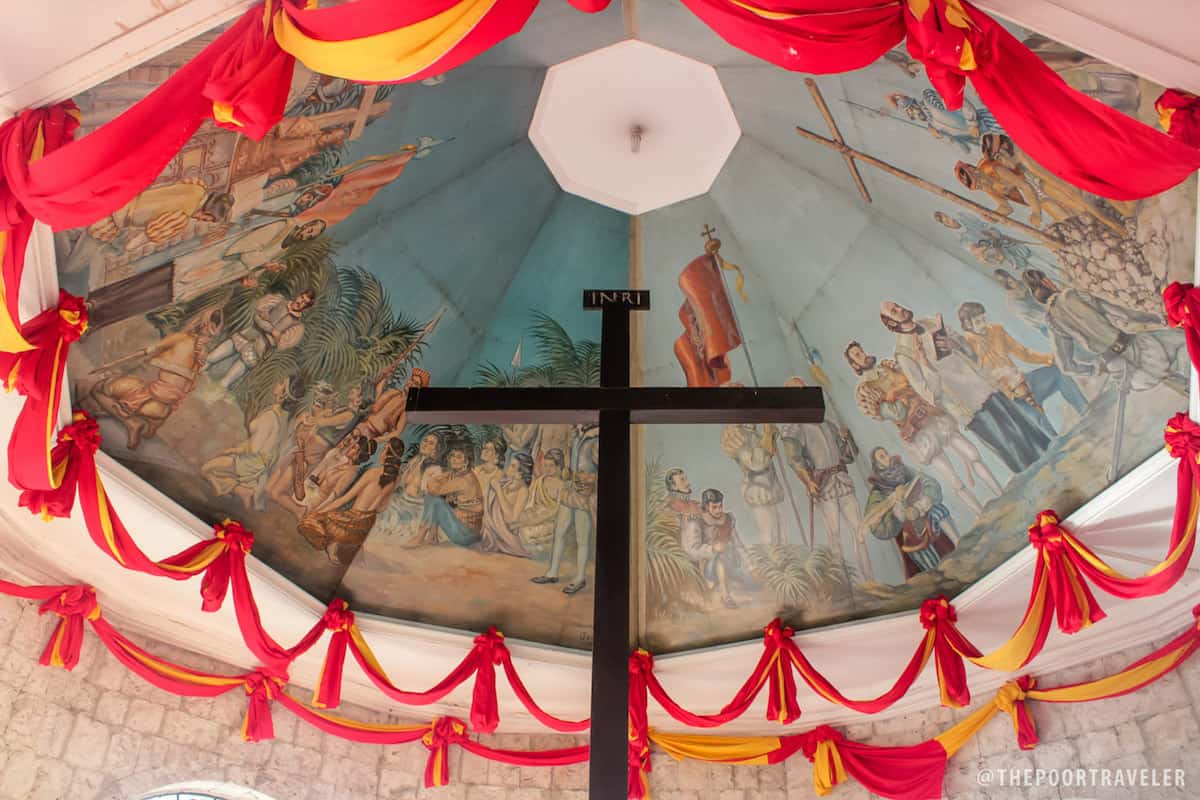
The site is said to be the exact location where Portuguese Magellan planted the cross upon his arrival in Cebu in March 1521. As stated on the marker at the bottom of the cross, the original artifact is encased inside the wooden Tindalo cross. The painted ceiling illustrates this historic event.
Location: P. Burgos Street or D. Jakosalem Street, Cebu City, Cebu
9. Sandugo Shrine, Bohol
In March 1565, a blood compact between Spanish explorer Miguel López de Legazpi and Bohol chieftain Sikatuna took place as a symbol of friendship between the Spaniards and the Filipinos. This was famously called the sandugo , a tribal tradition sealing allegiance and confirming solidarity between tribes. Both representatives cut their arms and pour their blood into a cup, divide the mixture equally, and drink them until both cups are emptied.
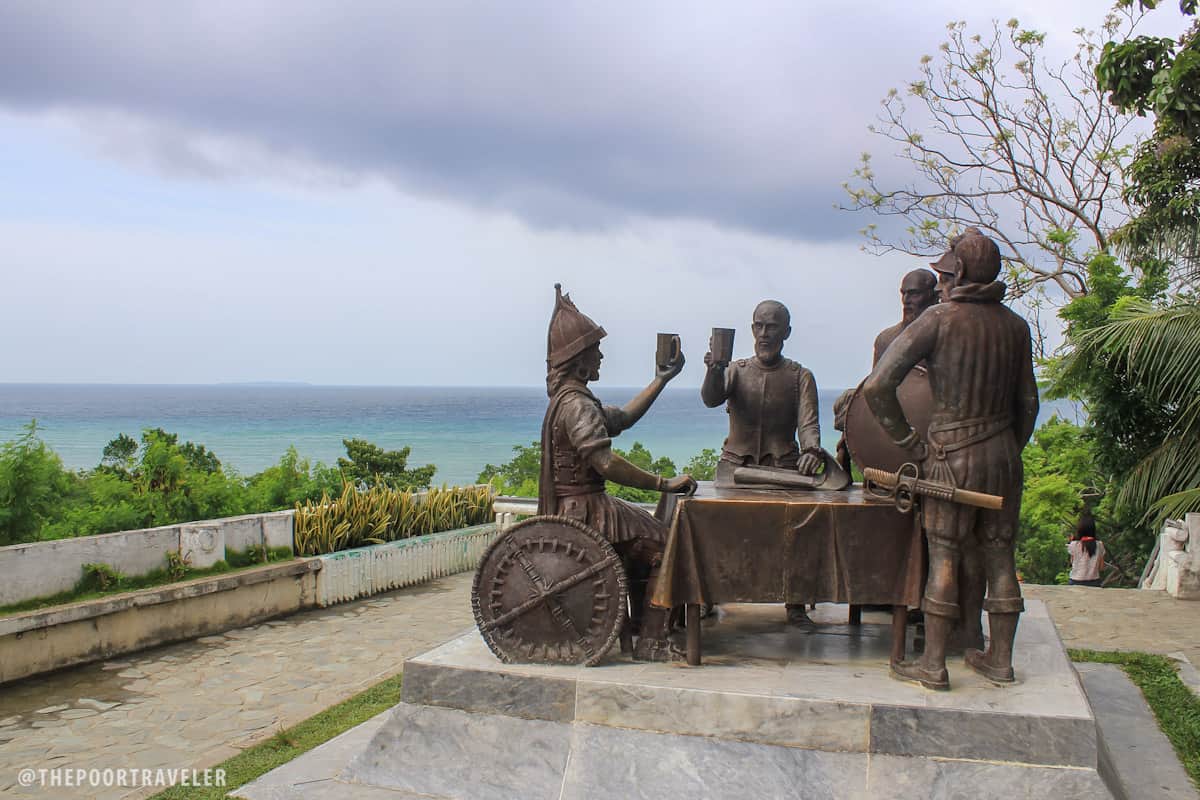
The moment is immortalized by the Sandugo Shrine (Blood Compact Shrine) in Tagbilaran City. But the truth is, this monument does not mark the actual spot where the historic treaty was made. In 2006, the government of Bohol determined the actual site where it happened to be in Loay, the municipality between Alburquerque and Loboc.
The actual site, now called Blood Compact Marker , is situated along Bohol Circumferential Road/Tagbilaran East Road.
Location: Bool, Tagbilaran City, Bohol
10. Barasoain Church, Malolos, Bulacan
“Baras ng Suwail”
The dungeon of the defiant. The 19th-century Barasoain Church witnessed many monumental events in the history of the Philippines. It served as the headquarters of the illustrados who were against the Spanish rule and was the site of one of the most pivotal events in Philippine democracy — the Malolos Congress , also known as the First Philippine Congress.
The Malolos Congress was formed in June 1898 by Emilio Aguinaldo in defiance of the Spanish regime. Although this one was short-lived, this was a testament to the Filipinos’ passion for democracy.
This Baroque church is made of adobe and concrete materials and is centrally located in Malolos.
Location: Paseo del Congreso Street, Malolos, Bulacan
11. Aguinaldo Shrine, Kawit, Cavite
Declared a National Shrine in June 1964, the Aguinaldo Shrine encompasses the whole ancestral house and grounds of Emilio Aguinaldo and extends to the park across the main house.
This was the site of the proclamation of Philippine Independence from Spain on June 12, 1898 with the unfurling of the Philippine flag. This was also the event where the instrumental music of the Philippine national anthem was first heard. Every year, a flag-raising ceremony is held during the Independence Day celebration.
Completed in 1845, the mansion has undergone renovations in 1849 and 1919. It was donated to the government by Aguinaldo himself and is currently being managed by the National Historical Commission of the Philippines. The lush garden behind the mansion nestles the final resting place of Aguinaldo. The main house functions as a museum now.
Location: Tirona Highway, Kawit, Cavite
12. Leyte Landing Memorial Park
“I shall return.”
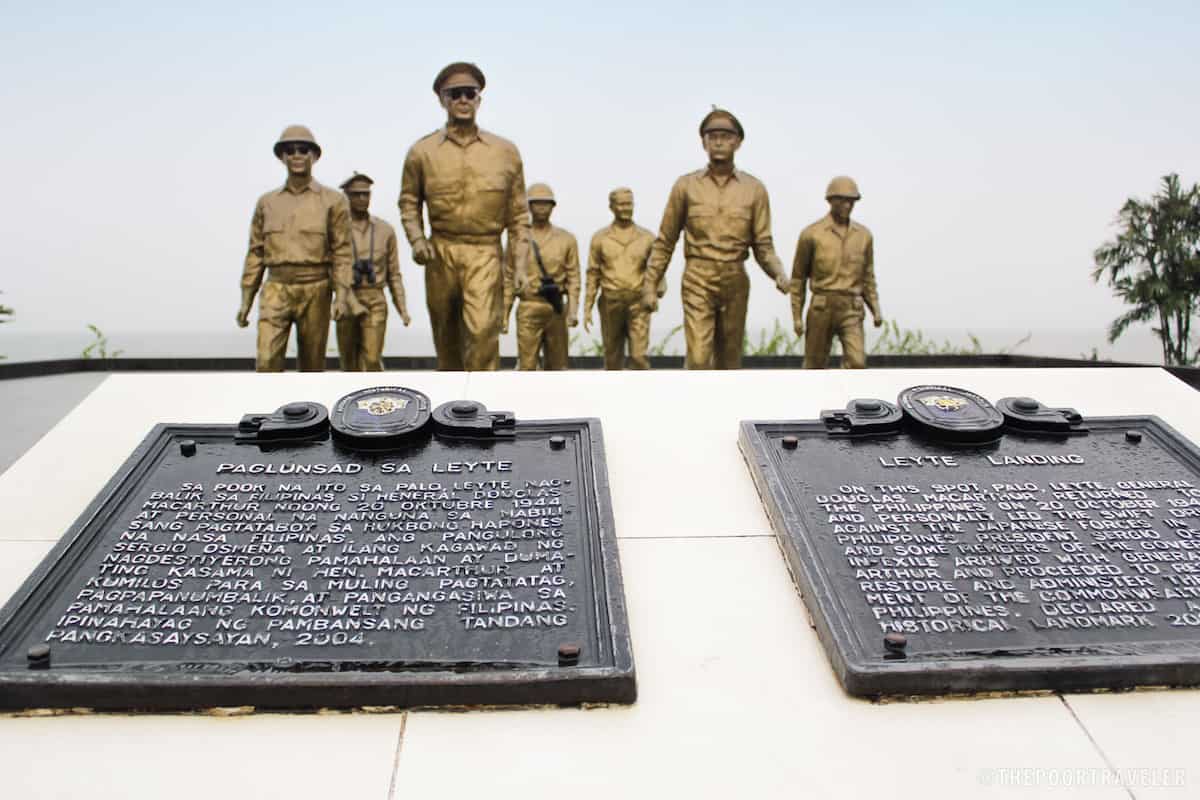
Proclaimed a national park in July 1977, the MacArthur Leyte Landing Memorial National Park (also called MacArthur Park) was also designated as a national historic landmark by the National Historical Commission in 1994.
This park was established in celebration of a significant event in history, the A-Day Landing in October 1944, where Douglas MacArthur, together with his entourage, finally fulfilled his promise to come back and help the Philippines gain back its independence from the Japanese. A few days later, the Battle of Leyte Gulf, the largest naval battle of World War II erupted.
The memorial national park features a shallow manmade pool with seven bronze statues representing General Douglas MacArthur, President Sergio Osmeña Jr., Brigadier General Carlos P. Romulo, Major General Courtney Whitney, Lieutenant General Richard Sutherland, Sergeant Francisco Salveron, and William J. Dunn. The memorial park faces the San Pablo Bay/Leyte Gulf.
Located: Barangay Candahug, Palo, Leyte
13. Dambana ng Kagitingan, Bataan
Established in 1970, the Dambana ng Kagitingan , also known as the Mount Samat National Shrine or Shrine of Valor, is a memorial complex honoring the fallen Filipino and American soldiers who fought against the Japanese in the Battle of Bataan in 1942.
Mount Samat was the last bastion of freedom where many lost their lives fighting for independence against the Imperial Japanese Army. It was declared as a National Shrine in April 1966.
The complex also harbors the Colonnade , stretching wide and welcoming visitors from the parking lot. The Colonnade houses a war museum. The most dominant feature is the colossal white Memorial Cross with the Cross’s arms serving as a viewing gallery. Further behind the Colonnade are paths leading to the base of the cross. The whole complex offers a panoramic view of Bataan and Corregidor Island.
Location: Mount Samat Road, Pilar, Bataan
14. Bataan Death March Markers
Three months after the Battle of Bataan , the Japanese army decided to transfer about 75,000 Filipino and American prisoners of war from Bataan to Camp O’Donnel (now Capas National Shrine) in Capas, Tarlac. This was called the Bataan Death March because this long, brutal walk claimed the lives of thousands of Filipino soldiers and hundreds of American soldiers.
Each kilometer is marked by a modest white obelisk stand with illustrated Death March sign and plaques. There are a total of 138 Death March Markers — 97 in Bataan, 33 in Pampanga, and 8 in Tarlac — dotting the roads between Bataan and Tarlac with the one in Mariveles, marking the Kilometer 0.
These markers are managed by the Filipino-American Memorial Endowment (FAME), a non-stock and non-profit foundation. They are also raising funds for the continuous maintenance of these historical markers.
15. Corregidor Island
Strategically situated at the mouth of Manila Bay and facing the West Philippine Sea, Corregidor Island played an important role as a military base during World War II. Nicknamed “The Rock”, this fortified island was part of the harbor defenses, protecting Manila Bay from enemy attacks. The island suffered massive destructions after the war.
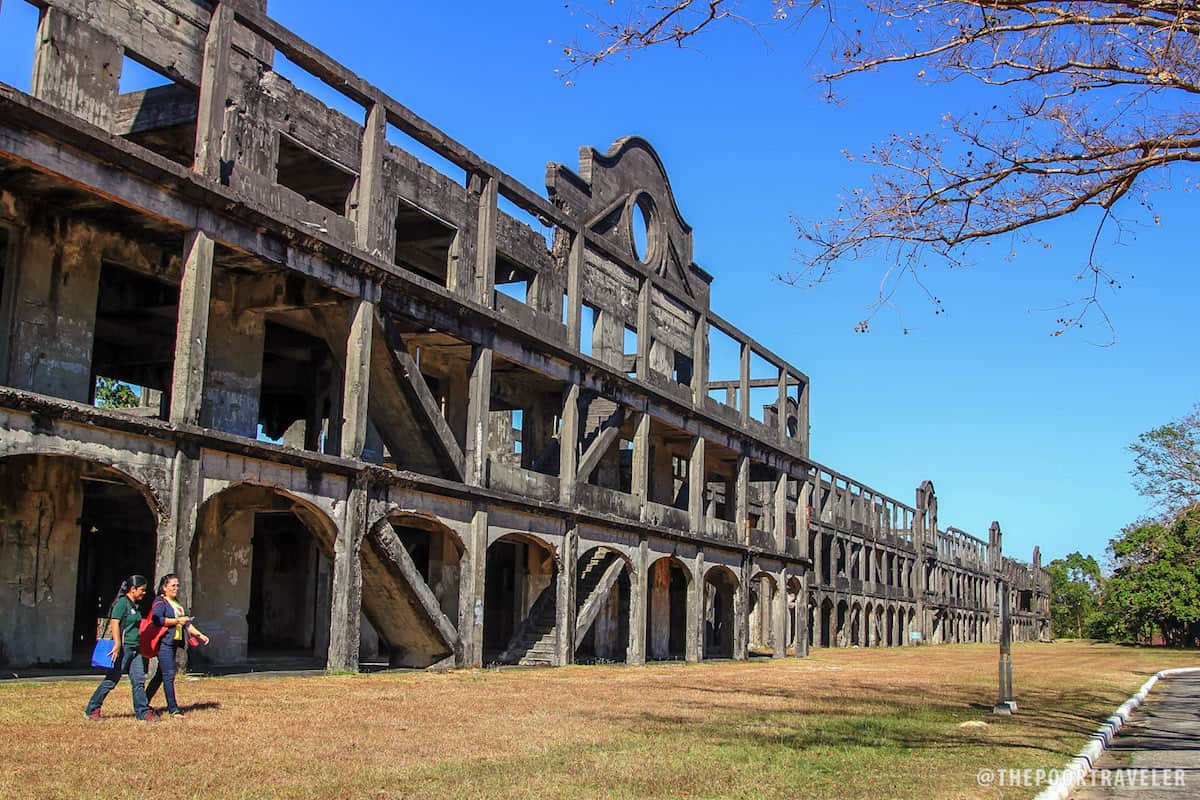
Most people assume that Corregidor is a part of Bataan because of its close physical proximity and historical ties, but it is in fact under the jurisdiction of Cavite City.
Today, the whole island and its ruins remind visitors of the past and serve as war memorials. Here are some of the significant historical sites on the island: Pacific War Memorial, Malinta Tunnel, Filipino Heroes Memorial, Corregidor Lighthouse, Japanese Garden of Peace, and Mile-Long Barracks. You will find more on this separate and more detailed Corregidor article: CORREGIDOR DAY TOUR: 12 Historic Sites to Visit .
If you are interested in joining overnight tours, you may also want to check this one: CORREGIDOR OVERNIGHT TOUR: 5 Things to Do (Other than Ghost-Hunting) .
Location: Corregidor Island, Cavite
16. Rizal Park and Shrine Dapitan, Zamboanga del Norte
The four-year exile of Jose Rizal in Dapitan was one of the most eventful periods of his life. Rizal’s work and activities were deemed subversive by the Spanish regime, prompting them to send the Laguna-native to Mindanao for exile.
The places where he lived and worked are preserved as part of the José Rizal Memorial Protected Landscape, also called Rizal Park and Shrine. Aside from this, Dapitan’s map is dotted with several historic landmarks including Liwasan ng Dapitan, Punto del Desembarco de Rizal, Casa Real, Cotta de Dapitan, and St. James the Greater Church. Dapitan is nicknamed the Shrine City in the Philippines.
Location: Dapitan City, Zamboanga del Norte
17. Limasawa Island, Southern Leyte
The island is historically significant because it said that it is where the first-ever mass in the Philippines was held in March 1521 by Father Pedro de Valderrama.
Located off the southern tip of Southern Leyte, the municipality of Limasawa used to be under the jurisdiction of the municipality of Padre Burgos until 1978. With six barangays on the island, Limasawa officially became a separate town in 1989 through a plebiscite.
Location: Limasawa, 1st District, Southern Leyte
18. University of Santo Tomas, Manila
Originally named Colegio de Nuestra Señora del Santisimo Rosario, the University of Santo Tomas dates back to the early 17th century when it was founded by the third archbishop of Manila Miguel de Benavides in April 1611. The name was changed to Colegio de Santo Tomas and eventually elevated to university status in November 1645.
Over four centuries later, the university stood the test of time and is regarded as the oldest university in the Philippines and in Asia. It was originally located inside Intramuros, the walled city of Manila during the Spanish colonial period, before transferring to its current location.
Prominent alumni are Jose Rizal, Apolinario Mabini, Jose P. Laurel, Diosdado Macapagal, Sergio Osmeña, Manuel L. Quezon, and Nick Joaquin among others.
Location: España Boulevard, Sampaloc, Manila, NCR
19. Cagsawa Ruins, Albay
Remember the iconic photo of a church’s tower (or what’s left of it) buried in volcanic ash with the temperamental but picturesque Mayon Volcano in the background?
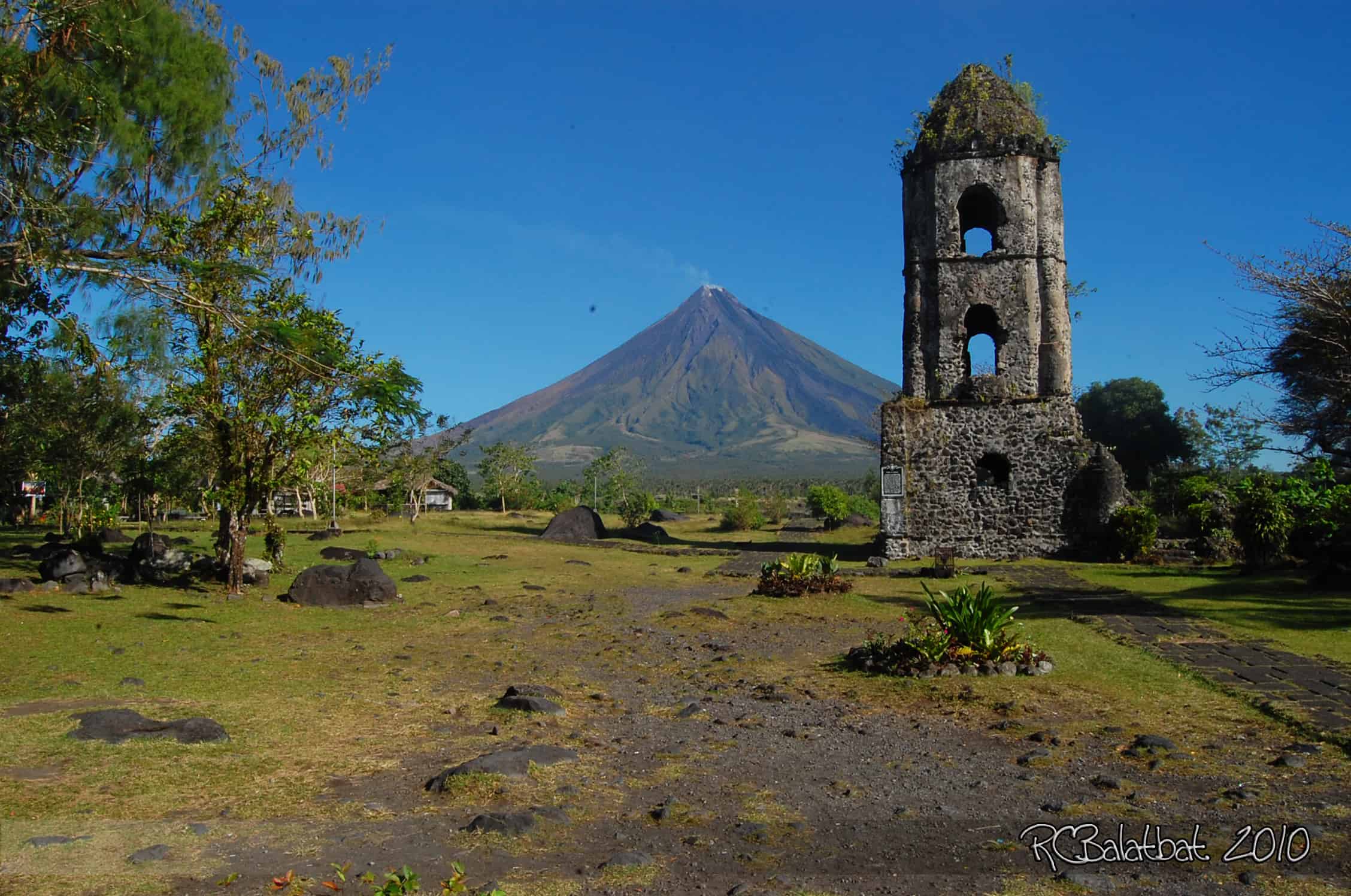
The late 16th-century Cagsawa Church was established by the Franciscan missionaries. The first structure was burned down by the Dutch pirates in the 17th century. It was reconstructed in the 18th century. However, the eruption of the Mayon Volcano destroyed the church along with the rest of the town in the early 19th century. What we see today is what was left of the church — a portion of its tower.
The Cagsawa Ruins Park is co-managed and co-maintained by the municipal government of Daraga and the National Museum of the Philippines. It is one of the most visited tourist attractions in Albay. While there, visit the Cagsawa National Museum , showcasing photos of the Mayon eruptions and other related collections. And since it’s a popular attraction, there are several souvenir shops and stalls in the vicinity.
For those who want to explore the park more, you can book ATV tours offered by many operators and agencies in the area.
Location: Barangay Busay, Daraga, Albay
20. Calle Crisologo, Vigan, Ilocos Sur
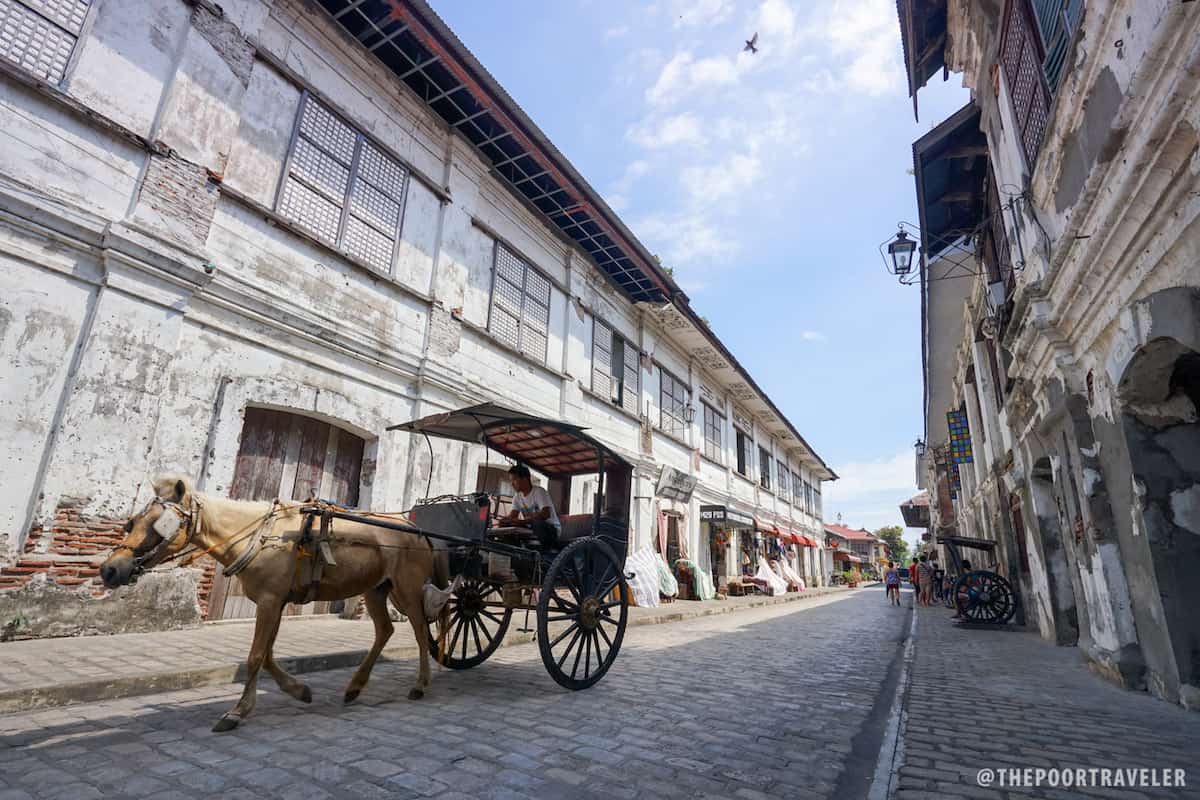
Named after a well-loved Ilocano politician and writer Mena Crisologo, Calle Crisologo is a well-preserved Spanish-era street lined with heritage houses or bahay na bato . The cobblestone street, stretching from Plaza Burgos to Rivero Street, was historically the business and trade center of North Luzon in the pre-colonial and Spanish colonial Philippines and where most of the residents were affluent Filipino-Chinese traders and merchants.
Today, the street is still flanked with old structures and heritage houses, the majority of which were converted to museums, restaurants, shops, or hotels. You can sample some of Vigan’s signature food like Vigan empanada and longganisa. Whether visiting during the day or at night, Calle Crisologo definitely transports you back in time.
Location: Calle Crisologo, Vigan, Ilocos Sur
21. Baguio City
The highly urbanized City of Pines is perched in the highlands of the Cordilleras. This elevation gives it the chills, something that attracts tourists from other parts of the country.
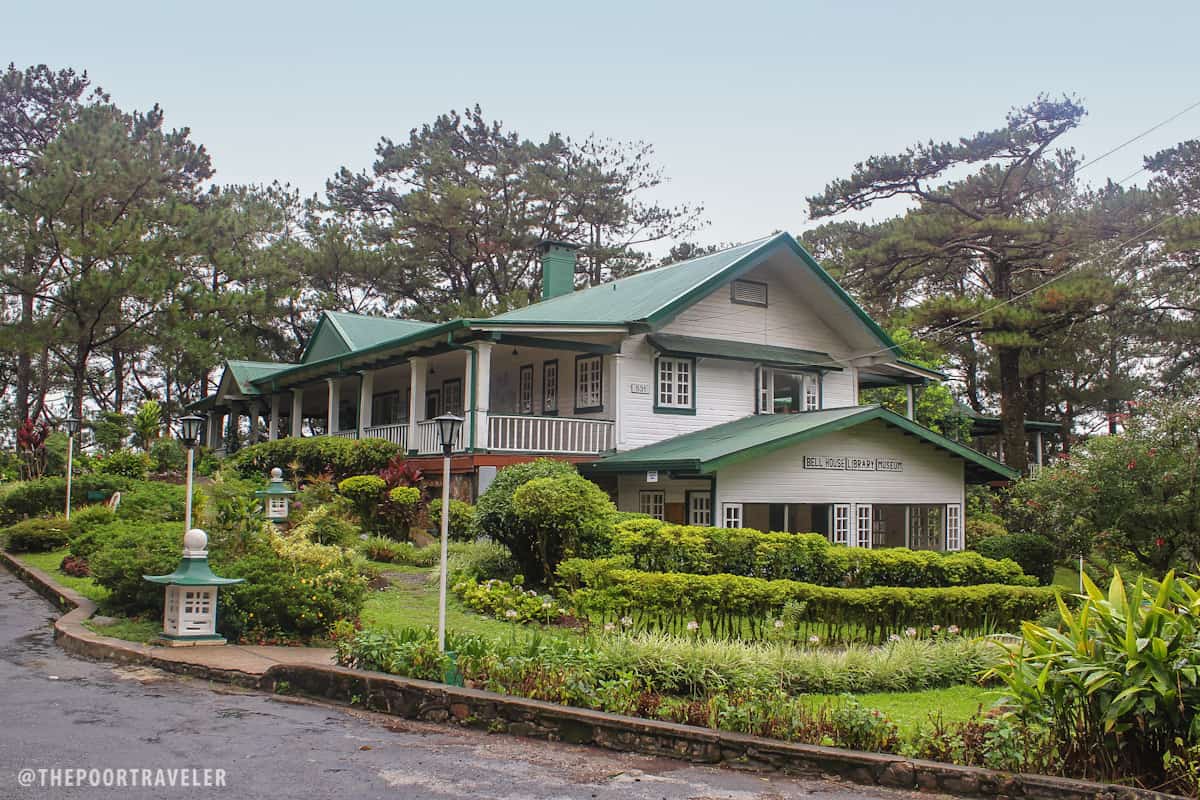
But Baguio is more than just a popular tourist destination. It is also rich in history. During the Spanish colonization, the area was never fully under Spanish control because of the effective defensive strategy of the indigenous Igorot.
After the Americans defeated the Spaniards, the Philippines fell into the hands of the United States. And at the turn of the 20th century, the foundations for the development of Baguio City were laid when the Americans established Camp John Hay in 1903, the only hill station in Asia. It jumpstarted the development of the city, which would become Baguio. Most of the historical structures in Baguio were built under American rule.
Location: Baguio City, Benguet Note: Baguio is only geographically located in Benguet, but is not under the province’s jurisdiction. As a chartered city, Baguio is governed independently.
22. Sultan Kudarat Monument, Sultan Kudarat
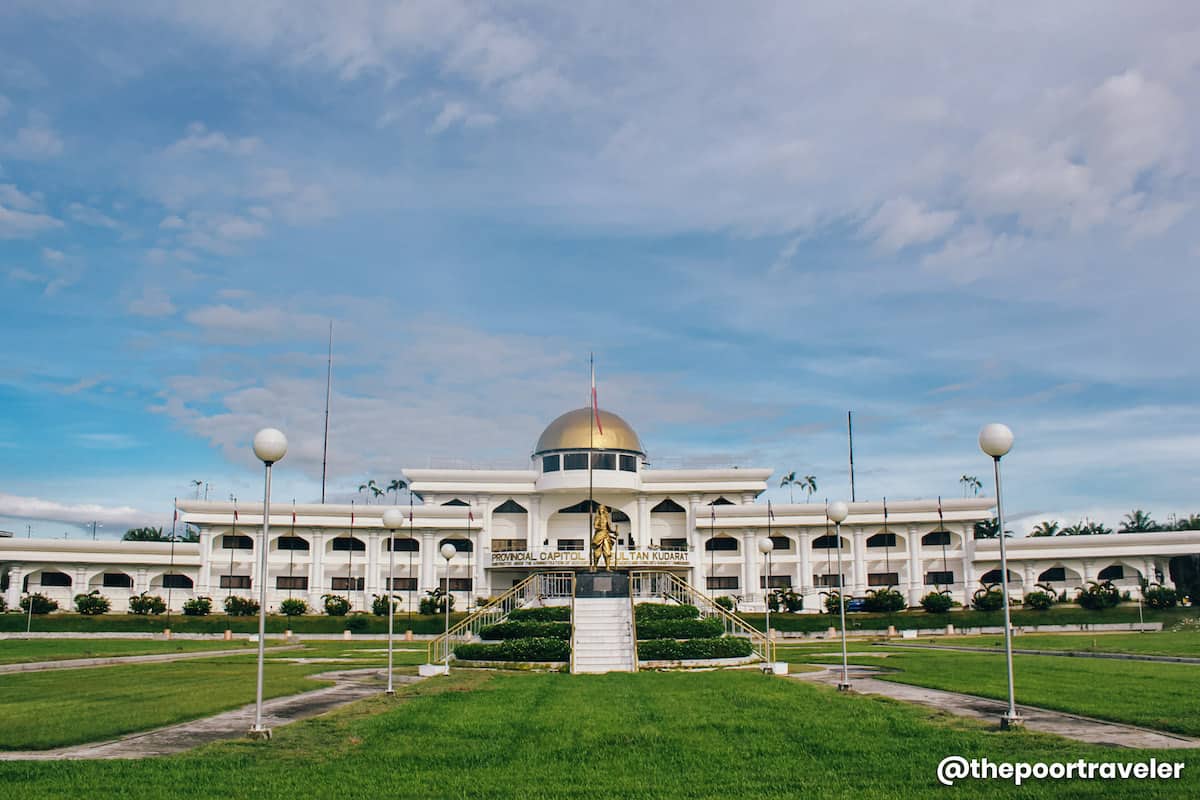
Muhammad Dipatuan Kudarat , famously known as Sultan Kudarat , was revered and hailed as the greatest sultan that ever ruled in Mindanao. He was a celebrated warrior, fearless in the face of the Spanish conquistadors who threatened to occupy his ancestral domain. He tenaciously defended the Islamic faith and steadfastly held his ground against the Spanish invaders.
Monuments were built honoring him for his bravery and valor. There is one in Makati (Ayala Triangle) and another in Cotabato City, Maguindanao (Tantawan Park). But the most photographed stands in front of the Sultan Kudarat Provincial Capitol in Isulan.
23. Malacañan Palace, Manila
Malacañan Palace is the official residence and office of the President of the Philippines. It has served numerous leaders, from the Spanish Governor-Generals to the Presidents of the Republic of the Philippines.
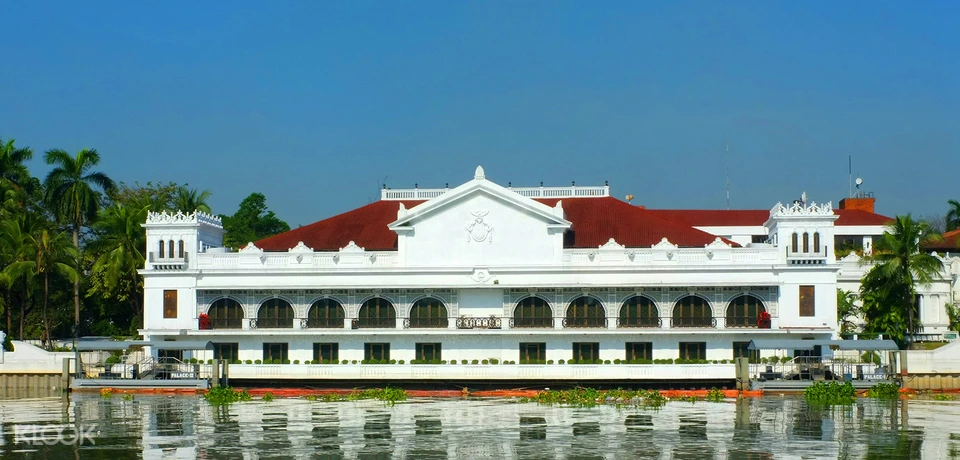
The vast palace complex, the result of numerous renovations and expansion, encompasses many office buildings, mansions, parks and gardens. Most of them follow the neoclassical and bahay na bato architectural styles. The most prominent buildings are the main Malacañan Palace, the New Executive Building, Mabini Hall, Bonifacio Hall, and Kalayaan Hall (Old Executive Building), which houses the Presidential Museum and Library and the Former Presidential Museum.
The history of Malacañan Palace dates back to the mid 18th century when it was built as a private summer house for the Spanish aristocrat, Don Luis Rocha. In the first quarter of the 19th century, it became the summer residence for the Spanish Governor-General. It survived the destruction caused by World War II.
24. Biak na Bato, Bulacan
The Republic of Biak na Bato was officially established in November 1897 by a revolutionary movement led by Emilio Aguinaldo. Although short-lived, this move sparked hope among other revolutionary leaders in other parts of Luzon.
The Biak na Bato National Park nestles the site where Aguinaldo and his comrades planned and initially formed the revolutionary government in May 1897, months before its official declaration. The national park encompasses over 2,000 hectares of lush forest and rocky gorge.
Because of its historical importance, it gained the status of a national park in 1937. It is presently managed by the Department of Environment and Natural Resources. The park also features rivers, waterfalls, and caves, making it a good option for a quick weekend getaway destination near Manila.
Location: Barangay Biak na Bato, San Miguel, Bulacan Note: Although most of the park lies in San Miguel, some parts extend to San Ildefonso and Doña Renedios Trinidad.
25. Cinco de Noviembre Memorial, Negros Occidental
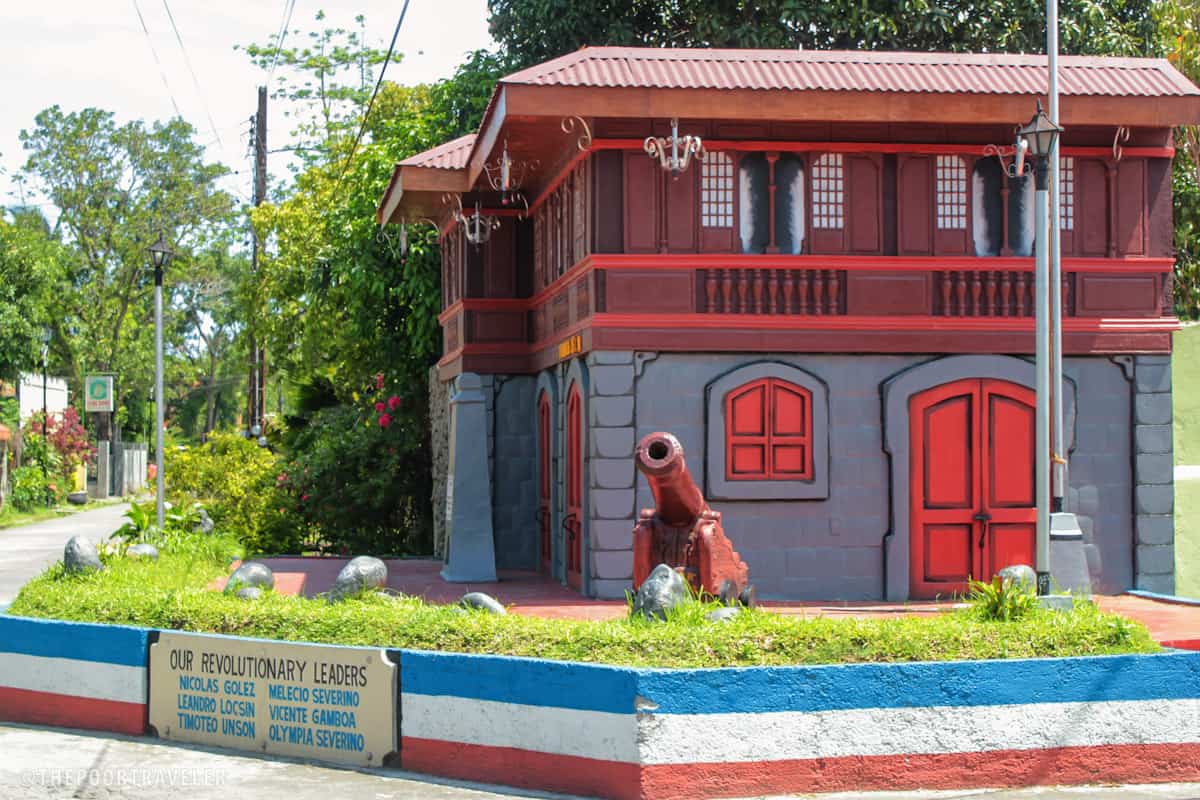
Also known as the Negros Revolution, it was the greatest political movement bluff by the Negrense people that blindsided the Spanish colonizers and resulted in the establishment of the Negros Republic on November 5, 1898.
To commemorate this monumental event, a memorial landmark with a replica of a drugstore building that served as a hideout and the place where the Negrense revolutionaries plotted the revolution against the Spaniards. It also features an authentic Spanish-era cannon.
It is located close to Balay Negrense and the other ancestral houses in Silay City. Signed in 1989, November 5 (Negros Day) is a special non-working holiday in the province.
Location: Silay-Mambulac Road, Silay City Heritage Zone, Silay City, Negros Occidental
2020 • 12 • 21
More Tips on YouTube ⬇️⬇️⬇️
Is this post helpful to you?

Related Posts:
- Cape Bojeador Lighthouse: Burgos, Ilocos Norte, Philippines
- Caluwayan Palm Island Beach Resort: Where to Stay in Marabut, Samar
- ANAWANGIN COVE & NAGSASA COVE: Budget Travel Guide
- How to Get from PUERTO PRINCESA TO EL NIDO: By Bus and Van
- BATANGAS BASILICA: Basilica of the Immaculate Conception in Batangas City
- BARAS BIRD SANCTUARY: Herons and Villains in Sultan Kudarat, Philippines
- 13 BEST BEACHES IN BATANGAS, PHILIPPINES
- CUBAO to NAIA / NAIA to CUBAO: P2P Bus Schedule (UBE Express)

- Recent Posts
- 2024 STILTS CALATAGAN Beach Resort Travel Guide with Itinerary & Budget - 7 April 2024
- TOKYO SKYTREE TRAVEL GUIDE: Know Before You Visit! - 30 March 2024
- 37 BORACAY TOURIST SPOTS & Things to Do (with Prices!) - 6 November 2023
Featured On

We heard you!
Your comment is now queued for moderation! We’ll try to get back to you soonest. While waiting, follow us on these channels.
Subscribe on Youtube! Follow us on Instagram!

13 Historical Sites in the Philippines Every History Buff Must Visit
The Philippines has long been considered a top tourist destination by people all over the world. Not only does it have plenty of beautiful beaches and scenic spots for people to enjoy, but it also has a rich culture and history that everyone will find interesting.
To give you a quick recall, the Philippines was colonised by the Spaniards for 333 years until the Americans took over for over 40 years. The British, Japanese and other nationalities also tried their hand at conquering the country within those years.
Today, the Philippines has become a melting pot of various cultures and its historical landmarks have played a major part in the country’s tourism industry. Check out this roundup of historical sites in the Philippines!
Historical sites in the Philippines to visit
1. rizal park.
This park, located right in the heart of the country’s capital Manila, has been called various names: Luneta Park, Bagumbayan, and Manila Kilometer Zero. Rizal Park was named after the country’s national hero, Jose Rizal, who was executed there by the Spanish military firing squad after spreading his revolutionary ideas against Spanish rule.
Address: Roxas Blvd Ermita, Barangay 666 Zone 72, Metro Manila
2. Calle Crisologo
This famous 500-metre cobblestone street in Vigan City, Ilocos Sur is one of the best displays of Spanish influence in the country. Stretching across only five blocks, the calle (street) is lined with old heritage houses of Filipino-Chinese traders who were prominent back in the day. The houses here are characterised by thick walls, red roofs, huge doors and capiz shell windows.
Address: Calle Crisologo, Vigan City, Ilocos Sur
3. Leyte Landing Monument
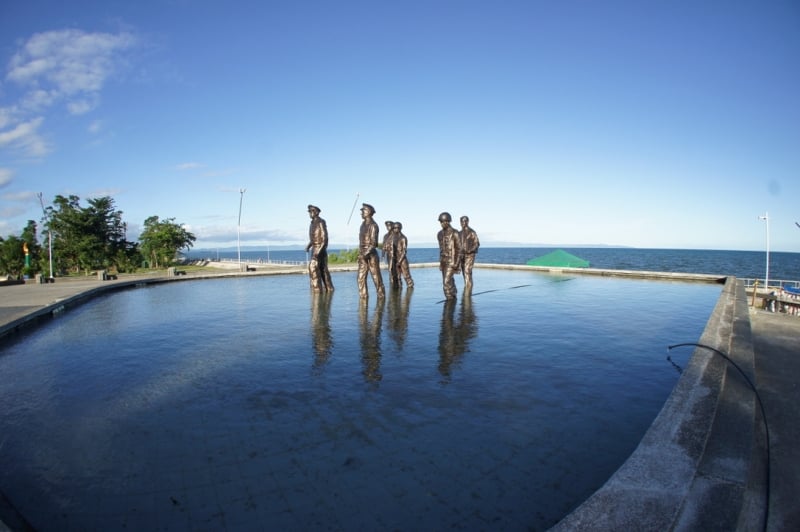
Also known as the MacArthur Park, this 6.78-hectare war memorial commemorates General Douglas MacArthur’s fulfilment to the Filipino people of “I shall return.” The historical site in the Philippines is where MacArthur made his return landing, which also signified the start of his campaign to help free the Philippines from Japanese occupation back in 1944. Red Beach, where the park is located, was named as such, not because of the sand but because of the colour the sea supposedly turned into after blood was spilt on it during the war.
Address: Red Beach, Palo, Leyte
Also read: A Simple Travel Guide to Leyte: What You Need to Know Before Your Trip
4. Sandugo Shrine
Sandugo referred to the blood compact that took place between the Spanish explorer Miguel Lopez de Legazpi and the chieftain of Bohol, Datu Sikatuna, back in 1565. Sandugo means “one blood” in the Visayan dialect and was performed to seal the friendship between the two leaders. It was considered to be the first-ever treaty of friendship between the Filipinos and the Spaniards.
Address: J.P Inting Street, Tagbilaran City, Bohol
5. Fort Santiago
This citadel was first built by the Spanish explorer Miguel Lopez de Legazpi and is a part of the walled city of Manila called Intramuros. Its prison walls witness the loss of lives during the Spanish Colonial Period and the Second World War. The country’s national hero was also imprisoned here before he was executed back in 1896 at the now Rizal Park.
Address: Intramuros, Manila, Philippines
Also read: DIY Walking Tour in the Walled City of Intramuros: Top 8 Attractions to Visit
6. Fort San Pedro
Another military structure built under the command of Miguel Lopez de Legazpi is the Fuerte de San Pedro in Cebu. This historical site in the Philippines was made of wood, and immediately put up after the arrival of the Spanish explorer in order to keep the Muslim raiders away from the area. It was the centre of the first Spanish settlement in the country and, in the 19th century, the fort was attacked by Filipino revolutionaries who used it as their stronghold during the Philippine Revolution.
Address: Plaza Independencia, Cebu City
7. Mactan Shrine
The Mactan Shrine, or the Lapu-Lapu Shrine, is a 20-metre bronze statue of the native leader, Lapu-Lapu, who was the one who defeated the Spanish soldiers and killed the Portuguese explorer Ferdinand Magellan back in 1521. The event is now famously referred to as the Battle of Mactan.
Address: Punta Engaño, Lapu-Lapu City, Cebu
8. Corregidor Island
Corregidor Island is known for its many historical significance in the country. For one, it became the seat of the Philippine Commonwealth Government in 1941. It also became the headquarters of the Allied Forces during the Japanese occupation in the Philippines in 1942. Later that year, the Battle of Corregidor took place on the island, as a culmination of the Japanese campaign to conquer the Philippine government. A lot of Filipino, American and Japanese lives were lost during the battle as the island was the last remaining obstacle that will allow the Japanese to have full control of Manila Bay.
Address: Corregidor Island, Manila Bay, Cavite
9. Jose Rizal Shrine
The Jose Rizal Memorial Protected Landscape in Dapitan, Zamboanga del Norte, is the farm site where the country’s national hero was exiled for four years after being accused by the Spanish authorities of plotting the Philippine Revolution in Manila. Also known as the Rizal Park and Shrine, it was established in 1940 and was declared a protected landscape covering 439 hectares in 2000.
Address: Brgy. Talisay, Dapitan City, Zamboanga del Norte
10. Basilica del Santo Niño
No visit to Cebu is ever complete without paying tribute to Santo Niño. The basilica was founded in 1565 and is the oldest Roman Catholic Church in the entire country. The spot was where Miguel Lopez de Legazpi found the image of the Child Jesus. It was also the same statue that Ferdinand Magellan gave to the wife of Rajah Humabon of Cebu after they were baptised to Christianity in 1521.
Address: Santo Niño Chapel, Cebu City
Also read: How I Spent a Smashing 4-Day Getaway to Cebu and Bohol
11. Magellan’s Cross
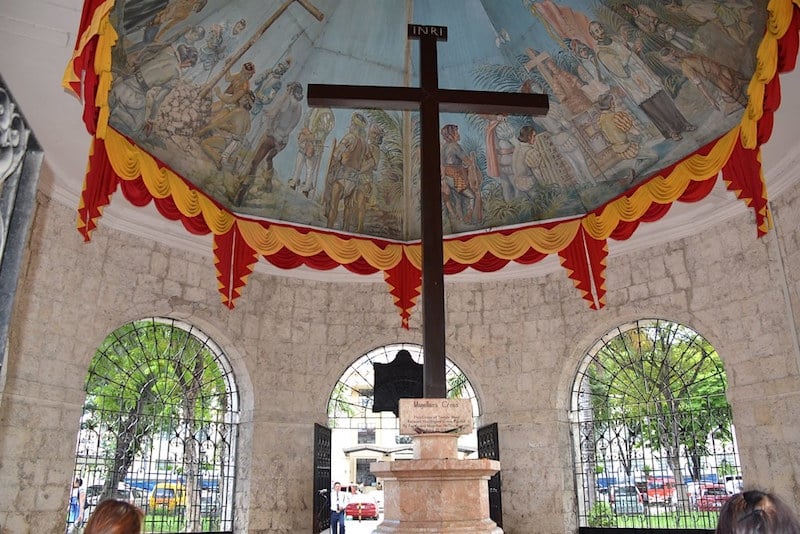
A few steps away from Basilica del Santo Niño lies another Spanish Era landmark: Magellan’s Cross. In 1521, Portuguese and Spanish explorers — led by Ferdinand Magellan — set up this Christian cross upon their arrival in Cebu. In fact, when you look up at the chapel ceiling, you’ll find fresco paintings depicting this scene. As for the cross itself, the one that you’ll see there is only a replica. The original one is actually hidden inside as to protect it from damage!
12. Sultan Kudarat Monument
The monument of the great Sultan Muhammad Dipatuan Kudarat stands proud right in front of the Provincial Capitol Building in the province of Sultan Kudarat in Mindanao. The sultan was known as a Filipino hero who fought against the Spanish invaders and defended his Islamic faith. Because the Spaniards could not conquer his territory, the Spanish governor and the Sultan signed a pact which led to many years of peace in the area. He was also considered one of the greatest leaders in Mindanao as he was able to unite the Muslims from Lanao, Cotabato, Sulu, Davao, Zamboanga and North Borneo.
Address: Provincial Capitol Building, Sultan Kudarat
13. EDSA Shrine
Compared to all the other historical sites in the Philippines, the EDSA Shrine is connected to a more recent event in the country’s history. The shrine was built only in 1989 and now stands to commemorate the two People Power Revolutions that took place in the country. The first People Power ousted the dictatorship of Ferdinand Marcos under Martial Law while the second one ousted Joseph Estrada from power in 2001.
Address: Intersection of Ortigas Avenue and Epifanio de los Santos Avenue (EDSA), Barangay Ugong Norte, Quezon City
This article was originally published on TripZilla .
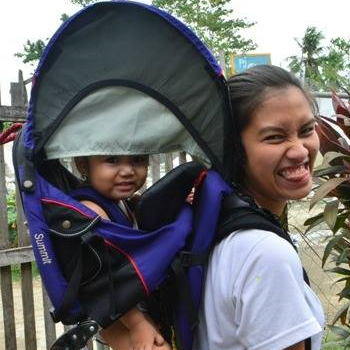
When not moonlighting as a freelance wordsmith and code wrangler, Pam is a millennial mom who loves to explore the outdoors to camp/hike/trek/backpack with her partner and their 4-year-old daughter. Check their family travel blog at Hey, Miss Adventures!
How I Went Island Glamping in Sumilon, Cebu
Europe on a budget: diy travel guide for filipinos, the sun sets in boracay: a weekend before shutdown, my cdo museum tour: a refresher course to northern mindanao & cagayan de oro’s history, how to upcycle your bts meal packaging, pinoy army edition, advertising & collaboration.

Advertise | Cut through the noise with integrated marketing solutions across multiple channels.
Press | Send us your Press Releases & Media Invites.
Editorial | Contribute your travel stories or submit content enquiries.
Filipinos To Travel More in 2024 Compared to Year Before
Don’t miss out grab the airasia 5.5 seat sale starting at ₱55, icymi: the philippines is no longer using arrival stickers in airports, everything you need to know about iu’s ‘h.e.r.’ concert at the philippine arena, manila to hanoi & ho chi minh: new direct flights with vietnam airlines, where to stay in baguio: 25 airbnbs for all budgets, 10 fun theme parks in asia to visit with kids this summer, naia announces new passenger terminal.

The Top 26 Philippine Destinations for Cultural and Historical Exploration
- February 2, 2023
- Tourism Blog
The Philippines is a nation rich in culture and history, offering visitors a unique and amazing experiential journey. From pristine coastlines to lush forests, there’s something to enjoy for everyone!
From the iconic EDSA Shrine and the Basilica del Santo Niño in Cebu to the Tabon Cave in Palawan and the Fort San Pedro in Cebu, there is something for everyone to discover and explore.
To make sure that you get the most out of your Philippine cultural and historical exploration, we’ve compiled the top 26 destinations across the country that are must-sees for those looking for an unforgettable adventure.
So get your bucket list ready and let’s start exploring!
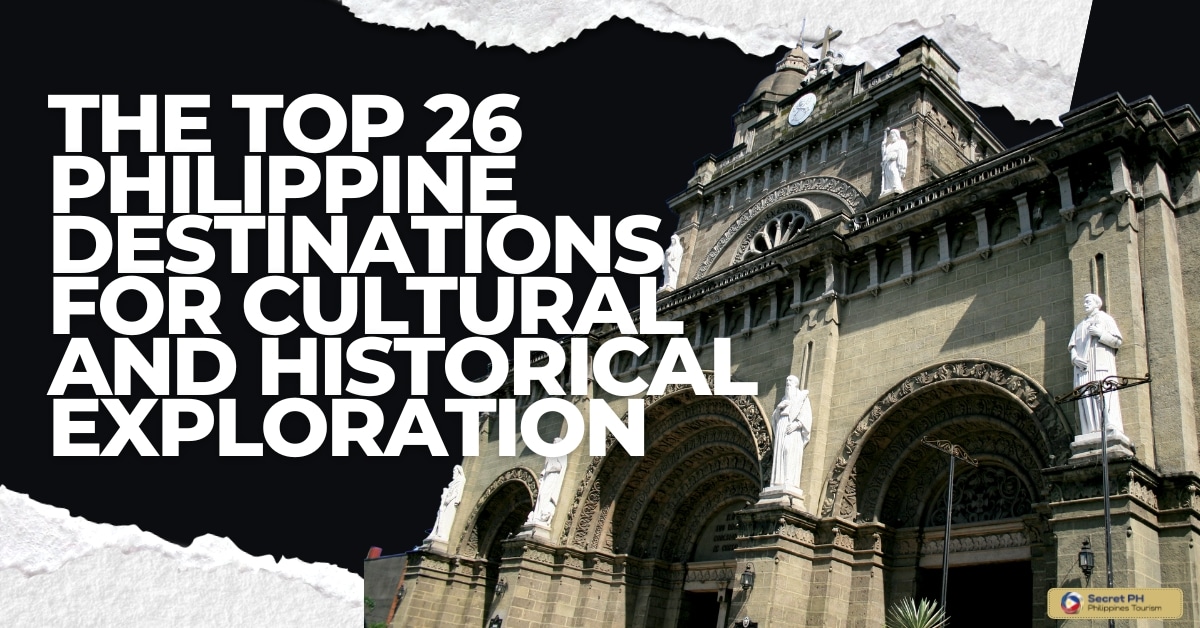
1. Intramuros
Intramuros, also known as the Walled City, is a historic district located in the heart of Manila, Philippines. It was built in the 16th century by Spanish colonizers and served as the center of Spanish political and religious power in the Philippines. Today, Intramuros is a popular destination for cultural and historical exploration, offering a glimpse into the country’s colonial past.
Visitors can tour the well-preserved stone walls, gates, and forts that makeup Intramuros, as well as visit historic churches and museums. The San Agustin Church, one of the oldest stone churches in Asia, and Fort Santiago, a former military defense structure, are among the most popular attractions in Intramuros.
In addition to its colonial heritage, Intramuros is also home to a vibrant cultural scene, with street performers, artisans, and food vendors adding to its lively atmosphere. Visitors can explore the narrow streets lined with colonial-style homes and shop for handmade crafts, such as textiles, jewelry, and pottery.
Address: Intramuros, Manila
Phone: 285272961
For pictures and more information, click here .
If you want to visit this place, check the directions here .
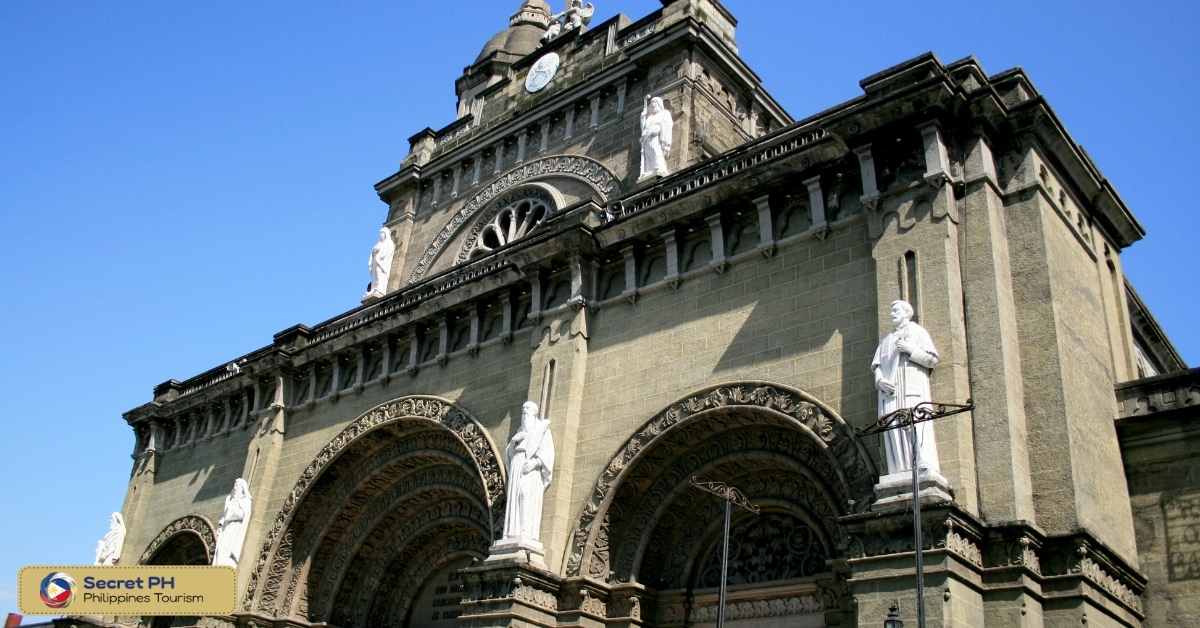
2. Corregidor Island
Corregidor Island, located off the coast of Bataan in the Philippines, is a popular destination for cultural and historical exploration. The island was once a strategic military stronghold during World War II and is now a memorial site that honors the bravery and sacrifices of Filipino and American soldiers.
Visitors to Corregidor Island can take a guided tour of the island and explore its rich history through its many monuments, memorials, and museums. The Pacific War Memorial, the Malinta Tunnel, and the Topside Barracks Museum are among the most popular attractions on the island.
In addition to its military history, Corregidor Island also offers scenic views of the surrounding sea and stunning sunsets. Visitors can hike the island’s trails, picnic on its beaches, and explore its lush tropical forests.
Address: Cavite City
Phone: +63288233281; +639776434819
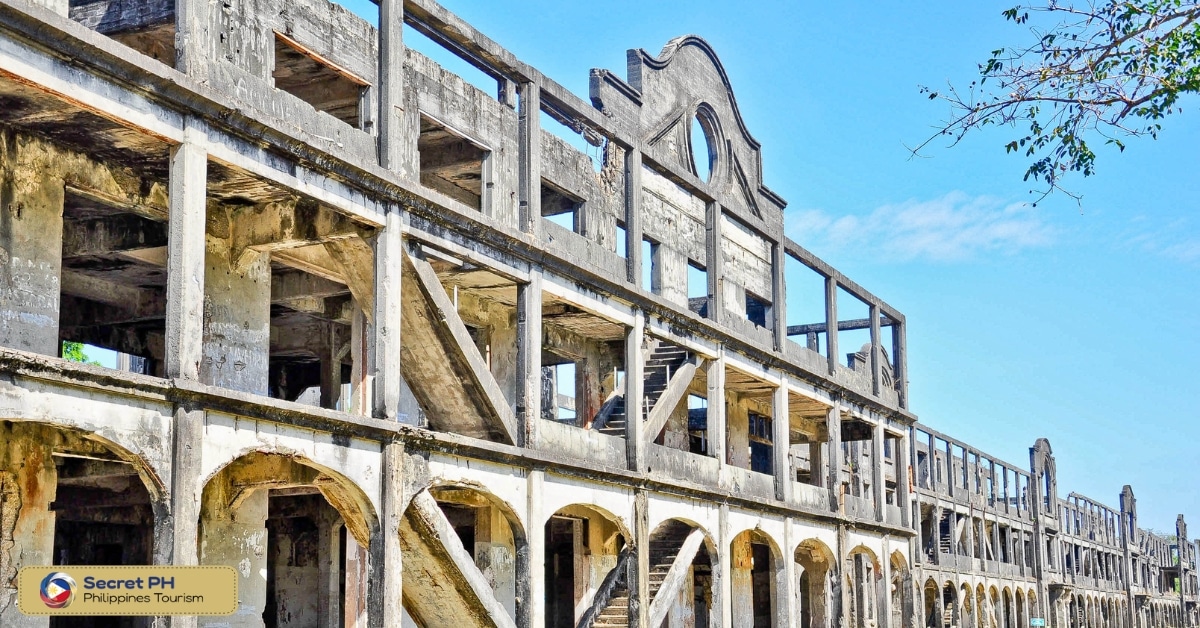
3. Calle Crisologo
Calle Crisologo is a historic street located in the city of Vigan in the Ilocos region of the Philippines. It is one of the most well-preserved Spanish colonial streets in the country and is a popular destination for cultural and historical exploration.
Calle Crisologo is characterized by its cobblestone streets, Spanish colonial-style homes and buildings, and horse-drawn carriages that offer a unique glimpse into the country’s colonial past. Visitors can take a leisurely walk down the street, stopping at shops and museums along the way to learn about the local history and culture.
The street is home to many historic landmarks, including the St. Paul Metropolitan Cathedral, the Syquia Mansion Museum, and the Crisologo Museum. These landmarks offer visitors a glimpse into the rich cultural heritage of the Ilocos region and the lives of its people during the Spanish colonial period.
Address: Vigan City, Ilocos Sur
Phone: (077) 722-8771
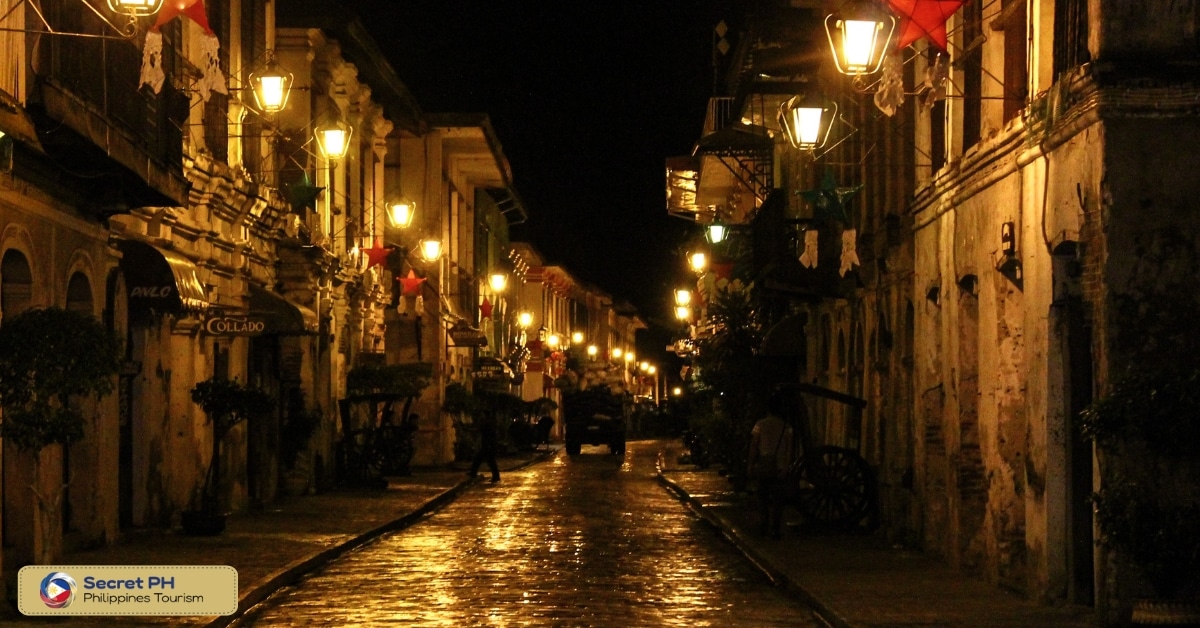
4. Rizal Park
Rizal Park, also known as Luneta Park or simply Luneta, is a historical urban park located in the heart of Manila in the Philippines. The location of the park marks the site where Philippine national hero, José Rizal, was executed by Spanish forces in 1898.
Since then, it has been christened Rizal Park in his honor. In addition to honoring its famous namesake and purpose as a public park, Rizal Park has also become an important tourist destination in Manila.
Visitors can browse through several monuments erected in honor of past Filipino heroes while strolling along its picturesque path lined with archways, ponds, and flowering plants. There are also many amusement areas such as an open-air theatre and museum that are sure to entertain both children and adults alike.
Address: Ermita, Metro Manila
Email: [email protected]

5. Fort Santiago
Fort Santiago is a historic fort located in the heart of Intramuros, the walled city in Manila, Philippines. It was built by Spanish conquistador, Miguel López de Legazpi, in 1571 and served as a military defense structure and political prison during Spanish colonial rule and the American occupation of the Philippines.
Today, Fort Santiago is a popular tourist destination and a symbol of Philippine national heritage. Visitors can tour the fort and explore its many monuments and museums, including the Rizal Shrine Museum, which honors the life and works of the Philippine national hero, Jose Rizal.
The fort’s well-preserved walls, gates, and structures offer a unique glimpse into the country’s rich colonial history and military heritage. Visitors can also stroll along its scenic gardens, paths, and promenades, offering breathtaking views of the surrounding city and waterways.
Address: Intramuros, Manila, 1002 Metro Manila
Phone: (02)8527 3155
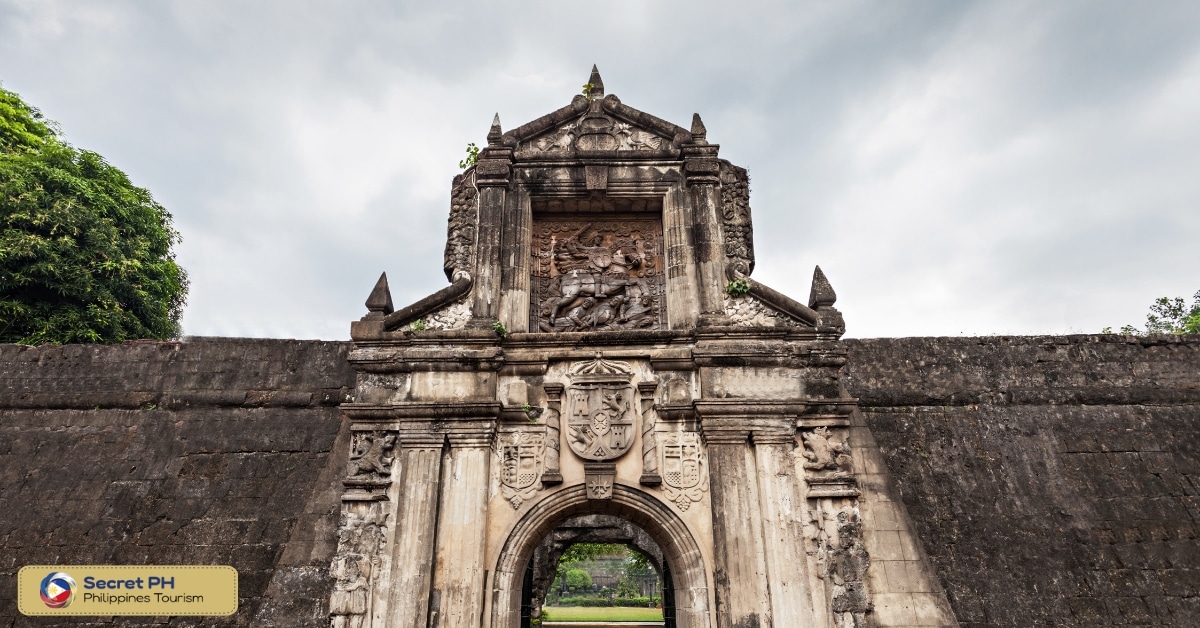
6. Malacañang Palace
Malacañang Palace is the official residence of the President of the Philippines, located in Manila. It is one of the most significant cultural and historical landmarks in the country and has served as the seat of the Philippine government for over a century.
Visitors to Malacañang Palace can take a guided tour of the historic building and explore its many rooms and exhibitions, including the Presidential Museum and Library, which houses a collection of historical artifacts and memorabilia related to Philippine presidents and their administrations.
The palace is also home to several significant works of art, including paintings, sculptures, and other decorative objects that reflect the country’s cultural heritage and history. Visitors can admire the palace’s grand architecture, ornate furnishings, and lush gardens, which offer a unique glimpse into the lives of Philippine presidents and the history of the country.
Address: 644, San Miguel, Manila, Metro Manila
Phone: (02)82498310
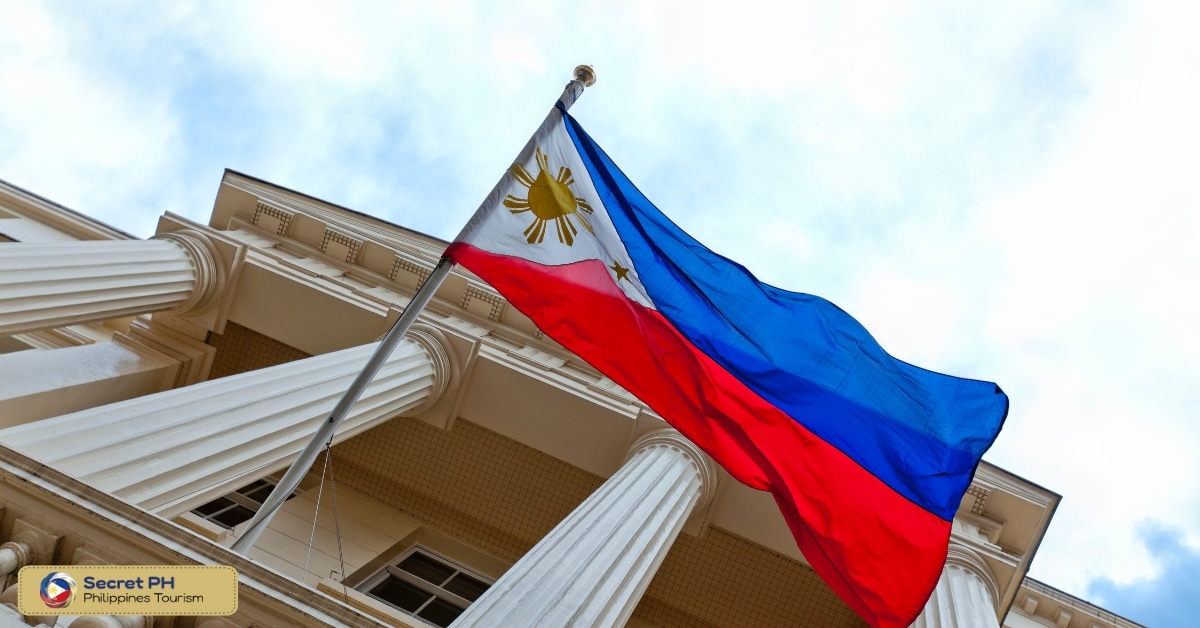
7. Tirad Pass
Tirad Pass is a historic mountain pass located in Ilocos Sur, Philippines. It is famous for being the site of the last stand of Philippine revolutionary leader, Gregorio del Pilar, against American forces in 1899.
Tirad Pass is considered one of the most significant cultural and historical landmarks in the country and is a popular destination for cultural and historical exploration. Visitors can hike to the summit of the pass and explore its many monuments and markers, which commemorate the bravery and sacrifice of the Filipino soldiers who fought there.
The stunning views from the summit of Tirad Pass offer a unique glimpse into the rugged beauty of the Ilocos region, with its rolling hills, verdant forests, and pristine rivers. Visitors can also take guided tours of the surrounding area, learn about the local history and culture, and experience the rich natural beauty of the region.
Address: Ilocos Sur, Philippines
Phone: (077) 722-8771
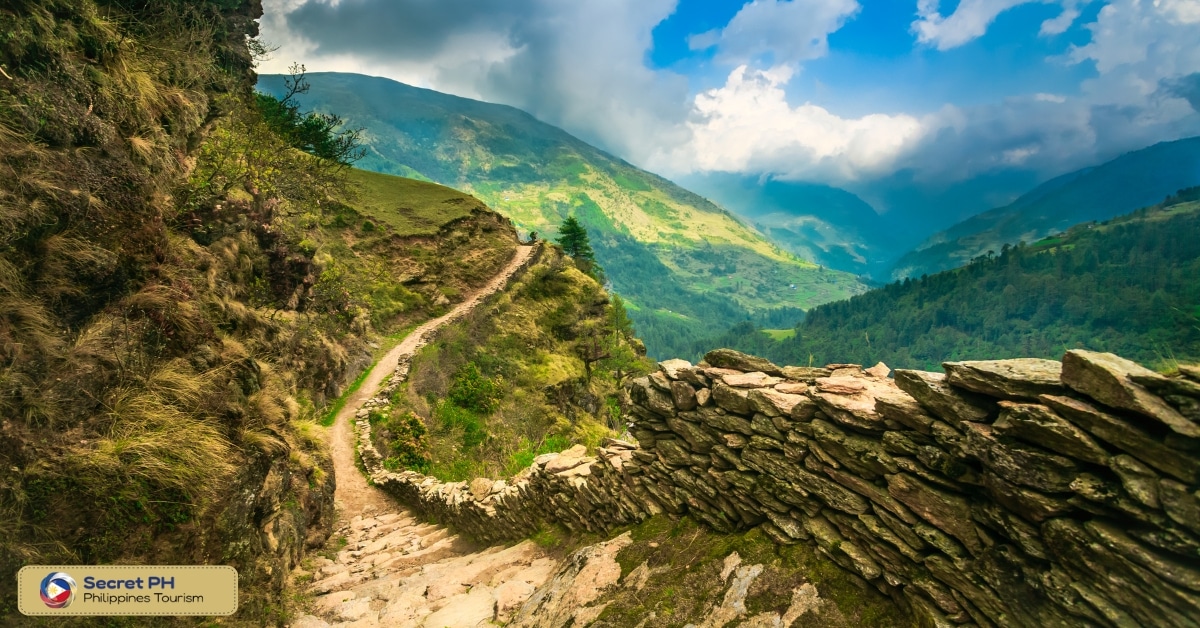
8. Barasoain Church
Barasoain Church, also known as Our Lady of Mount Carmel Parish Church, is located in the city of Malolos, Bulacan in the Philippines. It is one of the country’s top destinations for cultural and historical exploration due to its rich history and significance in the Philippine Revolution.
Barasoain Church was established in 1630 and has served as a religious and political center for the local community. During the Philippine Revolution, it served as the site of the First Philippine Republic’s first Constitutional Convention in 1898, where the country’s first democratic constitution, the Malolos Constitution, was written and ratified.
Address: Malolos, Bulacan, Philippines
Phone: +63447944340 ; +639688520344
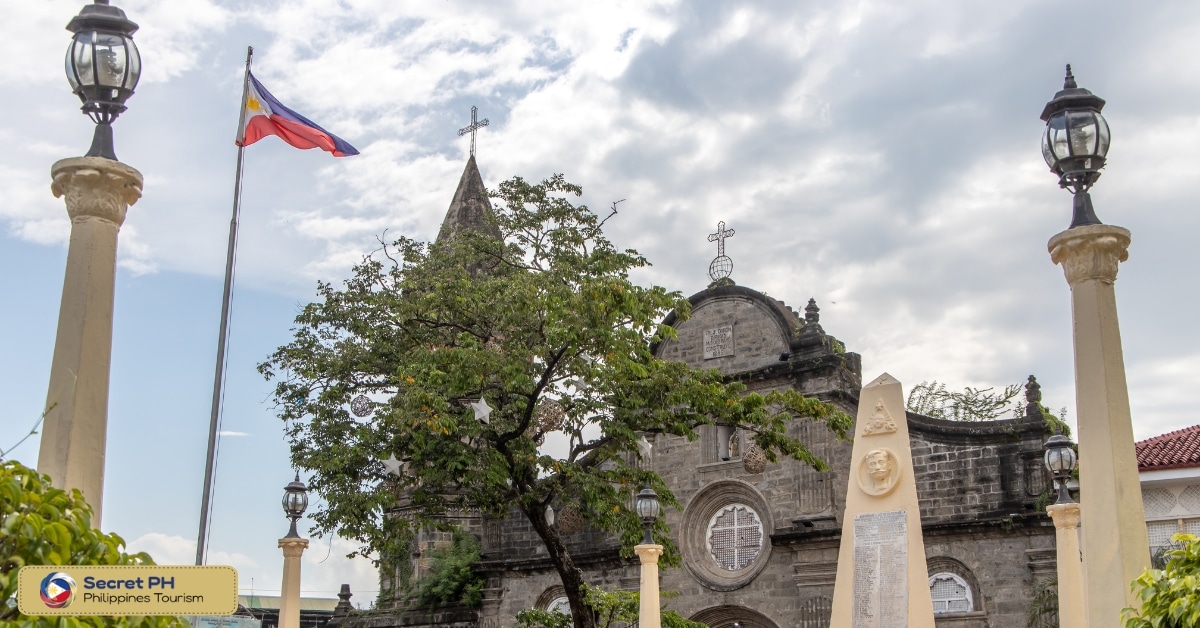
Binondo, also known as Manila’s Chinatown, is a historic district located in Manila, Philippines. It is one of the country’s top destinations for cultural and historical exploration due to its rich heritage and vibrant cultural blend.
It was established in 1594 as the world’s first Chinatown and is home to a significant Chinese-Filipino community. The district has been a melting pot of different cultures, with influences from Chinese, Spanish, and Filipino traditions.
Address: Binondo, Manila, 1006 Metro Manila
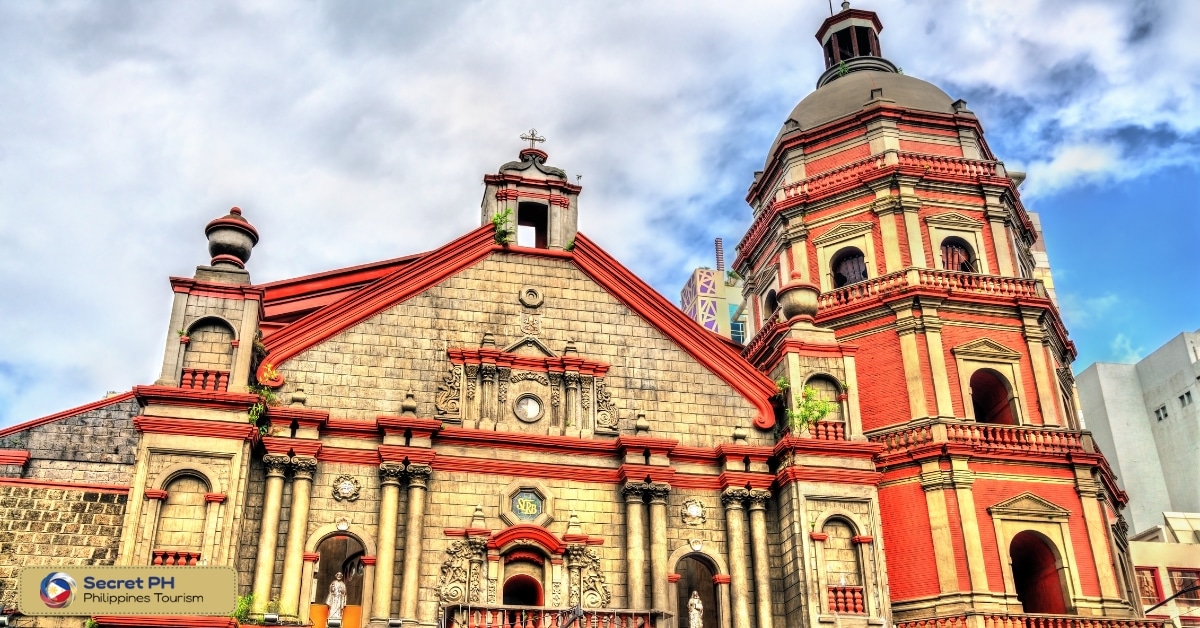
10. Fort San Pedro
Fort San Pedro, also known as Fuerte de San Pedro, is a military defense structure located in Cebu City, Philippines. It is one of the country’s top destinations for cultural and historical exploration, showcasing the rich history and cultural heritage of the Philippines.
It was built by Spanish conquistador, Miguel López de Legazpi in 1565, making it one of the oldest and smallest forts in the country. It served as a military defense structure during the Spanish colonial period and played a significant role in the history of Cebu City.
Today, It is a popular tourist destination, attracting visitors with its historical significance and well-preserved architecture. Visitors can explore the fort’s historical monuments, admire its Spanish colonial walls, and learn about its role in the Philippines’ rich history.
Address: A. Pigafetta Street, Cebu City, 6000 Cebu
Phone: (032)2562284
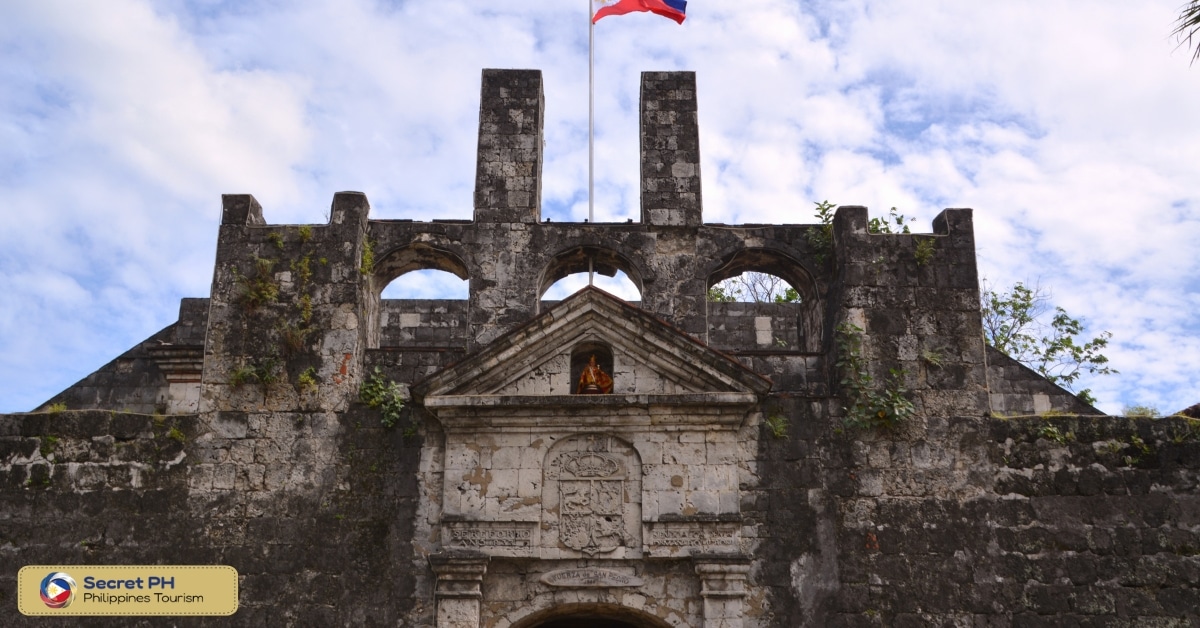
11. The Ruins
The Ruins, located in Talisay, Negros Occidental, Philippines, is a historic mansion turned into a popular tourist destination. It is one of the country’s top destinations for cultural and historical exploration, attracting visitors with its unique architecture and rich history.
The place also known as the Tassel Mansion was built in the early 1900s by a sugar baron, Don Mariano Ledesma Lacson, as a symbol of his wealth and success. The mansion was made of concrete and steel and was considered one of the most beautiful homes in the country.
Address: Talisay City, Negros Occidental
Phone: +63344769448 ; +63905513-3347
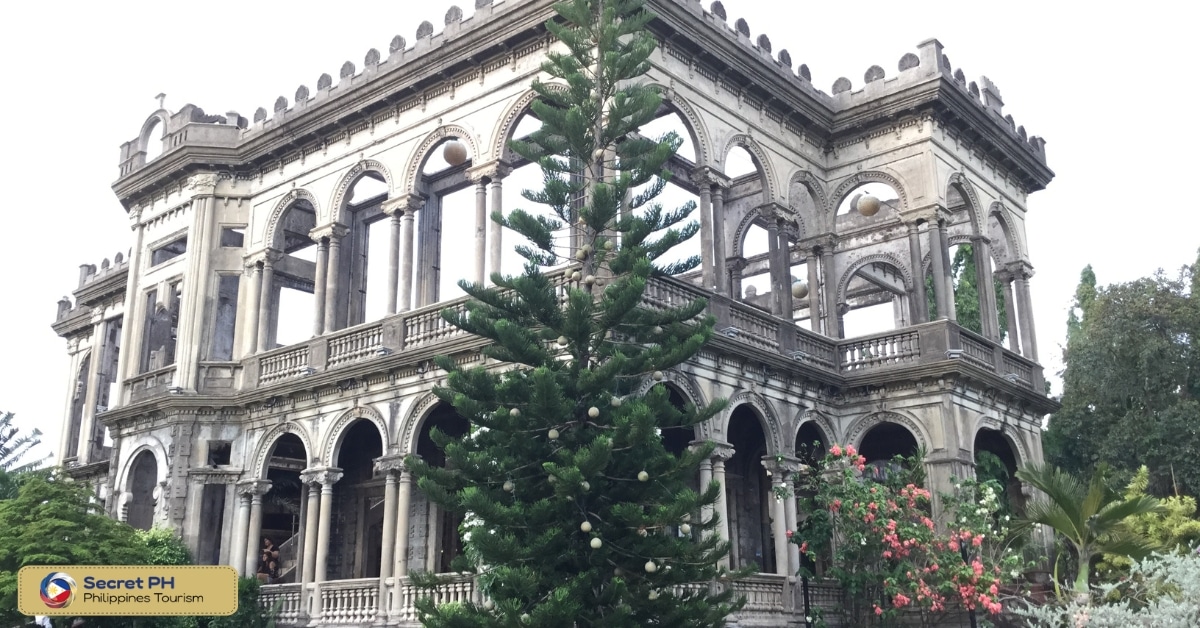
12. EDSA Shrine
The EDSA Shrine, also known as the Shrine of Mary, Queen of Peace, is a Catholic shrine located in Mandaluyong City, Philippines. It is a significant destination for cultural and historical exploration, as it marks the site of the 1986 People Power Revolution, a nonviolent uprising that ended the dictatorship of President Ferdinand Marcos and restored democracy in the Philippines.
It was built in 1989 to commemorate the peaceful demonstration that took place along the Epifanio de los Santos Avenue (EDSA) during the People Power Revolution. The shrine houses a statue of the Virgin Mary, who is considered by many Filipinos as the patroness of peace and democracy.
Address: Corner Ortigas Ave, Ortigas Center, Quezon City, 1110 Metro Manila
Phone: (02) 8631 5734
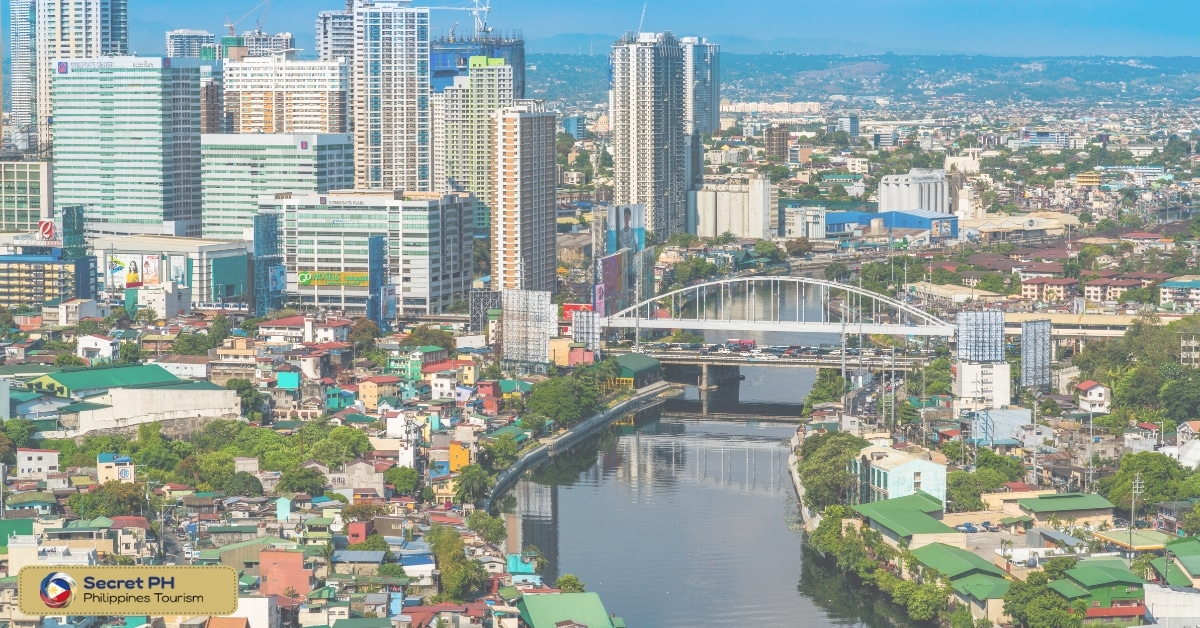
13. Basilica del Santo Niño
The Basilica del Santo Niño is a Roman Catholic basilica located in Cebu City, Philippines. It is a significant destination for cultural and historical exploration, as it houses the oldest religious relic in the Philippines, the Santo Niño de Cebu.
The Santo Niño de Cebu is a small statue of the Holy Child Jesus, believed to have been given as a gift to Queen Juana of Cebu by Portuguese explorer Ferdinand Magellan in 1521. The statue is considered a symbol of the arrival of Christianity in the Philippines and is revered by many Filipinos.
Address: Osmeña Boulevard, 6000 Cebu City
Phone: (032) 255-6697
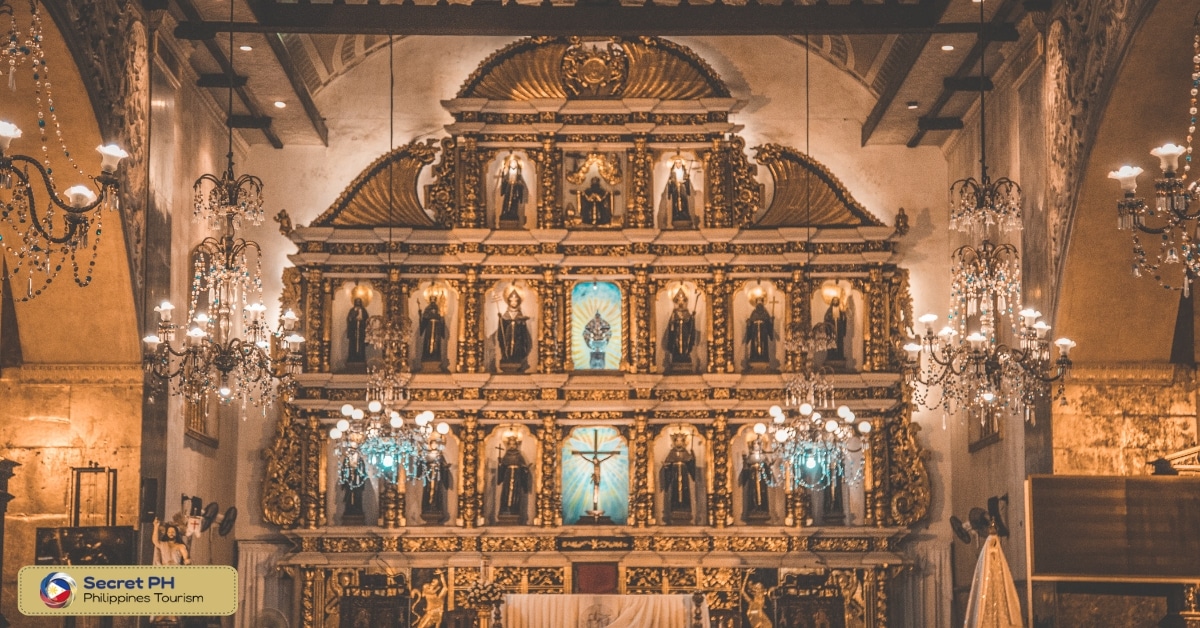
14. Tabon Cave
Tabon Cave is a complex of caves located in Lipuun Point, Quezon, Palawan , Philippines. It is a significant destination for cultural and historical exploration, as it is considered one of the oldest human settlements in Asia.
It is complex and is home to numerous archaeological sites, including the Tabon Man, the oldest human remains found in the Philippines, dating back to 22,000 years ago. The cave also contains numerous artifacts and tools, providing valuable insight into the lives of the early inhabitants of the Philippines.
Address: Quezon, Palawan
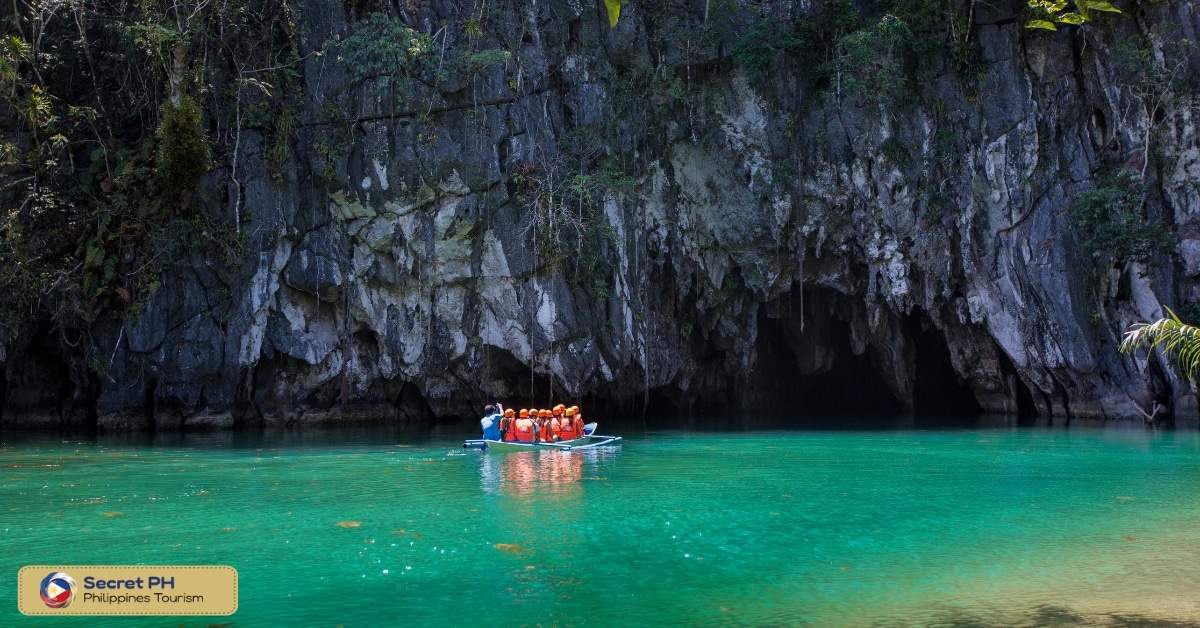
15. Mt. Samat
Mount Samat is a mountain located in Bataan, Philippines. It is a significant destination for cultural and historical exploration, as it is the site of the Battle of Bataan during World War II.
The Battle of Bataan was a pivotal battle in World War II, where Filipino and American forces held off Japanese invaders for over three months. The battle resulted in the death of thousands of soldiers and is considered a symbol of courage and bravery.
Address: Pilar, Bataan
Phone: (047) 237 3488
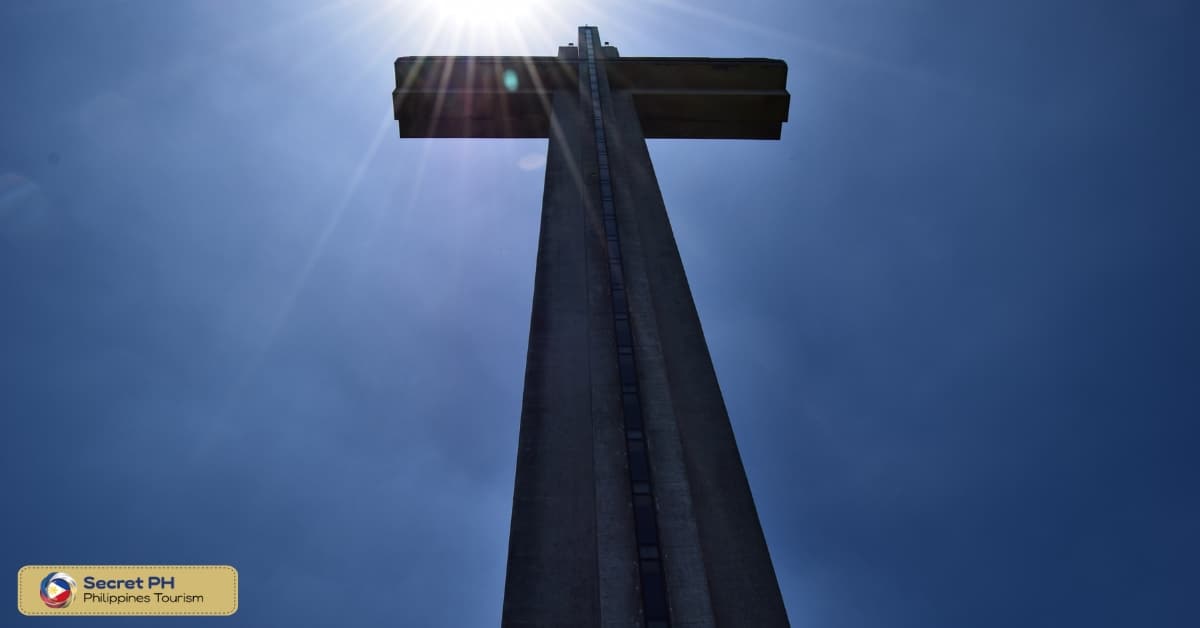
16. Mactan Shrine
The Mactan Shrine is a historical monument located on Mactan Island, Cebu, Philippines. It is a significant destination for cultural and historical exploration, as it marks the site of the Battle of Mactan, where native warrior Lapu-Lapu defeated Portuguese explorer Ferdinand Magellan in 1521.
The Battle of Mactan is considered a turning point in Philippine history, as it marked the first time that native Filipinos successfully defended their land against foreign invaders. Lapu-Lapu is revered as a national hero in the Philippines and the Mactan Shrine is a testament to his bravery and heroism.
Address: Lapu-Lapu City, Cebu
Phone: (032)8882328
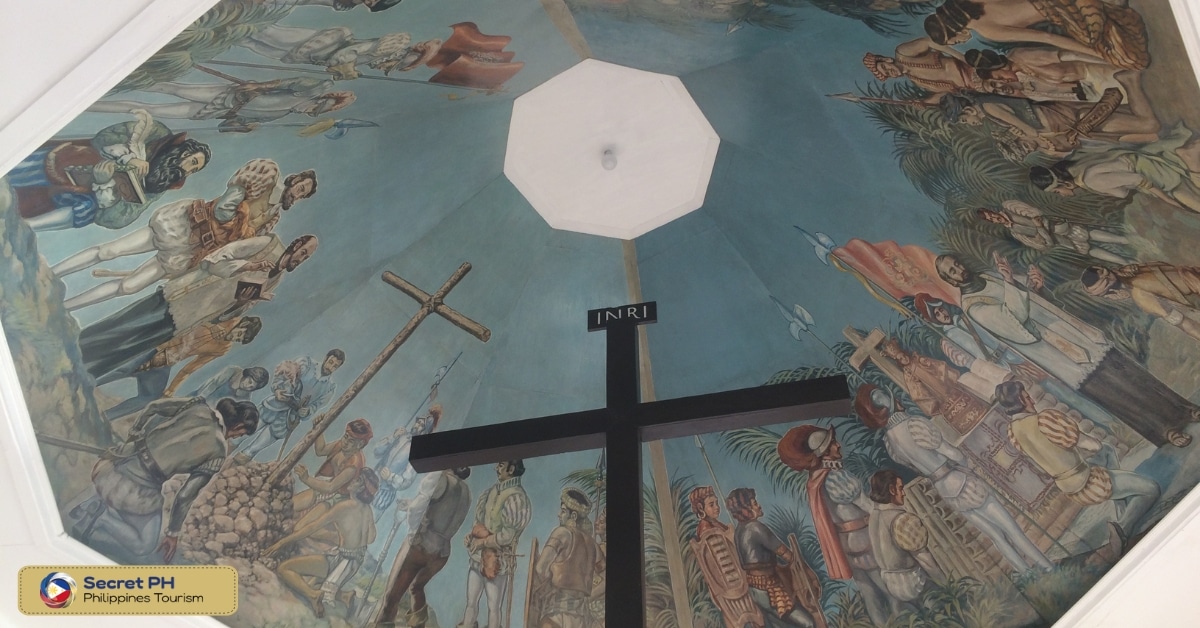
17. Emilio Aguinaldo Shrine
The Emilio Aguinaldo Shrine is a historic house located in Kawit, Cavite, Philippines. It is a significant destination for cultural and historical exploration, as it was the birthplace and residence of Emilio Aguinaldo, the first president of the Philippines.
It played a key role in the Philippine Revolution against Spain and the Philippine-American War and is considered a national hero in the Philippines. The Emilio Aguinaldo Shrine was where he raised the Philippine flag for the first time on June 12, 1898, signaling the start of Philippine independence.
Address: Kawit, 4104 Cavite
Phone: (046)4847643
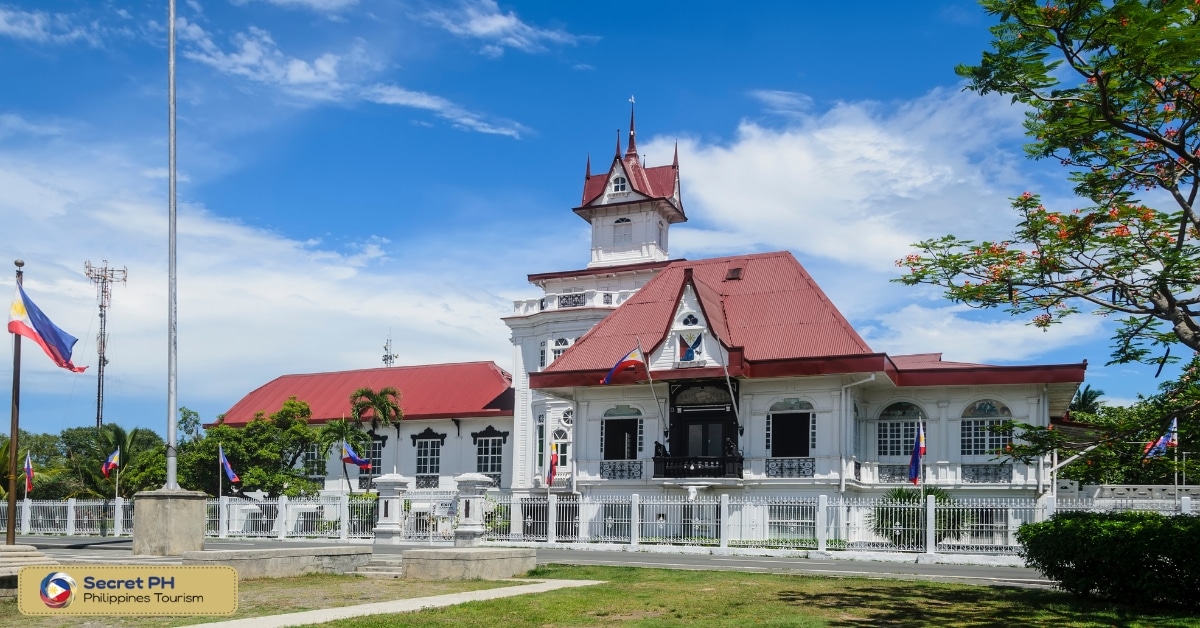
18. Plaza Cuartel
Plaza Cuartel is a historical site located in the city of Puerto Princesa, Palawan, Philippines. It is a significant destination for cultural and historical exploration, as it marks the site of a tragic event in World War II.
During World War II, Plaza Cuartel was used as a prisoner-of-war camp by the Japanese Imperial Army. In December 1944, over 150 American and Filipino prisoners of war were burned alive in the plaza, in what is now known as the Palawan Massacre.
Address: Taft St, Puerto Princesa, Palawan
Phone: 0487178005
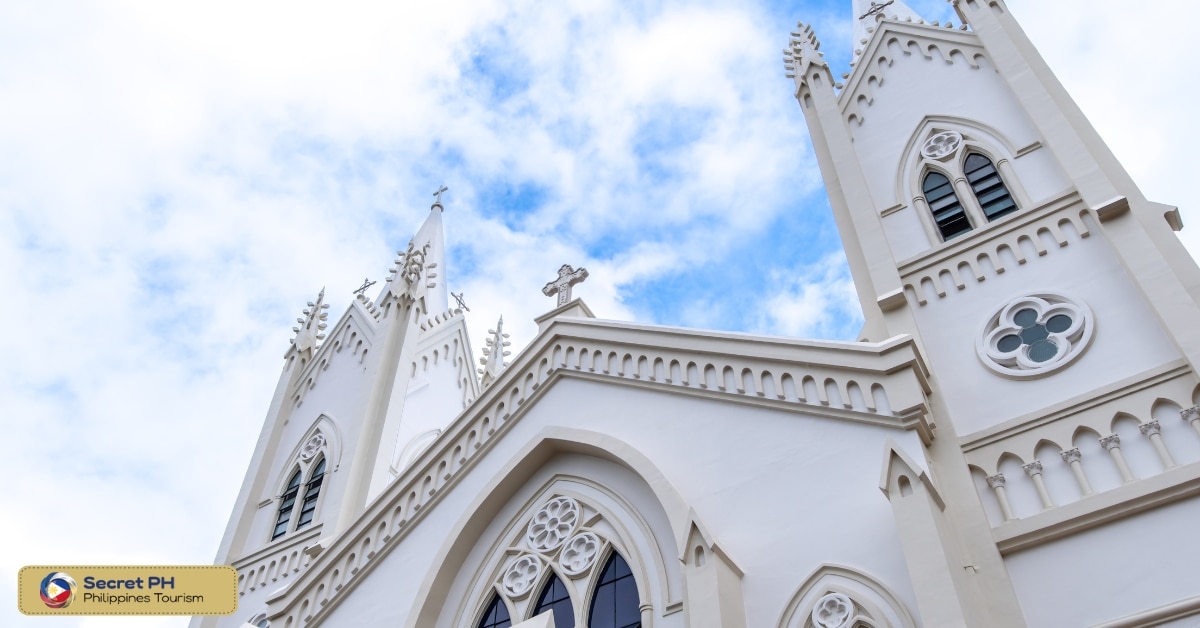
19. Baler Church
The Baler Church, also known as the San Luis Obispo de Tolosa Church, is a historic church located in the town of Baler, Aurora, Philippines. It is a significant destination for cultural and historical exploration, as it played an important role in the Spanish colonization of the Philippines and served as a refuge during the Philippine Revolution.
It was built in the late 17th century and is one of the oldest churches in the Philippines. It is known for its Spanish colonial architecture, including its adobe walls, red-tiled roof, and intricate wooden carvings.
Address: Poblacion, Baler, Aurora, Philippines
Phone: +639289837668
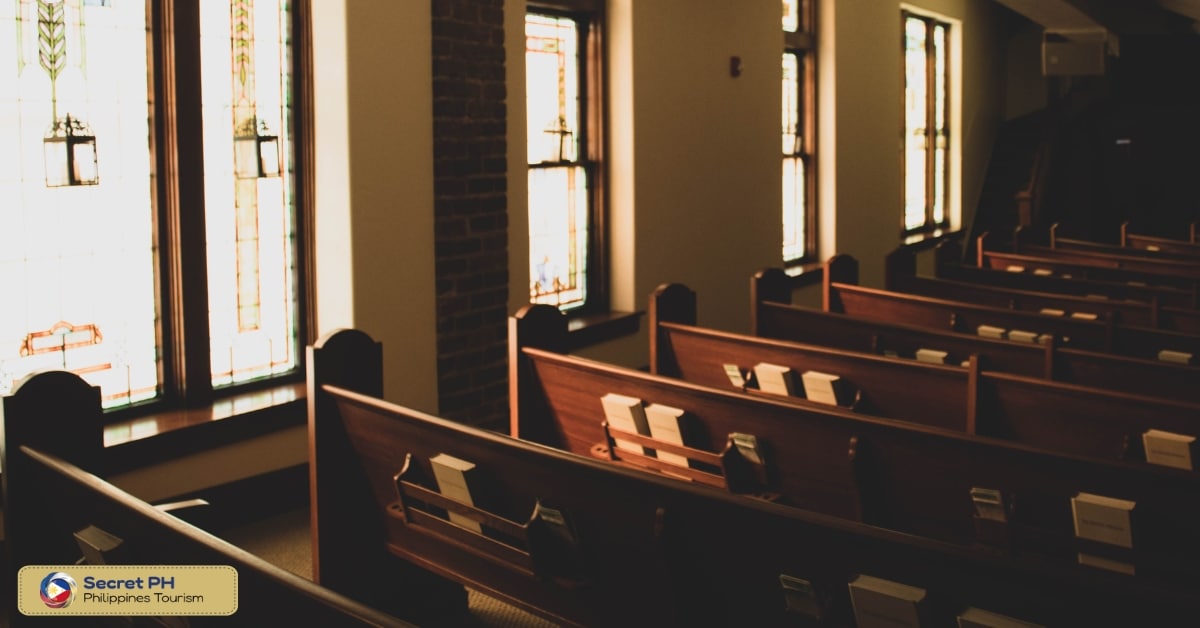
20. Sandugo Shrine
The Sandugo Shrine is a historical monument located in Tagbilaran City, Bohol, Philippines. It is a significant destination for cultural and historical exploration, as it marks the site where the first blood compact between Spanish explorer Miguel López de Legazpi and Datu Sikatuna, a native chieftain, took place in 1565.
The blood compact, also known as the Sandugo, was a symbolic act of friendship and alliance between the Spanish and the native people of the Philippines. It is considered the first treaty of friendship between the Philippines and a foreign nation and is now celebrated as the Sandugo Festival every year.
Address: J.P, EK Inting St, Tagbilaran City, 6300 Bohol
Phone: 412-2222
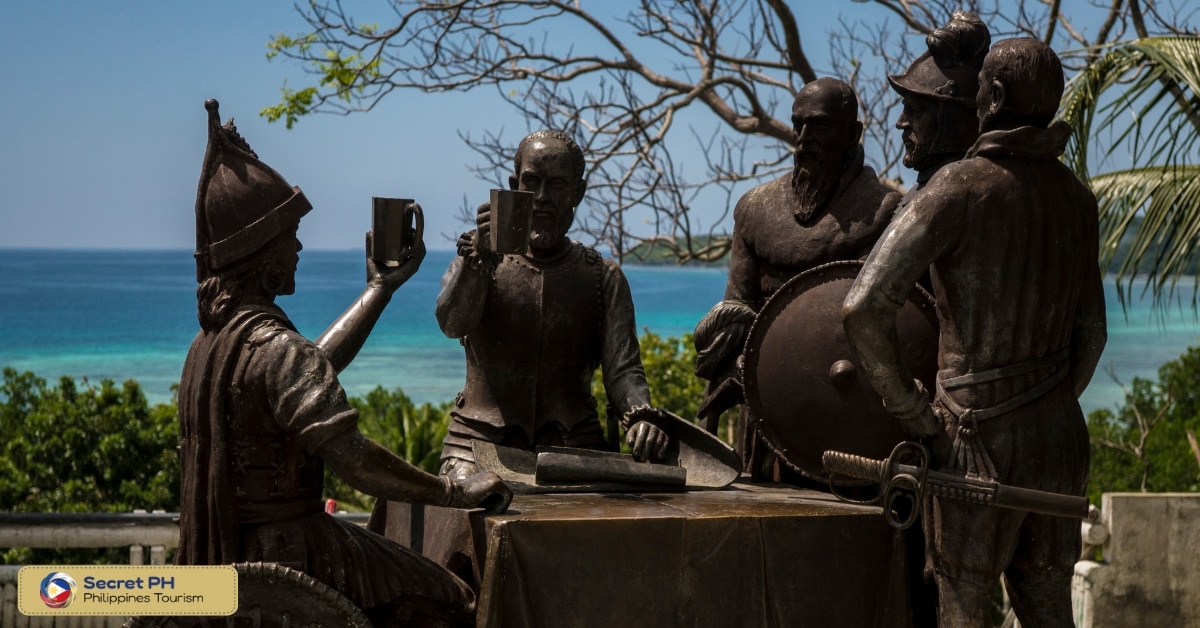
21. Jose Rizal Shrine
The Jose Rizal Shrine is a museum located in Fort Santiago, Intramuros, Manila, Philippines. It is a significant destination for cultural and historical exploration, as it serves as a memorial to one of the country’s most important heroes, Jose Rizal.
Jose Rizal was a writer, poet, and revolutionary who is widely considered a Philippine national hero. He is known for his works, which inspired the Philippine Revolution against Spanish colonial rule and led to the country’s independence.
The Jose Rizal Shrine is located in the cell where Rizal was imprisoned before his execution in 1896. The museum features exhibits that showcase Rizal’s life, works, and legacy, including original manuscripts, personal belongings, and memorabilia.
Address: Fort Santiago, General Luna St, Intramuros, Manila, 1002 Metro Manila
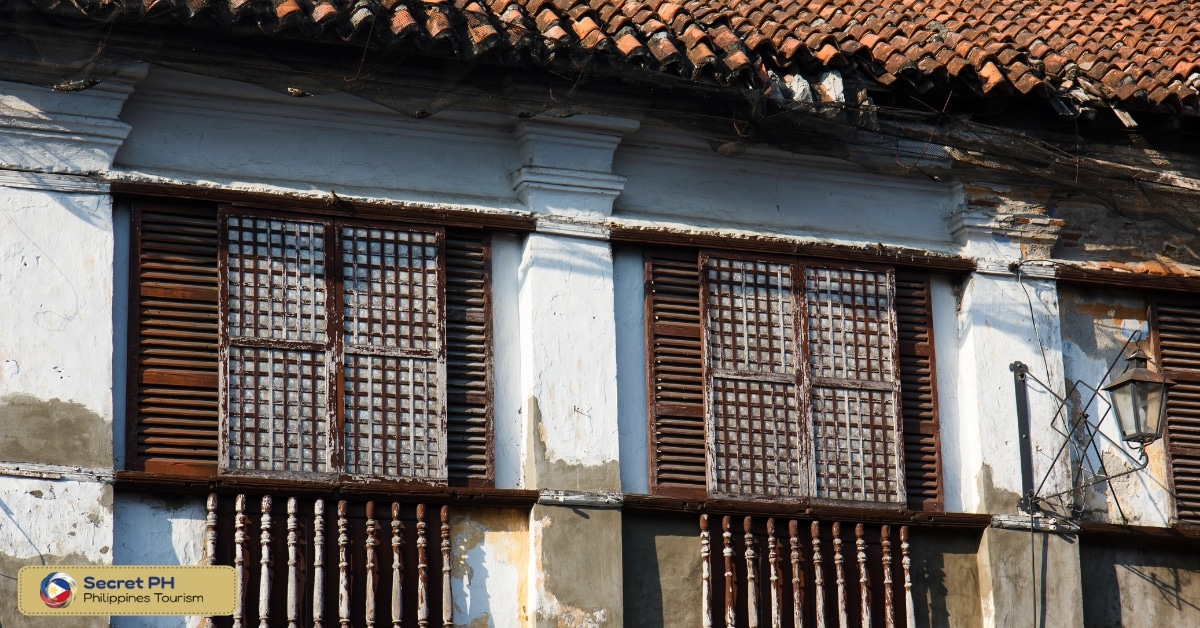
22. Sheik Karim al Makdum Mosque
The Sheik Karim al Makdum Mosque, also known as the Old Mosque, is a historic mosque located in Simunul, Tawi Tawi, Philippines. It is a significant destination for cultural and historical exploration, as it is considered the oldest mosque in the Philippines and Southeast Asia.
The mosque was built in the 14th century by Sheik Karim al Makdum, a Muslim missionary, and trader from the Arabian Peninsula. It was the first mosque in the Philippines and played an important role in the spread of Islam in the region.
Address: Simunul, 7505 Tawi-Tawi
Phone: +639054781367
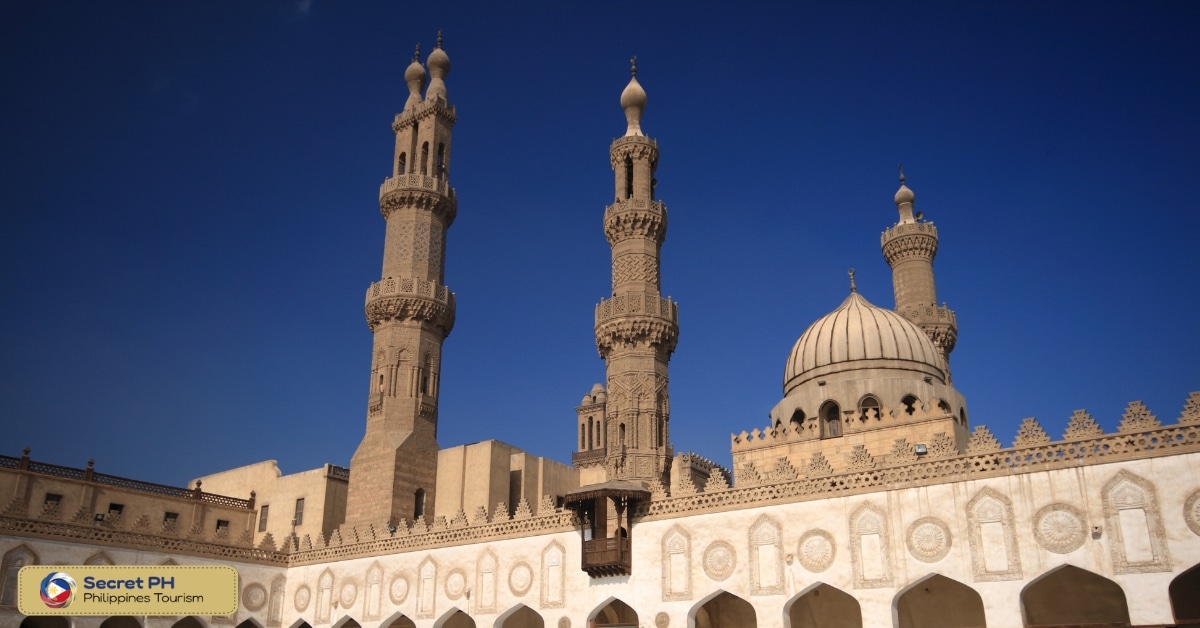
23. Leyte Landing Memorial Park
The Leyte Landing Memorial Park is a historical park located in Red Beach, Palo, Leyte, Philippines. It is a significant destination for cultural and historical exploration, as it marks the site where General Douglas MacArthur and the Allied Forces landed on October 20, 1944, during the Battle of Leyte Gulf in World War II.
It is a testament to the bravery and sacrifice of the Philippine and American soldiers who fought to reclaim the Philippines from Japanese occupation during the war. The park features monuments, memorials, and exhibits that commemorate the landing and the events that followed.
Address: Palo, Leyte
Phone: (053)8323993
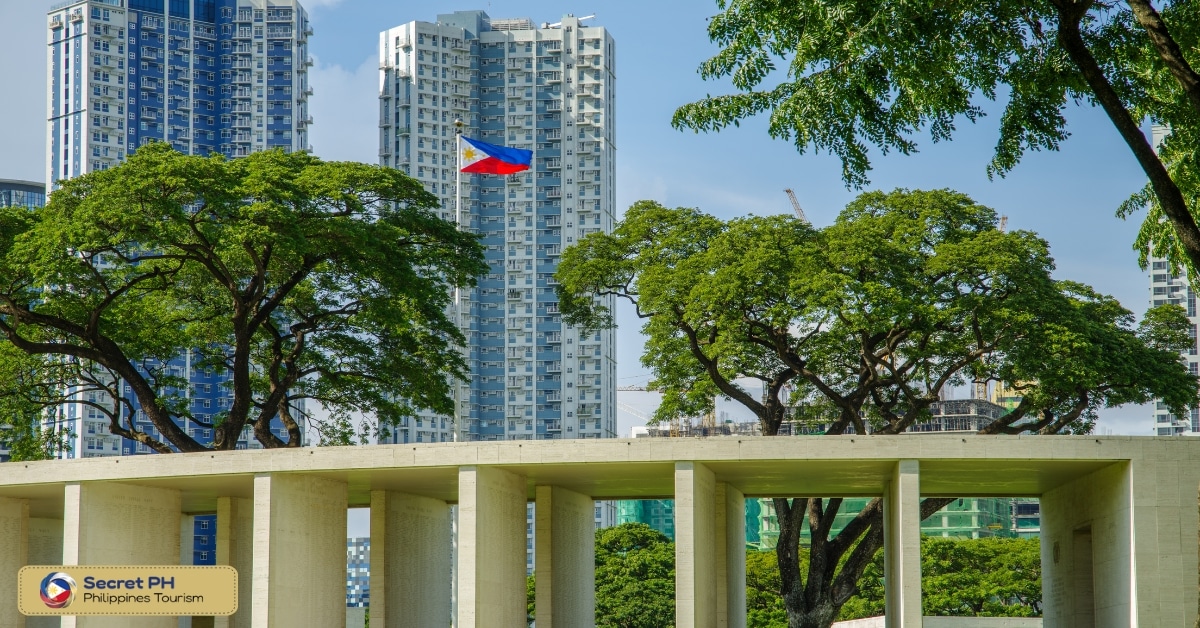
24. Cagsawa Ruins
The Cagsawa Ruins are the remnants of a church located in Daraga, Albay, Philippines. It is a significant destination for cultural and historical exploration, as it serves as a reminder of one of the most catastrophic events in Philippine history, the eruption of Mount Mayon in 1814.
It was originally built in the town of Cagsawa in the 1700s and was a major center of worship and community life. However, on February 1, 1814, the eruption of Mount Mayon buried the town of Cagsawa and the church in volcanic ash and lahar.
Today, the Cagsawa Ruins are one of the most popular tourist attractions in the Philippines, attracting visitors from around the world. The ruins stand as a testament to the power of nature and the resilience of the Philippine people.
Address: Daraga, 4501 Albay
Phone: +639075896521
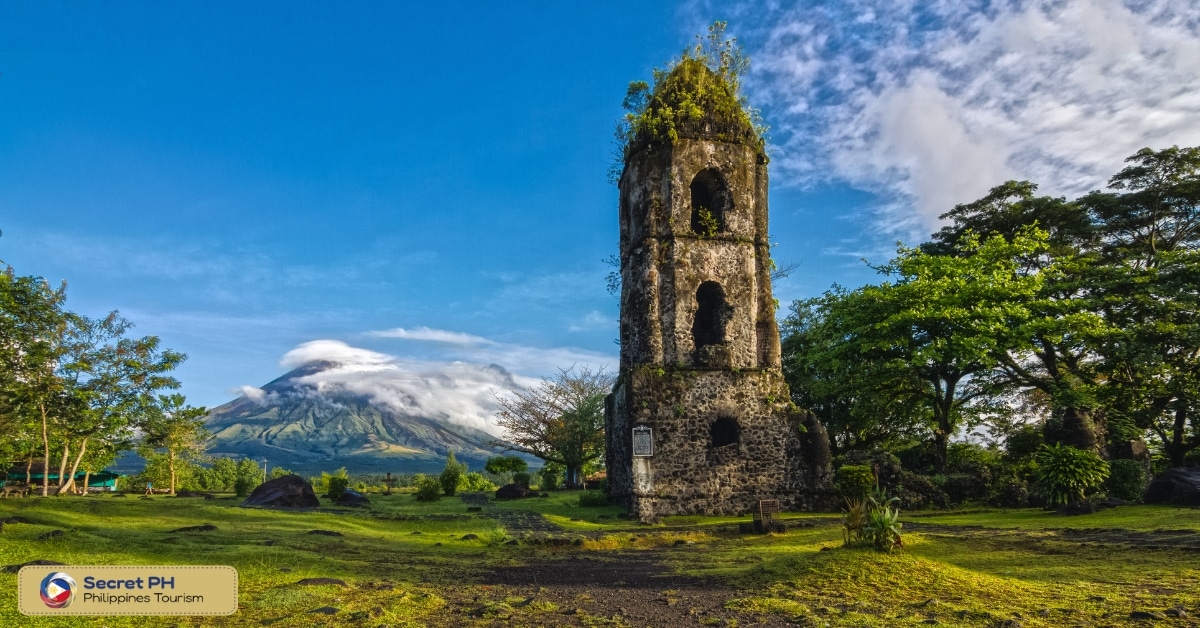
25. Sultan Kudarat
Sultan Kudarat, located in the province of Maguindanao in the Philippines, is a significant destination for cultural and historical exploration. It is named after Sultan Muhammad Dipatuan Kudarat, a Muslim leader who played a key role in resisting Spanish colonization in the region.
The province of Sultan Kudarat is rich in cultural heritage, with a long history of Islamic civilization and cultural traditions. Visitors can explore the grand mosque of Sultan Kudarat, which is considered one of the largest in the country and is known for its beautiful architecture and intricate carvings.
Another notable attraction in Sultan Kudarat is the Old Mosque of Sultan Kudarat, which dates back to the 1700s and is considered one of the oldest in the country. The mosque is a unique blend of Islamic and indigenous architectural styles and is a testament to the rich cultural heritage of the region.
Address: Maguindanao, Philippines
Phone: +639194853210
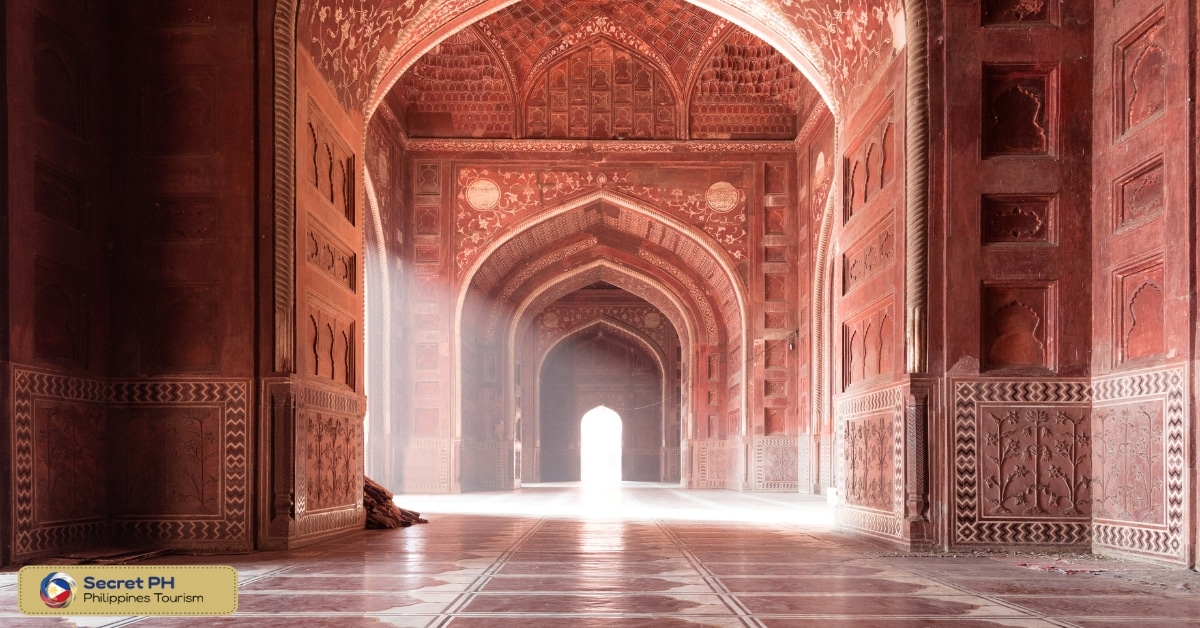
26. Limasawa Island
Limasawa Island is a small island located in the southern province of Leyte, Philippines. It is an important destination for cultural and historical exploration due to its significant role in Philippine history.
Limasawa Island is believed to be the site of the first Catholic mass in the Philippines, which was celebrated by the Spanish explorer, Ferdinand Magellan, in March 1521. This event marked the beginning of the Spanish colonization of the Philippines and had a profound impact on the country’s religious and cultural heritage.
Address: Leyte, Philippines
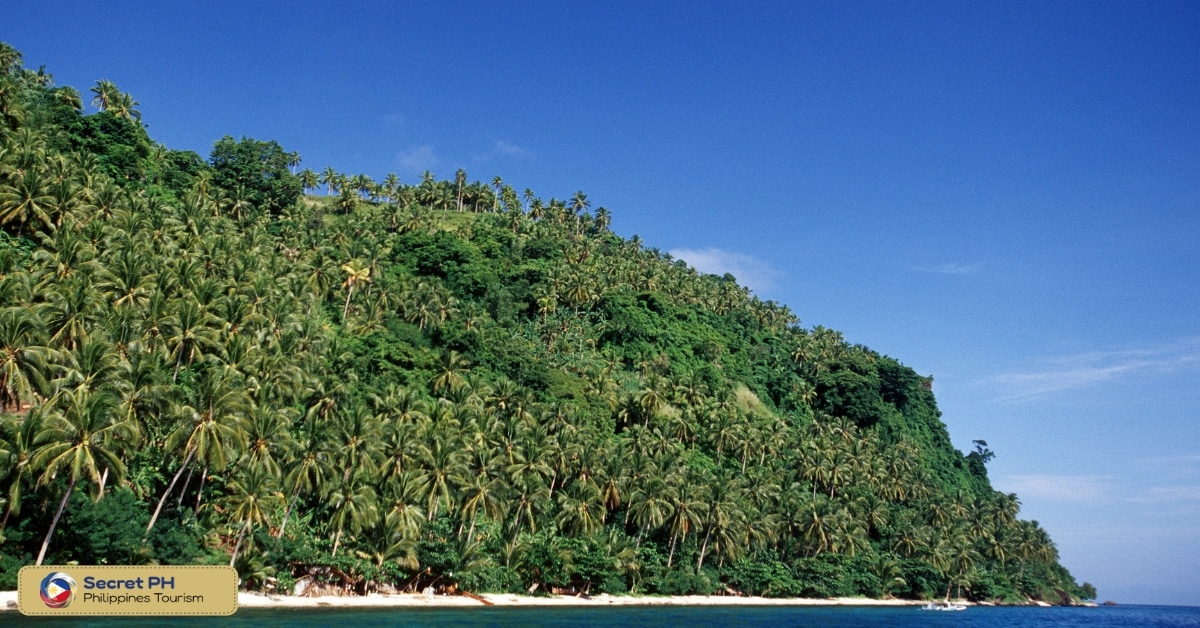
In conclusion
The Philippines is overflowing with rich and diverse cultural heritage, making it the perfect destination for anyone looking to explore some of Southeast Asia’s rich history.
From centuries-old ruins and beautiful colonial churches to bustling ports and vibrant festivals, the country offers its visitors a dizzying array of activities and places to explore.
Whether you’re looking to expand your knowledge or just soak in the local culture, these 26 destinations guarantee satisfaction. With this list of must-see locations, you can be sure that your Philippine adventure will be a memorable one.
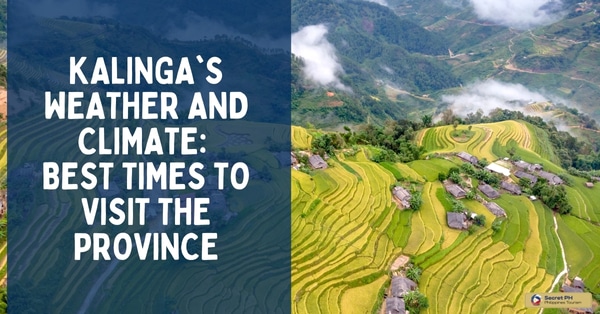
Kalinga’s ever-changing weather offers a prime visit window during its dry season from November to April, ideal for outdoor
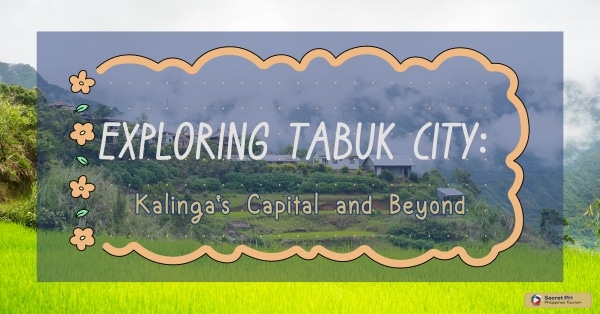
Tabuk City, Kalinga’s capital, is a vibrant blend of culture, nature, and adventure. Immerse yourself in indigenous traditions, explore
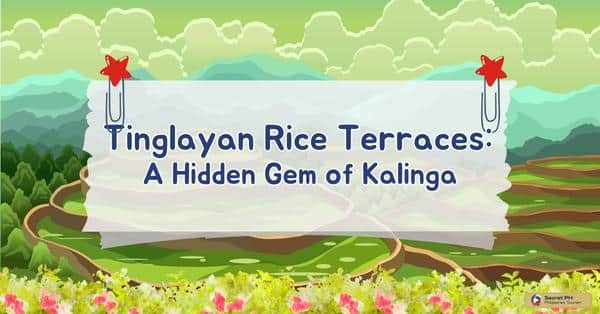
Tinglayan Rice Terraces in Kalinga are a photographer’s paradise, known for their intricate beauty. This region is steeped in

Kalinga, in the Philippines, offers a rich cultural experience with traditional festivals, dances, and music. You can witness the

Kalinga Province, in the Philippines, teems with a vibrant culture upheld by its indigenous people. This culture includes rich

Kalinga is a region in the Philippines renowned for its traditional weaving techniques. Founded over 500 years ago, it
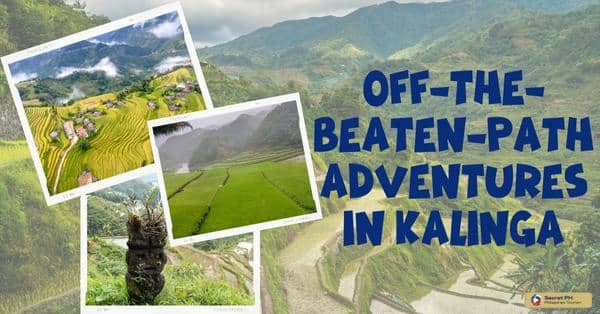
Kalinga is a remote mountain province in the Cordillera region of Northern Philippines. With its unique mix of cultural
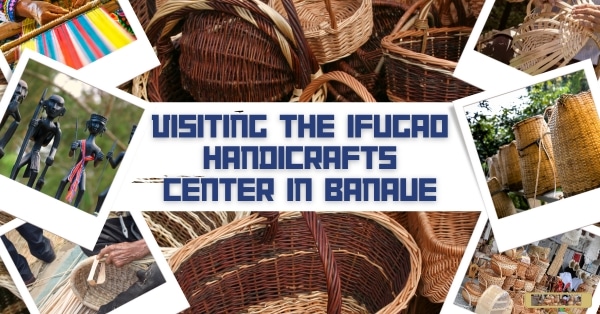
Visiting the Ifugao Handicrafts Center in Banaue is an experience that immerses you in a unique culture of traditional
Top 35 Must-Visit Historical Places & Landmarks in the Philippines
Where to go in ph: must-see tourist spots for history buffs.
- shares
- Share on Facebook
- Share on Twitter
LIST: 35 Must-Visit Historical Places in the Philippines
Table of Contents
Today, when some people are easily deceived by misinformation and hearsay they read on the internet, it’s vital to relearn what we know about history. It’s a well-known fact that the Philippines had a tumultuous past. But fortunately, we have researchers and historians backed with data and evidence who know what happened in the past. If you want to learn more about history, read books, watch documentaries, and visit historical sites—and here are some of the must-visit historical places all over the Philippines.

Fort Drum is a concrete military post shaped like a battleship. It’s located at the mouth of Manila Bay, which was used as a harbor defense during the American colonial period in 1909. In 1942, the fort was taken over by Japanese forces until 1945, when the American troops set it on fire, killing enemy troops. Since then, the war-torn fort has been abandoned, rusting in its place.
- Address: El Fraile Island, Cavite City
Plaza Cuartel, Puerto Princesa

Plaza Cuartel in Puerto Princesa City was a penal colony where hundreds of American soldiers were held captive. It is the site of the Palawan Massacre, where Japanese soldiers burned American troops alive in December 1944. Only 11 of the 154 soldiers survived. Now, the plaza has become a landmark in the town, reminding people of the gruesome incident in this garrison.
- Address: Taft St, Puerto Princesa, Palawan
- Related tours: Puerto Princesa Heritage Tour
Emilio Aguinaldo Shrine in Kawit, Cavite

One of the most significant historical sites in the Philippines is the Emilio Aguinaldo Shrine, where the Philippine Independence was declared. It was at the window of the grand hall of this mansion when the Philippine flag was waved and where the national anthem was first played, ending the Spanish colonization of the country. The first president Emilio Aguinaldo donated the mansion to the government, which became a shrine in 1964.
- Address: Brgy Kaingen, Kawit, Cavite
Mount Samat in Bataan

Mount Samat, situated in Bataan, is a historical mountain with a massive cross on the summit. On this mountain happened one of the battles of World War II, wherein Filipino and American soldiers fought against Japanese forces.
Unfortunately, the Japanese Imperial Army was too strong, and our troops had to surrender. The weary, famished soldiers had to walk more than 65 miles to the concentration camp, sadly leading to 10,000 soldiers dying–this was the Bataan Death March. Visitors may visit the top of Mount Samat by car or on foot.
- Address: Pilar, Bataan
Tabon Cave, Palawan

Tabon Cave is where the earliest evidence of man was discovered, where human fossils were found in a Lipuun Point cave. Archaeological remains and tools have been found, proving that people lived here many thousand years ago. This historical site, also known as the “Cradle of Civilization,” can be accessed by a boat ride to explore the cave, swim, and snorkel offshore.
- Address: Quezon, Palawan
EDSA Shrine, Quezon City

The Shrine of Mary, Queen of Peace or more commonly known as EDSA Shrine, is a symbolic shrine found in Quezon City. It was built in 1989 to commemorate the historic People Power Revolution, where peaceful demonstrations occurred to topple Dictator Ferdinand Marcos in People Power I and Joseph Estrada during People Power II.
- Address: EDSA corner Ortigas Avenue, Quezon City
Binondo, Manila

Binondo is not just your ordinary Chinatown– it is recognized as the oldest Chinatown in the world, previously a center of commerce in Manila during the American colonization period. Visit the Binondo Church, also known as the Quiapo Church, the principal place of worship. You’ll also find Buddhist temples here. At present, people come here to tour, shop, and eat.
Tirad Pass, Ilocos Sur

Tirad Pass is where Philippine General Gregorio Del Pilar led the battle against American forces in 1899, known as the Battle of Tirad Pass. In this battle, Del Pilar fought with American troops to let President Emilio Aguinaldo escape going to the North. Aside from its historical significance, this destination in Ilocos Sur is a must-visit for hikers who want to climb Mount Tirad.
Barasoain Church, Bulacan

One of the most famous landmarks in the Philippines, Barasoain Church is a huge part of Philippine history because it was where the First Philippine Republic was inaugurated on January 23, 1899. Aside from that, it is also where the First Philippine Congress convened, and the Malolos Constitution was drafted in 1898-1899. The Roman Catholic Church is still recognized as one of the most important religious sites in the Philippines.
- Address: Paseo del Congreso Street corner Don Antonio Bautista Street, Brgy. San Gabriel, Malolos, Bulacan
Malacañang Palace, Manila

The official residence and workplace of the Philippine president is the Malacañang Palace, situated in San Miguel, Manila. This grand structure was originally built in 1750 by Don Luis Rocha as a summer house. Now, it’s the seat of power, and the sprawling complex houses several Spanish-style buildings. Guided walking tours are available to learn about the structure and the presidents who lived here.
Address: J.P. Laurel Street. San Miguel, Manila
Fort Santiago, Manila

Located in Intramuros , Manila, this iconic landmark was a fortress that saw many historical events in the Philippines, such as the imprisonment of the national hero Jose Rizal, the invasion of Chinese pirates spearheaded by Limahong, and the start of the American rule in the Philippines. There are many sites to explore in Fort Santiago and nearby attractions with historical value.
- Address: Palacio Del Gobernador, General Luna Corner Aduana Streets, Intramuros, Manila City
- Related Tours: Old Manila Heritage Full-Day tour
Calle Crisologo, Vigan

The beautiful, nostalgic old-town street of Calle Crisologo in Vigan, Ilocos Sur , is famous in the North. The street is a glimpse of the past, where you can see old stone ancestral houses, cobblestone roads, and horse-drawn carriages. The street was once the venue of commercial trade in North Luzon, where foreign traders did their business in the Philippines. Now, Calle Crisologo is still a retail haven, where local traders now fill the stalls with souvenir items, snacks, and other Ilocano delicacies.
- Address: Crisologo, Vigan City, Ilocos Sur
Corregidor Island

This island fortress served as the point for naval defenses in Manila due to its strategic location at the opening of Manila Bay. Corregidor Island is a military bastion where Filipino and American soldiers fought against Japanese soldiers during World War II. People can still see the ruins and remains of the military forces, where memorable artifacts that remind us of heroism and valor can be seen.
Rizal Park, Manila

More commonly known as Luneta, the Rizal Park is where the Rizal Monument stands, which also contains some of the hero’s remains. This atmospheric park was once the site where the Spaniards executed the national hero. Aside from seeing the monument, parkgoers enjoy attractions such as a dancing musical fountain, a garden, and the National Museum nearby.
- Address: Roxas Boulevard, Ermita, Manila
Intramuros, Manila

400 years ago, Intramuros was the Spaniards’ military and political base in Asia. Also called the “Walled City,” huge 4.5km walls were used as defenses from invaders and disasters. It’s now one of the most famous historical tourist destinations in Manila, where you can learn about the history of the Philippines. Discover gateways, watch cultural performances, and other historical spots in the old district of Intramuros.
Cagsawa Ruins, Albay

The church tower you can see from the Cagsawa Ruins was what was left of the Cagsawa Church. In 1636, it was destroyed by Dutch pirates and rebuilt in 1724. However, the church was destroyed again by the Mayon Volcano eruption. Though the church has not been rebuilt, the current site is still as glorious, thanks to the perfect cone-shaped Mount Mayon in the background.
- Address: Brgy. Busay, Daraga, Albay
Biak-na-Bato, Bulacan

Biak-na-Bato is a protected area and a national park located in Bulacan. It comprises caves used as hideouts for Filipino revolutionaries against Spanish troops. On November 1, 1897, the revolutionaries led by Emilio Aguinaldo and Spanish Colonial Governor-General Fernando Primo de Rivera signed a pact wherein the revolutionaries were given amnesty. In return, they had to go into exile in Hong Kong. Now, the park is open to the public, where people enjoy trekking.
- Address: Doña Remedios Trinidad, Bulacan
Baguio City

Did you know that Baguio City was once an important piece of Philippine history? In 1941, Japanese invaders attacked Camp John Hay and used it as a military base. During the American colonial period, Baguio got its “Summer Capital of the Philippines” designation. Baguio was established as a hill station by the United States in 1900 at the site of an Ibaloi village known as Kafagway.
Related Tours:
- Breathe Baguio. Join in Tour
- Baguio Instagram Walking Tour
- Baguio Historical Walking Tour
University of Santo Tomas

The University of Santo Tomas, or UST, is recognized as the oldest existing university in Asia. This private Catholic university was founded in 1611 and is known to be where national hero Jose Rizal previously studied. During the Japanese colonial period, the Japanese forces made UST their internment camp. The Catholic University of the Philippines stands strong, with more than 400 years of history.
- Address: España Blvd, Sampaloc, Manila
Bataan Death March Markers

The gruesome Bataan Death March that killed thousands of soldiers was a tragic experience for many Filipinos. In honor of these brave men, 138 death march markers were placed from Mariveles to the Capas National Shrine (formerly Camp O’Donnell). These white obelisk plaques are placed along the roads, reminding travelers of where soldiers showed courage and heroism.
- Address: Bagac, Bataan
Banaue Rice Terraces, Ifugao

Northern Luzon is where you’ll find the National Cultural Treasure of the Philippines, the Banaue Rice Terraces. Built 2,000 years ago, these beautiful and lush rice terraces were carved by Igorot ancestors by hand. Tourists flock to Ifugao to see these in person, by trekking, in the vast mountainous regions of Cordillera.
- Address: Nueva Vizcaya – Ifugao – Mountain Province Rd, Banaue, Ifugao
MacArthur Leyte Landing Memorial National Park

Characterized by the bronze statue of General Douglas MacArthur, the Leyte landing Park or MacArthur Landing Memorial Park, was built to commemorate his return. Along with General MacArthur’s statue are his Filipino companions. It’s located in the same exact place in Palo, Leyte. Apart from the landmark, the site is family-friendly, where you can have picnics and stroll around the area.
- Address: Palo, Leyte
Sandugo Shrine, Bohol

Sandugo Shrine, or the Blood Compact Shrine, is a must-see in Bohol. This shrine symbolized the blood compact between Bohol Chieftain Datu Sikatuna and Spanish explorer Miguel Lopez de Legazpi in 1565, the first treaty between Spaniards and Filipinos. The statues were made by National Artist Napoleon Abueva. A visit to this shrine is free of charge.
- Address: EK Inting St, Tagbilaran City, 6300 Bohol
Fort San Pedro, Cebu

Fort San Pedro, now a historical park, was once a military garrison where Spanish settlement was first situated. Its original structure was wood but then replaced with stone in the 17th century. It’s a triangle-shaped fort with two sides that face the sea and, on one, the land. Now it serves as a museum and park for guests to learn about the early Spanish settlement in the Philippines.
- Address: A. Pigafetta Street, Cebu City
Basilica Minore del Santo Niño, Cebu

Known as the oldest Catholic Church in Cebu, the Basilica Minore del Santo Niño is a pilgrimage site where Lopez de Legazpi’s Spanish forces discovered the image of Santo Niño. It was considered miraculous, as it was discovered in a burnt box, but the image was not. The first church was built in 1565 but was destroyed and rebuilt again until it was converted to a Basilica Minore by Pope Paul VI in 1965.
- Address: Pilgrim’s Center, Osmeña Blvd, Cebu City
Mactan Shrine, Cebu

This monument was built in honor of Mactan chieftain Lapu-Lapu, who defended the island from the Spaniards. It is believed that the shrine placement was where the exact battle happened. There’s also a Magellan monument near the shrine. These are found in Punta Engaño in Mactan Island.
- Address: Mactan, Lapu-Lapu City, Cebu
The Ruins, Talisay, Negros Occidental

The Ruins is actually the remains of a once-grand mansion in Talisay. The mansion was owned by the family of Don Mariano Ledesma Lacson and Maria Braga Lacson. The Italian-style mansion was built in the 1900s but was burned by Filipino guerillas so that the Japanese forces won’t have to use it as their military headquarters. It’s now a tourist attraction frequented by tourists who want to see the dramatic ruins up close.
- Address: Don Mariano L. Lacson Highway, Brgy. Zone 15, 6100 Talisay, Negros Occidental
Limasawa Island, Southern Leyte
Limasawa is where the earliest recorded Christian mass in the Philippines occurred, during Easter Sunday. This idyllic island is also ideal for a relaxing beach vacation, best discovered underwater with its rich corals.
- Address: Limasawa, Southern Leyte
Cinco de Noviembre Memorial, Negros Occidental

Cinco de Noviembre Memorial is a significant slice of history in Negros. This marker point commemorated the event when the Spanish rule ended in Negros. The plan for a bloodless revolt against Spaniards happened in this marker point, formerly Farmacia Locsin. It was on the 5th of November when the revolt began, thus the memorial’s name.
- Address: Mambulac Road, Silay City Heritage Zone, Silay City, Negros Occidental
Sheik Karimol Makhdum Mosque, Tawi-Tawi

The oldest mosque in the Philippines, Sheik Karimol Makhdum Mosque , was built in 1380 by Arab trader Sheikh Makhdum Karim. It’s a National Historical Landmark, situated in Tubig Indangan, Tawi-Tawi. It also serves as the place where the Islamic faith began in the country. Behind the mosque is the burial site of Sheikh Makhdum as well.
- Address: Brgy. Tubig Indangan, Simunul, Tawi-Tawi
Jose Rizal Shrine, Dapitan

This landmark in Dapitan, Zamboanga City, sits in the estate bought by Jose Rizal himself using his lottery winnings. Jose Rizal Shrine tells the story of Jose Rizal in Dapitan , where he went into exile. Aside from the shrine itself, you can also explore the Jose Rizal Memorial Protected Landscape.
Address: Purok Linao, Talisay, Dapitan City, Zamboanga del Norte
Fort Pilar, Zamboanga City

This 17th-century military fortress was built by the Spaniards during their colonization of the country. Now a regional museum, Fort Pilar lets you see some of its ruins and the garden inside and outside the fort. The eastern wall is dedicated to Our Lady of the Pillar, the city’s patroness.
- Address: N.S. Valderosa Street, Zamboanga City
Sunken Cemetery Camiguin

Located in Catarman, Camiguin Island, the Sunken Cemetery is a unique destination marked by a cross in the middle of the sea where tombstones lie underwater. The sunken cemetery resulted from a series of volcanic eruptions that occurred from the 1800s up to the 1960s. Now, tourists flock to the cemetery and go on a short dive to explore what’s underwater.
- Address: Barrio Bonbon, Catarman, Camiguin
Japanese Tunnel, Davao City

A tunnel created by Filipino prisoners during World War II can be found in Davao City. The Davao Japanese tunnel , discovered during road construction in the 1960s, was once a hideout and a way to transport equipment. You’ll find replicas and artifacts of what it once looked like during World War II.
- Address: Talomo, Davao City, Davao del Sur
Taluksangay Mosque, Zamboanga City

Taluksangay Mosque is known to be the oldest mosque in the Zamboanga Peninsula. It’s easily recognizable thanks to its red dome, which stands out among the greeneries. This was the center of Islam propagation, constructed by Sama Banguingui Chieftain Hadji Abdullah Maas Nuno in 1885.
- Address: Brgy. Taluksangay, Zamboanga City
Have you visited any of these historical landmarks in the Philippines? Do you know other fascinating historic places that we should add on this list? Make this your bucket list, and learn all about Filipino history through traveling!
Follow the Out of Town Travel Blog on Facebook , Twitter , Instagram , and Pinterest if you want more travel and tech-related updates.
- FREE Things To Do Near Central Park, New York City
- The Central Market: A Landmark For Malaysian Culture And Heritage
- Top 15 Best Countries to Visit in Asia
- Fact: You Don’t Have to Visit to Really Know a Country
- CALABARZON Travel Guide: Cavite, Laguna, Batangas, Rizal and Quezon Top Attractions
Written by Melo Villareal
Melo Villareal is the Online Publisher of Outoftownblog.com. He is an Accountant by profession who left the corporate world at the age of 23 to explore his beautiful country and the rest of the world. Today, Melo works as a part-time Social Media Manager for local and international clients. His full-time work focuses on discovering interesting culture, explore different cuisines and take memorable photos from local and international destinations he's visiting.
What do you think?

8 Beautiful Parks and Gardens in Sapporo

Top 15 Best Things to Do in Fontana, California
© 2024 by Team Out of Town
With social network:
Or with username:.
Username or Email Address
Remember Me
Forgot password?
Enter your account data and we will send you a link to reset your password.
Your password reset link appears to be invalid or expired.
Privacy policy.
To use social login you have to agree with the storage and handling of your data by this website. Privacy Policy
Add to Collection
Public collection title
Private collection title
No Collections
Here you'll find all collections you've created before.

Top 24 Must-Visit Historical Places & Landmarks in the Philippines
Updated on: February 4, 2024
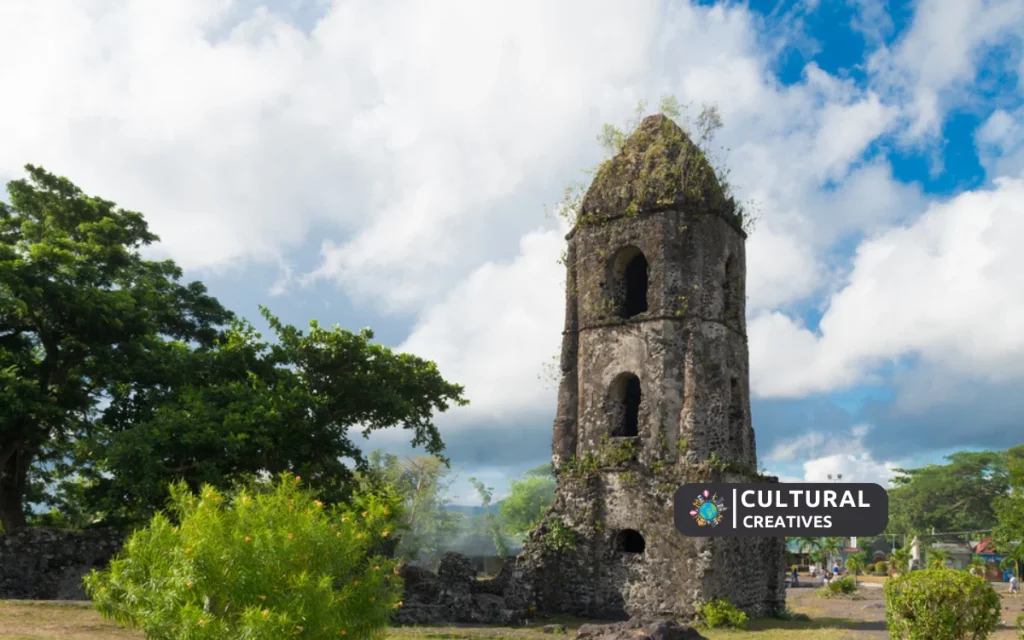
The Philippines boasts numerous historical landmarks, including the walled city of Intramuros and the ancient Rice Terraces of the Philippine Cordilleras. Historical sites like the Barasoain Church and Rizal Park also hold significant cultural value.
Discover the rich historical Places in the Philippines, an archipelago with a past marked by diverse cultural influences, colonial history, and indigenous heritage. From the cobblestone streets of Vigan, a well-preserved example of a Spanish colonial town, to the majestic Fort Santiago, which has stood witness to both the Spanish and American eras, these sites are not merely relics but vivid narrations of the nation’s journey.
The Blood Compact Shrine in Bohol commemorates the first treaty of friendship between the East and the West, while the Mactan Shrine in Cebu celebrates the heroism of Lapu-Lapu against Ferdinand Magellan. Tourists and history enthusiasts alike are drawn to these landmarks, each offering a unique glimpse into the cultural and historical saga that has shaped the Philippine identity.
Why Are Historical Places Important In The Philippines?
The Philippines, with its rich and diverse history, offers an array of historical places that serve as tangible links to its past. Such locations are not only aesthetically captivating but hold the identity and heritage of a nation known for its colorful tapestry of cultural influences.
They act as educational resources for both locals and tourists, providing insight into the historical events that shaped the nation’s character and ethos. Preserving these sites ensures that future generations can continue to learn from and appreciate the intricate stories woven into the fabric of Filipino history.
Establishing a deep connection with such landmarks fosters a sense of pride and responsibility, prompting communities to participate in the safeguarding of their cultural legacy.
What Is A Famous Landmark In The Philippines?
The historic walled city of Intramuros stands as a testament to the Philippines’ rich colonial past. This monumental fortress, once the epicenter of Spanish rule in Asia, is now a hub where cobbled streets and centuries-old architecture offer a journey back in time.
Visitors meandering through its corridors encounter San Agustin Church, a Baroque-style marvel and UNESCO World Heritage site. This illustrious landmark, along with the grand Manila Cathedral and storied Fort Santiago, provide an evocative glimpse into the nation’s bygone eras. The allure of Intramuros goes beyond mere aesthetics; it’s a chapter of Philippine history preserved in stone and mortar, beckoning explorers to uncover its enduring legacy.
Through its survival of wars and natural disasters, Intramuros symbolizes the resilience and enduring spirit of the Filipino people.
Top 24 Historical Places in the Philippines
1. intramuros.
A historical fortress full of storied walls and ancient edifices. This iconic walled area, known as the “Walled City,” served as the seat of power during the Spanish colonial period and continues to captivate visitors with its old-world charm.
Exploring its cobblestone streets, tourists can encounter the grand Manila Cathedral, the storied Fort Santiago, and a host of other colonial structures that have withstood the test of time. Each corner of Intramuros offers a silent narrative, echoing tales of historical significance that have played pivotal roles in shaping the Filipino heritage.
Walking through its corridors, one can almost hear the whispers of the past, making it a must-visit destination for history aficionados and curious travelers alike.
2. Fort Santiago
Fort Santiago stands as a timeless testament to the rich history of the Philippines. Built by Spanish conquistador Miguel López de Legazpi in 1571, this citadel was both a defensive fortress and a penal institution during the Spanish Colonial Period.
Its storied walls have witnessed crucial events, including the incarceration of Philippine national hero, Dr. Jose Rizal, before his execution. Today, visitors can explore the hallowed grounds where Rizal spent his final days, as well as the Rizal Shrine, dedicated to his life and works.
The fort’s storied gates, baroque architecture, and lush gardens offer a unique glimpse into the country’s turbulent yet fascinating past. As a crucial part of Intramuros, Manila’s historic walled city, Fort Santiago invites history buffs and casual tourists alike to step back in time and experience the Philippines’ legacy firsthand.
Delving into the heart of Manila, Binondo emerges as the world’s oldest Chinatown, with a rich tapestry of history that dates back to the 16th century. This cultural enclave offers a unique blend of Filipino and Chinese heritage, seen through its unique architecture, traditional shops, and age-old temples, including the revered Minor Basilica of San Lorenzo Ruiz.
Visitors become time-travelers as they stroll along the Ongpin Street, a place teeming with culinary delights and various goods that reflect a confluence of influences throughout its storied past. Exploring Binondo is an immersive experience, giving a tangible connection to the Philippines’ multifaceted history and showcasing the evolution of this community over centuries.
4. Banaue Rice Terraces
The Banaue Rice Terraces are a monumental testament to ancient engineering. Carved into the mountainside over 2000 years ago, these terraces are often referred to as the “Eighth Wonder of the World.
” The knowledge passed down through generations has sustained this intricate ecosystem, which continues to provide sustenance and a unique agricultural landscape. Visitors to the terraces are greeted by the breathtaking vistas of verdant green steps, which change hue with the seasons and reflect the rich cultural heritage of the Ifugao people.
Recognized as a UNESCO World Heritage site, these terraces symbolize the harmonious relationship between nature and mankind, shaped over centuries of coexistence.
5. Casa Manila
The old city of Casa Manila stands as a testament to Philippine colonial history. This museum replicates a Spanish colonial mansion and serves as a gateway to the opulent lifestyle of the social elite during the 1800s.
Rich in cultural heritage, this edifice showcases a collection of antique furniture, artworks, and various relics reflective of the era’s Filipino-Spanish culture. Visitors can stroll through its rooms and courtyards to get a glimpse of the past, making it a must-visit for history enthusiasts and those seeking to understand the Philippines’ colonial legacy.
With its architecture and period-correct decor, Casa Manila does not just educate; it transports one back to a time of grandeur and intricate detail, mirroring the affluence and aesthetics of bygone eras.
6. Rizal Park
Rizal Park serves as a verdant oasis amidst the cityscape and stands as a tribute to the Philippines’ national hero, Dr. Jose Rizal. This iconic landmark is not only a place of leisure where families gather and enjoy the manicured gardens, but it is also a site of historical significance.
Within its bounds lies the Rizal Monument, which holds the remains of the revered Filipino writer and patriot, marking the spot where he was executed by Spanish colonial authorities. Visitors come from far and wide to pay respects and imbibe the rich history, making it an indelible part of the nation’s cultural heritage.
The park’s atmosphere, complemented by monuments, museums, and open-air concert halls, offers a multifaceted glance into the country’s past and present.
7. Calle Crisologo
Stepping into Calle Crisologo transports visitors to a bygone era, where the cobblestoned streets echo the footsteps of history. This iconic street in Vigan, Ilocos Sur, is famed for its well-preserved Spanish colonial houses, an enduring testament to its rich historical tapestry.
Journeying along this street, one is enveloped by an atmosphere steeped in the past, as horse-drawn carriages, known locally as kalesas, add to the charm of a leisurely stroll. A visit here, especially during the golden hours of dawn or dusk, offers a glimpse into the Philippines’ history with every stone and building narrating tales from centuries past, making it a favorite destination for both local and international travelers alike.
The architecture showcases a blend of Filipino craftsmanship and colonial European influences, securing Calle Crisologo’s position as a treasured national landmark.
8. Manila Cathedral
The Manila Cathedral stands as a magnificent architectural tribute to the enduring Spanish colonial influence on Philippine culture and religion. Officially known as the Minor Basilica and Metropolitan Cathedral of the Immaculate Conception, this grand edifice has withstood the test of time, surviving seven earthquakes and two fires since its initial construction in 1581.
The cathedral serves as the episcopal seat of the Archbishop of Manila and has been a beacon of faith for Filipino Catholics through the centuries. With its neo-Romanesque facade, opulent interiors, and striking stained-glass windows, the Manila Cathedral invites visitors to explore a hallowed sanctuary that is as much a celebration of religious devotion as it is a testament to the Philippines’ rich historical tapestry.
9. Rizal Shrine
A historical monument dedicated to the Philippines’ national hero, Dr. Jose Rizal. This reconstruction of Rizal’s ancestral home offers a glimpse into his formative years and showcases a collection of memorabilia, including family artifacts, personal belongings, and historical documents.
Visitors to the shrine can walk through the Spanish Colonial-style house, which has been meticulously preserved to reflect the period’s ambiance. The serene surroundings peppered with lush greenery provide a contemplative backdrop for learning about Rizal’s life and his significant contributions to Philippine history and identity.
The Rizal Shrine serves not only as a tribute to his legacy but also as an educational center that inspires national pride.
10. San Agustin Church
Stepping into San Agustin Church, visitors are immediately transported back to the Spanish colonial era, as this architectural gem stands as the oldest stone church in the Philippines. This Baroque masterpiece has been witness to the ebb and flow of Philippine history since its completion in 1607.
Surviving countless earthquakes and wars, including World War II which left much of Manila in ruins, San Agustin Church remains largely intact, boasting intricate trompe-l’oeil frescoes and a stunningly detailed ceiling. The church, a designated UNESCO World Heritage site, reveals a richly decorated interior and houses a museum that showcases religious art and artifacts, offering a deep dive into the country’s cultural and religious heritage.
Visitors marvel at the elaborate carvings and reliefs that adorn its walls, and the awe-inspiring ambiance that permeates this historic sanctuary.
11. University Of Santo Tomas
Founded in 1611 by the Order of Preachers, the University of Santo Tomas stands as the oldest existing university in Asia, exuding a rich history that spans over several centuries in the heart of Manila, Philippines. Its captivating architecture, infused with colonial Spanish influences, is a testament to the country’s diverse historical narrative.
As the alma mater of many of Philippine society’s luminaries, its hallowed halls have been a crucible for leadership, philosophy, and innovation. Strolling through the campus, one is enveloped by a sense of antiquity and academic excellence. The university not only offers an educational journey but also serves as a monument to the enduring legacy of the Filipino spirit and scholastic achievement.
Visitors and scholars alike can feel the weight of history and the vibrancy of the present converging within its storied walls.
12. Barasoain Church
Barasoain Church isn’t just a site of architectural marvel, but also a beacon of Philippine history. Known formally as Our Lady of Mt. Carmel Parish, it holds the prestige of being the birthplace of the First Philippine Republic, making a visit to this church a journey through the nation’s formative years.
Stepping inside, the eloquently painted ceilings and the historical markers aid in transporting visitors back to the time when Filipinos first embraced democracy. Remarkably, it was within these walls that the Malolos Constitution was drafted, signifying the church’s role not merely as a religious sanctuary but also as a cradle of patriotism.
A trip to Barasoain Church, therefore, is more than a spiritual pilgrimage – it’s an homage to the enduring spirit of Filipino independence.
13. Corregidor Island
Corregidor Island stands as a bastion of the past, offering a solemn reminder of wartime resilience. Once a fortified military stronghold, this tadpole-shaped islet played a significant role during World War II and has now transformed into a poignant historical landmark accessible to tourists and history enthusiasts alike.
Visitors can explore the hauntingly beautiful ruins of barracks, war-ravaged gun emplacements, and tunnels that weave through the island’s core. Each step taken through its verdant landscapes whispers tales of bravery and sacrifice, making it an essential stop for those delving into the Philippines’ rich historical tapestry.
Uniting the natural beauty with the echoes of history, Corregidor Island emanates an atmosphere of reverence and reflection.
14. Fort San Pedro
A historical bastion of Spanish legacy on Philippine soil. Constructed in the 17th century, it has endured the passage of time, bearing witness to the country’s colorful past. Visitors will find themselves transported back to the era of colonial rule as they explore the fort’s storied walls and artifacts.
Ideal for history buffs and casual tourists alike, the fort’s preserved architecture offers a rare glimpse into the Philippines’ martial heritage and its strategic significance during the Spanish period. With lush gardens surrounding the structure, Fort San Pedro serves not only as a historical monument but also as a tranquil escape from the urban expanse of Cebu.
15. Macarthur Leyte Landing Memorial National Park, Palo
Steeped in historical significance, MacArthur Leyte Landing Memorial National Park in Palo serves as a poignant reminder of the day General Douglas MacArthur fulfilled his promise to the Filipino people during World War II. This site marks the iconic moment on October 20, 1944, when American forces, led by MacArthur, landed to begin liberating the Philippines from Japanese occupation.
Visitors today can explore the park and observe the larger-than-life statues depicting the momentous event, while learning more about the critical role this area played. The park’s coastline offers a scenic backdrop, and the meticulously maintained grounds provide a serene environment for reflection on the bravery that shaped the nation’s history.
16. Binondo Church
Steeped in history, Binondo Church stands as a testament to the Philippines’ past. Officially known as Minor Basilica of Saint Lorenzo Ruiz, this architectural gem resides in the heart of Manila’s Chinatown—the oldest in the world. Constructed in 1596 by Dominican priests to serve their Chinese converts to Christianity, the church has survived wars and natural disasters, although it has been rebuilt several times.
Its current iteration, a fusion of Spanish Colonial and Neo-Romanesque designs, remains a popular destination for tourists and locals alike. The octagonal bell tower, a remnant of the 16th-century structure, dominates the skyline, while inside, visitors are welcomed by intricate frescoes and a revered image of the Our Lady of the Most Holy Rosary.
Binondo Church not only holds ecclesiastical significance but also serves as a cultural bridge between the Filipino and Chinese communities.
17. Cagsawa Ruins
The Cagsawa Ruins stand as a poignant testament to the devastating power of nature and the resilience of Filipino culture. The remnants of the Cagsawa Church, destroyed during the catastrophic eruption of Mount Mayon in 1814, capture the imagination of visitors with their bittersweet beauty.
Local folklore and captivating stories of past events envelop the site, drawing travelers and historians alike to this emblematic locale. The iconic belfry, stubbornly jutting out from the ground, serves as a photographic souvenir against the backdrop of the majestic, yet fearsome volcano, symbolizing the tumultuous history between humankind and nature in this picturesque region of the Philippines.
18. Fort Pilar
Stepping into Fort Pilar is akin to traversing through the annals of time, where stories of battle and peace intertwine. This 17th-century military defense fortress, located in Zamboanga City, serves as a testament to the Spanish colonial period’s rich history.
This bastion of heritage, originally named Real Fuerza de Nuestra Señora del Pilar de Zaragoza, has withstood sieges and conflicts, emerging as a symbol of resilience. Today, visitors are greeted by walls that have witnessed centuries of history. The structure also houses a shrine, a beloved site for pilgrims, adding a layer of spiritual significance to the historic fort.
Unveiling the complexities of the Philippines’ past, Fort Pilar offers a unique perspective into the cultural fusion that defines the nation’s identity.
19. Mactan Shrine
The Mactan Shrine, located on the island where the Battle of Mactan took place, stands as an emblem of bravery and patriotism in the Philippines. Erected in honor of Lapu-Lapu, the chieftain who defeated Ferdinand Magellan in 1521, this monument offers a glimpse into the country’s rich historical tapestry.
Visitors are embraced by the story of the first recorded instance of Filipino natives resisting foreign conquest. The shrine not only commemorates the battle but also pays homage to the explorer Magellan who was slain on its shores. The site serves as a reminder of the cultural heritage and enduring spirit of the Filipino people.
It is a testament to the pivotal moments that have shaped the archipelago’s history and remains a place of reflection for both locals and tourists alike.
20. Quiapo Church
Quiapo Church stands as a testament to the rich heritage and enduring faith of the Filipino people. Officially known as the Minor Basilica of the Black Nazarene, this historic structure is a cornerstone of Philippine culture, attracting millions of devotees annually, particularly during the Feast of the Black Nazarene.
Renowned for its Baroque architecture, the church showcases intricate designs and a storied past that reflects the complexities of the nation’s colonial history. Visitors are often captivated by the poignant atmosphere and the deep spirituality that permeates the sanctuary. Quiapo Church is not just a mere edifice but a living museum where narratives of piety, resilience, and community converge, making it a must-visit destination for anyone seeking to understand the soul of the Philippines.
21. Sandugo Shrine
The Sandugo Shrine stands as a lasting testament to the historic blood compact between Spanish explorer Miguel López de Legazpi and Datu Sikatuna, a native chieftain. This monument marks a significant moment of cultural exchange and the forging of peace, where both leaders performed a traditional blood compact to seal their friendship and alliance.
Visitors to the shrine are transported back in time as they witness the life-size statues depicting this pivotal event in Philippine history. The site not only offers a glimpse into the rich cultural tapestry of the nation but also provides a serene atmosphere where one can reflect on the importance of unity and diplomacy.
The Sandugo Shrine remains an essential stop for anyone interested in the complex tapestry of Filipino heritage and its enduring legacy.
22. Tabon Caves
The Tabon Caves complex offers a fascinating glimpse into the prehistoric human settlement in the Philippines. Known as the “Cradle of Philippine Civilization,” these caves were the discovery site of the Tabon Man, one of the oldest human remains found in the Archipelago.
Archaeologists and history enthusiasts marvel at the wealth of artifacts unearthed here, including ancient tools and burial jars that paint a picture of early Filipino life. Visitors can explore several of the open caves, immersing themselves in the atmospheric chambers that have borne witness to thousands of years of history.
Venturing into these caves, one travels back in time, enveloped in the echoes of an era long passed, yet profoundly influential to the cultural tapestry of the Philippines.
23. Basilica Del Santo Niño
Steeped in rich history and religious significance, the Basilica del Santo Niño stands as a testament to the spiritual fervor and colonial past of the Philippines. Located in the heart of Cebu City, this iconic church houses the revered statue of the Holy Child Jesus—considered the oldest religious relic in the country.
Dating back to the 16th century, the basilica is a cornerstone of the Sinulog Festival, an annual celebration replete with dance, music, and colorful pageantry. The site fascinates not only the faithful but also history buffs and architecture enthusiasts, drawn to its blend of old-world charm and tales of resilience against natural disasters.
Visitors are invariably captivated by the church’s grandeur, its facade echoing the Spanish colonial era’s baroque architectural style, and its interior filled with ornate details and solemn atmosphere.
24. Manila Chinese Cemetery
Stepping into the Manila Chinese Cemetery is like walking through a historical tapestry, weaving rich stories of the past with the serene beauty of the present. This cemetery serves not only as the resting place for the Chinese community but also as an open-air museum reflecting the intricate blend of Filipino and Chinese cultures.
Ornate tombs reminiscent of ancient Chinese architecture stand alongside simpler graves, telling tales of both wealthy tycoons and humble individuals. Artists and historians alike are drawn to this tranquil locale to study the intricate designs and pay homage to the figures who shaped the cultural landscape of the Philippines.
Visiting the Manila Chinese Cemetery offers a unique chance to embrace the diversity of the country’s heritage and gain an understanding of the societal intricacies that have contributed to the fabric of Filipino history.
Exploring the rich tapestry of historical places in the Philippines offers a journey like no other. Uncover the past’s beauty and lessons in each remarkable site you visit. Whether you’re a history buff or a culture-seeking traveler, these destinations promise a memorable experience.
Don’t miss the chance to connect with the Philippines’ storied heritage on your next adventure.
Leave a Comment Cancel reply
Save my name, email, and website in this browser for the next time I comment.
Most Recent
17 Best Things to Do in Louisville, KY [Bucket List]
How Much Does Parking Cost at Universal Studios?
How Much is Parking at Busch Gardens Tampa?
How Much is Parking at Hurricane Harbor?
How Much is Parking at Six Flags Vallejo?
Weekly Wrap
Subscribe now to receive my exclusive Weekly Wrap email every Friday. Dive into fresh updates, handy travel tips, exciting giveaways, and more.
Address 120 S 7th St, Las Vegas, NV 89101, USA
About Contact
© 2024 Culturalcreatives.org
- How-To Guides
- Philippine Guides, Trivia, and Laws
- Filipino History, Culture, and Traditions
- About Homebased Pinoy
Top 10 Must-Visit Historical Sites in the Philippines
- by Amiel Pineda
- January 1, 2024 January 1, 2024
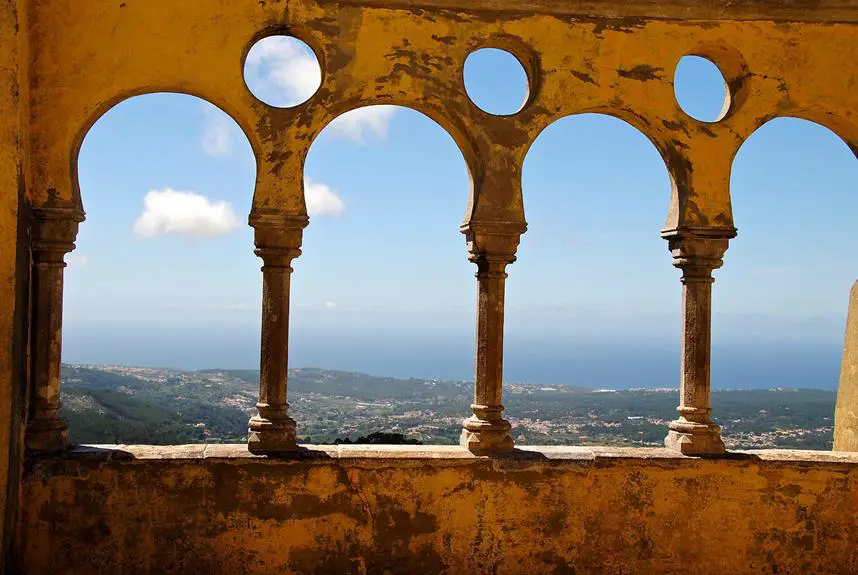
Looking for a journey through history that will leave you in awe? The Philippines boasts an array of historical sites that are a must-visit for any traveler.
From the ancient fortresses of Fort Santiago and Fort San Pedro to the stunning rice terraces of Batad and Banaue, these sites offer a captivating glimpse into the country's rich and diverse past.
But that's just the beginning – each site has its own unique story to tell, making it an experience you won't want to miss.
Key Takeaways
- Intramuros, Manila, Basilica Minore del Santo, Corregidor Island, and Paoay Church are must-visit historical sites in the Philippines.
- These sites showcase the rich religious roots, valor, sacrifice, and architectural marvels of the country.
- The Banaue Rice Terraces represent ancient agricultural practices and cultural identity, while Magellan's Cross and the Ancestral Houses in Vigan highlight the arrival of Christianity and the fusion of Asian and European influences.
- These historical sites offer immersive experiences, breathtaking views, and a deep connection to the country's colonial legacy and cultural heritage.
Intramuros, Manila
When you step into the historic walls of Intramuros, Manila, you're transported back in time to the epicenter of Spanish influence in the Philippines . The Walled City of Intramuros served as the political, educational, and religious hub during the Spanish colonial period.
As you explore, you'll encounter the magnificent San Agustin Church, a UNESCO World Heritage site, and the nearby Fort Santiago, a citadel that has witnessed pivotal moments in history. Intramuros also houses the Basilica Minore del Santo, a testament to the city's deep religious roots.
Don't miss the opportunity to visit sites associated with national hero Jose Rizal, such as Rizal Park and Shrine, and learn about his life and exile in Dapitan.
The charming cobblestone streets and the historic San Pedro are perfect for an immersive experience in this living museum of Philippine history.
Corregidor Island, Cavite
Located in the province of Cavite, Corregidor Island stands as a solemn testament to the valor and sacrifice of those who defended the Philippines during World War II. This historical site holds remnants of military structures, such as tunnels and gun emplacements, offering a poignant glimpse into its wartime significance.
It serves as a powerful reminder of the bravery and sacrifices made by Filipino and American soldiers against Japanese forces. The island's strategic location at the entrance of Manila Bay played a pivotal role in the defense of the Philippines.
Exploring Corregidor Island provides a unique and immersive experience, allowing you to engage with the rich history and wartime narratives of the site. For anyone interested in World War II history, Corregidor Island is a must-visit destination to truly grasp the magnitude of its historical importance.
Paoay Church, Ilocos Norte
When you visit Paoay Church in Ilocos Norte, you'll be greeted by an architectural marvel that seamlessly blends Baroque and Oriental influences.
The massive buttresses and intricate details of the church's facade stand as a testament to the ingenuity and craftsmanship of its builders.
As you explore this UNESCO World Heritage Site, you'll discover the historical significance and cultural importance that make Paoay Church a must-visit destination in the Philippines.
Architecture of Paoay Church
With its UNESCO World Heritage status and unique Earthquake Baroque architectural style, Paoay Church in Ilocos Norte stands as a testament to the ingenuity and resilience of the Filipino people.
The Spanish-era architecture of Paoay Church is a striking example of the fusion of European and Filipino design elements, featuring massive buttresses and intricate details that have withstood the test of time.
The church's design not only showcases the exceptional craftsmanship of its builders but also serves as a symbol of faith and heritage for the local community.
As you wander through the grand entrance and lush gardens, you'll be immersed in the solemn and visually captivating atmosphere that epitomizes the historical significance of this UNESCO World Heritage Site.
Paoay Church is a must-visit for anyone seeking to connect with the rich cultural legacy of the Filipino people.
Historical Significance
The awe-inspiring architecture of Paoay Church in Ilocos Norte stands as a testament to the ingenuity and resilience of the Filipino people, embodying the rich historical significance that continues to captivate visitors from around the world.
As you step into this UNESCO World Heritage Site, you'll be swept away by the profound historical significance it holds, including its ties to the Spanish explorer Miguel Lopez de Legazpi and the Filipino people's enduring faith.
The church's presence during the Philippine Revolution and its designation as a Rizal Memorial Protected Landscape further emphasize its historical importance.
Exploring the well-maintained grounds and gardens, you'll feel a deep connection to the site's cultural and historical impact, evoking a sense of belonging and reverence for its historical significance.
Banaue Rice Terraces
Nestled in the mountainous region of Ifugao, the Banaue Rice Terraces stand as a testament to the ancient agricultural practices of the indigenous people. Built over 2,000 years ago, these terraces are a living legacy of the Ifugao people's ingenuity and cultural heritage.
While not listed in the UNESCO World Heritage List, the terraces offer breathtaking panoramic views and a unique insight into the traditional techniques used in their construction. Visiting the terraces allows you to immerse yourself in the rich history of the Philippines and appreciate the craftsmanship of the Ifugao people.
The terraces, declared a National Cultural Treasure, embody the resilience and cultural identity of the Ifugao community. As you explore this site, you'll find yourself captivated by the stories and traditions woven into the fabric of the Banaue Rice Terraces.
Magellan's Cross, Cebu
Carrying the legacy of ancient cultural heritage from the Banaue Rice Terraces, your next historical journey in the Philippines invites you to explore the significance of Magellan's Cross in Cebu City. At this national heritage site, you'll encounter a tangible link to the Spanish colonization of the Philippines.
Here's what to expect:
- Stand before the cross planted by Magellan in 1521, symbolizing the arrival of Christianity in the Philippines.
- Explore the small chapel near Basilica Minore del Santo Niño, immersing yourself in the historical and cultural significance of the cross.
- Witness the painted ceiling depicting the historic event associated with Magellan's Cross, offering a visual representation of its enduring impact.
- Reflect on the cross's UNESCO World Heritage Site status, acknowledging its global historical significance.
Barasoain Church, Bulacan
Barasoain Church in Bulacan stands as a captivating testament to the rich history and resilience of the Filipino people, bearing witness to pivotal moments that shaped the nation's destiny. This Roman Catholic Church holds a significant place in the country's national history, as it was the site of the Malolos Congress, where the first national constitution, the Malolos Constitution, was drafted. Filipino revolutionaries gathered here, strategizing and fighting for independence. Notably, the church served as the headquarters of the illustrados who opposed Spanish rule. The architectural blend of adobe and concrete materials adds to its historical significance. Visiting Barasoain Church provides a unique opportunity to immerse yourself in the history of the Filipino revolution and walk the same halls where General Douglas MacArthur once stood.
Vigan, Ilocos Sur
Stepping into Vigan, Ilocos Sur, you're transported from the pivotal moments of Barasoain Church in Bulacan to a UNESCO World Heritage Site that offers a captivating glimpse into Spanish colonial history and architecture.
As you stroll along Calle Crisologo, the well-preserved cobblestone street, you'll be enveloped by the nostalgic ambiance of ancestral houses, each telling a story of the town's rich cultural heritage.
The fusion of Asian and European influences in Vigan creates a unique and essential destination for history enthusiasts, allowing you to appreciate the intricate Spanish colonial architecture.
The town's historical significance offers an immersive experience, enabling you to step back in time and witness the colonial legacy firsthand.
Vigan's Provincial Capitol, coupled with the Jose Rizal Memorial Protected Landscape and the Blood Compact Shrine, further enhances the allure of this UNESCO World Heritage Site.
Frequently Asked Questions
Where is the number one tourist in the philippines.
The number one tourist site in the Philippines is the Whale Shark & Tumalog Falls & Sumilon Sandbar & Pescador Island, recommended by 94% of travelers for its stunning natural beauty and diverse marine life.
What Is the Famous Tourist Destination in the Philippines?
You should explore the Philippines' rich cultural heritage and architectural marvels. Don't miss learning about indigenous tribes, colonial history, religious influence, war memorials, ancient ruins, and the Spanish, Japanese, and American influences.
What Is the Most Famous Historical Site?
Intramuros, Manila, holds Fort Santiago, a significant historical site in the Philippines. The Banaue Rice Terraces, Corregidor Island, and Cebu's Magellan's Cross are also must-visit sites, each offering unique insights into the country's rich history.
What Is the Most Famous Landmark in the Philippines?
The most famous landmark in the Philippines is Intramuros, Manila. It's a historic walled area that holds significant sites like Fort Santiago and San Agustin Church. The rich history and architecture make it a must-visit destination.
You've just scratched the surface of the Philippines' rich history and culture. From the ancient rice terraces of Banaue to the historic churches of Vigan, there's so much more to explore.
Soak in the stories of the past, marvel at architectural wonders, and pay tribute to heroes at the American Cemetery and Memorial. The Philippines' historical sites offer a journey through time that you won't want to miss.
Start planning your trip now and immerse yourself in the country's fascinating history.

- TREND REPORTS
- CONDO LIVING
- MILLENNIAL MATTERS
- EXPAT CORNER
- CELEBRITY REAL ESTATE
- ARCHITECTURE & DESIGN
- SUSTAINABILITY
- ZIP CODE GUIDE
- P2P Terminals and Schedules
- Train Systems in the Philippines
- How to Get Your Pag-IBIG Number Online
- Sample Forms and Contracts for All Real Estate Transactions
- Valid IDs in the Philippines: Passport, Driver’s License, and Other Essential IDs
- Glossary of Real Estate Terms
- ANNOUNCEMENTS
20+ Historical Landmarks in the Philippines to Add to Your Travel Bucket List
Table of Contents
Last Updated on July 7, 2022 by Lamudi
Historical sites remind us of how our country evolved and its people thrived. Events that took place in these sites helped build the Philippines as we know it today, making us realize that the past can shape our future.
Exploring historical places allows us to remember and learn from the past’s mistakes and triumphs. And on a lighter note, it’s just downright fascinating, especially for history buffs.
More importantly, visiting heritage sites help us see our country as a giant classroom. You can learn through adventures by visiting these locations steeped in history:
UNESCO World Heritage Sites in the Philippines
United Nations Educational, Scientific, and Cultural Organization (UNESCO) have declared more than a thousand world heritage sites, all of which offer value to humanity due to their cultural, historical, and scientific significance.
Machu Pichu, Taj Mahal, and Stonehenge are among the most famous heritage sites around the globe. Properties near such historic locations are likewise widely visited.
In the Philippines, here are the heritage sites recognized by UNESCO:
Baroque Churches of the Philippines
The Baroque churches of the Philippines were constructed between the 16th and 18th centuries, showcasing the fusion of locally sourced materials and European church design.
There are four baroque churches that made it to the list of UNESCO’s world heritage sites:
- San Agustin Church in Manila
- San Agustin Church in Paoay, Ilocos Norte
- Nuestra Señora de la Asuncion in locos Sur (also known as Santa Maria Church)
- Santo Tomas de Villanueva Church in Iloilo (also known as Miagao Church)
San Agustin Church in Manila is one of the longest-standing churches in the country and was able to survive the clash between Filpino and American troops in May 1945.

Meanwhile, the other San Agustin Church in Ilocos Norte is known for its baroque architecture infused with gothic and oriental elements. The three-storey bell tower of the church also served as an observation post during the Spanish colonial period and the Japanese invasion.
Santa Maria Church in Ilocos Sur is one of the most beautiful old churches in the Philippines . It has a fortress-like appearance and protective walls that can shield it from seismic activities. The Miagao Church likewise has thick walls, but it was reportedly used as secret passages and protection from invaders.
The Philippines is home to many extravagant churches, representing Filipinos’ fervent Catholic faith and culture. Here’s a short list of other must-see worship places in the country .
The entire city of Vigan has preserved Spanish colonial architecture, evident in its grid street pattern, plazas, and grand old houses. UNESCO called the city “the best-preserved example of a planned Spanish colonial town in Asia.”
Calle Crisologo, in particular, is a sight to behold at night. It takes you back in time, surrounded by centuries-old heritage homes, antique souvenir shops, charming little restaurants, and the car-free cobblestone street.
Tubbataha Reef
This protected area in the middle of the Sulu Sea is a shelter for over 1,200 marine species, including corals, sharks, sea turtles, and marine mammals. Although not ordinarily considered a historical spot, Tubbataha Reef carries a long history as one of the oldest ecosystems in the country.
It was only discovered in the 1970s, but many believe that its atolls (ring-shaped coral reefs) were formed over a thousand years ago after the underwater volcanoes of Cagayan Ridge went extinct.


Rice Terraces of the Philippine Cordilleras
A landscape of unparalleled beauty, the rice terraces of the Ifugao ethnic group were built 2,000 years ago and have been passed on from one generation to another. The high rice fields represent the endurance of ancient civilization amid a modernized society. It also celebrates the agricultural history of the Philippines, from rice cultivation to rice consumption.
Two of the UNESCO-inscribed terrace clusters of Ifugao are located in Banaue—the Bangaan and Batad terrace clusters.
The Capital City of Manila
Manila became the capital of the colonial Philippines six years after Miguel López de Legazpi arrived in the country. Back then, the city acted as the center of Spanish military, religious, and commercial activities, which led to some of the most historic moments in the Philippines. Many of them have been immortalized in the following historical sites of Manila:
During 1800s, Rizal Park was a popular place among Manila’s elite. It was a spot for events, parades, celebrations, and ruefully, executions, too. Spaniards used it as an execution ground for rebels and the national hero, Dr Jose Rizal .
The park’s most famous landmark is the Rizal Monument, facing Manila Bay and surrounded by ornamental gardens, paved walkways, and open lawns.
Located roughly 10 minutes away from Rizal Park is Intramuros. Also known as the Walled City of Manila, the historic district was the seat of the Spanish government when they colonized the Philippines. Intramuros is also home to Fort Santiago, a defense fortress during the Spanish colonization era, and two historic churches: Manila Cathedral and San Agustin Church.

National Museum
The National Museum complex showcases natural history, fine arts, and archaeology collections, representing the unique heritage of the Filipino people. Each artwork, installation, and artifact tells a story of how we evolved from the prehistoric period to modern times.
Some must-see items are the Butuan boat, which symbolizes early Filipino craftsmanship and the Manunggul Jar made before Christ was born.
Bahay-Nakpil Bautista
The Nakpil-Bautista House was built in 1914 and is one of the oldest houses found in the district of Quiapo, Manila. Key figures of Philippine History lived in this house, including Dr Ariston Bautista who invented a medicine to combat cholera and Gregoria de Jesus, the widow of Andres Bonifacio.
Today, Bahay-Nakpil Bautista holds items related to Katipunan, memorabilia of the Nakpil family, and an activity and reading area for kids.
If you’re looking for more heritage houses to explore, here’s a list of homes with unique architecture and glorious past .
Besides the century-old buildings, new developments also celebrate the historical significance of Manila . The city is now home to sky-high condominiums, enabling it to regain its place as one of the luxuriant areas in the country.
The Manila Hotel
Speaking of luxury, you can get more of it at The Manila Hotel. It’s a premier building that was constructed in 1909 and officially opened in 1912. The hotel was not just built to provide accommodations and display Filipino hospitality. Its strategic location also lets you enjoy the magnificence of Manila Bay’s sunset, Intramuros, and Rizal Park.
Bonifacio Shrine
Located near Manila City Hall, Bonifacio Shrine is a public park and plaza with the monument of Andres Bonifacio wielding a bolo as its masterpiece. The shrine also depicts the life of Bonifacio from his childhood to his tragic death. A simplified version of the “Kartilya ng Katipunan,” or the guidebook for new members of Katipunan, can also be found on the memorial shrine.

Founded in 1594, Binondo is the oldest Chinatown in the world. Its history is tied to the rise of the Chinese-Filipino population, culture, commerce, and trade in the Philippines. Today, Binondo continues to serve as a commercial hub and home to businesses of all sizes. The area is also the location of various real estate developments owned by property giants like Megaworld Corporation and Anchor Land.
Of course, history is rich not just in the capital city. Other historical places to visit within Metro Manila include:
- Quiapo Church, Manila
- Coconut Palace, Manila
- Libingan ng mga Bayani, Taguig
- Ayala Museum, Makati
- Museo Valenzuela, Valenzuela
- EDSA People Power Monument, Quezon City
- Bantayog ng mga Bayani, Quezon City
- Pasig City Museum, Pasig
World War II Historical Places in the Philippines
World War II is arguably the biggest war in history, and the Philippines was one of the countries that suffered a great loss of life. When Japan attacked the Philippines in 1941, it was also the prelude to the horrors of Japanese occupation.
Around the Philippines, you can find the following sites that carry important reminders of the war. Visting them will remind you of harrowing memories and also the hope that even the darkest nights will end.
Shrine of Valor
The Shrine of Valor or “Dambana ng Kagitingan” sits atop Mt. Samat in Pilar, Bataan and is dedicated to the Filipino troops who fought against the Japanese Imperial Army.
Within the 15-hectare shrine complex, you’ll find a white Memorial Cross, which is a remembrance of the heroism of World War II soldiers. There’s also a war museum that contains armaments used against the Japanese forces.
(Zero Kilometer) Death March Marker
Another landmark that saw the events of World War II is the Zero Kilometer Death March Marker in Bataan. There are two zero km. markers in the province—one in Bagac and one in Mariveles.
The death march is one of the gruesome parts of Philippine history, a time when surrendered Filipino and American troops were forced to march 85 miles in six days, with only one meal during the entire journey.

Corregidor Island
The historic island of Corregidor, located south of Bataan province, is another place chock full of Word War II stories. Corregidor is one of the largest islands guarding the entrance to Manila Bay and one of the combat zones between Filipino and US forces and the Japanese Army.
Inside the island, here are some of the historic sites you can explore:
- Malinta Tunnel
- Filipino Heroes Memorial
- Japanese Garden of Peace
- Pacific War Memorial
- Corregidor Lighthouse
- Battery Hearn
- Mile-long Barracks
The Leyte Landing Memorial
Located in Palo, Leyte, this war memorial commemorates the landing of American forces who helped drive the Japanese Army away. In December 1941, US troops were forced to retreat from the Philippines, allowing the Japanese to take control. General MacArthur promised to return, making his famous speech “ I shall return .”
In 1944, he fulfilled his promise as he was seen wading through the Red Beach of Palo with other high-ranking soldiers, including Sergio Osmeña, who later became a Philippine president.
In 1945, Japanese troops formally surrendered as guerilla forces stood up everywhere to fight for freedom. The Philippines then faced another challenge, which was to rehabilitate its postwar economy to pre-war levels.
With the collective hard work of the Filipino people, the tide turned and the historical performance and economic outlook of the Philippines started showing a positive trend.
Archaeological and Spanish Era Historical Sites in the Philippines
Archaeological sites also carry historical and cultural stories that span hundreds, if not thousands of years. In the same way, Spanish era-related structures in the Philippines have recorded long-lived stories since we have been a colony of Spain for more than three centuries.
The following sites connect us to the past and the ways our modern traditions and behaviors have been shaped:
Tabon Caves
In the municipality of Quezon in Palawan , there are over 200 caves collectively known as the Tabon Caves. The site is a museum of natural art where you can find rounded limestone domes and pieces proving the presence of humans before the Neolithic Age.
Less than 30 caves have been fully explored by archaeology experts, and only 7 are open to the public. This makes the Tabon Caves one of the most mysterious sites that promise extraordinary adventure.

Callao Cave
Callao Cave is a place to explore and pray, located within the Peñablanca Protected Landscape and Seascape. The park has over 300 cave systems, with Callao Cave being one of the most famous landmarks and tourist spots.
A trip here would be calm or callado (as the Spaniards have named it) because of the pathways and stairways through the cave’s chambers. There’s also a Roman Catholic chapel inside the cave, called The Chapel, where weddings are sometimes held.
Sunken Cemetery
A picturesque site for the dead, the Sunken Cemetery in Catarman, Camiguin is usually visited by tourists instead of relatives. The cemetery stands on a portion of the province wherein the first Camiguin locals lived and were buried alive due to the Mt. Vulcan eruption.
The giant cross in the middle of the sea is a reminder that there were ancestors and a culture that sunk due to a natural hazard. Besides sightseeing and reflecting, you can dive under the cemetery and explore the old gravestones that turned into marine life habitats.
Cagsawa Ruins
Cagsawa Ruins is part of Cagsawa Park, a widely visited attraction in Daraga, Albay. The ruins are fragments of what was once a Franciscan church. In 1814, the most violent eruption of the Mayon Volcano occurred, and only the belfry and some parts of the convent survived.
Around Cagsawa Park, you can also look at the collection of photographs of Mount Mayon eruptions or visit geological and archaeological exhibits.

Magellan’s Cross
Ferdinand Magellan planted a cross in Cebu to celebrate the Roman Catholic faith propagation in the Philippines. The replica of the cross is located inside a small chapel along Magallanes Street, which was also named after the famed explorer.
On April 14, 1521, it was believed that Magellan’s priests baptized up to eight hundred Cebuanos, including the King and Queen of Cebu.
Fort Pilar
Finally, on the farthest island region from Metro Manila, you’ll find Fort Pilar in Zamboanga. It’s a major historical landmark in the area, which served as a defense fortress against the attacks of the British, Portuguese, and Moros.
Inside the fort is a National Museum branch that showcases Zamboanga as a Spanish city as well as collections of antique items, paintings, and cultural memorabilia.
Visiting all these historical sites can be enjoyed by all ages. It proves that history is not at all boring and you can learn it beyond reading textbooks.
Places, traditions, and our way of life didn’t just appear out of nowhere. Discover how they all came about by including some of these historical sites on your next trip.
Stay tuned for the latest real estate news and tips by following Lamudi on Facebook , Twitter , Instagram , Youtube , and LinkedIn .
RELATED ARTICLES
Creating lasting homes for filipino families: why invest in profriends communities in cavite and iloilo, a new sprout: garden city experiences further growth with yakal tower, unlock the best of city living through instahome deals, nuveo at cerca: opening up new opportunities in the south, unlocking limitless opportunities: the strategic advantage of renting in pitx office towers, portico at ortigas: a worthwhile condo investment in a thriving business district, leave a reply cancel reply.
Save my name, email, and website in this browser for the next time I comment.
- All time popular
RLC Residences Joins Lamudi Property Fair 2024
Creating lasting homes for filipino families: why invest in profriends communities....
© 2019 Lamudi Philippines Inc. All rights reserved. Material may not be published or reproduced in any form without prior written permission.
We at Lamudi are committed to giving you the best experience. For any questions, suggestions, comments, or issues, kindly contact us.
FACEBOOK MESSENGER: https://www.messenger.com/t/LamudiPhilippines
EMAIL : [email protected]
OFFICE : 5F & 6F, Keyland Valero Building, 114 Valero St., Salcedo Village, Bgy. Bel-Air Makati City, 1209, PH

10 Amazing Historical Sites in the Philippines – Add Them to Your Itinerary Now!
The Philippines has a rich history spanning different eras, from Spanish colonization to World War II and beyond. This complex past has left behind unique historical and cultural sites scattered across the archipelago for travelers to explore.
From the once heavily fortified Intramuros in the heart of Manila built under Spanish rule to the chilling Camp O’Donnell that held Filipino and American POWs after the infamous Bataan Death March in WWII, the Philippines offers an abundance of destinations for history buffs.
The best way to truly understand the story of the Philippines is to visit these historical places in person. In this blog, I detail my top 10 favorite historical spots in the Philippines that reveal pages of the country’s complicated but fascinating history and give travelers a glimpse into its resilient culture.
As you plan your adventure around the Philippines and encounter ancient rice terraces, colonial architecture, war memorials, and more, you’ll gain insight that history books alone cannot provide.
1. Intramuros (Manila)
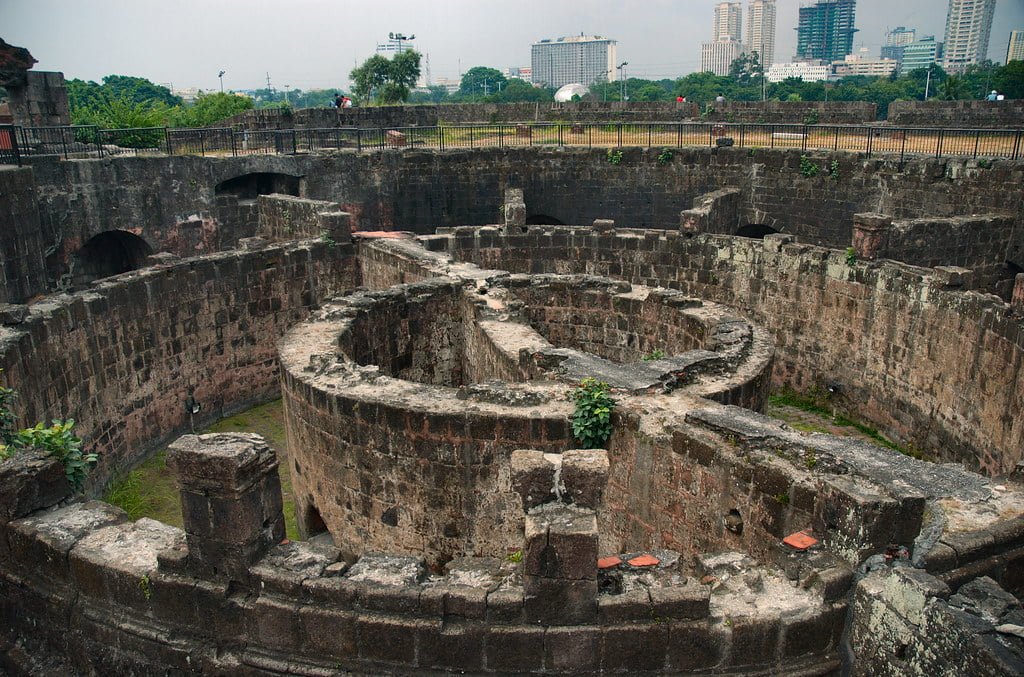
The walled city of Intramuros located along the banks of the Pasig River is one of the most iconic historical sites in Manila. Built by the Spaniards in the 16th century, this citadel features imposing stone walls, drawbridges, cobblestone streets, Spanish colonial architecture, and historic churches.
Must-see landmarks in Intramuros include the grand Manila Cathedral and Fort Santiago – a former military headquarters with dungeons and weapon displays. Walking along the walls and narrow streets transports you back centuries to the era of Spanish conquest.
2. Vigan (Ilocos Sur Province)
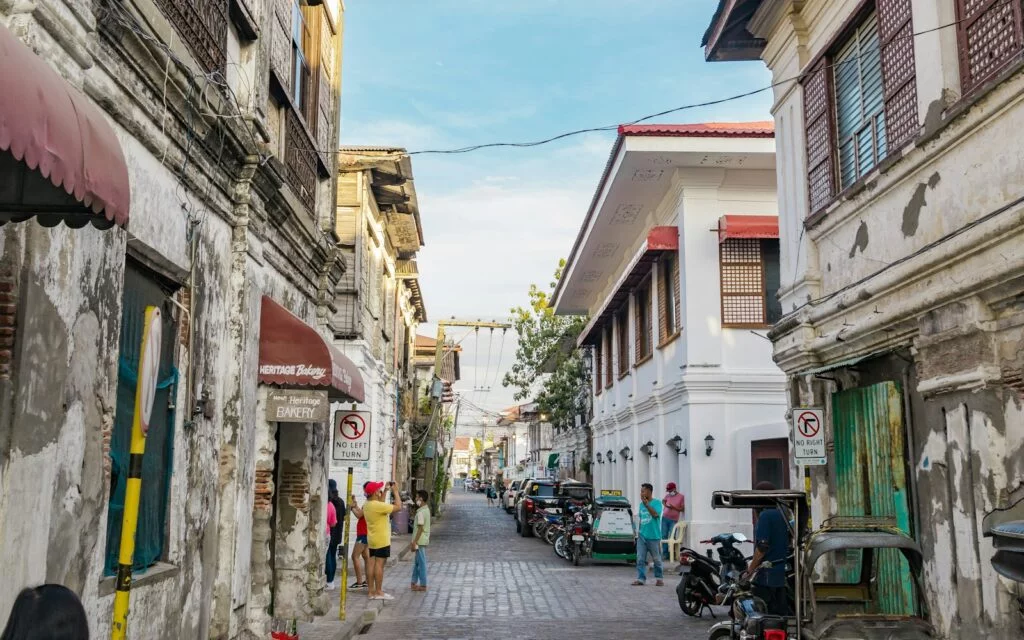
A remarkably well-preserved Spanish colonial town, Vigan transports you to centuries past with its vintage houses, empanadas stalls, horse-drawn carriages (kalesa), and cobblestone streets. Inscribed as a UNESCO World Heritage Site due to its architecture reflecting unique Hispano-Filipino culture , highlights include Calle Crisologo showcasing Spanish-style homes, grand villas, and shops with capiz windows.
Crisologo Museum in a 150-year-old mansion contains artifacts and photos of the town’s rich past.
The history of WWII heavily shapes this tadpole-shaped island located at the entrance of Manila Bay. Corregidor functioned as headquarters of the Allied Forces but eventually surrendered to the Japanese, who held captives here such as American soldiers and Filipino comfort women.
Now visitors can explore the network of abandoned tunnels with educational light shows, see ruins of barracks, memorials, and the Pacific War Museum spotlighting multiple perspectives. Witnessing where soldiers fought and lost their lives poignantly pays tribute to their sacrifices.
4. Banaue Rice Terraces
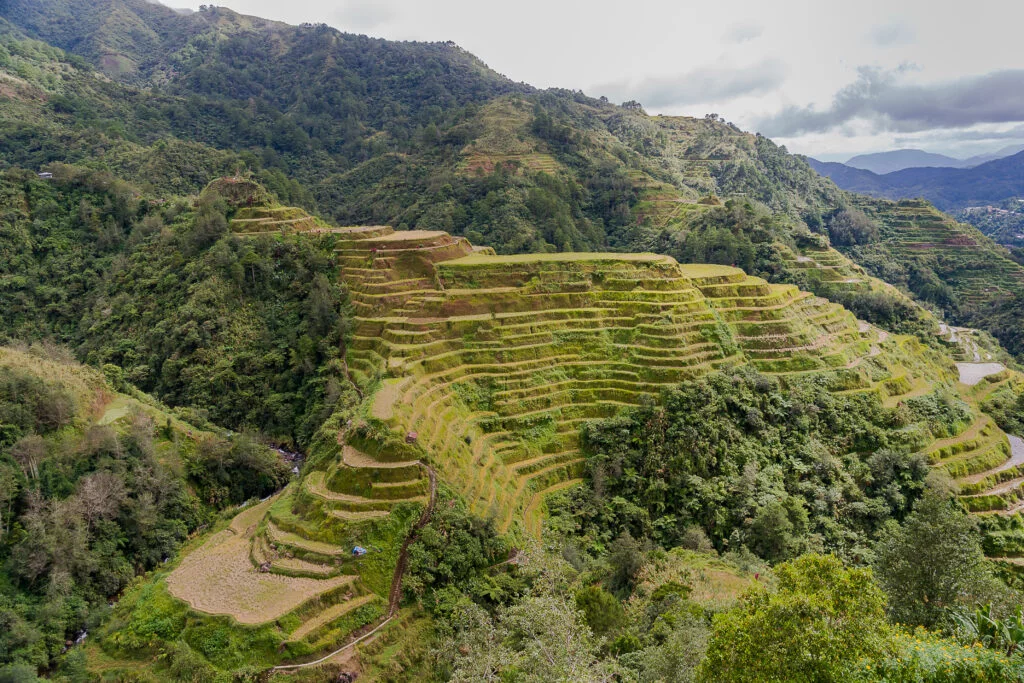
Carved high up in the Philippine Cordillera mountain range on the island of Luzon, visiting the Banaue rice terraces almost feels like stepping into an ancient lost world. These mud walls follow the mountains’ contours and are impressive vestiges from over 2,000 years ago when Ifugao tribes ingeniously built the terraces by hand to grow rice in harmony with the rugged terrain.
Marvel at the indigenous villages still thriving there and see the communal, spiritual, and cultural aspects intertwined with these terraces passed down through tribal generations.
5. The Manila American Cemetery and Memorial
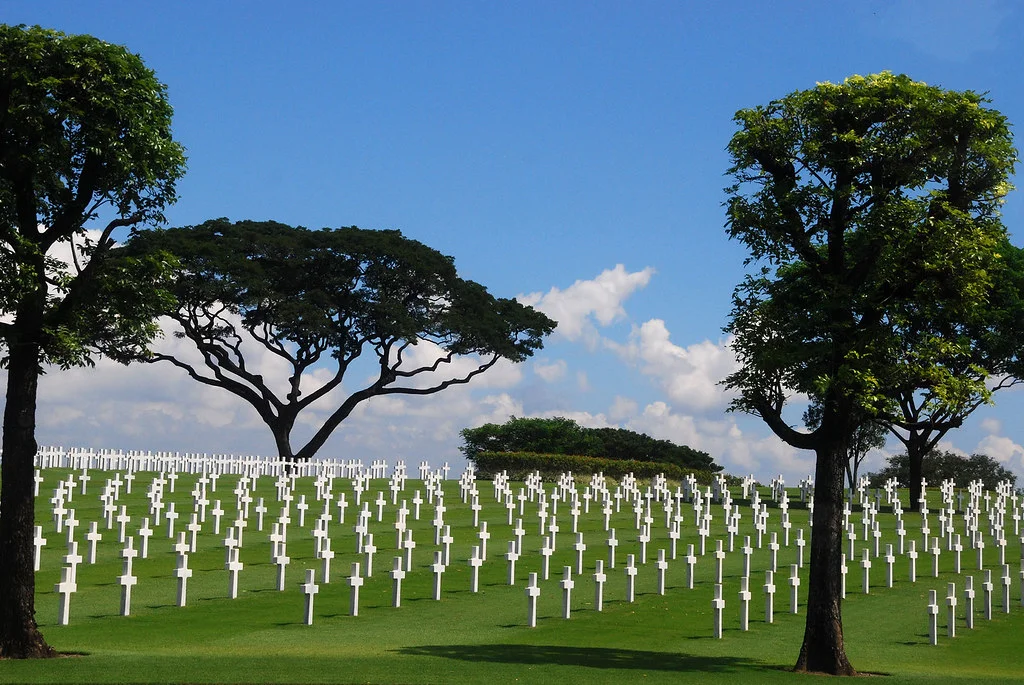
Located within metropolitan Manila, this 152-acre site is the largest WWII cemetery in the Pacific for US personnel killed during war campaigns in the region. Honoring over 17,000 American military dead with row upon row of simple white crosses and Stars of David grave markers offers an intensely sobering glimpse of loss of life.
The memorial pays further respects with a central chapel, a circular mosaic map of WWII battles in marble walls, and two giant triumphal arches titled “Battling” and “Victory.” Standing amidst the expanse of graves certainly stirs deep emotions over this history.
6. Baroque Churches
The Spanish colonial era left behind many impressive Catholic churches across the archipelago with intricate Baroque and neoclassical architecture. Prime examples are Miagao Church in Iloilo province with its ochre-hued facade and staggered pyramidal bell towers, San Agustin Church in Manila – the oldest stone church from 1589, and Batalay Church in Bohol with its crumbling yet majestic rose-colored facade and towers resembling the plains of Castille.
Exploring these churches often located in historic town plazas offers a glimpse into the strong religious legacy and European artistic influences on Filipino culture.
7. Rizal Park
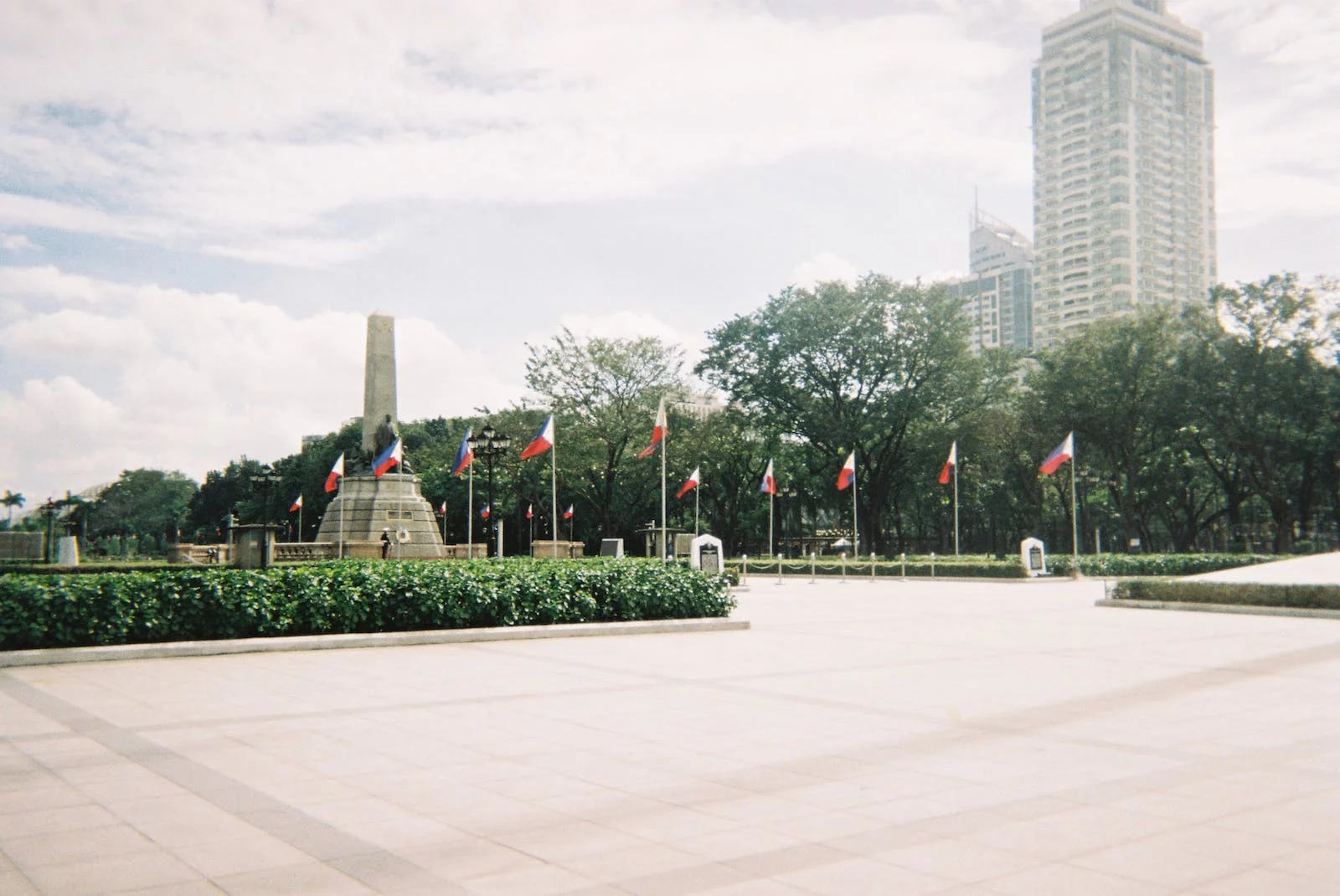
As the site where the Philippines’ national hero Jose Rizal was executed by firing squad under Spanish colonial rule, this urban seaside park holds deep meaning for Filipinos. The central monument is the Rizal Monument, with sculptures and design work by National Artist Fernando Amorsolo.
Nearby spots expand knowledge on his impact – the National Museum’s Rizal Shrine Room displays some of his clothing and personal items while the Rizal Martyrdom Monument depicts his fateful demise that helped trigger the revolution. This history-steeped park serves as a focal point for Filipino identity and patriotic pride.
8. Lingayen Gulf Landing Site
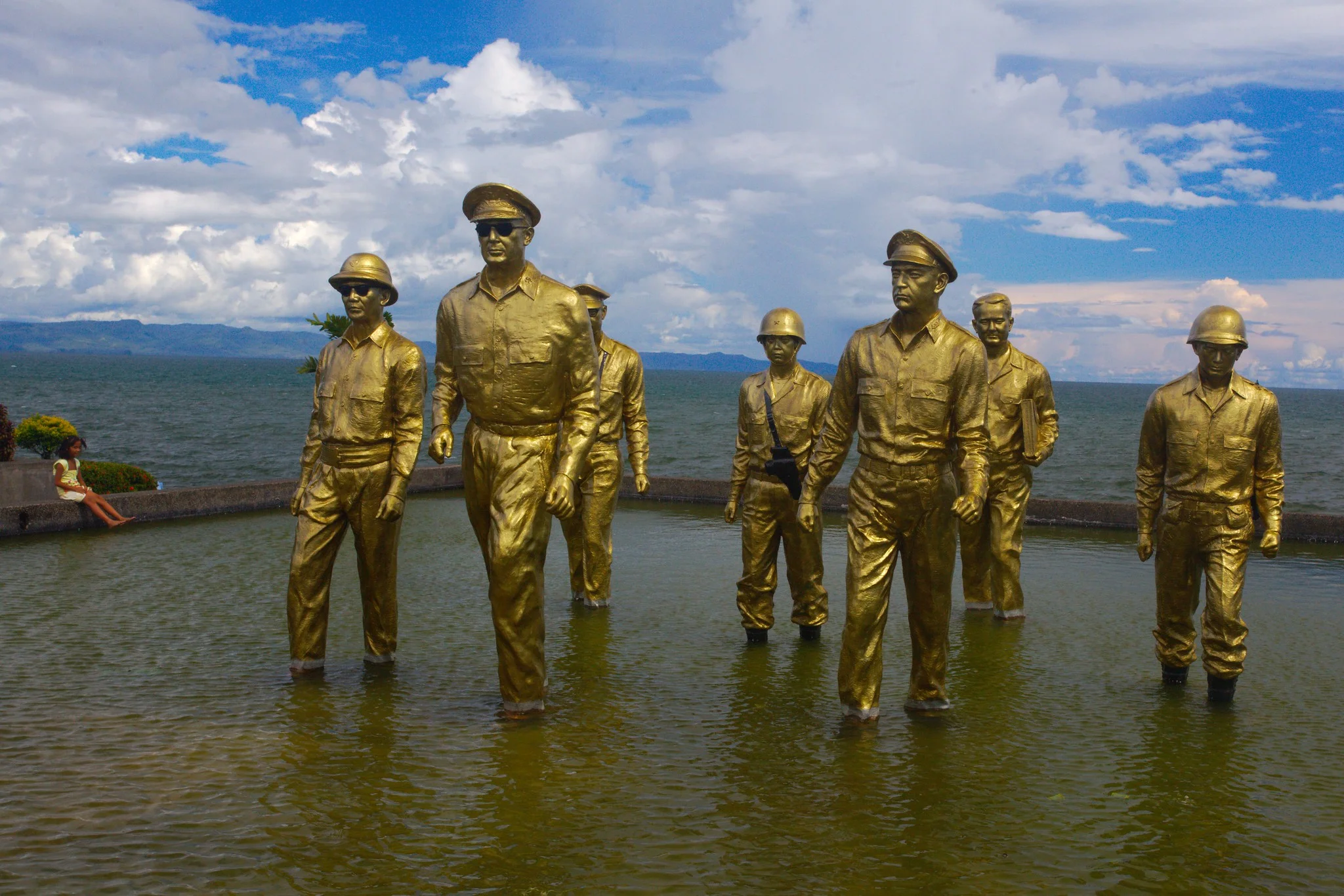
The long beach lining Lingayen Gulf in Pangasinan province forms the historic site of the Allies’ January 1945 amphibious landings to liberate Luzon Island from Japan’s control. General Douglas MacArthur waded ashore here – just as promised when forced out years earlier by the Japanese invasion – along with over 280,000 American troops and massive amounts of equipment, orchestrating one of WWII’s boldest maneuvers.
Veterans memorials capturing the struggles faced occupy the length of this coastal stretch. Seeing remnants of Japanese suicide boats and American amphibious assault vehicles further reflects on sacrifices made along these shores.
9. Historic Provincial Capitols
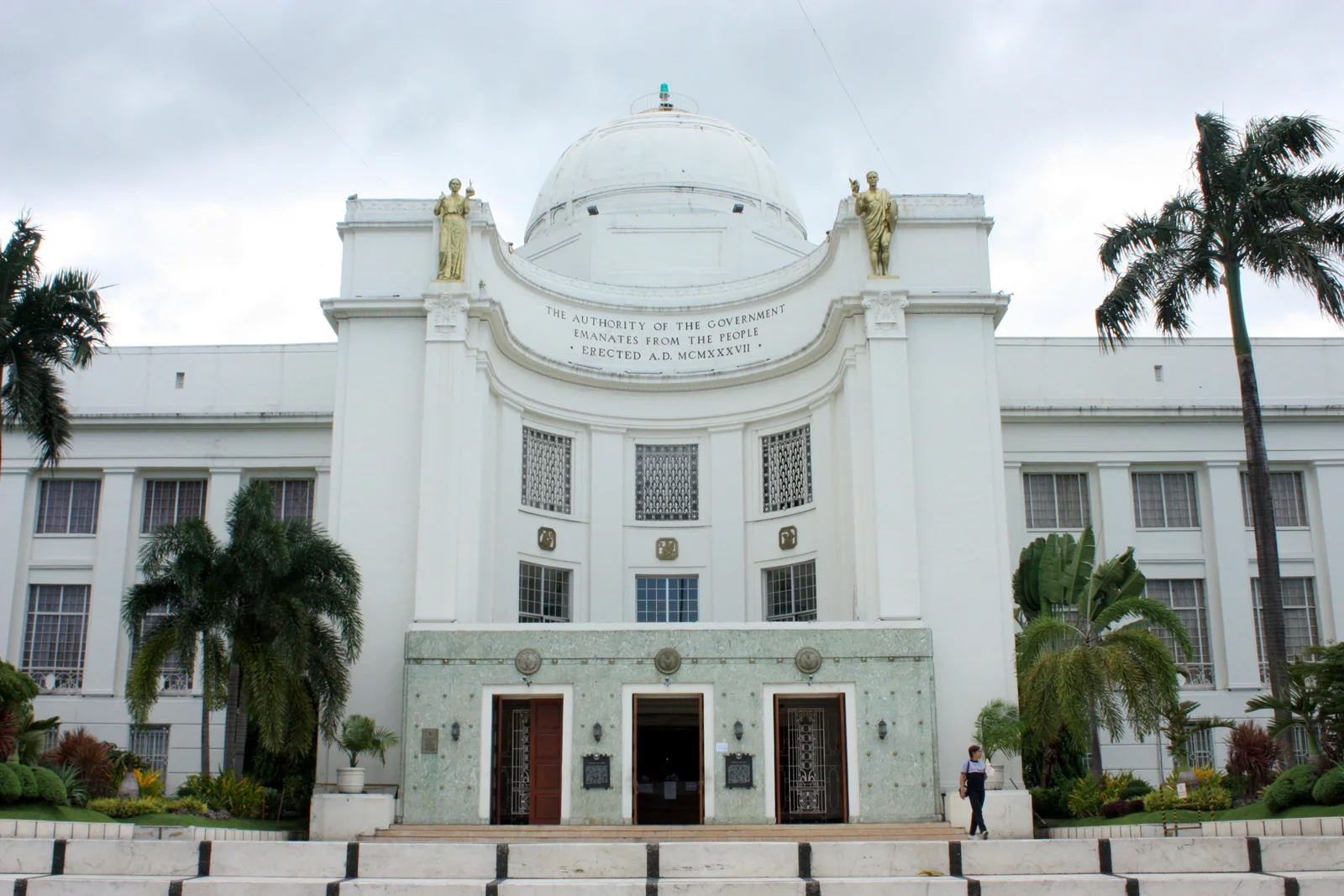
Impressive state capital buildings constructed during the American colonial period in grand neoclassical style can be seen in various cities like Bacolod, Iloilo and Cebu. Designed by American architect Daniel Burnham who sought to showcase democracy, highlights include the Capitol of Iloilo with its stately dome, Hellenic-style pillars and capacious public square.
The Capitol of Cebu has an elegant curved facade, fronted by rows of flags from around the world symbolizing international welcome. Understanding governance history while photographing these palatial capitols makes for patriotic and stirring sightseeing.
10 Camp O’Donnell
A somber site in Capas, Tarlac province was the end destination for Filipino and American soldiers forced into the 65-mile Bataan Death March by the Japanese during WWII. At this POW camp, thousands perished from disease, starvation and brutality. An obelisk monument standing amidst the remains of decrepit barracks lists fallen heroes.
Seeing personal artifacts in the museum conveys the immense suffering and resilience of those who fought but ultimately perished or survived. Paying respects at Camp O’Donnell ensures we never forget this unfathomable ordeal.
Related Posts
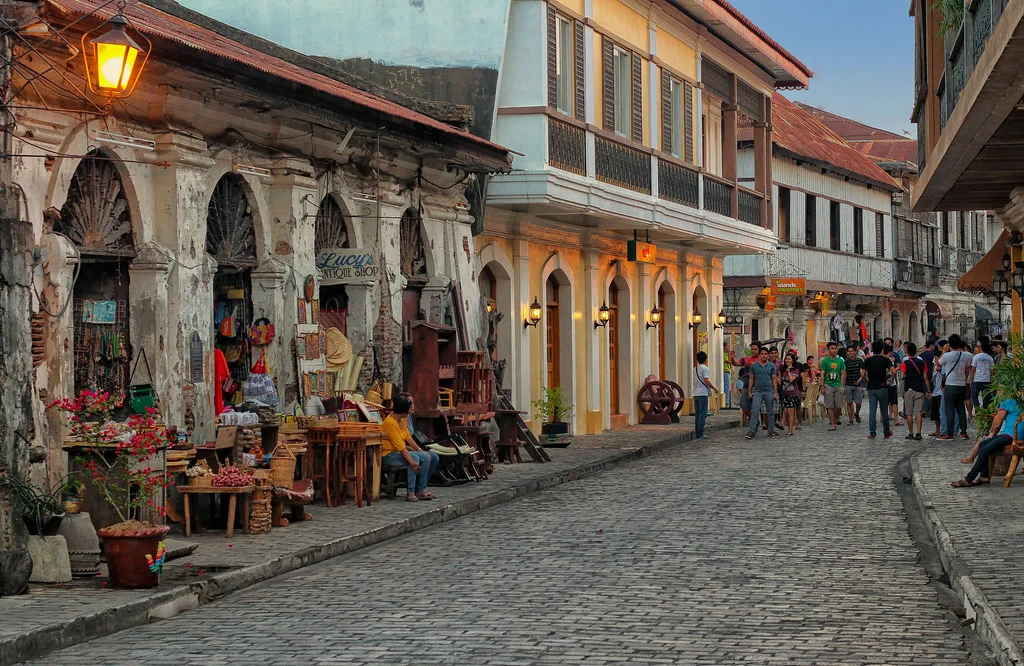
Discover the Timeless Charm of Calle Crisologo: A Journey Through Vigan’s Historic Gem

Exploring Burnham Park: A Gem in the Heart of Baguio City
2 thoughts on “10 amazing historical sites in the philippines – add them to your itinerary now”.
Pingback: Marinduque: The Heart-Shaped Island Gem of the Philippines.
Pingback: Is Cavite a Good Place to Live? A Comprehensive Analysis
Leave a Comment Cancel Reply
Your email address will not be published. Required fields are marked *
Save my name, email, and website in this browser for the next time I comment.

20+ Natural, Cultural, and Historical Philippine Landmarks To Visit While You’re In the Country

Written by Bianca Versoza
The Philippines is home to one of the most diverse and interesting cultures on the planet, and it’s beautiful natural formations, scattered along its more than 7,000 islands. A trip to the Philippines wouldn’t be complete without visiting important places that will let you experience the unique and exciting way of life of the Filipino people.
The Philippines is jam-packed with many destinations that will interest both local and international travelers alike. These spots are unique and will let you know just how we FIlipinos value our heritage and natural resources.
We invite you to visit some of the most popular and important landmarks here in the Philippines , found below. You have to visit each and every one of them to experience something that’s truly unique to Filipino culture.

Famous Natural Landmarks in the Philippines
The Philippines is blessed with thousands of breathtaking natural formations you will not find elsewhere. These destinations will awaken the adventurer in you, as they did mine:
Mayon Volcano, Albay
Mayon Volcano, situated in Albay, Bicol province, is a stunning geological wonder with a majestic height of 2,462 meters and a perfectly symmetrical cone shape. Despite being an active stratovolcano that occasionally releases volcanic glass, it remains a popular tourist destination among locals and foreigners alike.
In 1938, Mount Mayon and its neighboring areas were designated as a natural park. This protective status shielded the surrounding regions from commercial development, ensuring the preservation of its natural beauty to this day. If you’re like me, you’ll take out any camera you have with you and take photos of the volcano as it stands proud against the blue sky during the day, or even the stars at night.
Mt. Mayon is one of the most sought-after tourist destinations in the Philippines. Visitors have a lot of things to do here. You can go on a trek up the volcano, have a picnic while looking at the mountain’s perfect cone shape, or simply take photos of the volcano’s breathtaking beauty set against a clear blue sky.
If you want more than just a photo of this active volcano, go and rent an ATV and ride towards the base of Mt. Mayon. Along the way, you will see evidence of the lahar that flowed through when the volcano erupted some time ago. You will also see the growth of flora along the area, as if to say that no matter how destructive some things in life can be, you can still hope for better things in the future.
Taal Volcano, Taal Lake
Taal Volcano, located in Batangas province, is a caldera filled with water from surrounding Taal Lake. It is an active volcano, the second most active in the Philippines—and records show that it has had continuous seismic and volcanic activity even in recent years. Despite this, Taal Volcano remains a must-see tourist destination because of its magnificent beauty as a volcano surrounded by a lake of sulfuric water
While Taal Volcano is situated in Batangas, some of the most breathtaking views of its caldera can be—and should be—enjoyed from afar in Tagaytay. Tourists often flock to places such as:
- A leisure park called the Sky Ranch
- A hilltop family picnic area called the Picnic Grove
- An Ilonggo restaurant called Balay Dako
- A picturesque lake-view hotel named Escala Tagaytay
- A Filipino specialty restaurant named RSM Lutong Bahay
Visitors go to these places to get a magnificent view of the volcano from a safe distance. Personally, I love going to the Sky Ranch with my family and looking at Taal from there. When you look at Taal from here, you will see a seemingly small volcano surrounded by a lake, which is also surrounded by land. Words cannot completely describe its beauty–you have to see it yourself.
Chocolate Hills, Bohol
The world-renowned Chocolate Hills of Bohol in the Visayas is a natural wonder worth exploring. These geological marvels consist of hills, estimated to range from 1,268 to 1,776 in number, spread across a 50-square-kilometer area (about 20 square miles). The hills are not uniform in size and height, with many standing between 30 to 50 meters high. The tallest among them even reaches approximately 120 meters in height!
Although visitors are not allowed to climb the hills personally, local government authorities allow guests to look at them from a distance on viewing decks. That’s enough for me, really, since I think I’d get too tired to climb all of them anyway. I’d rather take panoramic shots of the hills using my smartphone–there’s too many to include in just one snap of the camera!
Despite the name, the hills themselves aren’t chocolate-colored at all times. First, vegetation covers the bases of the hills, making them look green from a distance. Next, the hills themselves are covered with grass which grows vibrant and green during the rainy season. The grass will dry up and turn brown during the dry season, however, making them look more like mounds of chocolate.
People remain baffled as to how the Chocolate Hills were formed. Local myths attribute their creation to giants throwing mud at each other or the tears of a lovelorn giant. Geologists, however, believe they were shaped by weather changes over time. Despite their uncertain origin, the Chocolate Hills remain a natural sight to behold.
Boracay Island, Aklan
Next is the world-renowned destination known as Boracay Island, or simply Bora. Tourists from all over now—or at least would have heard—of the pristine white sand beaches and crystal-clear blue waters of this stunning island in the Aklan province. It’s a top choice for travelers seeking a peaceful escape from their daily routines, and it’s a destination my family and I personally love and return to whenever possible.
Boracay offers a variety of beaches and accommodations to suit every type of tourist. There are luxurious resorts near the beach in an area known as Station 1, a bustling hub with more budget-friendly options, shopping centers, and dining spots at Station 2; and secluded lodgings at Station 3. All these Stations are conveniently close to the beach, allowing visitors to choose their ideal stay within walking distance of the shore.
This popular island has received numerous awards, including recognition as one of the top 10 islands to visit in Asia by Conde Nast. Aside from its white sands, the place offers a number of activities for you to do, such as swimming, island-hopping, diving, and snorkeling. Whether you’re traveling with family, friends, or by yourself, Boracay remains a favorite landmark for all types of travelers.
Puerto Princesa Subterranean River, Palawan
The Puerto Princesa Subterranean River, located in Palawan, is a UNESCO World Heritage Site. Known for its limestone cliffs, cave formations, unique wildlife, and refreshing waters, this Philippine landmark stretches for 8.2 kilometers. However, tourists are only allowed to explore about four kilometers.
While the underground river is home to a variety of flora and fauna, you’ll probably encounter swallows and native bats during your visit as well. I recommend you drop by between November and May, when the waves are calmer and the weather is more favorable for travel.
UNESCO recognizes the Puerto Princesa Subterranean River as the largest and most valuable limestone forest in Asia. It is also considered as one of the “New Seven Wonders of Nature,” alongside many other places around the world. The underground river stands as evidence of the Filipino commitment to safeguard and preserve their natural heritage. It is also one of the most visited spots in this area of the country, known as the “Best Island” of the Philippines.
Tubbataha Reefs Natural Park
Tubbataha Reefs Natural Park, situated near Palawan and the Visayas region, is one of the best diving spots in the Philippines. This protected marine area covers an impressive 97,030 hectares, making it the largest of its kind in the country. Within its boundaries is a diverse collection of underwater life.
Found right at the heart of the Coral Triangle, Tubbataha Reefs Natural Park is a haven for a wide array of reef-building corals. It comprises the North and South Atolls, along with the Jessie Beazley Reef. It not only shelters numerous fish species, including sharks and whales, but also serves as a vital nesting ground for sea turtles. You can dive into the water to see them personally, but if you’re like me you can make do with snorkeling or taking photos from above the water. You can also watch the seabirds nesting in the area and take photos as they fly up and dive to catch their meal.
The protected marine area is located 10 hours away from Puerto Princesa. Despite that, divers flock to Tubbataha all-year round. In fact, this place is so popular that tourists have to book their liveaboard trips years in advance just to secure their spot.

Famous Cultural Landmarks in the Philippines
Aside from being blessed with natural formations, the Philippines is also peppered with tourist spots that played a large part in our history. These will help you understand our values and what matters to us as a nation.
Banaue Rice Terraces
Located in Ifugao Province in northern Luzon, the Banaue Rice Terraces is a massive agricultural invention that covers approximately 10,360 square kilometers (about 4,000 square miles) of mountainous land. Although this isn’t a natural landmark given its origins in human ingenuity, this captivating site still holds the distinction of being a UNESCO World Heritage Site.
The Banaue Rice Terraces were carved by the Ifugao tribe over 2,000 years ago. The Ifugaos are ethnic wet-rice farmers who were believed to have come from Malay origins and have settled in the area. They created the rice terraces as an effective means to produce rice, which is a staple across the Philippines.
The Banaue Rice Terraces is made up of six main terrace clusters. Within each cluster, you’ll find terraces that resemble a gigantic staircase stretching toward the heavens. Each step is an integral part of a massive irrigation system used to supply water to the rice being cultivated in terraces—this is why the entire landscape looks very green, especially when seen from afar.
Aguinaldo Shrine and Museum, Cavite
The Aguinaldo Shrine and Museum, situated in Kawit, Cavite, is at this national shrine where the country proclaimed its independence from Spain on June 12, 1898. This momentous event marked the end of three centuries of colonial rule and is now celebrated every year as Independence Day.
Aside from being the place where Filipino freedom was declared, the Aguinaldo Shrine and Museum is also the birthplace of General Emilio Aguinaldo, the first President of the Philippines. This 14,000 square-foot property is something he personally designed as well. Today, it has since been converted into a museum showcasing antique furniture, decorations, the Philippine national flag, and personal belongings of the former President.
The mansion offers numerous attractions, including secret tunnels that were once used to conceal important documents. These tunnels lead to different places in Kawit—one of them will even lead you to the Saint Mary Magdalene Church. Sadly, guests are not allowed to pass through these tunnels anymore.
Jose Rizal Shrine, Dapitan
Dr. Jose Protacio Rizal is the national hero of the Philippines. He was an ophthalmologist who wrote novels and poems that inspired nationalism among Filipinos during a time when the country was under Spanish colonial rule. He advocated for political reforms, but was eventually executed. His death sparked the Philippine revolution against the Spanish government.
The Rizal Shrine, found in the Jose Rizal Memorial Protected Landscape in Dapitan, Zamboanga Del Norte, is where Dr. Rizal lived for four years after being exiled. He faced accusations of plotting a revolution against the three centuries-long Spanish rule in the Philippines.
Dr. Rizal actually owned this place after purchasing it for Php 4,000 at the time (about $70 USD now, not adjusted for inflation)—part of his winnings from the Royal Spanish Lottery of the Philippines. One of its most popular landmarks is known as the Mi Retiro Rock, a spot where Rizal sat down to watch sunsets and write poems.
While this was his place of exile, it also became a place where he spent time doing things for the benefit of the local community. He worked as a teacher, a rural physician, and a farmer. Among his contributions were the establishment of a school for boys and a hospital providing free treatment to the less fortunate.
Mactan Shrine, Cebu
The Mactan Shrine stands as a monument to a crucial chapter in Philippine history. Back when the Portuguese explorer Ferdinand Magellan came to the Philippines, his goal was to bring Catholicism and secure loyalty to the King of Spain from local leaders. However, one local leader named Lapu-Lapu, the Chieftain (“Datu”) of Mactan Island, staunchly opposed Magellan’s efforts.
This resistance led to the fierce battle between locals led by Lapu-Lapu, and Magellan’s group in April 1521. Magellan died on that day.
As a result, Lapu-Lapu is hailed as the first national hero of the Philippines for having resisted foreign invasion and imperial Spanish colonization. His image is even used by the Philippine National Police and Bureau of Fire Protection to symbolize bravery.
Today, the Mactan Shrine features a 20-meter-tall bronze statue of the native leader. He is shown holding a sword on his right hand and a shield on his left. A shrine erected to commemorate Magellan also stands a few meters away from Lapu-Lapu’s statue.
EDSA Shrine, Quezon City
The EDSA Shrine, as it is commonly known, is a place built to commemorate a more recent event in Philippine history—one that has inspired many people across the world to fight for democracy and freedom against authoritarian rule. Known as the People Power Revolution, this peaceful yet powerful protest was held in 1986 against the dictatorship of former Philippine leader Ferdinand Marcos Sr.
Prior to the revolution, Marcos Sr. was the President of the Philippines for a long time–for two terms, between 1965 and 1969, as well as 1969 and 1986. He declared Martial Law on Sept. 23, 1972 and ruled over the Filipino people harshly until he was forced to flee. Under his presidency, tens of thousands were unjustly incarcerated, and thousands were extrajudicially killed. Social unrest became the norm, and human rights violations were frequent. People even had to form long queues just to buy rice.
An opposition to Marcos Sr.’s presidency continually advocated for reforms. One of their leaders, Senator Benigno “Ninoy” Aquino Sr., constantly called out Marcos Sr. and was beloved among the Filipino people for standing up against the dictator’s abuses. Ninoy Aquino eventually became a political prisoner, was taken to the US for surgery, and was assassinated when he returned to the Philippines.
Following Aquino’s assassination, a fraudulent snap election was held where Marcos was declared the winner. In response, throngs of Filipinos, including Catholic clergy, gathered in the Epifanio de los Santos Avenue (EDSA) in Manila and held a protest against the fraudulent results. Marcos Sr. and family were then forced to flee.

Oldest Landmarks in the Philippines
As a nation that welcomed many groups of people in ages past, the Philippines also boasts of a rich history with many cultures. These are evidenced by the centuries-old structures that remain in many places around the country. Here are some of them:
Cagsawa Ruins, Albay
The Cagsawa Ruins of Albay are what remains of a 16th-century baroque church originally built by Franciscans in 1587. It was first destroyed by Dutch pirates in 1636, rebuilt through a priest’s efforts in 1724, then finally destroyed again—along with the town of Cagsawa—when the Mayon Volcano erupted back in Feb 1814.
The ruins are currently part of Cagsawa Park, located in the municipality of Daraga in Albay Province. It is a very popular tourist destination nowadays, with even international groups recognizing it as one of the must-visit sites in Asia. The place showcases Spanish architecture with hints of Mesoamerican influences.
Those who visit Mt. Mayon tends to come to the Cagsawa Ruins as part of a tour. You’ll see a museum which showcases images of Mayon’s various eruptions over the years. You will also see other images of interesting archeological and geological finds. Although the images themselves helped me see what Mayon looked like over the years, an ATV ride following the lava trail–and the ruins left by the eruption centuries ago–made me realize that Mayon is very destructive indeed.
Fort Santa Isabel, Palawan
The historic Fort Santa Isabel, originally known as Fuerza de Sta. Isabel is located in the town of Taytay in Palawan. It was built in 1667 by the Augustinian Recollect Fathers and named after Queen Isabella II of Spain.
The Fort was originally a wooden palisade used as a military station. In 1738, Governor General Fernando Manuel de Bustillo had the wooden parts replaced with coral limestone, which is still intact today. He also installed cannons inside the fort to defend against potential raiders arriving by boat.
Today, visitors to the Fort will still see its tall walls facing the sea. Some cannons remain, providing a glimpse into the chaotic history of this now-peaceful and laid-back seaside town.
Yap-San Diego Ancestral House
The Yap-San Diego Ancestral House, located in Cebu City, is one of the oldest houses in the Philippines. It was made during the Spanish colonial era (specifically between 1675 and 1700), and is said to be the first Chinese house made outside of mainland China.
This ancestral dwelling originally belonged to a Chinese merchant named Don Juan Yap, who lived here with his wife and their three children. The eldest, Maria, eventually married Don Mariano Sandiego, the Parian Cabeza de Barangay (district head). Their union is what gave the house its current name.
The Yap-San Diego Ancestral House features Spanish and Chinese influences, as seen in the roof and its overall structure. It is made of wood and stone, prompting the locals to refer to it as the Balay nga Bato ug Kahoy (house of stone and wood). The house contains all sorts of decorations like paintings, lamps, mirrors, and figurines. Those who visit this place will see how both Spanish and Chinese cultures influenced Filipinos of the time.
Museo Ilocos Norte
As its name implies, the Museo Ilocos Norte, located in Laoag, is a museum that showcases the rich heritage of the Ilocanos, one of the native tribes in the country. The province is populated by a variety of ethnicities, such as the Ilocanos, Igorots, Itnegs, and Yapayaos, and the museum proudly shows their unique culture and way of life.
Visitors to the Museo Ilocos Norte will see common tools the Ilocano people use for their livelihood. Locally-made clothing, handicrafts, and artifacts are also on display.
The museum building itself dates from the Spanish colonial era. It was the Administration Center of the Tobacco Monopoly in Ilocos Norte during those times. Eventually, the structure, which was also used as a Tabacalera or tobacco warehouse, was converted into the museum we see today.
Fort Santiago, Intramuros
Located in Intramuros in Manila, Fort Santiago is a defense fortress constructed during the Spanish occupation of the Philippines. It was built by Governor Miguel Lopez de Legaspi in 1571. This Fort is one of the most important historical sites in the country, being located in an area that has seen many events throughout the centuries.
Fort Santiago’s current location used to be the place where a palisaded structure that belonged to a pre-Hispanic Rajah stood. This was destroyed upon the arrival of maestre-de-campo (master-of-camp) Martin de Goiti in 1570. The Spanish occupants then started building Fort Santiago in 1571, after the city of Manila was established as the capital of the areas Spain had colonized.
The Fort is witness to many bloody events in history, such as the Battle of Manila in 1762, the Philippine-American War between 1899 and 1902, and World War II, where the Fort sustained heavy damages. Today, the Fort is a National Historical Landmark and is part of a park that preserves memorabilia from the Spanish Colonial era.

Modern Landmarks in the Philippines
While it is home to many historical places, the Philippines is also home to some newer cultural landmarks symbolizing the Filipino’s embrace of modern ways of living. Here’s a quick look at some of them:
Bonifacio Shrine, Manila
The Bonifacio Shrine, also known as the Kartilya ng Katipunan or Heroes Park, is a park located in Ermita in Manila. It features a 1998-built monument commemorating the Filipino Revolution and its leader, Andres Bonifacio. The Katipunan Code of Conduct, which is a collection of values and virtues the Filipinos of Bonifacio’s time strongly believed in, is found at the back of this monument.
In 2006, a Memorial Wall was erected to pay tribute to the victims of the martial law imposed by the former Philippine dictator, Marcos Sr.
Today, the park is a vibrant place people visit at different times of day. Come here to get a deeper look at the Filipino people’s continued fight for freedom.
Mactan Cebu International Airport, Cebu
If you are visiting the Philippines and planning to go to tourist destinations in the Visayas or Mindanao areas, definitely book a flight to and from the MCIA in Cebu!
The Mactan-Cebu International Airport (MCIA) is the second largest airport in the Philippines. It may be just a place where travelers come and go, but it’s actually a sight to behold once you’re there! The MCIA features a distinct architectural and aesthetic beauty that cannot be found elsewhere in the country.
Despite being built way back in 1950, recent renovations were made so it could be modernized. Today, the MCIA is a world-class airport that won the 2019 World Architecture Festival Award for the “Completed Buildings: Transport” category, overtaking even Singapore’s Changi airport.
Iloilo Convention Center, Iloilo
The Iloilo Convention Center, located in Mandurriao, was completed in 2015, right in time for the Asia-Pacific Economic Cooperation (APEC) meeting scheduled for that year. The structure stands on what used to be the Mandurriao Airport, and occupies a 1.7-hectare lot donated by a corporation.
The Iloilo Convention Center was proudly designed by a native architect named William Coscolluela. He took inspiration from Iloilo’s own Dinagyang festival, a religious festival held in honor of the Infant Jesus and the pact between locals and the Datus after the Malay settlers arrived in the area, and the Paraw Regatta festival, which is a big sailing event using double outrigger boats.
Since its inauguration in September 2015, the Iloilo Convention Center has hosted many local and international events. This includes major events such as the APEC meetings in 2015.
Philippine Arena, Bulacan
The Philippines might be a small country, but it has the largest indoor arena in the world. The Philippine Arena, located in Bulacan, is a multipurpose space that hosts major sporting events and concerts—it can hold up to 55,000 people at one time.
This massive venue has hosted many events since it opened its doors, including concerts from K-pop groups Twice, Tomorrow X Together, and Blackpink; singers Bruno Mars, Harry Styles and Katy Perry; and bands U2 and Guns N’ Roses. This place has also hosted the FIBA Basketball World Cup, the PBA Philippine Cup, and Dota 2 eSport Tournaments.
The arena’s design draws inspiration from trees native to the Philippines.Its dome roof is modeled after a Nipa Hut, and the overall structure incorporates elements from Narra and banyan trees. It was officially inaugurated in July 2014, as part of the Ciudad de Victoria, a 140-hectare enterprise zone where the arena is located.
The Mind Museum, Taguig
As its name implies, The Mind Museum is an educational science museum located in Taguig, Metro Manila. Its facilities occupy a 1.2-hectare lot in the J.Y. Campos Park in Bonifacio Global City, a business district in Taguig.
The Mind Museum features more than 250 interactive exhibits, experiment demonstrations, and shows that visitors of all ages can learn from. Many of these were made by designers and faculty from the College of Fine Arts of the University of the Philippines and the University of Santo Tomas. These two are among the best Universities in the Philippines, and their academic excellence lends to the Mind Museum.
Visitors to the museum will see a variety of exhibits across five different themes: atom, life, earth, universe, and technology. These exhibits include galleries showcasing the various life forms found on earth, as well as technological advancements throughout the centuries. The Themed Entertainment Association awarded The Mind with the THEA Award in 2014 for Outstanding Achievement for the Science Museum category—a testament to The Mind Museum’s excellence.
The Philippines is home to many landmarks and places of interest, each of which speak of the Filipino’s rich heritage, history, and culture. While this list cannot possibly encompass all of them for sake of brevity, we included what we believe to be the best places for you to visit if you want to explore and learn more about our local culture.
Subscribe to My Newsletter
Ready to travel the world.

Teagan Travels
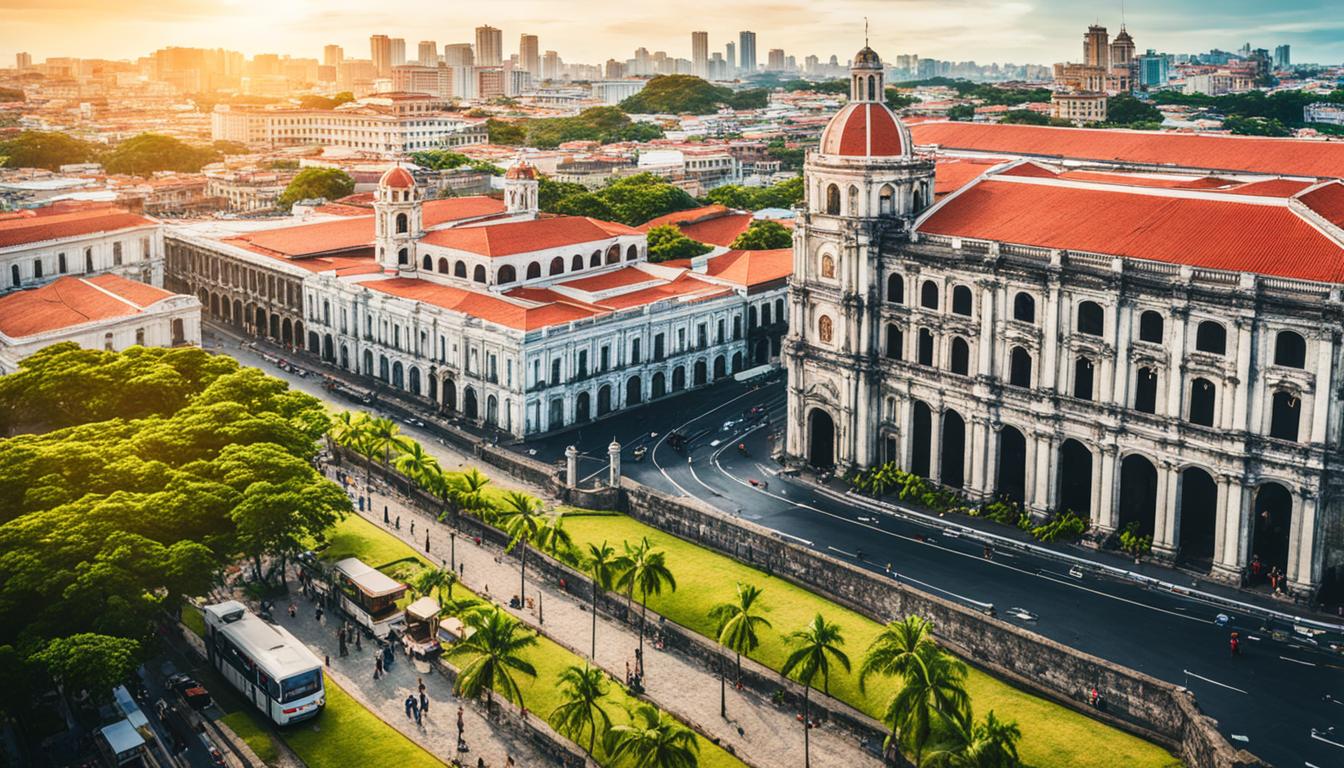
Unveiling the Timeless Charms of Historic Sites in the Philippines 🇵🇭
The archipelago nation of the Philippines is not only a tropical paradise but also a repository of rich historical narratives, held within the walls of its many landmark structures. As we delve into the historical landmarks of the Philippines , the multifaceted tapestry of Filipino culture unfolds, revealing tales from precolonial times to the vivid Spanish colonial era . Landmasses etched with history, such as the storied cobblestone streets of Philippine historical sites and the enduring edifices of cultural heritage sites in the Philippines , provide a testament to the nation’s former epochs.
In the heart of Manila lies Intramuros, a cornerstone among the historical sites and monuments in the Philippines . Established in 1571, this walled city was once the epicenter of Spanish sovereignty. Designated as a National Historical Landmark, Intramuros invites visitors to journey through time, surrounded by remnants of power such as Fort Santiago and the San Agustin Church . These sites are not just remnants; they are living chronicles of resilience, having withstood wars and natural disasters to earn their rightful place among the prestigious UNESCO World Heritage Sites in the Philippines .
Exploring Manila’s Intramuros: A Legacy of Spanish Colonial Power
Stepping into Intramuros the Walled City of Manila , one is immediately transported back to an era where the Spanish colonial influence was at its zenith. This historical site in Manila is not only a journey through time but also an intimate encounter with the famous landmarks in Philippines history. The massive stone walls and fortifications of Intramuros have withstood the test of time, preserving the stories of the past within their bounds.
At the heart of Intramuros is the Manila Cathedral , an imposing structure that demonstrates the intricate detail and grandeur of Spanish colonial architecture . Nearby, the fortress known as Fort Santiago stands as a silent witness to the city’s turbulent history, from the Spanish period up to World War II . Not to be missed is the San Agustin Church , the oldest stone church in the country, with its awe-inspiring interior and valuable artifacts signifying its status as a National Historical Landmark .
The bastions and baroque architecture echo the Spanish era’s influence on Filipino culture . Visitors are encouraged to traverse the cobblestone streets and revel in the surroundings that narrate the history of the historical landmarks in the Philippines . Intramuros serves as a living classroom, where each plaza, church, and canon reflect the complexities of Philippine history and invite contemplation on the interweaving of cultures over centuries.
These carefully preserved sites continue to draw not only international tourists but also Filipinos eager to reconnect with their heritage. As one of the most historically significant historical sites in Manila , Intramuros remains a vivid tableau of the country’s past, serving as a centerpiece for the rich tapestry that is Philippine history.
Historical Landmarks Philippines: Celebrating Heritage Outside the Capital
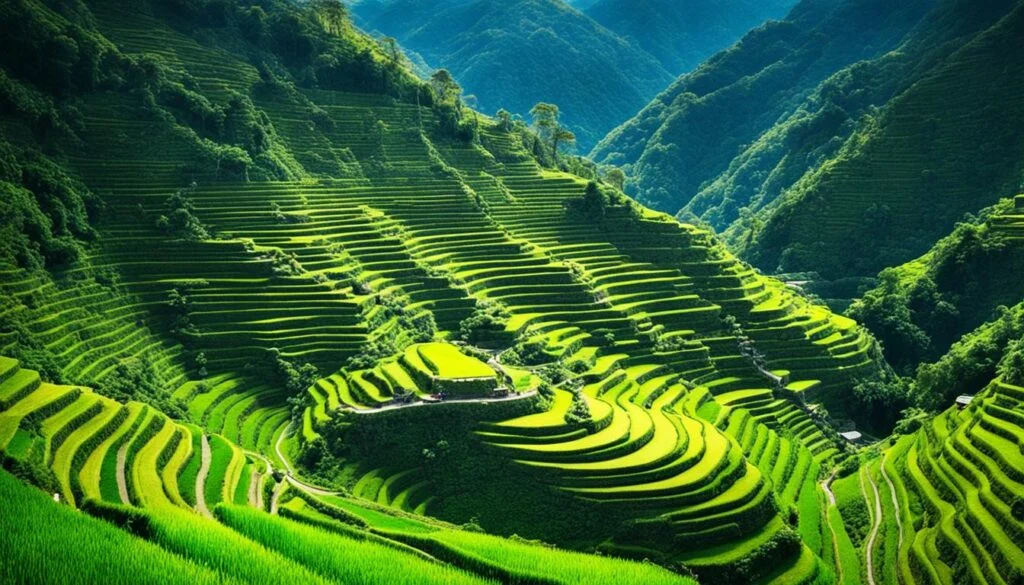
Stepping outside the bustling streets of Manila, the Philippines reveals a rich tableau of history and culture manifested through its celebrated historical landmarks. From highland terraces that defy modern engineering to the steadfast monuments of heroes and breaths of colonial past that linger in cobblestone streets, these sites beckon travelers and history enthusiasts alike to explore and reflect on the Philippine’s storied past. Here are some of the prominent historical places that make the Philippines a must-visit destination.
The Banaue Rice Terraces: Engineering Marvel of the Ifugao
Carved into the mountains of Ifugao , the Banaue Rice Terraces are a testament to the ancient indigenous engineering skills of the Philippine ancestors. Frequently referred to as the “ Eighth Wonder of the World ,” these terraced paddies offer breathtaking views and a glimpse into a sustainable agricultural tradition that has endured for millennia. Recognized among the UNESCO World Heritage Sites in the Philippines , the terraces showcase a harmonious relationship between humans and the environment, perpetuated through the diligent care of the Ifugao people.
Rizal Park and the Reverence for a National Hero
In the heart of Manila lies Rizal Park , also endearingly known as Luneta Park , a historical urban park dedicated to Philippine independence . The park is named after the revered national hero, Dr. Jose Rizal , whose influence on the nation’s history is memorialized where he was executed, igniting the Philippine Revolution. Today, the park serves as a popular tourist attraction in the Philippines, drawing crowds to its gardens, monuments, and museums, celebrating the spirit of freedom and the people’s respect for their heritage.
Corregidor Island: A Crucible of War and Bravery
Situated at the mouth of Manila Bay, Corregidor Island stands as a living museum, chronicling the heroic stand of Filipino and American soldiers during World War II . It features significant wartime landmarks such as the Pacific War Memorial Museum and the Filipino Heroes Memorial . The island is a powerful reminder of wartime courage and has been etched into the collective memory as one of the most poignant historical sites in Philippines.
Calle Crisologo in Vigan: A Colonial Time Capsule
Calle Crisologo in Vigan transports visitors to the Spanish colonial period through its well-preserved architecture and old-world charm. Part of Vigan’s designation as a UNESCO World Heritage Site , this area is abundant in historical landmarks in Vigan , with ancestral houses lining the streets, offering a unique glimpse into the Filipino lifestyle during the colonial era.
The exploration of the Historical Landmarks of the Philippines is indeed a reflective and enlightening journey through the country’s rich history and culture. Sites such as the time-honored Intramuros , the verdant Banaue Rice Terraces , the inspirational Rizal Park , and the wartime stronghold of Corregidor Island each tell a tale of the Filipino spirit. These iconic locations are more than just some of the most popular tourist attractions in the Philippines ; they stand as testaments to the ingenuity, resilience, and courage that characterize the nation’s past.
As vibrant components of the nation’s cultural heritage, these sites command honor and admiration. They serve as living classrooms where history is preserved and shared with the world, fostering a sense of national pride among Filipinos. It is this pride that resonates with both locals and visitors alike as they traverse through the various historical landmarks and delve into the stories that shaped a nation.
Philippine historical sites , especially those recognized as UNESCO World Heritage Sites in the Philippines , provide an unmatched lens through which one can appreciate the intricacies of exploring the Philippines . It is through wandering amidst these monumental relics and scenic beauties that one gains a profound connection to Filipino culture and an enhanced understanding of its place within the global mosaic. The journey through these cultural heritage sites leaves an indelible mark on the hearts and minds of those who experience the archipelago’s storied past and enduring legacy.
Similar Posts

Unraveling the Tapestry of Filipino Cuisine 🇵🇭
Embark on a flavorful journey through the vibrant tapestry of Filipino Cuisine 🇵🇭 Savor iconic dishes, rich traditions, and diverse flavors!
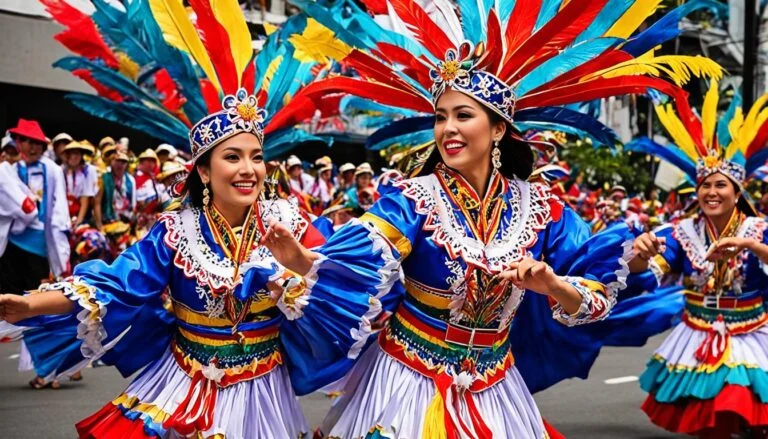
Vibrant Echoes: A Journey Through the Festive Heartbeat of Filipino Culture 🎉
Experience the vibrant spirit of the Philippines through its famous festivals – a kaleidoscope of colors, culture, and tradition! 🎉
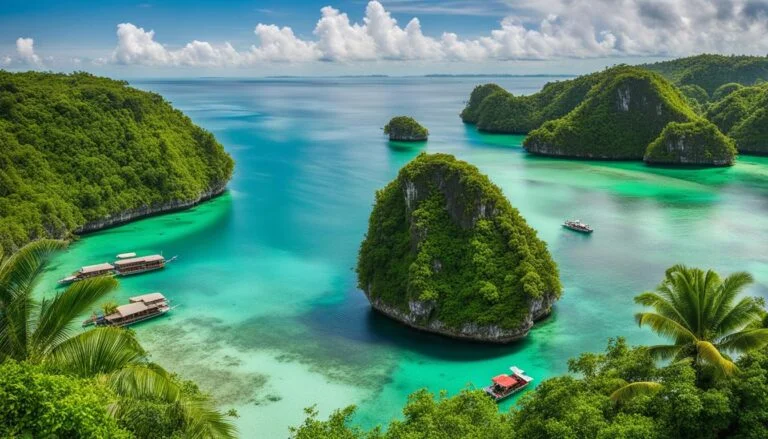
Unveiling Bohol Island: Discovering Nature’s 🍫 and Pristine Beaches
Unveil the wonders of Bohol Island 🌴 Marvel at the Chocolate Hills, pristine beaches, and rich colonial heritage in this captivating Philippines travel destination.
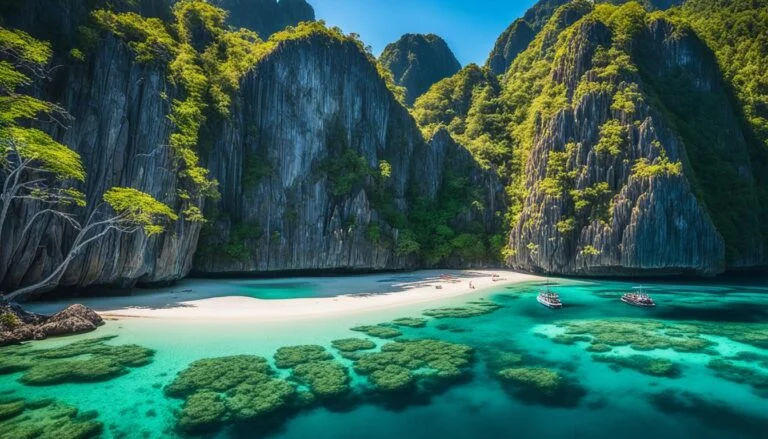
🏝️ Discover the Enchanting Islands of the Philippines: Tropical Paradises Await! 🌊
Discover the enchanting beauty and diverse experiences of the top islands in the Philippines 🌴 From serene lagoons to vibrant beaches, this tropical paradise awaits!
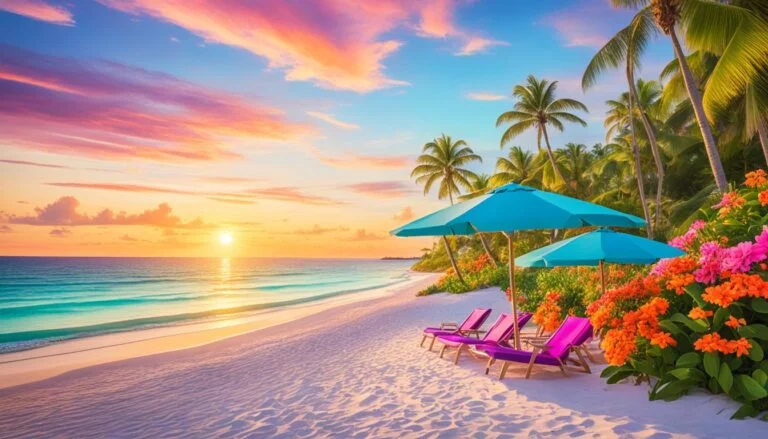
Unveiling Paradise: Ultimate Guide to Luxurious Beach Resorts in the Philippines 🌴
Uncover paradise at the best beach resorts in the Philippines, from luxurious retreats to eco-friendly havens 🌴 Indulge in serenity and luxury on the sun-kissed shores!
Leave a Reply Cancel reply
Your email address will not be published. Required fields are marked *
Save my name, email, and website in this browser for the next time I comment.

- VIGATTINDEALS
- VIGATTININSURANCE
- VIGATTINTRADE
- OTHER SITES
- DESTINATIONS
- TOURIST SPOTS
- RESTAURANTS
- FLORA AND FAUNA
- SPORTS AND RECREATION
- TOP 10 LIST
- TOURIST ATTRACTIONS
- VIGATTIN RADIO
- WELLNESS AND BEAUTY
- All Article
- Trending Articles

Top 10 Historical Places in the Philippines
The philippines is a world-famous tourist destination. aside from its beautiful places and scenic tourist spots, it is also rich in history and culture. filipinos built different landmarks and places to remember the outstanding sacrifices of national heroes and to beautifully exhibit the country’s heritage. these popular works of architecture can capture not only the eyes but also the hearts of the viewers..

Rizal Park or Luneta Park
The Philippines is a world-famous tourist destination. Aside from its beautiful places and scenic tourist spots, it is also rich in history and culture. Filipinos built different landmarks and places to remember the outstanding sacrifices of national heroes and to beautifully exhibit the country’s heritage. These popular works of architecture can capture not only the eyes but also the hearts of the viewers. These historical sites are part of the tourism in the Philippines.
1. Rizal Park
Previously called Bagumbayan Field, Rizal Park or Luneta Park was built as a tribute to our greatest national hero – Dr. Jose Rizal. It is one of the leading historical sites in the Philippines where Rizal was executed by the Spanish military firing squad on December 30, 1896 because he had spread the ideals of revolution against Spanish rule.
(Read: Five Surprising Facts about the Rizal Monument in Luneta Park )
Nowadays, it is one of the major tourist attractions of Manila. The park became a favorite spot for unwinding and socializing. It is also a place for family bonding and picnics during Sundays and holidays. 2. Corregidor
Want to know the moving story behind the famous Corregidor Island?
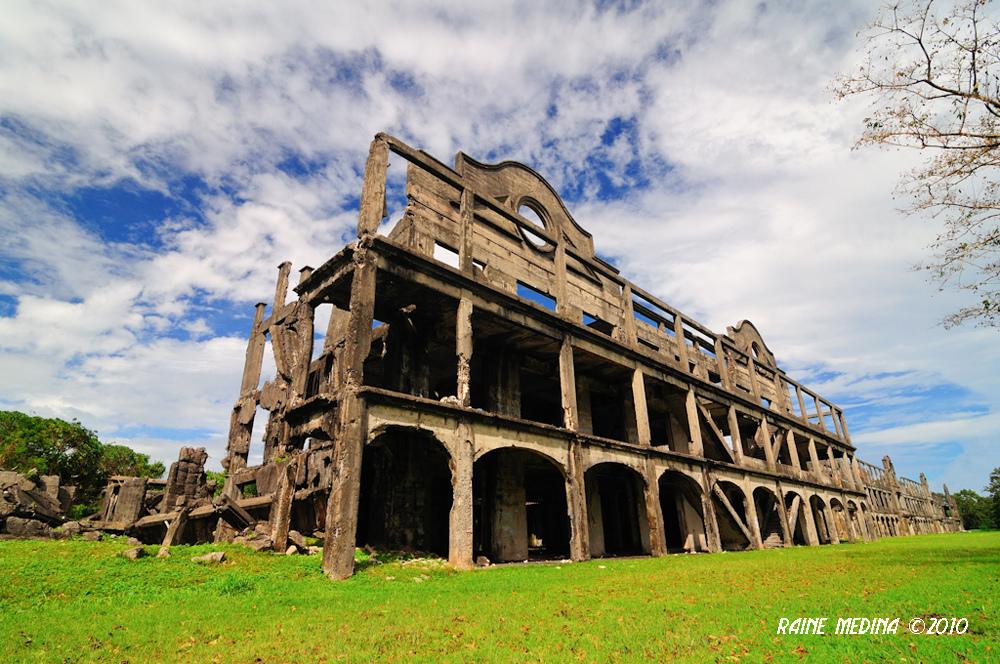
Known to be the “the Rock”, Corregidor is known for its important historical attractions. When the Japanese invaded the Philippines, Corregidor became the headquarters of the Allied Forces and also the seat of Philippine Commonwealth government. The huge firearms of Corregidor which are used in support for Filipino and American defenders of Bataan are now silent but the damage seen on buildings, structures, and tunnels in the island continues on telling a very moving story of a war that has claimed so many lives. A visit to this former battleground is a memorable experience, especially for those people who value and cherish freedom and peace.
3. Intramuros
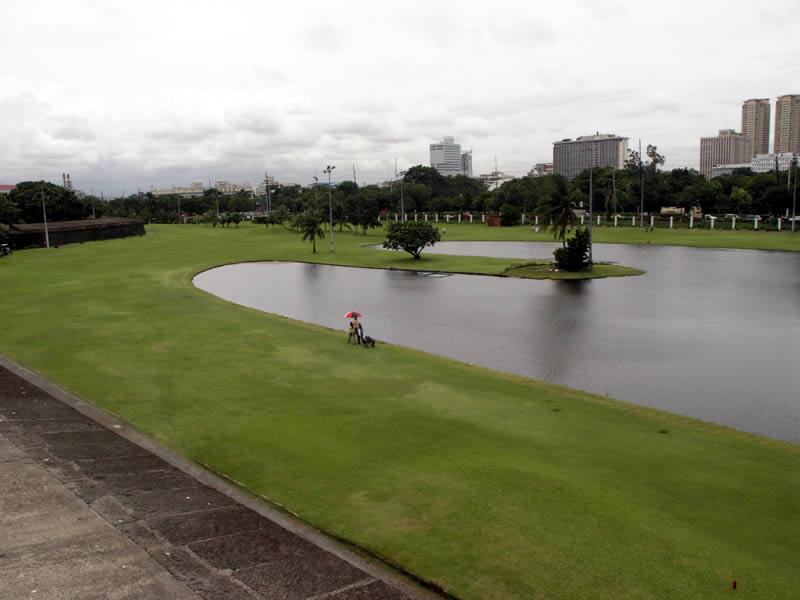
Intramuros is known in history as the “Walled City” because of its most famous feature: a nearly three-mile-long circuit of massive stone walls and fortifications that almost completely surrounds the entire district. It is the oldest district and historic core of Manila where old Spanish era influences are still plentiful. Photography and history lovers will find Intramuros an interesting destination. If you visit the place, you can still feel the Spanish ambiance and appreciate the historical landmarks and churches in the area. Plus, visiting Intramuros is very affordable and worth your time. Going here, you can re-experience the past in a modern light.
4. EDSA Shrine
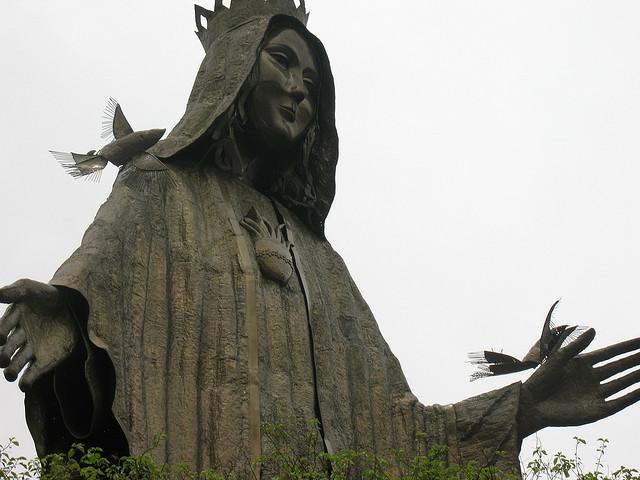
The EDSA Shrine, also known as the Shrine of Mary, Queen of Peace, and Our Lady of EDSA, is a small church of the Roman Catholic Archdiocese of Manila located at the intersection of Ortigas Avenue and Epifanio de los Santos Avenue (EDSA) in Quezon City. It is a monument dedicated to the first People Power Revolution and its peaceful outcome on December 15, 1989. It is a place that witnessed the two demonstrations that overthrew the presidencies of Ferdinand Marcos and Joseph Estrada. This shrine is a towering proof that fighting for freedom doesn’t have to be a blood-spattered cause. Rather, it can be achieved through peaceful means and with no casualty. 5. Barasoain Church
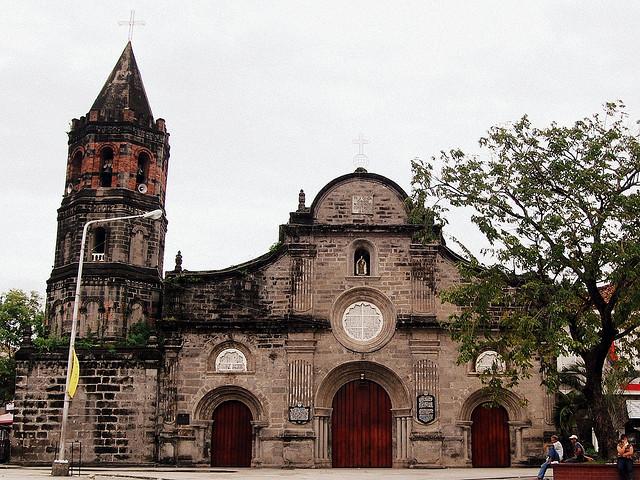
Having earned the title as the Cradle of Democracy in the East, Barasoain Church is the most important religious building in the Philippines.
It was founded by the Augustinian Missionaries in 1859 and served as the session hall of Malolos Congress, the first congress in the Philippines which was held in September 15, 1898 under the presidency of Pedro Paterno. Three major events in the Philippine history happened in this church: the convening of the First Philippine Congress (September 15, 1898), the drafting of the Malolos Constitution (September 29, 1898 to January 21, 1899), and the inauguration of the First Philippine Republic (January 23, 1899).
The architectural design of the church attracts and engages visitors because of the curved façade, rose windows, and medieval bell tower. Its floral motifs and paintings of angels and saints along the ceiling adorn the interior of the church.
6. Leyte Landing Memorial Park
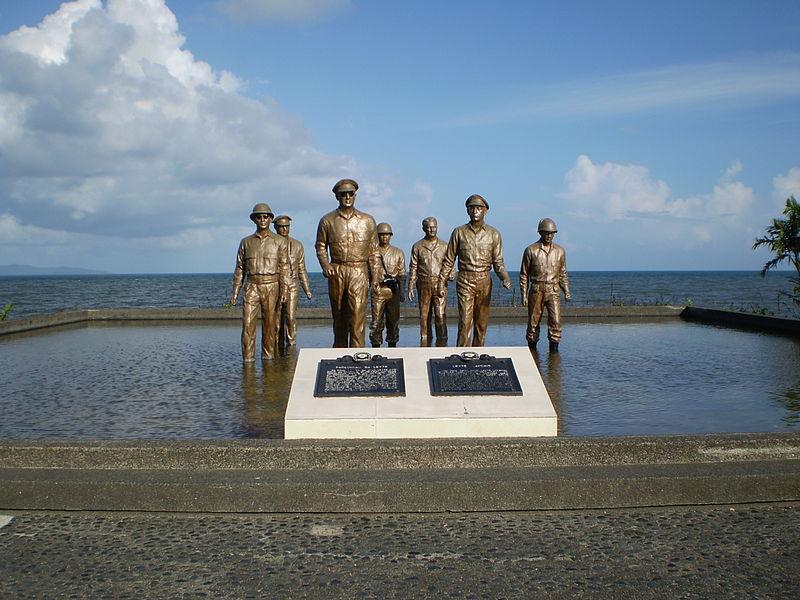
If you ever drop by Tacloban City, the Leyte Landing Memorial Park, formerly known as the “McArthur Park,” is a must-visit destination. Remember the promise made by Gen. Douglas McArthur “I shall return”? He kept this promise when he returned with an army of 700 ships containing 174,000 American soldiers at Red Beach, Palo, Leyte on October 20, 1944. The “red” in Red Beach doesn’t refer to the natural color of the sand, but its color after being drenched in blood.
Many tourists visit the park to reminisce an important event in history – the fulfilment of Gen. McArthur’s promise to the Filipinos to come back and help them win against the Japanese colonies. It always brings inspirational memories of how our beloved ancestors fought for our freedom.
7. Fort Santiago
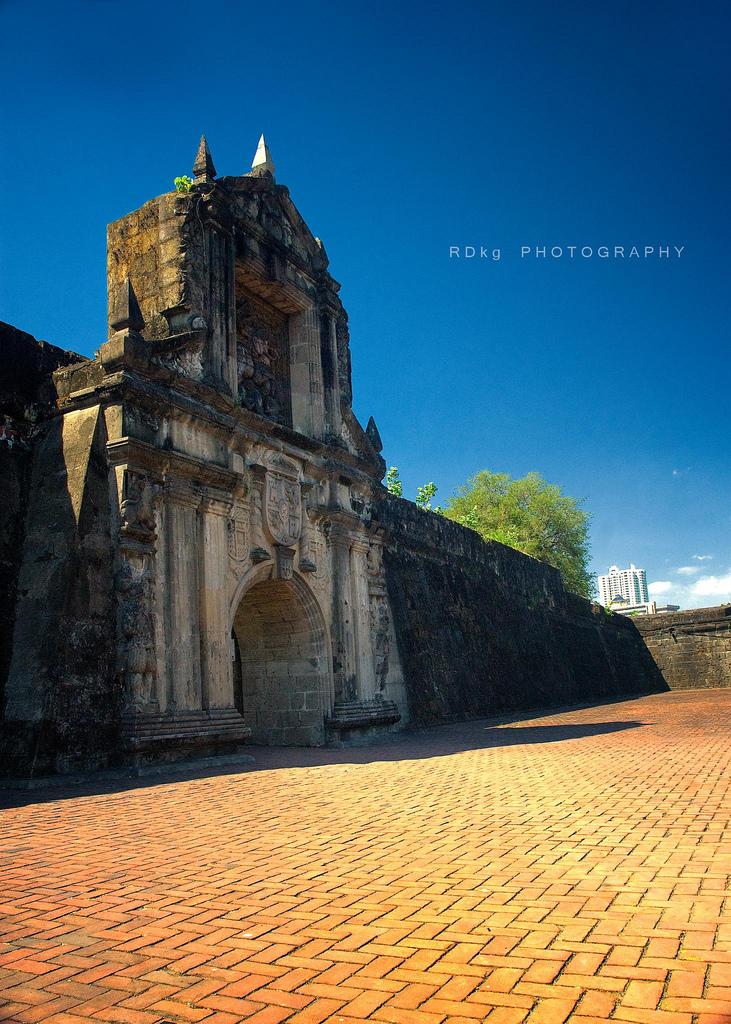
Fort Santiago, located in Intramuros, is a famous tourist destination in the Philippines. It is a historical structure that is part of the city’s famous wall. The attraction of the site is a museum where you can find a replica of Dr. Jose Rizal’s prison cell before he was executed. The rest of Fort Santiago has been set up into a beautiful park. There is also an imitation of old dungeons – dark underground chambers or cells used to confine prisoners. You can just imagine how hard it is to be imprisoned, tortured, and executed in one of them. 8. Mactan Shrine
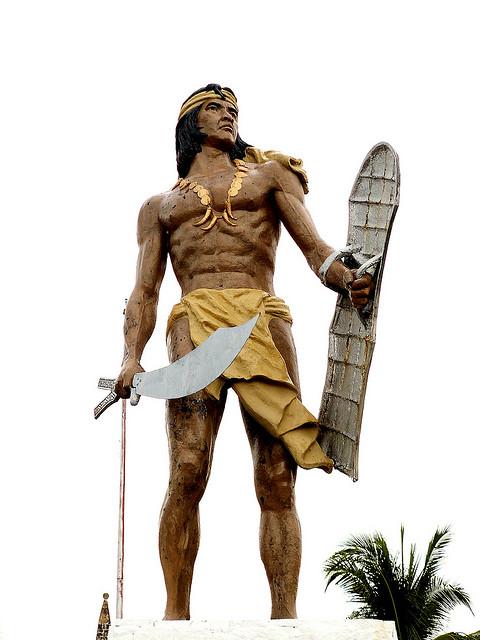
The Mactan Shrine, located in Mactan Island in Cebu, is made in honor of Lapu-Lapu, Ferdinand Magellan, and the Battle of Mactan. It is also known as Liberty Shrine and it lies on the very ground where the battle took place. The said encounter was between the Spaniards led by Ferdinand Magellan and the locals led by Lapu–Lapu.
Ferdinand Magellan and his crew were the first people to introduce Christianity in the Philippines. In the quest to prove that the earth is not flat, he traveled the world and docked in Mactan, where he was eventually killed by Lapu-Lapu on April 27, 1521. Lapu-Lapu is recognized as the first native of the archipelago to have resisted the Spanish colonization. 9. Rizal Shrine
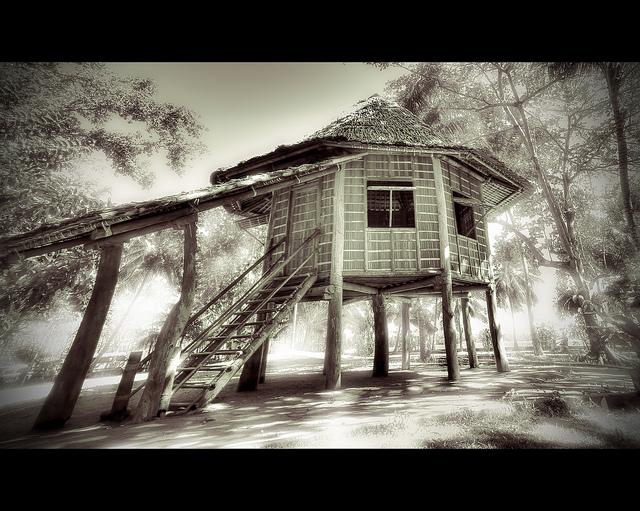
Rizal Shrine is an important historical place in Dapitan where Dr. Jose Rizal spent four years in exile. He lived here as a physician, merchant, farmer, inventor, painter, sculptor, archaeologist, linguist, grammarian, teacher, architect, poet, biologist, composer, surveyor, and environmentalist. He was also a father and brother to all Dapitanons, serving and helping those who needed him. No wonder Dr. Jose Rizal is considered as the Philippine National Hero.
Rizal Shrine nowadays is one of the most attractive tourist spots in the Philippines. It reflects Rizal’s lifestyle and how he socialized with the people around him.
10. Banaue Rice Terraces
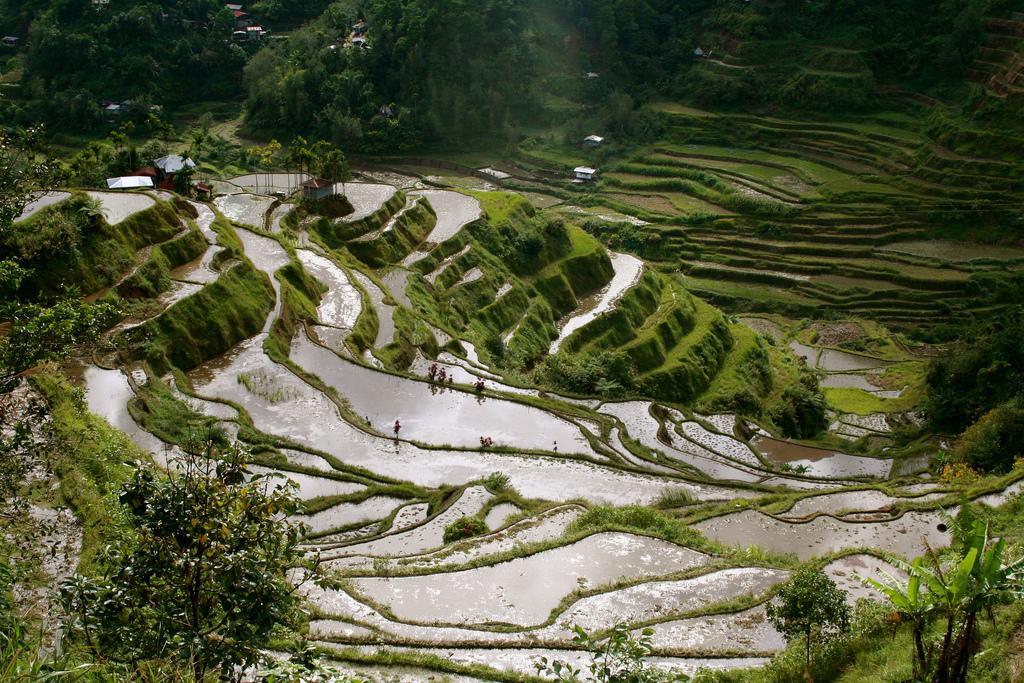
How in the world could they have accomplished this amazing feat?
The Banaue Rice Terraces was made approximately 2000 years ago, carved into the mountains by the indigenous people using only their hands and some crude equipment. It is said that if the steps were put end to end, it would encircle half the globe. It is considered as one of mankind's greatest engineering accomplishments.
For more historical sites in the Philippines, you may read these articles:
Cavite: The Historical Capital of The Philippines
Historical Tourist Attractions in Quezon City
Taguig City: Its Historical and Cultural Heritage
V isit the Historical Sites of Pampanga
Quezon Province’s Historical Attractions
Historical Sites in Ormoc City, Leyte
About Us | Privacy Policy | Contribute Vigattintourism © 2024
Vigattin Tourism
50 Most Beautiful Tourist Spots in the Philippines

No words can accurately describe how beautiful the Philippines is. Not to mention that it’s a cheap country to visit.
But with more than 7,000 islands to choose from, even globe-trotters would be hard-pressed to pick the tourist spots in the Philippines they should explore first.
This guide makes travel planning easier by recommending the best places to visit in the Philippines , what to expect, must-try food and activities, and other vital information to help you decide which tourist spots to include in your travel bucket list.
Disclosure : Some of the links you’ll encounter below are affiliate links. We’ll earn a small commission if you book a hotel or purchase a travel package using any of these links at no additional cost.
Table of Contents
Top 25 best tourist spots in the philippines.
Here are 25 of the most popular Philippine destinations frequently visited by foreign and domestic tourists:
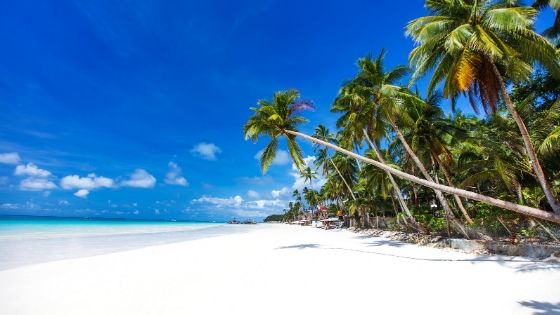
Ideal for: Couples, families, beach bums, adventure seekers
Tourists worldwide flock to the Philippines’ famous beach destination for its powdery white sand, crystal-clear blue water, and majestic sunset. Boracay has never failed to live up to its reputation every year, consistently making it to the list of the world’s most ‘Instagrammable’ places 1 .
After Boracay’s rehabilitation in 2018, beach regulations have become stricter to protect the island. Upon entering Boracay, visitors must present booking confirmation from any Department of Tourism-accredited hotels .
Top things to do in Boracay
- Watch the picturesque sunset at White Beach and Willy’s Rock
- Join a half-day tour around Boracay’s different beaches and snorkeling sites
- Experience parasailing to enjoy a breathtaking view of the island
- Jump off a cliff at Ariel’s Point
- Buy fresh seafood at D’Talipapa and have it cooked in a nearby restaurant
Where to stay in Boracay
Boracay resorts cater to every budget. Luxury hotels are located in Station 1, mid-range hotels in Station 2, and budget hotels in Station 3.
- Best Boracay luxury hotel: Henann Crystal Sands Resort
- Best Boracay mid-range hotel: Sundown Beach Studios
- Best Boracay budget hotel: Chill Out Hostel
How to get there
- The faster but more expensive way to travel to Boracay from Manila is to fly to Caticlan Airport. Then, ride a tricycle to Caticlan Jetty Port, where you’ll board a ferry to Cagban Jetty Port. From Cagban, ride a tricycle and get off at the drop-off point nearest your hotel.
- The cheaper but slower option is to fly to Kalibo Airport. From there, ride a van or bus to Caticlan Jetty Port and follow the same steps.
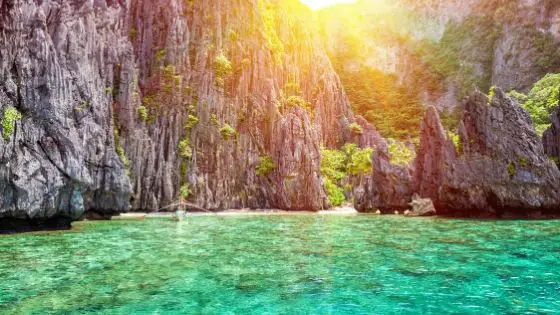
Ideal for: Couples, beach bums, nature lovers, adventure seekers
Palawan has so much captivating natural beauty, from towering limestone cliffs and beaches with turquoise water to caves and rich marine life. No wonder travel magazines like Conde Nast 2 and CNN Travel 3 lists Palawan as one of the world’s most beautiful islands.
Palawan’s most popular tourist destinations are Puerto Princesa, El Nido, and Coron. Interestingly, El Nido won a spot in HuffPost’s list of the “50 Awesome Solo Travel Destinations to Visit 4 “ for its beautiful beaches and a wide array of boutique hotels and hostels offering excellent opportunities to meet other solo travelers.
Many other hidden beaches on the island are also worth exploring.
Top things to do in Palawan
- Explore the Puerto Princesa Underground River , the world’s longest navigable underground river and one of the New 7 Wonders of Nature
- Enjoy different water activities (snorkeling, kayaking, scuba diving, etc.) at El Nido’s beaches and lagoons
- Dive at Coron Bay to discover diverse marine life and World War II Japanese shipwrecks
- Eat tamilok , a slimy delicacy from branches of mangrove trees
- Join an island-hopping adventure at Honda Bay
- Go scuba diving at Tubbataha Reef, a UNESCO Heritage Site and home to incredible marine biodiversity
Where to stay in Palawan
- Best hotel in Puerto Princesa: Casa Belina Bed & Breakfast
- Best hotel in El Nido: Duli Beach Resort
- Best hotel in Coron: The Funny Lion
- To get to Puerto Princesa, fly from Manila to Puerto Princesa International Airport.
- To get to Coron, fly from Manila to Busuanga and ride a van to Coron.
- To get to El Nido, fly from Manila to Puerto Princesa. From the airport, ride a van and drop off at the Corong-Corong bus terminal. Then, ride a tricycle that will take you to your hotel. The faster but more expensive way to get to El Nido from Manila is to take a 1.5-hour direct flight via AirSWIFT.
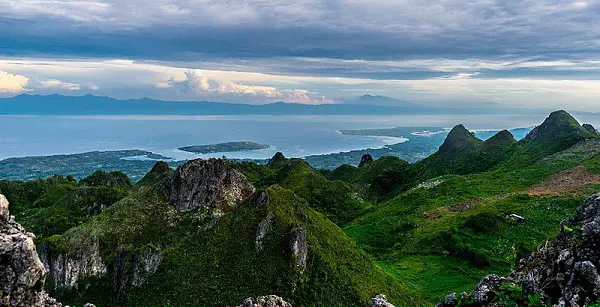
Ideal for: History buffs, foodies, beach bums, adventure seekers
Cebu is home to the Philippines’ oldest city, famous historical places, pristine beaches, and mouth-watering dishes. The island province is foreigner-friendly because locals speak fluent English, and its bustling city teems with hotels, shopping malls, and entertainment halls.
Top things to do in Cebu
- Enjoy an island-hopping tour around Cebu’s nearby islands
- Swim with whale sharks in Oslob
- Experience trekking and canyoneering in Badian
- Witness Sinulog Festival, Cebu’s largest festivity held every third Sunday of January
- Sample famous Cebu delicacies: lechon (roasted pig), danggit (salted dried fish), puso (steamed rice wrapped in banana leaves), and dried mangoes
- Visit Cebu’s historical sites : Colon Street, Mactan Shrine, Magellan’s Cross, Fort San Pedro, and Basilica del Santo Niño.
Where to stay in Cebu
- Best hotel in Cebu City: 18 Suites Cebu
- Best hotel in Bantayan Island: Carl‘s Island Inn
- Best hotel in Moalboal: Tongo Hill Cottages
- From Manila, take a 1-hour flight to Cebu. To get to your hotel from the airport, take a taxi or book a Grab ride.
- Visitors from China, Hong Kong, Singapore, South Korea , Taiwan, Kuala Lumpur, Tokyo, and Dubai may fly directly to Mactan Cebu International Airport.
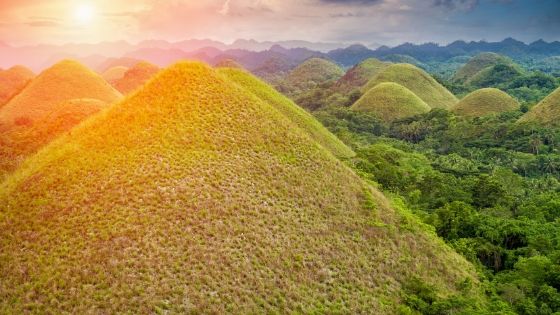
Ideal for: Solo travelers, couples, families, beach bums, nature lovers
Bohol is not your typical beach destination. Aside from its white-sand beaches, Bohol has some unique tourist spots in the Philippines, such as the famous Chocolate Hills and Philippine Tarsier Sanctuary. Its natural and man-made wonders are also worth exploring.
Thanks in part to the iconic Chocolate Hills, UNESCO has declared Bohol as the country’s first global geopark 5 , cementing its reputation among foreign tourists as one of the must-visit beautiful tourist spots in the Philippines.
Top things to do in Bohol
- Visit Bohol’s top tourist spots on a countryside tour , with a lunch buffet at the Loboc River Cruise
- Explore Balicasag and the Virgin Islands
- Enjoy fresh organic greens and ice cream in a cassava cone at Bohol Bee Farm
- Experience biking on a zipline and other thrilling adventures at Chocolate Hills Adventure Park
- Swim, snorkel, dive, or relax at Alona Beach
Where to stay in Bohol
- Best hotel in Tagbilaran: Sweet Home Boutique Hotel
- Best hotel in Panglao: Henann Tawala Resort
- From Manila, take a 1.5-hour flight to Tagbilaran Airport. To get to Panglao, ride a tricycle, van, or taxi.
- From Cebu, take a 2-hour fast ferry ride to Tagbilaran.
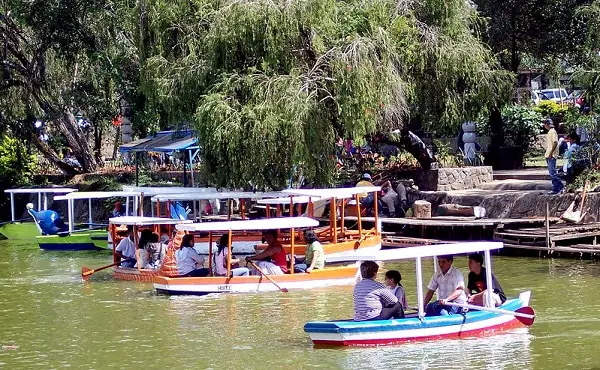
Ideal for: Couples, families, nature lovers, art enthusiasts
The Philippines is world-famous as a beach destination. But there’s more to the tropical islands than just seas and sand. Case in point: Baguio City.
The summer capital of the Philippines may be too commercialized and overcrowded nowadays, but it has not lost its charm. Baguio is still a romantic year-round destination with its cool breeze and lovely scenery of lush mountains and pine trees.
Related: The Fascinating History of Baguio’s Iconic Lion
Top things to do in Baguio
- Stroll along Burnham Park, Baguio Botanical Garden, Wright Park, and Camp John Hay
- Score local goods at bargain prices in Baguio Night Market
- Shop for souvenirs and fresh produce in Baguio Public Market
- Visit the BenCab museum in the nearby town of Tuba
- Join the Panagbenga Festival, also known as Baguio’s Flower Festival, in February or March
Where to stay in Baguio
- Best Baguio luxury hotel: The Manor at Camp John Hay
- Best Baguio mid-range hotel: The Orchard Hotel
- Best Baguio budget hotel: Starwood Hotel
Take a Victory Liner/Genesis Transport/Partas bus from Cubao to Baguio (travel time: 4 to 6 hours).
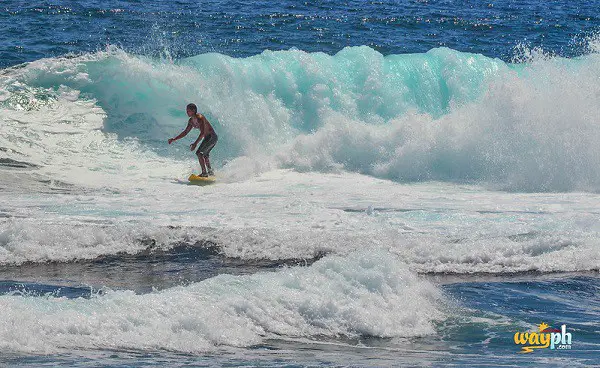
Ideal for: Surf enthusiasts, beach bums, backpackers
Siargao’s huge and strong waves make it one of the world’s best surf spots 6 . Although the surfing capital of the Philippines appeals mostly to surfers, the island also has excellent tourist spots for beachgoers.
Top things to do in Siargao
- Ride the waves at Siargao’s famous surf spots: Cloud 9, Jacking Horse, Quicksilver, etc.
- Enjoy an epic island-hopping adventure on Siargao’s best islands : Naked Island, Daku Island, and Guyam Island
- Explore, cliff jump, or swim at the Magpupungko Rock Pools
- Swim, snorkel, or relax at Sugba Lagoon
Where to stay in Siargao
- Best Siargao luxury hotel: Isla Cabana Resort
- Best Siargao mid-range hotel: Harana Surf Resort
- Best Siargao budget hotel: Mad Monkey Hostel
Fly from Manila to Sayak Airport. To get to General Luna town (where Siargao tourist spots are located), rent one of the vans, motorbikes, or multi-cabs parked outside the airport.

Ideal for: Families, nature lovers, beach bums, foodies
Davao is home to the Philippine eagle (one of the world’s rarest birds), the country’s highest mountain, and the exotic fruit durian. There’s so much to see and explore—from stunning beaches to family-friendly parks—for every type of traveler. Tourists can even book a day tour around Davao City to visit President Rodrigo Duterte ‘s house.
Top things to do in Davao
- Visit Davao’s top attractions, including Philippine Eagle Center , People’s Park, Davao Crocodile Park , and Eden Nature Park
- Dine and enjoy a spectacular view of Davao in Jack’s Ridge Resort & Restaurant
- Trek Mount Apo, the highest peak in the Philippines
- Sample Davao’s most popular fruits: durian, mangosteen, marang, and pomelo
- Join Kadayawan sa Dabaw , Davao’s grandest annual festival in August
- Swim, snorkel, and bask in the beauty of pristine beaches on Samal Island
Related: 14 Bizarre And Fascinating Philippine Festivals
Where to stay in Davao
- Best Davao luxury hotel: Seda Abreeza Davao
- Best Davao mid-range hotel: Paradise Island Park & Beach Resort
- Best Davao budget hotel: Villa Viva Belgica
Fly from Manila to Davao. Take a taxi or jeepney from the airport to Davao City.
8. Banaue Rice Terraces
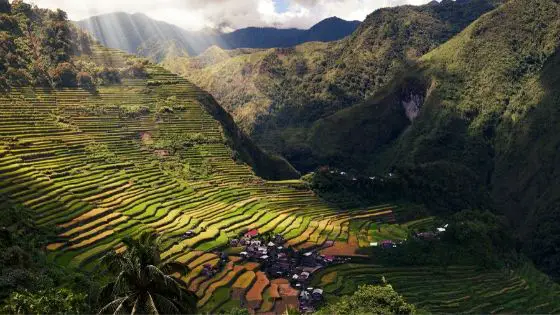
Ideal for: Backpackers, couples, nature lovers
Hundreds of years ago, indigenous people of the Ifugao tribe hand-carved thousands of rice paddies in the mountains of the Cordillera, now known as the Banaue Rice Terraces. It’s one of the most prominent tourist spots in the Philippines and is often called the “Eighth Wonder of the World.”
When you visit, it’s best to hire a local guide. Go to the Banaue viewpoint for the breathtaking scenery and Instagram-worthy snaps.
Top things to do in Banaue
Aside from Banaue Rice Terraces, there’s so much to do and see in and around Banaue:
- Enjoy the breathtaking scenery at Batad Rice Terraces, Hapao Rice Terraces, Mayoyao Rice Terraces, or Bangaan Village Rice Terraces
- Trek to Batad Village and Tappiya Waterfalls
- Discover the Ifugao culture, history, and arts at Banaue Ethnic Village, Tam-an Village, and Banaue Museum
- Shop for handicrafts, wood carvings, local coffee, and other souvenirs
Where to stay in Banaue
- Banaue Homestay
- Native Village Inn
- Baleh Boble Guesthouse
- Via plane: Take a 1.5-hour flight to Cauayan Airport in Isabela from Manila or Clark. From the airport, take a 3-hour van ride to Banaue.
- Via bus: From Manila or Baguio, ride an Ohayami Trans bus to Banaue (travel time: 9 to 15 hours).
9. Intramuros
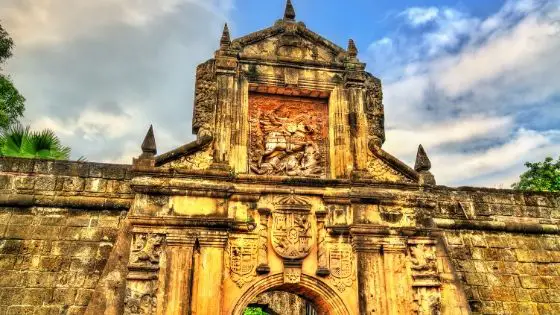
Ideal for: Solo travelers, couples, barkadas , history buffs
Discover and appreciate the Philippines’ rich history by touring Intramuros, one of the country’s best places to experience the Spanish colonial period. Intramuros is also a romantic setting for a date with its old-fashioned charm. After touring Intramuros, visitors may take a side trip to other equally popular places in Manila: Binondo and Escolta.
Related: The Lost Tunnels Buried Deep Beneath Intramuros
Top things to do in and around Intramuros
- Join a bamboo bike tour of the different tourist spots within the walled city: Fort Santiago, Plaza San Luis, Manila Cathedral, San Agustin Church, etc.
- Enjoy a food trip in Binondo
- Visit Binondo Church
- Marvel at the iconic landmarks along Escolta Street
Where to stay in Intramuros
- Best Intramuros luxury hotel: Bayleaf Intramuros Hotel
- Best Intramuros mid-range hotel: White Knight Hotel Intramuros
- Best Intramuros budget hotel: RedDoorz
- The most convenient way to get to Intramuros from anywhere in Metro Manila is to ride a taxi or Grab car.
- Alternatively, take the MRT to Taft Station and the LRT1 to Carriedo Station . Ride a jeep going to Pier and get off at Intramuros.

Ideal for: Solo travelers, couples, barkadas , history buffs, foodies
Be transported back in time when you visit Vigan City in Ilocos Sur. Be awed by the Spanish colonial period ancestral homes and structures that make Vigan a UNESCO World Heritage Site and one of CNN’s most picturesque towns in Asia 7 .
Top things to do in Vigan
- Take a stroll along the cobblestone streets around Calle Crisologo on foot or a kalesa (horse-drawn carriage) ride
- Try famous Vigan delicacies: empanada (pork-stuffed pastry), pakbet (vegetable dish), bagnet (deep-fried crispy pork belly), sinanglaw (beef innards stew), and Vigan longganisa (garlicky and spicy sausage)
- Visit iconic ancestral homes such as Syquia Mansion and Father Burgos’ house
- Join a cruise in Mestizo River to learn about Vigan’s history and marine biodiversity
- Visit an Abel cloth shop to see weavers in action and buy traditional woven products
Where to stay in Vigan
- Best Vigan luxury hotel: Hotel Luna
- Best Vigan mid-range hotel: Paradores de Vigan
- Best Vigan budget hotel: ZEN Rooms Guimod Transient Vigan
- The fastest way to get to Vigan is to take a 1.5-hour flight from Manila to Laoag, Ilocos Norte. From the Laoag Airport, take a 2-hour bus ride to Vigan.
- Alternatively, ride a bus from Cubao, Pasay, or Manila with a direct route to Vigan (travel time: 8 to 10 hours).
11. Mayon Volcano
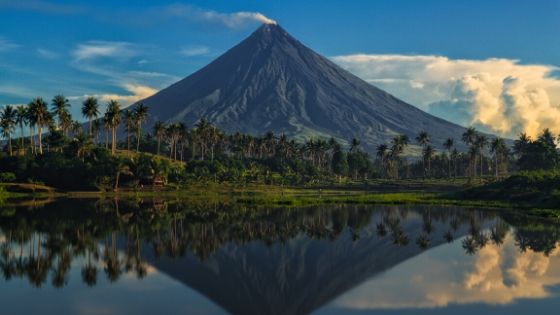
Ideal for: Backpackers, couples, families, adventure seekers, foodies
Mayon Volcano is one of the most popular tourist spots in the Philippines and a UNESCO World Heritage Site, thanks to its distinct, perfect cone shape. Aside from admiring the natural wonder, visitors can also experience a unique food trip and adventure in Albay, where the volcano is located.
Top things to do near Mayon Volcano
- Take a thrilling ATV tour around the base of Mayon Volcano
- Visit the Cagsawa Ruins Park
- Eat pili nuts, sili ice cream (made of chili and coconut milk), and spicy dishes cooked in coconut milk, such as Bicol express (pork stew), laing (vegetable dish), and pinangat (fish stew)
- Enjoy street food and a sunset view of Mayon Volcano at Legazpi Boulevard
- Hike up and zipline at Ligñon Hill Nature Park
- Enjoy an unobstructed, enchanting view of Mayon Volcano from Sumlang Lake while riding a bamboo raft or kayak
Where to stay near Mayon Volcano
- Mayon Lodging House
- Balay de la Rama Bed and Breakfast
From Manila, take a 45-minute flight or a 9-hour bus ride to Legazpi City, Albay.
12. Tagaytay
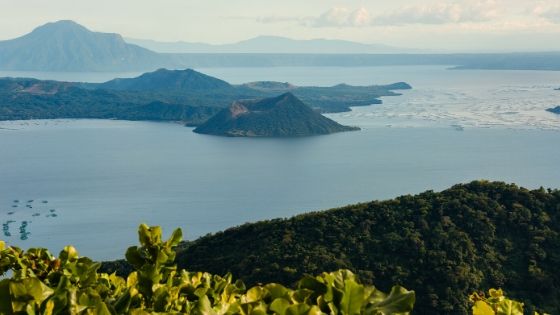
Ideal for: Couples, families, foodies
Tagaytay is a favorite road trip destination because of its proximity to Manila, cool weather, amazing views of Taal Lake and Taal Volcano, delicious food, and fun outdoor activities.
Top things to do in Tagaytay
- Visit the top tourist spots in Tagaytay : People’s Park in the Sky, Picnic Grove, Caleruega Church, SkyRanch, etc.
- Dine-in at Tagaytay’s popular restaurants: Breakfast at Antonio’s, Sonya’s Secret Garden, Bag of Beans, Josephine Restaurant, Mushroomburger, etc.
- Visit Zoori to enjoy a wildlife experience and panoramic views of Taal Volcano
- Have a fun-filled day with farm animals and flower gardens at Paradizoo
- Buy delectable tarts and other pastries at Rowena’s Pasalubong shop
Where to stay in Tagaytay
- Best Tagaytay luxury hotel: Anya Resort
- Best Tagaytay mid-range hotel: Quest Hotel
- Best Tagaytay budget hotel: RedDoorz
Ride a bus or shared van bound for Tagaytay/Nasugbu/Calatagan from Manila.
13. Mt. Pulag
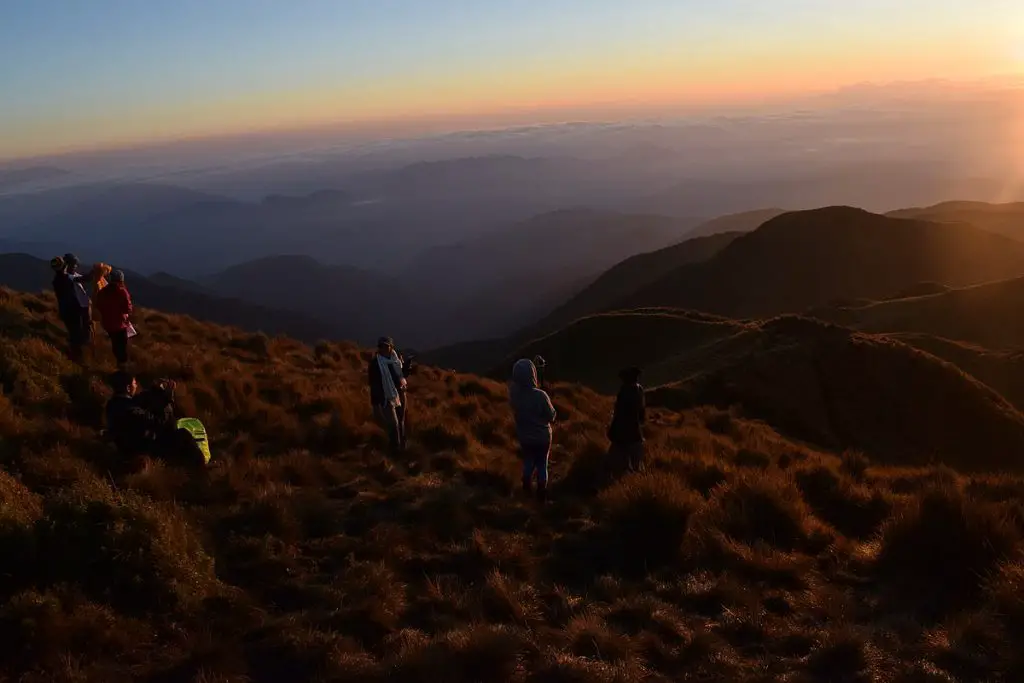
Ideal for: Backpackers, adventure seekers, nature lovers
Standing at 2,926 meters above sea level, Mount Pulag is the third-highest peak in the Philippines. It’s also the highest mountain in Luzon. Because of its easy trail and the magnificent sea of clouds surrounding its top, Mt. Pulag is a favorite hiking destination for first-timers.
Top things to do in Mt. Pulag
- Trek to Mt. Pulag for about 3-4 hours using the Ambangeg trail (for beginners). Advanced hikers can take the Ambaguio or Akiki trail.
- Witness the glorious sunrise and sea of clouds atop Mt. Pulag
- Experience the simple life in the mountains without internet, signal, and electricity
- Meet and interact with the locals
- Buy fresh produce and pasalubong from stores at the ranger station
Where to stay near Mt. Pulag
- Baban’s Homestay
- Newtown Plaza Hotel
- Dream Transient Rooms
From Manila, ride a bus to Baguio. From Baguio, charter a van or jeep bound for Bokod, Benguet, where the Department of Environment and Natural Resources (DENR) office is located. Hikers must register, attend an orientation, and pay fees to the DENR before climbing Mt. Pulag.
Outside the DENR office, ride a habal-habal (motorcycle) to the Babadak Ranger Station, the jump-off point where you can book a local guide (required) and a porter (optional).
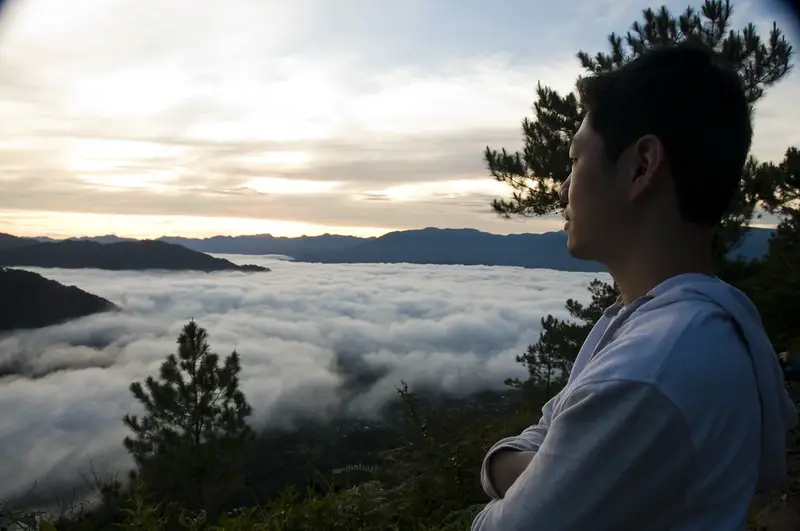
Ideal for: Solo travelers, backpackers, adventure seekers
Sagada’s tranquil charm and natural beauty make it one of the most popular tourist spots in the Philippines. There are many unique places to see and activities for adventure junkies.
Top things to do in Sagada
- See the hanging coffins in Echo Valley
- Explore Lumiang, Sumaguing, or Crystal Caves
- Hike to Kiltepan Peak or Marlboro Hills, watch the sunrise, and bask in the dreamy sea of clouds
- Swim at Bomod-Ok Falls and marvel at the rice terraces surrounding it
- Visit the Sagada Weaving Cooperative to see weavers in action and buy woven products
Where to stay in Sagada
- Isabelo’s Inn and Cafe
- Kanip Aw Pines View Lodge
- Kenlibed In n
- From Manila, ride a Coda Lines bus going directly to Sagada (travel time: 12 hours).
- From Baguio, go to GL Liner Terminal in Baguio Dangwa Terminal and ride a bus to Sagada (travel time: 6 hours).
15. Puerto Galera
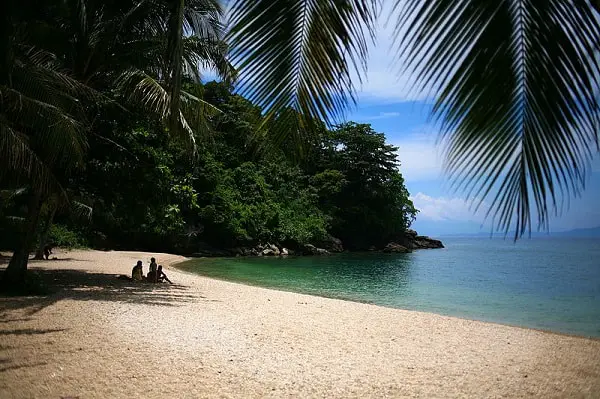
Ideal for: Beach bums, backpackers, families, barkadas
Puerto Galera is a favorite beach destination every summer because of its white-sand beaches. If you’re into scuba diving and snorkeling, you shouldn’t miss this tourist spot in the Philippines.
Top things to do in Puerto Galera
- Swim and relax at Aninuan Beach
- Snorkel or scuba dive at Coral Garden
- Experience the vibrant nightlife at White Beach
- Take a carabao ride to Tukuran Falls and enjoy the beauty of this hidden paradise
- Immerse in the local culture at the Mangyan Village
Where to stay in Puerto Galera
- Best Puerto Galera luxury hotel: Edgewater Dive & Spa Resort
- Best Puerto Galera mid-range hotel: Tribal Hills Mountain Resort
- Best Puerto Galera budget hotel: Bamboo House Beach Lodge & Restaurant
From Manila, ride a bus to Batangas Pier (travel time: 2 to 3 hours). Take a ferry boat ride from Batangas Pier to Balatero Port or Muelle Port (around 1 hour travel time). Ride a tricycle to your hotel.
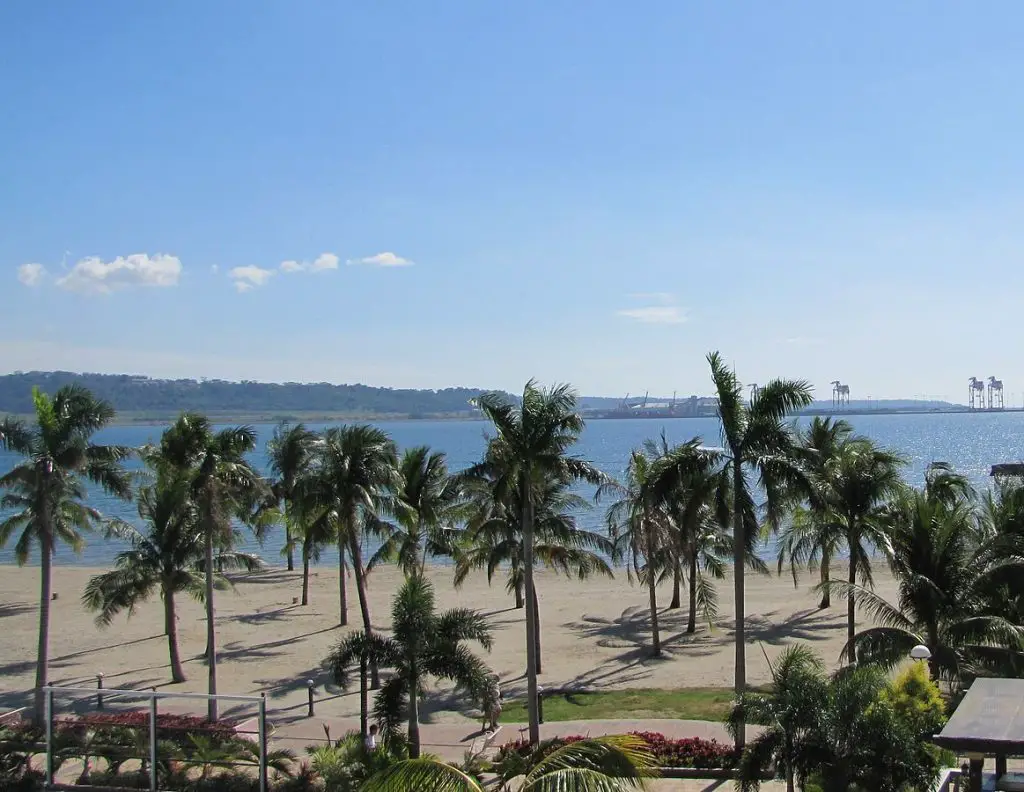
Ideal for: Families, barkadas , beach bums, nature lovers, adventure seekers
Looking for a place to enjoy summer outdoor activities with family or friends? Subic—just a few hours away from Manila—is one of the must-visit tourist spots in the Philippines. Many fun activities and beautiful beaches are available for tourists to enjoy.
Top things to do in Subic
- Explore the top tourist spots in Subic: Capones Lighthouse, Pundaquit Coves, Camara Island, etc.
- See wild animals up close in Zoobic Safari , the only tiger safari in the Philippines
- Enjoy thrilling water slides and attractions at Aqua Planet Waterpark
- Spend a fun-filled day on Subic’s Inflatable Island , the largest and wildest floating playground in Asia
- Cliff dive and swim at El Kabayo Waterfalls
Where to stay in Subic
- Best Subic luxury hotel: Mangrove Resort Hotel
- Best Subic mid-range hotel: Mango Valley Hotel 2
- Best Subic budget hotel: The Circle Hostel
Ride a bus bound for Olongapo from Manila and get off at Subic Bay.
17. Batangas
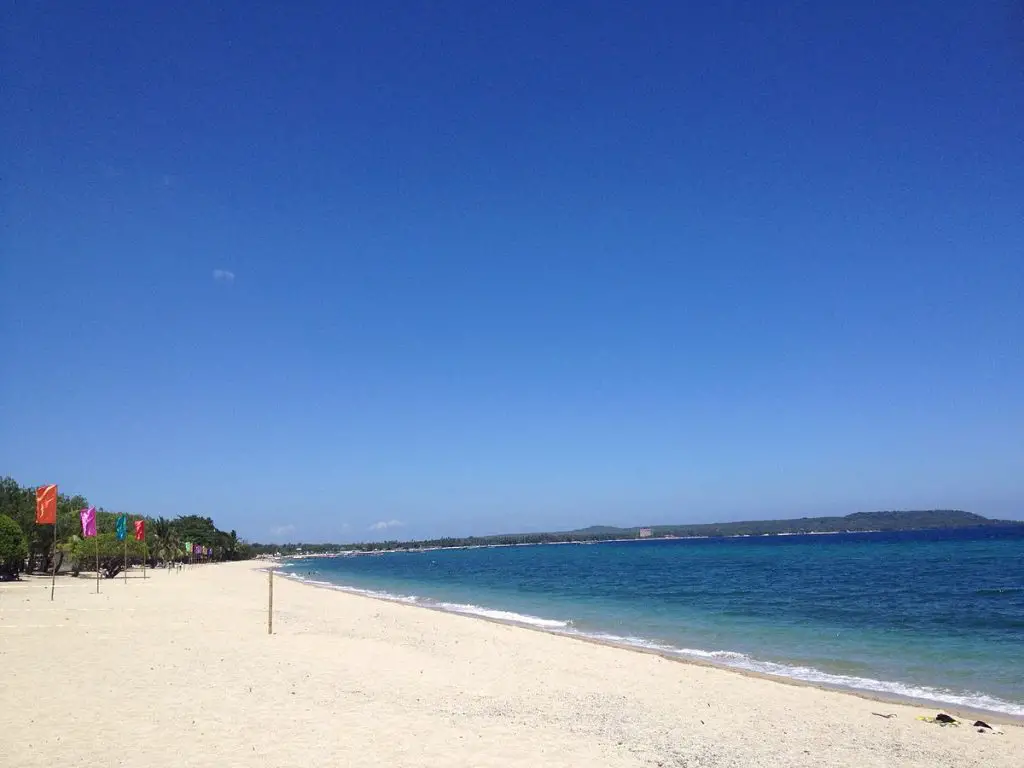
Ideal for: Families, barkadas , beach bums, adventure seekers, foodies
Batangas has many affordable beach resorts two to three hours from Manila. This makes the province a go-to place for family or barkada summer outings and corporate team-building activities.
Top things to do in Batangas
- Enjoy water activities in Batangas’ most popular beaches: Anilao, Laiya, Nasugbu, Calatagan, Isla Verde, etc.
- Trek up Batangas’ famous mountains: Taal Volcano , Mt. Pico de Loro, Mt. Batulao , Mt. Gulugod Baboy, Mt. Maculot , etc.
- Go scuba diving in Anilao to explore the famous diving spot’s spectacular underwater scenery
- Sample Batangas’ local cuisine: lomi (egg noodle soup), bulalo (beef stew), lechon (roasted pig), sinaing na tulingan (braised fish), kapeng barako (Batangas coffee), etc.
Where to stay in Batangas
- Best hotel in Anilao: Vivere Azure Resort
- Best hotel in Calatagan: Crusoe Cabins Resort
- Best hotel in Laiya: Acuaverde Beach Resort & Hotel
- Best hotel in Nasugbu: Pico Sands Hotel
From Manila, ride a bus to Batangas City/Batangas Pier/Nasugbu. From the bus terminal, ride a tricycle to your Batangas beach destination.
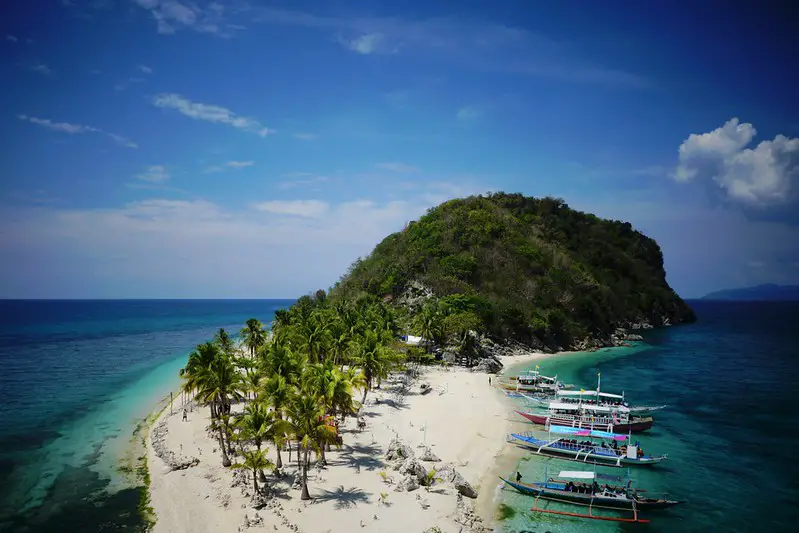
Ideal for: Families, barkadas , foodies, beach bums, history buffs
With its stunning beaches, one-of-a-kind culinary experience, historical sites, and genuinely warm and friendly people, Iloilo is one of the tourist spots in the Philippines where visitors want to keep coming back.
Top things to do in Iloilo
- Feast on Iloilo’s famous dishes and delicacies: La Paz batchoy (chicken and pork noodle soup), pancit molo (pork dumpling soup), fresh oysters, biscocho (twice-baked bread), barquillos (crunchy wafer roll), etc.
- Stroll along Calle Real and see heritage buildings that exude Iloilo’s old-city charm
- Visit Iloilo’s famous centuries-old churches: Miag-ao Church, Jaro Cathedral, Molo Church, San Joaquin Church, etc.
- Soak up the beauty of Islas de Gigantes and Sicogon Island
- Join the Dinagyang Festival, a religious and cultural festivity in Iloilo City held every fourth Sunday of January
Where to stay in Iloilo
- Best Iloilo luxury hotel: Richmonde Hotel Iloilo
- Best Iloilo mid-range hotel: Urban Sands Iloilo Hotel Resort
- Best Iloilo budget hotel: Figtree Hotel
From Manila/Clark/Cebu/Davao/Hong Kong/Singapore, take a direct flight to Iloilo International Airport. To get to the city, ride a taxi, jeep, or van from the airport.
19. Batanes
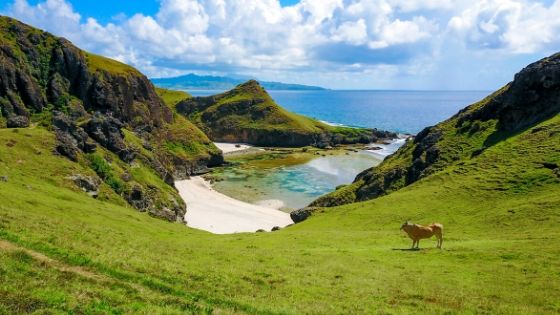
Ideal for: Solo travelers, couples, backpackers, nature lovers
Batanes is every Filipino traveler’s ultimate dream destination. What’s not to love about the romantic island province? From its scenic landscapes and gorgeous beaches to unique cultures, Batanes is worth a visit.
Top things to do in Batanes
- Tour the top Batanes attractions (Tukon Church, Basco Lighthouse, Honesty Coffee Shop, etc.) on Batan Island and Sabtang Island
- Meet the Ivatan people and immerse yourself in their culture. Try wearing vakul , the traditional headgear made of abaca fiber, too!
- Enjoy fresh seafood dishes: dibang (flying fish), payi (lobster), etc.
- Climb Mt. Iraya in Basco, the highest mountain in Batanes
Where to stay in Batanes
- Nathaniel’s Lodge
- Baletin Hometel
- Amboys Hometel
Fly from Manila (via SkyJet) or Clark (via Philippine Airlines) to Basco, Batanes. From the airport, walk to reach the Basco town proper. To get to Sabtang Island, ride a tricycle, jeep, or van to San Vicente port, where you’ll ride a ferry to Sabtang.
20. Camiguin
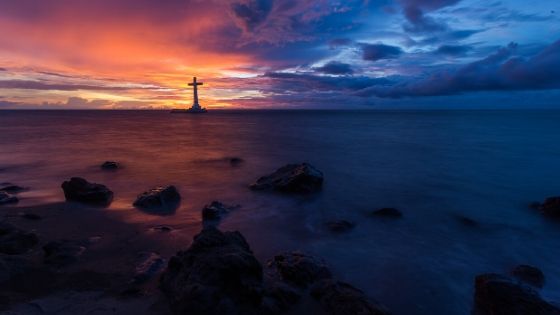
Ideal for: Beach bums, adventure seekers
This serene and beautiful tropical paradise in Northern Mindanao will leave you in awe with its many natural wonders. Camiguin is among the world’s best dive spots and is recognized by the Department of Tourism as one of the top tourist spots in the Philippines.
Top things to do in Camiguin
- Swim in the crystal-clear water of White Island
- Dive or snorkel at Sunken Cemetery to see its underwater tombs
- Snorkel around the Giant Clams Sanctuary
- Visit the old church ruins in Bonbon, Catarman
- Hike up Mt. Hibok-hibok
- Take a dip in one of Camiguin’s hot springs and cold springs
- Eat lanzones, a fruit native to the island and is considered the best and sweetest in the Philippines
Where to stay in Camiguin
- Mountain View Cottages
- Balai sa Baibai Resort
- Marianita’s Cottages
From Manila, fly directly to Camiguin via SkyJet. If you travel with a different airline, fly to Cebu first and then take a connecting flight to Camiguin Airport.

Ideal for: Families, history buffs, beach bums, nature lovers
Only a few hours away from Manila, Bataan is perfect for a quick weekend getaway. Although it’s not as touristy as the neighboring Subic Bay, people visit this province for its many historical and natural attractions.
Top things to do in Bataan
- Visit historical landmarks in Bataan: Dambana ng Kagitingan (Shrine of Valor) at Mt. Samat, Death March Marker, Fall of Bataan Marker, Bataan World War II Museum, etc.
- Join a walking tour at Las Casas Filipinas de Acuzar to learn what it was like to live during the Spanish colonial era
- Visit the Pawikan Conservation Center to learn about sea turtles and release baby sea turtles into the sea
- Admire the stunning rock formations and watch the sunset in Sisiman Bay
Where to stay in Bataan
- Best Bataan luxury hotel: Las Casas Filipinas de Acuzar Hotel
- Best Bataan mid-range hotel: The Plaza Hotel – Balanga
- Best Bataan budget hotel: Vista Venice Resort
- Via bus: From Manila, ride a Victory Liner/Genesis/Bataan Transit bus to Balanga, the jump-off point to Morong and other parts of Bataan (travel time: 3-4 hours).
- Via ferry: Go to the Esplanade Seaside Terminal behind SM Mall of Asia and take the ferry to Capinpin Port in Orion, Bataan (travel time: 1 hour). From Orion, ride a bus bound for Balanga.
22. Antipolo

Ideal for: Art enthusiasts, nature lovers, foodies
Antipolo is the home of the famous Hinulugang Taktak. But there are many other reasons to visit this city near Manila, particularly its hidden gems that will delight art and nature aficionados.
Top things to do in Antipolo
- Go on an off-roading adventure through an ATV ride on the slopes of Sierra Madre
- Pamper yourself at Luljetta’s Hanging Gardens Spa
- Be one with nature at Mount Purro Nature Reserve
- Visit the Pinto Art Museum and take Instagrammable snaps
- Learn pottery or calligraphy at Crescent Moon Café
Where to stay in Antipolo
- Date and Dine Resort
- The Citywalk Suites Apartment
- LeBlanc Hotel and Resort
Go to EDSA Shaw or Cubao and ride a van or jeepney to Antipolo. From the town proper, ride a tricycle to your destination in Antipolo.
23. Bacolod
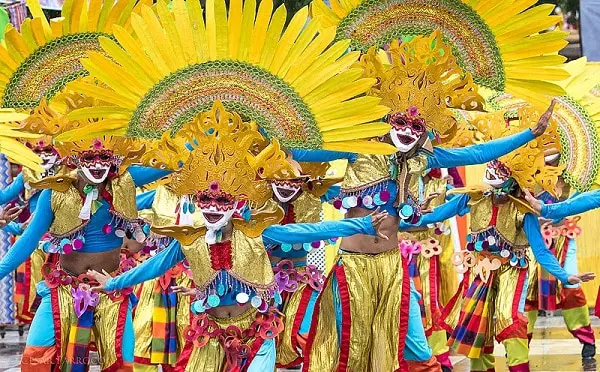
Ideal for: Families, barkadas , foodies, adventure seekers
Bacolod is where you’ll meet friendly, welcoming locals—you won’t be surprised to learn it’s called The City of Smiles . Apart from the people, Bacolod’s delicious food, rich history and culture, and natural attractions are the biggest reasons to visit this city. As a cherry on top, Bacolod’s hotel rooms cost an average of ₱2,650, making it the country’s cheapest tourist destination 8 .
Top things to do in and around Bacolod
- Take a morning or late afternoon stroll along Capitol Park and Lagoon
- Visit The Ruins, or the “Taj Mahal of Negros,” in Talisay and discover its exciting story
- Enjoy snorkeling, kite surfing, or kayaking on Lakawon Island in Cadiz
- Join in the fun at MassKara Festival, the happiest and most colorful Philippine festival, in October
- Eat the famous inasal (Bacolod-style chicken barbecue)
- Sample and bring home Bacolod delicacies: piaya (sweet flatbread), cansi (unique soup made up of bone marrow, batuan fruit, and beef shank), pinasugbo (deep-fried and caramelized banana slices), napoleones (layered puff pastry), etc.
Where to stay in Bacolod
- Best Bacolod luxury hotel: Seda Capitol Central
- Best Bacolod mid-range hotel: GT Hotel
- Best Bacolod budget hotel: Mainstreet Pension House
- From Manila, take a one-hour flight to Bacolod-Silay International Airport. Ride a van, taxi, or Grab car from the airport to Bacolod City.
- From Cebu or Iloilo, board a ferry to Bacolod.
24. Dumaguete
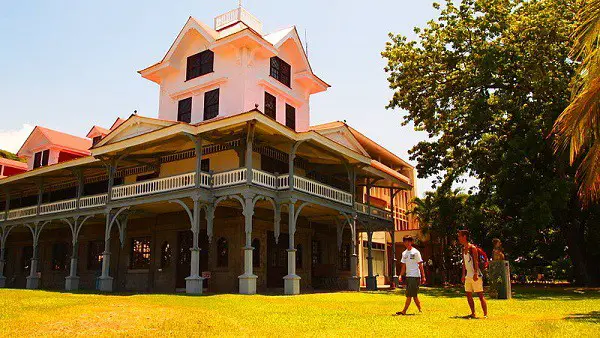
Ideal for: Nature lovers, adventure seekers
Known as the City of Gentle People , Dumaguete has been recently named the top retirement spot in the Philippines for foreigners 9 . Travel to Dumaguete and discover why the laid-back city attracts tourists and foreign retirees.
Top things to do in Dumaguete
- Tour Dumaguete’s top tourist spots: Dumaguete Belfry, Rizal Boulevard, Silliman University, etc.
- Visit the captivating Manjuyod Sandbar (the “Maldives of the Philippines”) and see dolphins swimming on your way to the sandbar
- Trek around the twin crater lakes of Balinsasayao and Danao
- Climb up Mt. Kanlaon, the highest mountain and largest active volcano in the Visayas
- Eat silvanas and sans rival, Dumaguete’s famous pastries
Where to stay in Dumaguete
- Best Dumaguete luxury hotel: Salaya Beach Houses
- Best Dumaguete mid-range hotel: Acqua Dive Resort
- Best Dumaguete budget hotel: The U Pension
- From Manila, take a direct flight to Dumaguete. From the airport, ride a multi-cab or tricycle to the city proper.
- From Cebu, take a direct bus to Dumaguete City.
25. Cagayan de Oro
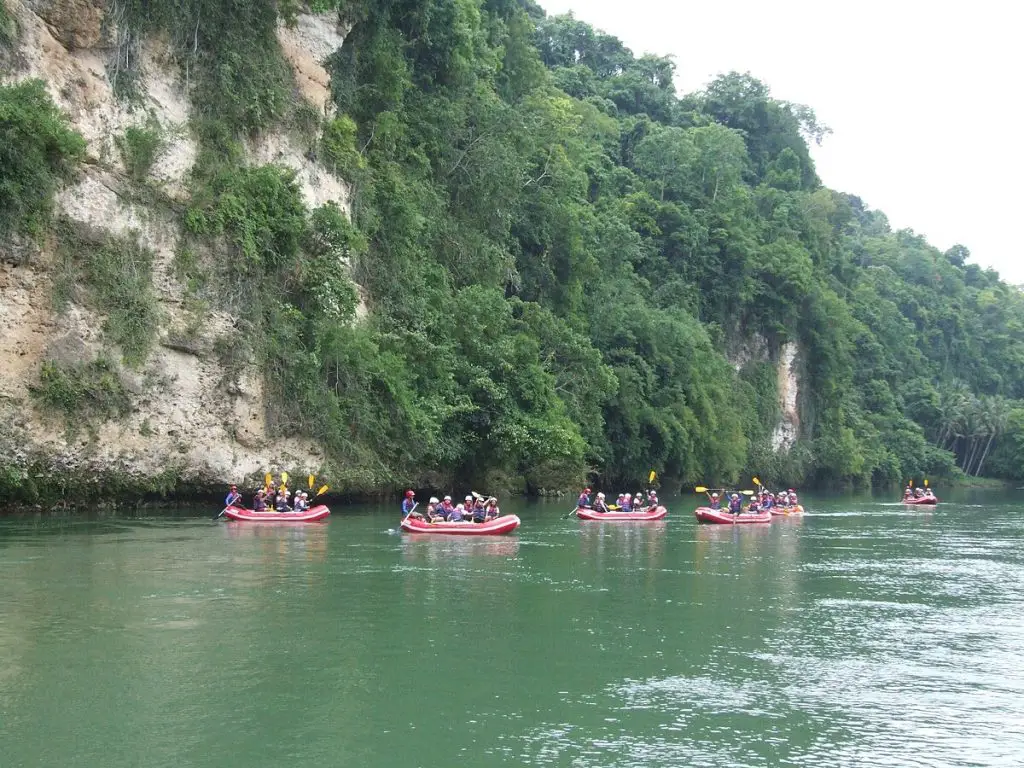
Ideal for: Adventure seekers, barkadas , families
Up for a physically challenging, unforgettable experience? Travel to Cagayan de Oro City and satisfy your inner adrenaline junkie. Conquer the raging rapids of Cagayan de Oro River—that’s what the Whitewater Rafting Capital in the Philippines is for!
Top things to do in Cagayan de Oro
- Experience whitewater rafting on the Cagayan de Oro River, or take it up a notch with the more intense whitewater kayaking adventure
- Enjoy ziplining or canopy walking in Macahambus Cave, leading to a fantastic view of the Cagayan de Oro River
- Visit CDO’s historical landmarks: Plaza Divisoria, Plaza de Los Heroes, MacArthur Memorial Marker, etc.
- Have fun rappelling, trekking, ziplining, horseback riding, or biking in Mapawa Nature Park
- Trek from Mapawa Nature Park to Mintugsok Falls, a hidden gem in CDO
Where to stay in Cagayan de Oro
- Best Cagayan de Oro luxury hotel: Seda Centrio
- Best Cagayan de Oro mid-range hotel: Red Planet Hotel
- Best Cagayan de Oro budget hotel: GC Suites
From Manila/Cebu/Davao/Iloilo/Zamboanga, fly to Laguindingan Airport in Cagayan de Oro. Take a shuttle or bus from the airport to various points in CDO.
Top 20 Hidden and Underrated Tourist Spots in the Philippines
Aside from its most popular destinations, the Philippines has many equally stunning places waiting to be discovered.
These off-the-radar places aren’t visited as often because of their remote location or underdevelopment (no electricity, Wi-Fi, mobile signal, shopping malls, etc.). But for travelers who want to visit places off the beaten path, such underrated destinations are simply perfect.
Here are the best up-and-coming tourist spots in the Philippines you should check out:
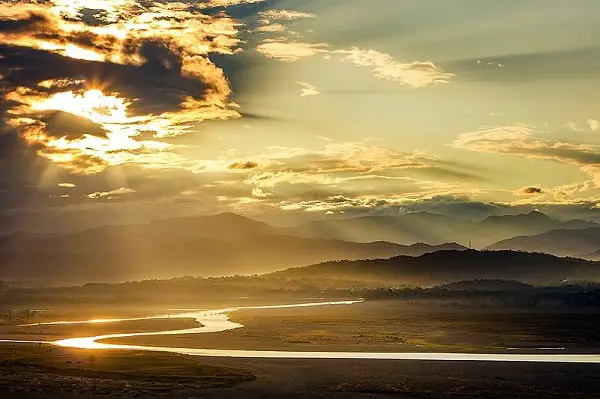
Ideal for: Backpackers, solo travelers, adventure seekers
Abra is not as famous as its neighboring tourist spots in the Philippines (Ilocos, Baguio, and Sagada). However, the landlocked province has a lot of natural attractions to offer.
Top things to do in Abra
- Visit Kaparkan Falls, Piwek Rock Formation, and Apao Rolling Hills in Tineg
- Trek Mt. Bullagao, the “Sleeping Beauty of Abra,” in Langiden
- Taste the local fare: pancit miki (stir-fried noodles), lechon de Abra , cascaron (deep-fried glutinous rice), palileng (mullet or goby fish stew), abuos (ant egg dish), etc.
- Visit the loom weaving community in La Paz
Where to stay in Abra
- Strutz Art Garden Resort
- Abra Valley Grand Hotel
- Abrassi Hotel and Restaurant
From Manila/Baguio/Vigan, ride a Partas/Dominion/Viron bus to Bangued, Abra. Travel time takes 8 hours from Manila or 2 hours from Vigan. From Bangued, take a jeepney to your destination in Abra.

Ideal for: Backpackers, nature lovers, adventure seekers
Bontoc is the gateway to Sagada and Banaue, two of the most popular tourist spots in the Philippines. If traveling there, why not make a side trip to Bontoc for a day or two? This small, quiet town is surprisingly blessed with incredible natural wonders.
Top things to do in Bontoc
- Get a panoramic view of the town and mountains at the Bontoc View Deck
- Trek Mt. Kofafey and witness the sunrise and sea of clouds
- Be mesmerized by the beauty of Maligcong Rice Terraces
- Take a dip at the enchanting Blue Lagoon
Where to stay in Bontoc
- Suzette’s Maligcong Homestay
- Vilma’s Home Stay
- Ridgebrooke Hotel and Restaurant
- From Manila, ride a Coda Lines bus bound for Bontoc or Sagada and get off at Bontoc (travel time: 11 hours).
- From Baguio, ride a taxi to Dangwa Terminal or Slaughter House and ride a D’ Rising Sun bus to Bontoc (travel time: 6 hours).
- From Sagada, ride a jeepney to Bontoc across the public market (travel time: 2 hours).
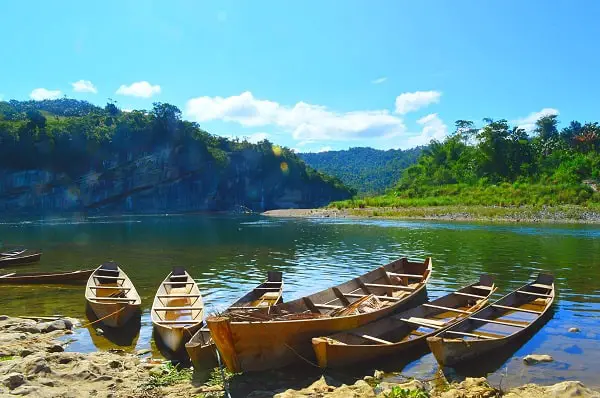
Ideal for: Families, barkadas , backpackers, adventure seekers, nature lovers
Cagayan V alley’s smallest and youngest province is an emerging eco-adventure destination named after a former Philippine president . Quirino makes up for its lack of beaches through its breathtaking waterfalls, pristine rivers, limestone caves, verdant mountains, and other hidden natural attractions.
Top things to do in Quirino
- Cruise the Cagayan River at Governor’s Rapids in Maddela or Siitan Park in Nagtipunan
- Have an adrenaline-pumping wakeboard adventure at Quirino Watersports Complex in Cabarroguis
- Trek to the different waterfalls in Quirino and take a dip in the clear water
- Go spelunking at Aglipay Caves and other amazing caves in Quirino
- Visit different ancestral villages to experience the cultures of various indigenous tribes
Where to stay in Quirino
- Capitol Plaza Hotel
- Villa Caridad Hotel & Resort
- Quirino Water Sports Complex Hostel
- Via bus: From Manila, ride a Florida/Five Star/Solid North bus to Maddela, Quirino.
- Via plane: Fly from Manila to Cauayan City, Isabela. From the Cauayan Airport, ride a van to Santiago City. From the terminal, ride a van or jeepney to Aglipay, Cabarroguis, Diffun, or Maddela in Quirino.
4. Jomalig Island
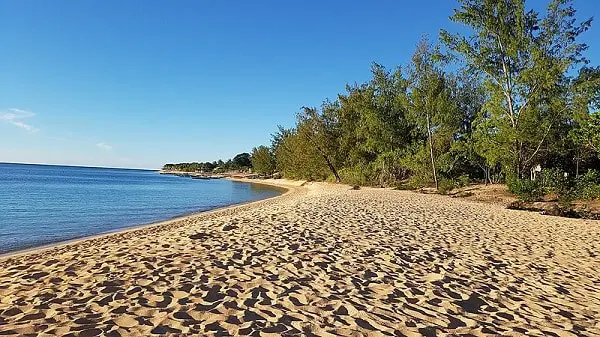
Ideal for: Beach bums, nature lovers, solo travelers, couples, barkadas
Reaching this remote island in Quezon province is an adventure in itself. While that sounds difficult , you’d be glad you took the challenge. The golden sand beaches and turquoise water on secluded Jomalig Island are fantastic—the long trip will be worth it!
Top things to do on Jomalig Island
- Explore Jomalig’s unspoiled beaches: Salibungot Beach, Kanaway Beach, Little Boracay, etc.
- See and take a photo with the Puno ng Walang Forever , Jomalig’s most famous tree
- Visit Lingayen Cove aka Little Batanes
- Watch the breathtaking sunrise at the beach
Where to stay on Jomalig Island
- JoJomalig Beach Resort
- Apple Beach Resort
Take a Raymond Transportation bus from Manila to Infanta, Quezon (travel time: 4-5 hours). Get off at Ungos Port, where you’ll ride a boat to Jomalig Port (travel time: 4-6 hours). Upon arriving at the port, ride a motorbike or habal-habal to your resort.
5. Caramoan Islands
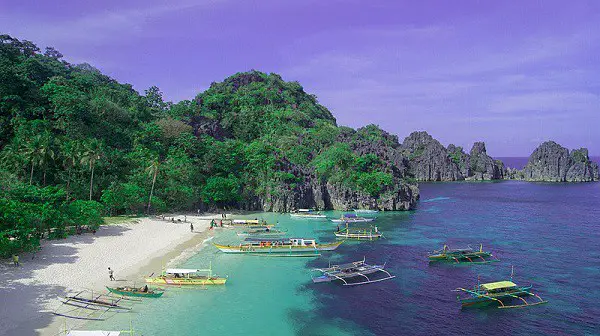
Ideal for: Beach bums, nature lovers, adventure seekers
Caramoan is Bicol’s secret paradise, perfect for beach junkies who want to escape the stressful city life. Fall in love with its fine white-sand beaches, diverse marine life, and other natural wonders that rival the top tourist spots in the Philippines.
Top things to do in Caramoan
- Enjoy island/beach hopping and water activities (kayaking, snorkeling, or scuba diving) at Sabitang Laya, Gota Beach, Hunongan Cove, etc.
- Explore the caves of Caramoan: Omang Cave, Culapnit Cave, Manipis Cave, etc.
- Hike up Mt. Caglago to get a panoramic view of the Caramoan Islands
- Climb the sharp rock cliff on Matukad Island
- Eat kinalas (noodles in thick brown broth)
Where to stay in Caramoan
- Tugawe Cove Resort
- La Casa Roa Hostel
- Casita Mia Bed & Breakfast
From Manila, fly to Naga City Airport in Pili, Camarines Sur. Ride a van or taxi from the airport to SM Naga. At the van terminal, ride a van called Filcab to Sabang Port. When you reach the port, take a boat to Guijalo Port. Ride a tricycle to Caramoan town center.

The Department of Tourism recognizes Romblon as one of the emerging tourism destinations in the Philippines. Heading to Boracay soon? Consider taking a side trip to the secluded, laid-back beaches of Romblon for relaxation.
Top things to do in Romblon
- Climb up the scenic Mt. Guiting-Guiting on Sibuyan Island
- Tour Romblon’s hidden gems: Carabao Island (the “next Boracay” 10 ), Cresta de Gallo, Balabara Beach, Bonbon Beach, etc.
- Explore different dive spots across Romblon
- Buy marble products as souvenirs at Romblon Shopping Center
Where to stay in Romblon
- The Beach House
- Romblon Fun Divers & Inn
- Sanctuary Garden Resort
- From Manila, fly to Tugdan Airport in Tablas, Romblon.
- From Boracay, walk to Bulabog Beach and hire a boat to Carabao Island.
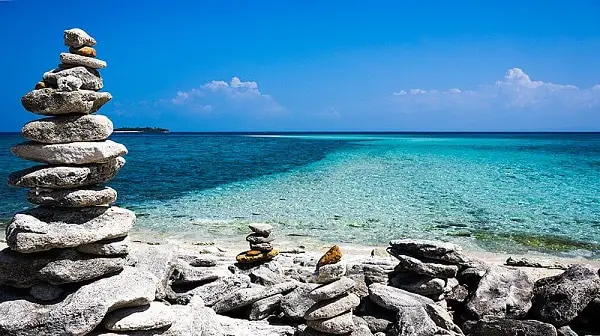
Ideal for: Beach bums, nature lovers
Masbate may not be the top-of-mind choice for traveling to the Bicol region, but it does offer a unique experience. For one, you can live like a cowboy in the Rodeo Capital of the Philippines—with its rolling hills, ranch life, and an annual festivity reminiscent of the Wild West.
For nature enthusiasts, Masbate offers unspoiled beaches, marvelous rock formations, stunning waterfalls, and other natural wonders.
Top things to do in Masbate
- Go scuba diving, swim with manta rays, and see other marine creatures at Manta Bowl shoal
- Revel in the beauty of Masbate’s natural attractions: Buntod Sandbar and Marine Sanctuary, Burubancaso Rock Formation, Sese Brahman’s Ranch, Catandayagan Falls, etc.
- Watch the dreamy sunset or camp out at Mayong Payong
- Experience the Rodeo Masbateño Festival in April
Where to stay in Masbate
- Ticao Island Resort
- Ticao Altamar Boutique Resort
- Sabine’s Place
Take a direct flight from Manila to Masbate City.
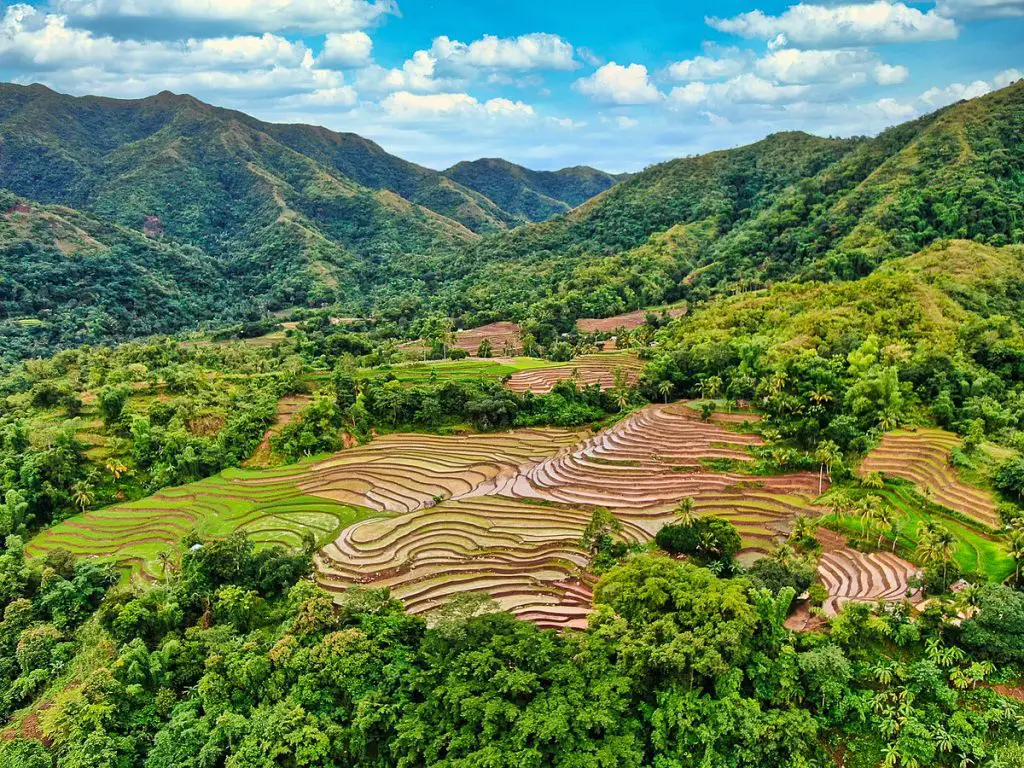
Ideal for: Beach bums, history buffs, nature lovers, adventure seekers
Travelers easily overlook Antique because it’s surrounded by top tourist spots in the Philippines (Boracay and Iloilo) . But this quaint province deserves more attention. Being groomed as the next eco-adventure destination, Antique has so much natural beauty and historical and cultural heritage worth visiting.
Top things to do in Antique
- Visit Seco Island, a gorgeous white-sand beach with serene turquoise water and a sandbar
- Enjoy an adrenaline-pumping river tubing activity at Malumpati Cold Spring
- Indulge in a relaxing Kawa Hot Bath in Tibiao
- Trek to Antique Rice Terraces and admire its majestic view
- See Antique’s heritage sites: Anini-y Church, Patnongon Church, Ruins of San Pedro Church, Casa Azurin, etc.
- Check out the Rafflesia , the world’s biggest flower, in Sibalom Natural Park
Where to stay in Antique
- Bugang Riverside Inn
- Phaidon Beach Resort
- From Manila/Davao/Hong Kong/Singapore, take a direct flight to Iloilo International Airport. Ride a van from the airport to Molo Terminal. Then, take a van or jeepney ride to Antique.
- From Clark, Pampanga, take a Philippine Airlines flight to Antique Airport.
- From Boracay, ride a ferry to Caticlan Jetty Port (or a tricycle if you’re coming from Caticlan Airport). Take a Ceres bus to Antique.
9. Guimaras

Ideal for: Beach bums, history buffs, foodies
Guimaras is another underrated province overshadowed by its neighbors, Iloilo and Boracay. The small island province—famous for growing the sweetest mangoes in the Philippines—is being promoted as an alternative to Boracay because of its white-sand beaches and proximity to Iloilo City. Discover what Guimaras has to offer before it becomes a mainstream tourist destination.
Top things to do in Guimaras
- Join an island-hopping tour of Guimaras’ best beaches: Nagtago Beach, Ave Maria Islet, etc.
- Visit different historical landmarks: Guisi Lighthouse, MacArthur’s Wharf, Roca Encantada, etc.
- See the Smallest Plaza, a Guinness Book of World Records holder for being the world’s smallest plaza
- Feast on mango-based dishes: mango pizza, mango bulalo , mango bibingka , mango beer, etc.
- Buy mango products (dried mangoes, jams, etc.) as pasalubongs
Where to stay in Guimaras
- Czech Beach House
- Jannah Glycel Beach House
- Raymen Beach Resort
From Manila/Davao/Hong Kong/Singapore, fly to Iloilo International Airport. Ride a van from the airport to SM Iloilo, where you’ll hail a taxi or jeepney to Ortiz Wharf. Take a ferry ride to Jordan Port. From the port, ride a tricycle to your resort.
10. Danjugan Island
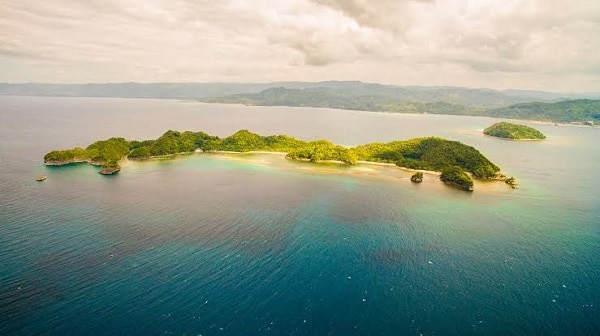
Ideal for: Backpackers, nature lovers, adventure seekers, beach bums
Danjugan Island is a protected marine and wildlife reserve sanctuary in Cauayan, Negros Occidental. With its lush rainforest and unique biodiversity, Danjugan is indeed a paradise.
This ecotourism destination won’t just wow you with its pure beauty but will also let you experience a rustic, back-to-basic lifestyle (no electricity and no cellphone signal). It is perfect if you’ll be on a digital detox.
Most importantly, a short stay on the island will teach visitors the value of environmental conservation.
Top things to do on Danjugan Island
- Appreciate Danjugan’s beauty through kayaking or sailing
- Explore its rich marine life through snorkeling or scuba diving
- Trek into limestone and mangrove forests, beaches, lagoons, and other natural attractions
- See a variety of bird species at the birdwatching view deck
- Watch the sunset at Turtle Beach
Where to stay on and near Danjugan Island
Tourists have two accommodation options when traveling to Danjugan: an overnight stay in an open-air cabana (Moray Lagoon Camp) or a private room (Typhoon Beach) on the island or book a resort outside Danjugan in Sipalay City.
Best Sipalay resorts near Danjugan:
- Punta Bulata Resort & Spa
- Artistic Diving Resort
- Jamont Hotel
From Manila, fly to Bacolod-Silay International Airport. Ride a taxi or Grab car to the South Ceres Bus Terminal. Catch a bus to Hinoba-an from the terminal and get off at Crossing Remollos-Quadro de King. Take a 30-minute boat ride to Danjugan Island.
11. Biliran
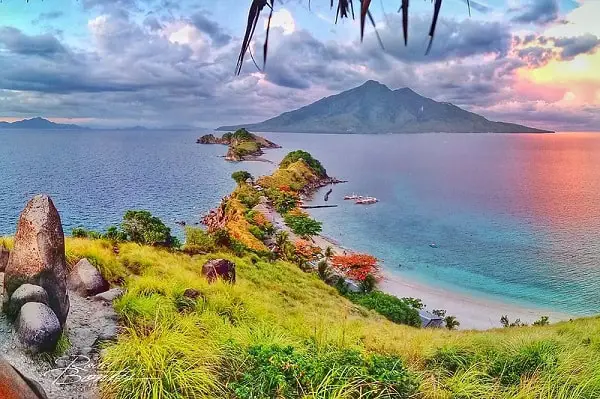
Biliran is relatively unheard of, even among Filipinos. Not many know it’s a province (Biliran used to be a sub-province of Leyte before becoming independent in 1992)—much less a tourist destination.
This small province is brimming with natural and man-made wonders; a weekend getaway is not enough to experience everything it offers. Be in awe of its beautiful mountains, rice terraces, waterfalls, caves, and beaches.
Top things to do in Biliran
- Trek to the photogenic Ulan-Ulan Falls, one of Biliran’s most beautiful waterfalls
- Go island-hopping on Higatangan Island (famous for its sandbar that changes shape and color), Sambawan Island, Dalutan Island, Agta Beach, etc.
- Visit Biliran’s historical and religious sites: Nasunugan Watchtower Ruins, Pilgrimage Site of Padre Gaspar, Almeria Church, etc.
- Discover the mystery of Tingkasan Bat Cave
- Bask in the majestic view of Iyusan Rice Terraces in Almeria
Where to stay in Biliran
- Napo Beach Resort
- GV Hotel Naval
- Via Cebu: From Manila/China/Hong Kong/Singapore/South Korea/Taiwan/Kuala Lumpur/Tokyo/Dubai, take a flight to Mactan Cebu International Airport. Ride a taxi from the Mactan Airport to the port where you’ll take an overnight trip to Naval, Biliran.
- Via Tacloban: From Manila, fly to Tacloban City Airport. Ride a jeepney from the airport to Tacloban downtown, then take a shuttle bus to Naval.
12. Kalanggaman Island
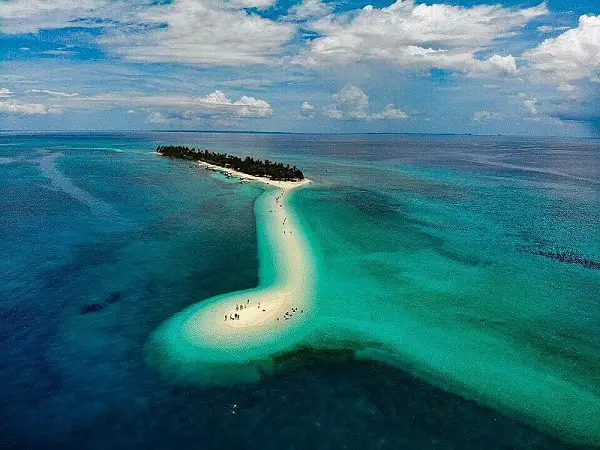
You might have already seen breathtaking aerial shots of Kalanggaman Island online . But viewing such images pales in comparison to personally experiencing the uninhabited island’s white powdery sand beaches and pristine blue water .
Top things to do on Kalanggaman Island
- Enjoy different water activities: swimming, snorkeling, kayaking, scuba diving, banana boat, etc.
- Chill under the trees and mingle with the locals
- Take a side trip to the top attractions in Palompon: Tabuk Marine Park and Bird Sanctuary, Masaba Falls, St. Francis Xavier Church, Lantaw Palompon, etc.
Where to stay near Kalanggaman Island
Kalanggaman has no beach resorts or hotels, but overnight camping is allowed. If you want to spend the night on the island, renting or bringing your tent is your only choice.
If camping is not your thing, you may book a hotel in Palompon or Ormoc. Here are the best accommodation options for your Kalanggaman escapade:
- Palompon Sugar’s Inn
- Sergi’s Resort and Hotel
- Ormoc Villa Hotel
- From Manila, fly to Tacloban, Leyte. Take a taxi or tricycle from the airport to Vansvans or Duptours terminal. Take a five-hour van ride to Palompon and then a one-hour boat ride to Kalanggaman Island.
- If you’re traveling from Cebu, the most convenient way to access and enjoy Kalanggaman is to join a day tour that will pick you up from your hotel in Cebu, take you to the island, and bring you back to the hotel.
13. Siquijor
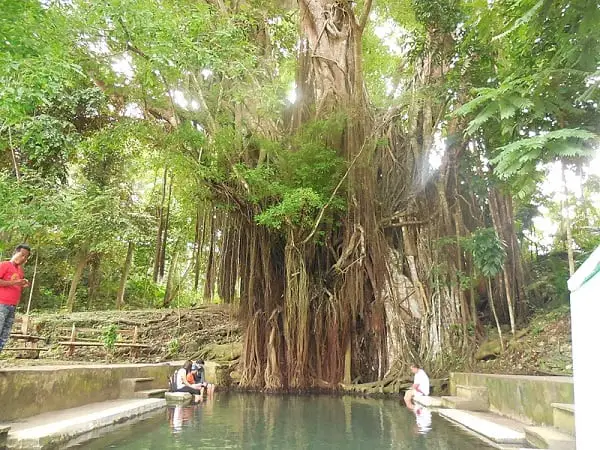
Siquijor is synonymous with witchcraft, sorcery, and mythical creatures . But fear not—the small, mystic province is not as scary as you imagine.
It’s considered one of the emerging favorite tourist spots in the Visayas, welcoming an increasing number of visitors 11 lately. Why is that so? Unknown to many, Siquijor has spectacular beaches, caves, nature parks, and historical attractions.
Top things to do in Siquijo
- Unwind, swim, or swing ala Tarzan into the water of Cambugahay Falls in Lazi
- Explore Siquijor’s best beaches: Salagdoong Beach, Kagusuan Beach, and Paliton Beach
- See the 400-year-old balete tree and have fun taking photos with it
- Visit Siquijor’s historical landmarks: Lazi Church, Siquijor Church, etc.
- Go spelunking at Cantabon Cave
- Trek to Mt. Bandilaan National Park
Where to stay in Siquijor
- RhenMart Inn
- Infinity Heights Resort
- Coco Grove Beach Resort
- Fly from Manila to Dumaguete City, Negros Oriental. From the airport, ride a jeepney or tricycle to Dumaguete Port. Then, take a ferry ride to Siquijor.
- If you take a side trip to Siquijor from Dumaguete, you can easily book a day trip to the island . You’ll be picked up from your hotel in Dumaguete, toured around Siquijor’s best tourist spots, and bring you back to the hotel.
14. Bukidnon
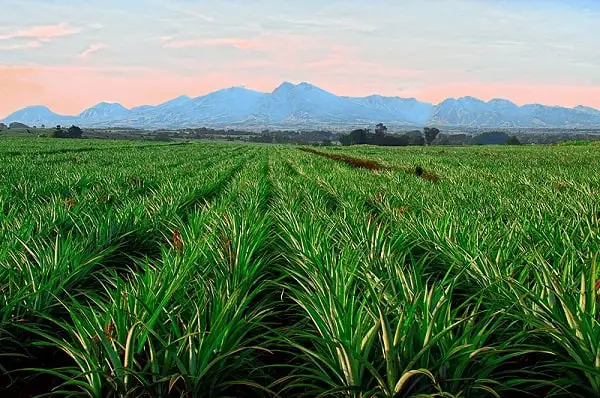
Ideal for: Families, barkadas , adventure seekers, nature lovers
Bukidnon is a favorite destination among hikers and adventure junkies; it’s perfect for enjoying Mindanao’s great outdoors and cool weather. The mountain province offers plenty of natural and man-made attractions.
Top things to do in Bukidnon
- Challenge yourself and your travel buddies to extreme activities at Dahilayan Adventure Park: ziplining, free-fall ride, sky jumping, obstacle course, etc.
- Hike up Panimahawa Ridge and revel in the view of mountain landscapes and a sea of clouds
- Marvel at the Hobbit-inspired houses in Mt. Kitanglad Agro-Eco Farm
- Visit Del Monte’s pineapple plantation, one of the largest in the world
- Conquer Mt. Kitanglad, the fourth-highest mountain in the Philippines
Where to stay in Bukidnon
- Eiffel Kubo
- GV Hotel Valencia
- Hotel Valencia
- From Manila/Cebu/Davao/Iloilo/Zamboanga, fly to Laguindingan Airport in Cagayan de Oro. From the airport, ride a van to Agora Terminal and catch a bus to Valencia or Davao City, which also passes by Malaybalay City.
- Alternatively, look for a transport service outside the Cagayan de Oro Airport, where you can rent a car or van that travels directly to Bukidnon.
15. Mati, Davao Oriental

Ideal for: Backpackers, adventure seekers, beach bums
If you travel to Davao City, consider adding Mati to your itinerary. One of the oldest towns in the Davao region, Mati will surprise you with the beauty of its famed Dahican Beach—the skimboarding capital of Davao—that boasts of powdery white sand and a laid-back vibe. Some tourists even find it more beautiful than Boracay.
Top things to do in Mati
- Enjoy a majestic view of the Sleeping Dinosaur or hike around the base of the hill
- Take a leisurely walk, relax, and try the famous empanada at Mati Baywalk
- Relax, swim, skimboard, or surf at Dahican Beach
- Visit the Subangan Museum, which showcases Davao Oriental’s historical and cultural heritage
Where to stay in Mati
- Senorita Suites
- Dahican Surf Resort
- Botona Dahican Beach Resort
From Manila, take a flight to Davao. Outside the Davao airport, ride a Bachelor Express bus to Mati. Or take a taxi to Gaisano Mall or Victoria Plaza and ride a van to Mati. Get off at Mati City Bus Terminal and charter a habal-habal or tricycle to your resort.
16. Maragusan, Compostela Valley
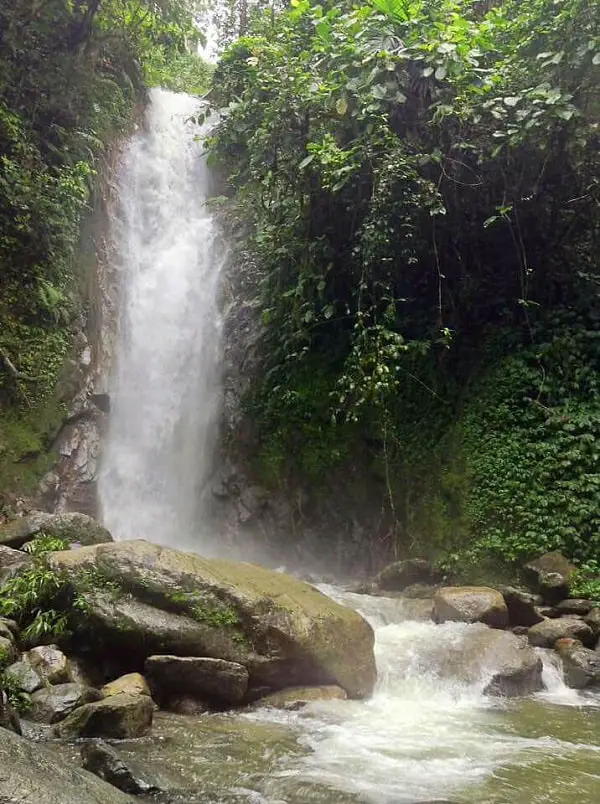
Ideal for: Families, nature lovers, adventure seekers
Dubbed the “Summer Capital of Davao Region,” Maragusan is excellent for tourists looking for an alternative to Baguio and Tagaytay to escape the scorching heat in Manila. Aside from enjoying cool temperatures, you can also soak up the beauty of Maragusan’s waterfalls and mountain landscapes.
Top things to do in Maragusan
- Trek to and explore Maragusan’s majestic waterfalls: Tagbibinta Falls, Marangig Falls, and Pyalitan Falls
- Climb up Mt. Candalaga, a favorite hiking spot in Mindanao, and be impressed with its flora and fauna and its sea of clouds view
- Witness the P’yagsawitan Festival, a celebration of the rich cultural heritage of the Mansaka indigenous people
Where to stay in Maragusan
- Haven’s Peak Highland Resort
- Aguakan Cold Spring Resort
- Kanlawig Hot Spring Resort
Fly from Manila to Davao Airport. From Davao City, ride a bus or van to Maragusan.
17. General Santos
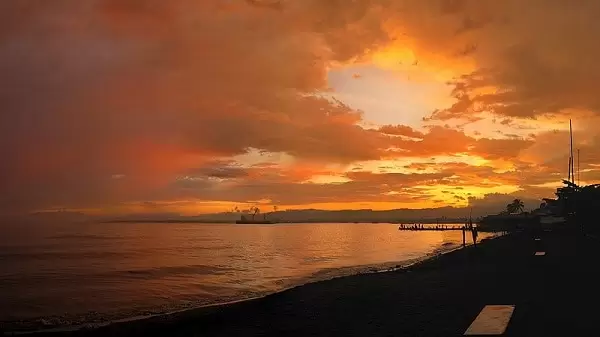
Ideal for: Nature lovers, adventure seekers, foodies
General Santos City (GenSan) is known as Filipino boxing icon Manny Pacquiao ‘s hometown and the gateway to other provinces in the SOCCSKSARGEN region. But these are not the only reasons to visit this city in South Cotabato. Traveling to GenSan is a must if you love nature and food-tripping.
Top things to do in General Santos
- Discover why GenSan is the country’s Tuna Capital—visit the Tuna Fish Port, buy fresh tuna, and have it cooked your way
- Join a Pacman “Adventour” to see Pacquaio’s mansions, Wildcard Gym, Pacman Beach Resort, Pacman Farm, The Manny Pacquiao Hotel, etc.
- Trek to Sanchez Peak and enjoy a panoramic view of GenSan
- Have a satisfying culinary experience at different GenSan restaurants
- Take in a stunning view of Sarangani Bay at Sarangani Highlands in GenSan
Where to stay in General Santos
- Best General Santos luxury hotel: Greenleaf Hotel Gensan
- Best General Santos mid-range hotel: Avior Hotel
- Best General Santos budget hotel: Antonio’s Apartelle and Suites
From Manila, fly to General Santos International Airport in South Cotabato.
18. Glan, Sarangani

Ideal for: Backpackers, families, beach bums, adventure seekers, culture enthusiasts
Craving a Boracay-like experience but hate the crowd? Head over to Sarangani Bay, where the quaint coastal town of Glan awaits visitors who will take in its unadulterated beauty. Its powdery white-sand beaches make Glan worthy of the moniker “The Small Boracay of Mindanao.”
Beyond the stunning beaches, there’s more to see and do in Glan and its neighboring towns. Experience Sarangani’s natural wonders, cultural diversity, colorful festivities, and more!
Top things to do in and around Glan
- Chill out or enjoy water sports and activities (swimming, snorkeling, diving, volleyball, etc.) at Gumasa Beach and Isla Jardin del Mar
- Experience Sarangani Bay Festival, the largest beach festival in the Philippines, held every May in Glan
- Tour around Glan to see century-old, American colonial-period ancestral houses
- Get wet and wild on a whitewater tubing adventure along the Pangi River in Maitum
- Paraglide from the mountaintop in Maasim for a breathtaking view of Sarangani Bay
- Take an immersion tour at the Lamlifew Tribal Village in Malungon and discover the weaving tradition of the B’laan tribe, one of Sarangani’s most prominent ethnic groups
Where to stay in Glan, Sarangani
- Kamari Resort and Hotel
- Juanita’s Inn
- King James Hotel
From Manila, fly to General Santos. From the airport, ride a taxi to KCC Mall. Next to the mall is a terminal where you’ll ride a van to Glan.
19. Sultan Kudarat
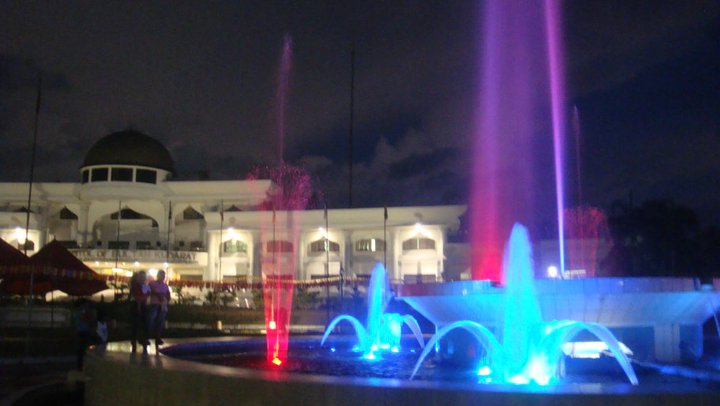
Ideal for: Backpackers, nature lovers, beach bums
Sultan Kudarat offers an exciting mix of natural attractions and cultural gems for travelers looking for a great side trip from Davao or South Cotabato. This little-known, underrated province is genuinely worth a visit.
Top things to do in Sultan Kudarat
- See the Sultan Kudarat Provincial Capitol building in Isulan and be wowed by its luxurious, Moro-inspired architecture and interior design
- Visit Baras Bird Sanctuary, home to a variety of bird species, in Tacurong
- Have a unique cultural experience at Talakudong Festival (held every September) that highlights the indigenous tribes in Sultan Kudarat and nearby provinces
- Explore the rich marine life and watch the golden sunset on Balet Island in Kalamansig
- Take a relaxing dip at Margues Hot & Cold Spring in Esperanza, Lagandang Hot/Sulphur Spring in Isulan, or Nuling Hot Spring in Lebak
Where to stay in Sultan Kudarat
- King Bayya Residences
- WoodLand Tourist Inn
- EDJIN Pension House
From Manila, fly to General Santos and then ride a multi-cab or taxi to Bulaong Public Terminal. Ride a bus or van from the terminal to Tacurong City, Sultan Kudarat.
20. Lake Sebu, South Cotabato

Ideal for: Culture enthusiasts, nature lovers
Lake Sebu is South Cotabato’s summer capital and primary eco-cultural destination. Tourists visit the charming town for its Instagram-worthy natural scenery (including its enchanting lakes), cool weather, and vibrant indigenous culture.
Top things to do in Lake Sebu
- Join a cruise around Lake Sebu and immerse in the T’boli culture
- Trek to the Seven Waterfalls of Lake Sebu and ride the zipline, which is the highest in Asia
- Watch how T’nalak, the traditional T’boli fabric, is woven at Lang Dulay T’nalak Weaving Center
- Wear a traditional T’nalak ethnic costume for a photo-op
- Visit the T’boli School of Living Traditions and learn T’boli native dance and music
- Sample different tilapia dishes (fried, grilled, steamed, kinilaw, etc.)
Where to stay in Lake Sebu
- Sunrise Garden Lake Resort
- Punta Isla Lake Resort
- El Galong Waterpark Resort
Fly from Manila to General Santos, then ride a taxi or multi-cab to Bulaong Terminal. Ride a van that will take you straight to Lake Sebu terminal. From the terminal, ride a jeepney or rent a habal-habal to Lake Sebu.
Top 5 New Beautiful Tourist Spots in the Philippines to Watch Out for
More tourist destinations in the Philippines are propping up. President Rodrigo Duterte approved laws declaring several sites in the country as new tourist spots 12 . This means the new tourist destinations will be funded and developed to boost tourism in their respective areas.
Here are the five new attractions in the Philippines that travelers should explore:
1. Mount Bulaylay
Mt. Bulaylay has the longest and tallest zipline in Nueva Ecija , making it the primary tourist spot in Cuyapo town. The local government of Cuyapo plans to develop it into an eco-tourism park.
2. Candon City Ecotourism Zone
Here’s another reason to visit Ilocos Sur besides the historic city of Vigan: a new ecotourism destination in Candon City is in the works. The Ecotourism Zone in Candon houses a sprawling watershed, and the local government hopes to lure tourists by offering recreational activities nearby.
With the recent opening of the newly built Heroes bypass road in Candon, the city’s tourist spots—including the new ecotourism zone—will be more accessible.
3. Santiago Cove
Ilocos Sur has its version of Boracay in Sabangan Cove (aka Santiago Cove). Like Bora, Santiago Cove boasts white sand and serene, crystal-clear water. Visitors can swim, dive, or unwind while appreciating the beauty of the beach.
4. Pinsal Falls
Another hidden treasure of Ilocos Sur, Pinsal Falls (aka Twin Falls) is an 85-foot cascading waterfall—the largest in the Ilocos region—located in Sta. Maria.
Trek to reach the top of Pinsal Falls. Small jacuzzi-like pools sit above the falls, where tourists can dip into the cold water and enjoy a stunning landscape view .
5. Hinatuan Enchanted River
The Enchanted River in Hinatuan, Surigao del Sur isn’t exactly a new tourist attraction, though more tourists have recently discovered it. Still, up to this day, not many people know that this mesmerizing natural wonder exists.
The river is nothing less than magical, as its water changes from aquamarine to blue, depending on its shifting depth. Locals believe that fairies and other mythical spirits protect the river—this adds to the river’s mystical nature.
Tips and Warning
1. never lose your temper when dealing with locals.
Filipinos have a lot of admirable qualities—but punctuality is not one of them. Expect that your flights will be delayed, the food will be served late, the tour won’t start on time, and so on. We have a label for this tardiness habit: Filipino Time .
Lashing out at the flight attendants, waiters, or tour guides won’t improve the situation . You’ll end up wasting your time and energy. Worse, you might become the next viral sensation on social media, like the Chinese tourist who assaulted a cop 13 in a train station.
Be more patient, calm, and diplomatic when dealing with locals on your Philippine trip . You might get better service that way.
2. Pack light and loose clothing
In most tourist spots in the Philippines, the weather tends to be very hot and humid, especially during the summer. Make sure you’ll be comfortable on your trip by bringing clothes that won’t make you sweat buckets.
3. Respect local culture and tradition
Most Filipinos, especially in far-flung places, are conservative. So be careful with what you wear and what you do while vacationing in the Philippines.
Wearing skimpy clothing, skinny dipping, and kissing in public may be acceptable in your home country, but these things can offend the locals and make them uncomfortable. Learn a lesson from a Taiwanese tourist fined for wearing a string bikini 14 in Boracay.
Also, places (like mountains, churches, etc.) and religious rituals are sacred to the locals. This is why researching the destination before a trip is crucial . Be mindful and respectful of the customs in the places you visit in the Philippines. Don’t be noisy and rowdy in sacred places and during rituals.
4. Respect the environment
As a tourist, your role goes beyond just visiting a place. So you can enjoy the place as much as you did the first time you visited , do your share in preserving the environment. This couldn’t be more crucial in the Philippines, where natural resources abound.
Simple practices—like not leaving trash on the beach, not stepping on corals, and not disturbing marine life and wildlife—prevent harming the environment. Know the guidelines before you go. If you aren’t sure about something, ask your tour guide.
5. Beware of tourist scams
Taxi scams, especially at the airport, often happen to foreign tourists in the Philippines. When hailing a taxi, ensure the driver agrees to use the meter. Otherwise, you might be charged a fixed and steep price.
If the driver refuses your request, wait for another taxi. Book a ride via an app like Grab, Micab, or Hirna.
Also, beware of pickpockets in crowded areas (like malls and markets), jeepneys, and buses. Don’t put your valuables in the back pocket of your pants or backpack. Store them safely in a belt bag or sling bag instead.
Frequently Asked Questions
1. is the philippines safe to visit.
Yes, it’s generally safe to travel to the Philippines. While there are valid concerns about violence due to terrorism and the nationwide campaign against illegal drugs, these are isolated cases that don’t happen in the entire country.
For peace of mind, read up and follow any travel alert issued by your government. It also helps to research the peace and order situation in the place you plan to visit, not just in the Philippines but in other countries.
As for the Philippine tourist spots featured in this post, rest assured that these destinations are safe to visit. Of course, you also have to do your part in ensuring your safety anywhere you go.
2. Do I need a visa to visit the Philippines?
Tourists from most parts of the world can enter the Philippines without a visa for a temporary visit of up to 30 days. Holders of Hong Kong and Macau passports can stay in the Philippines visa-free for up to 14 days. Check the Department of Foreign Affairs website for the list of visa-free countries. However, a visa is required for passport holders of certain countries like China, North Korea, India, the majority of the Middle East, and a few parts of Africa and Europe.
3. When is the best time to visit the Philippines?
When traveling, the right time to visit the country depends on your purpose, preference, or priority. If you want good weather, especially in a beach destination, schedule your trip in the dry season from November to May. The wet season starts in June and ends in October, so avoid this period if you don’t want the rain to ruin your trip.
Looking to experience what it’s like to have “more fun in the Philippines”? Visit during the summer when most festivals and events are held and when beaches are most beautiful. For those who want to avoid the crowd and score cheaper travel deals, avoid the peak season. Christmas, Holy Week, and other holidays and the summer months from March to May are the busiest tourist season.
The top tourist spots in the Philippines also get crowded with tourists on weekends. While it’s good to visit in the off-peak season, it’s better to schedule your visit in the shoulder months of May to June and October to November for a lesser chance of rain. The rainy season in the Philippines is an ideal time to visit for surfing (as waves are stronger) and visit waterfalls (as the water isn’t dried up).
4. How many days are enough to visit the Philippines?
The ideal duration of your stay depends on the number and types of destinations you’ll visit. Two to three days are enough to explore a beach destination like Boracay and Bohol. If you visit Puerto Princesa, El Nido, and Coron in Palawan, you should spend more than a week exploring the best tourist spots there.
Consider extending your stay for a week if you have side trips to nearby tourist spots (e.g., Iloilo-Guimaras/Antique trip). Your trip could be longer, lasting for about two weeks to a month, if you’re a backpacker hopping from one island or province to another (e.g., Palawan-Cebu-Bohol trip).
In destinations like Intramuros, Vigan, Tagaytay, Subic, and Bataan, a day trip, an overnight or weekend trip will cover all the best attractions.
5. How do you get around in the Philippines?
The most popular and cheapest transport options are jeepneys and tricycles. Habal-habal (motorcycle ride) is common in the provinces, too. However, if you’re traveling with a group (especially with kids and the elderly), go for convenient modes of transport like taxis and ride-hailing services like Grab (available in certain areas only). These vehicles are typically used to get to the city or town proper from the airport.
You can explore places on foot for short distances and areas where public transportation is almost non-existent. Buses and vans are the common transport choices when traveling from one town or city to another, while boats are used for traveling to different islands or beaches.
To get to a province in the Philippines from your home country, the usual jump-off point is in Manila. For instance, you have to fly to Manila to reach Palawan or Davao.
6. How much money should I bring to the Philippines?
The average daily cost per traveler in the Philippines is around ₱1,500 or less, depending on the destination. Cash is the country’s most accepted mode of payment, so be sure to bring enough for your entire stay, especially if you travel to remote areas that don’t accept credit cards and have no ATMs.
Consider also that travelers can bring up to $10,000 (or its equivalent in another currency) into or out of the Philippines. You can carry a higher amount, though. But you’re required to declare it upon arrival at the Bureau of Customs Desk at the airport. If you don’t, you may be fined or jailed, or your money may be confiscated.
7. How do I travel for cheap in the Philippines?
The Philippines is one of the cheapest countries to visit, luring budget travelers worldwide. But, of course, you can further save on your travel costs.
Here are some quick tips for cheaper travel to the Philippines:
a. Book flights, accommodations, and tour packages early. b. Fly with budget airlines (the most popular are Cebu Pacific and AirAsia) offering discounted airfare and wait for seat sales when prices drop significantly. c. Travel during weekdays and off-peak season when hotels and tour operators offer significant discounts and other great deals. d. Travel to cheaper destinations like Guimaras, Masbate, Bontoc, and other underrated tourist spots in the Philippines. e. If you can, go for DIY travel and plan your trip. f. Visit free and cheap attractions like parks and museums. g. Eat at small eateries (locally called carinderia ), fast-food restaurants (Jollibee and Mcdonald’s are the most popular), and mall food courts.
8. Can I fly a drone in the Philippines?
Yes, flying a drone is allowed in the country, according to the Civil Aviation Authority of the Philippines (CAAP). However, specific rules must be followed before and while operating your unit.
Here are the most crucial drone regulations to keep in mind:
a. Secure a permit from the local government office to fly a drone. b. Fly only in the daytime and good weather. c. Get a Certificate of Authorization from the CAAP if you fly a drone that weighs at least 7 kg. or 15 lbs. or for commercial purposes. d. Don’t fly within 10-km. radius from an airport. e. Avoid flying in crowded areas like markets and schools. f. Fly only up to 400 ft. above ground level.
- Boracay still among ‘most Instagrammable’ places in the world: travel website (2023) ABS-CBN News . Available at: https://news.abs-cbn.com/life/02/02/23/boracay-among-most-instagrammable-places-in-the-world (Accessed: 30 August 2023).
- Talbot, L. (2016). Palawan, the Philippines: The Most Beautiful Island in the World. Retrieved 6 November 2019, from https://www.cntraveler.com/galleries/2015-07-13/visiting-the-most-beautiful-island-in-the-world-palawan-philippines
- Smith, J. (2019). 10 of the world’s most beautiful islands. Retrieved 6 November 2019, from https://edition.cnn.com/travel/article/worlds-most-beautiful-islands/index.html
- Bologna, C. (2020). 50 Awesome Solo Travel Destinations To Visit In 2020. Retrieved from https://www.huffpost.com/entry/solo-travel-destinations-2020_l_5e13ccebe4b0843d361788c4
- Adel, R. (2023) Bohol named the Philippines’ first UNESCO Global Geopark , philSTAR.com . Available at: https://www.philstar.com/lifestyle/travel-and-tourism/2023/05/25/2268942/bohol-named-philippines-first-unesco-global-geopark (Accessed: 30 August 2023).
- Bremner, J. (2013). World’s 50 best surf spots. Retrieved 6 November 2019, from https://edition.cnn.com/travel/article/50-surf-spots/index.html
- Springer, K. (2019). 13 of Asia’s most picturesque towns. Retrieved 6 November 2019, from https://edition.cnn.com/travel/article/asia-beautiful-towns/index.html
- Purnell, K. (2023) Bacolod ranked least expensive tourist destination in the Philippines — study , philSTAR.com . Available at: https://www.philstar.com/lifestyle/travel-and-tourism/2023/04/05/2257110/bacolod-ranked-least-expensive-tourist-destination-philippines-study (Accessed: 30 August 2023).
- ‘Very friendly’ Dumaguete named top retirement spot in PH. (2018). Retrieved 7 November 2019, from https://news.abs-cbn.com/life/08/13/18/very-friendly-dumaguete-named-top-retirement-spot-in-ph
- Fuentes, A. (2018). The search for the next Boracay: Carabao Island, Romblon. Retrieved 7 November 2019, from https://news.abs-cbn.com/life/multimedia/slideshow/05/29/18/the-search-for-the-next-boracay-carabao-island-romblon
- Dagooc, E. (2019). Siquijor tourist arrivals hit record high in 2018. Retrieved 7 November 2019, from https://www.philstar.com/the-freeman/cebu-business/2019/05/10/1916636/siquijor-tourist-arrivals-hit-record-high-2018
- Corrales, N. (2019). Duterte declares 4 new PH tourist destination sites. Retrieved 7 November 2019, from https://newsinfo.inquirer.net/1158790/duterte-declares-4-new-ph-tourist-destination-sites
- Perez, A., & Villaruel, J. (2019). Chinese woman to face charges over viral ‘taho’ tantrum at MRT. Retrieved 7 November 2019, from https://news.abs-cbn.com/news/02/09/19/chinese-woman-to-face-charges-over-viral-taho-tantrum-at-mrt
- Burgos, N. (2019). Taiwanese tourist fined in Boracay for wearing just a ‘string’. Retrieved 7 November 2019, from https://newsinfo.inquirer.net/1176343/taiwanese-tourist-fined-in-boracay-for-wearing-just-a-s
Written by Venus Zoleta
in Juander How , Travel and Leisure
Last Updated August 30, 2023 05:43 PM
Venus Zoleta
Venus Zoleta is an experienced writer and editor for over 10 years, covering topics on personal finance, travel, government services, and digital marketing. Her background is in journalism and corporate communications. In her early 20s, she started investing and purchased a home. Now, she advocates financial literacy for Filipinos and shares her knowledge online. When she's not working, Venus bonds with her pet cats and binges on Korean dramas and Pinoy rom-coms.
Browse all articles written by Venus Zoleta
Copyright Notice
All materials contained on this site are protected by the Republic of the Philippines copyright law and may not be reproduced, distributed, transmitted, displayed, published, or broadcast without the prior written permission of filipiknow.net or in the case of third party materials, the owner of that content. You may not alter or remove any trademark, copyright, or other notice from copies of the content. Be warned that we have already reported and helped terminate several websites and YouTube channels for blatantly stealing our content. If you wish to use filipiknow.net content for commercial purposes, such as for content syndication, etc., please contact us at legal(at)filipiknow(dot)net

Discover the Top 10 Historical Sites in the Philippines
The Philippines is rich in history from the very beginning of its existence. While most people enjoy its different exciting tourist spots and places, some people also love to discover the historical origins that resulted in the beautiful Philippines today. I have listed the top 10 historical sites in the Philippines that you might want to discover upon visiting this lovely country.
Paco, Manila
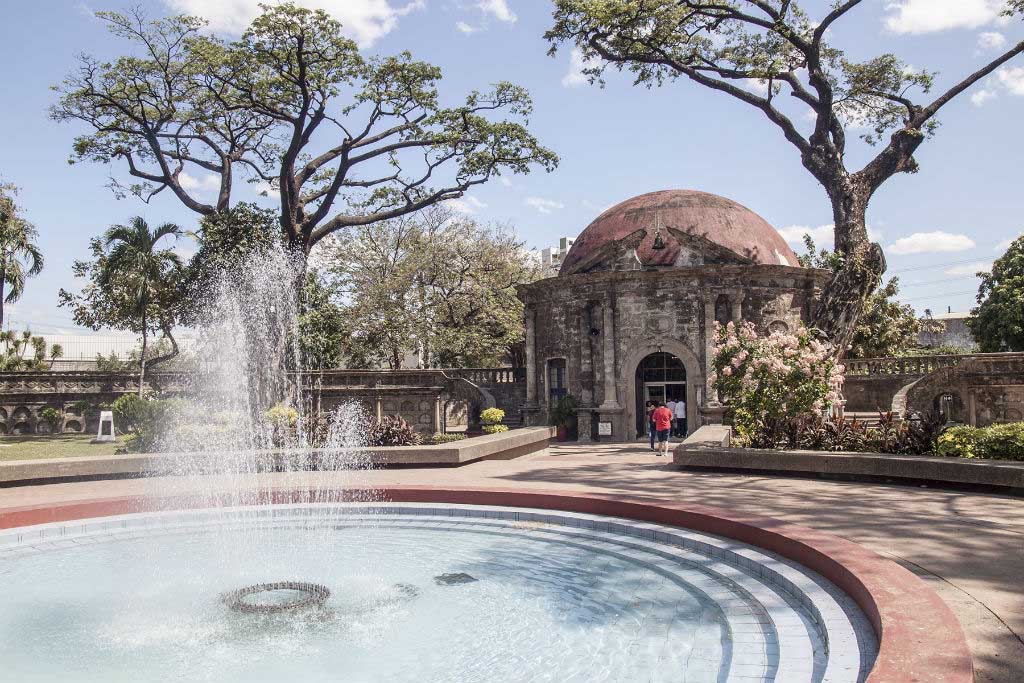
Paco was once a graveyard for rich family members during the Spanish times, and where national heroes Jose Rizal and Gomburza were buried before their remains were relocated to Bagumbayan (present-day Luneta Park). Designed in the late 17th century, the 4,000-square-meter recreation area features a garden and an open-air amphitheater that have set the level for many occasions—from past to present-day marriages, live shows, musicals, and displays. One of its shows where people love to watch is called Filipino eskrima (stick martial arts) where experts develop their conventional battling skills.
Fort Santiago
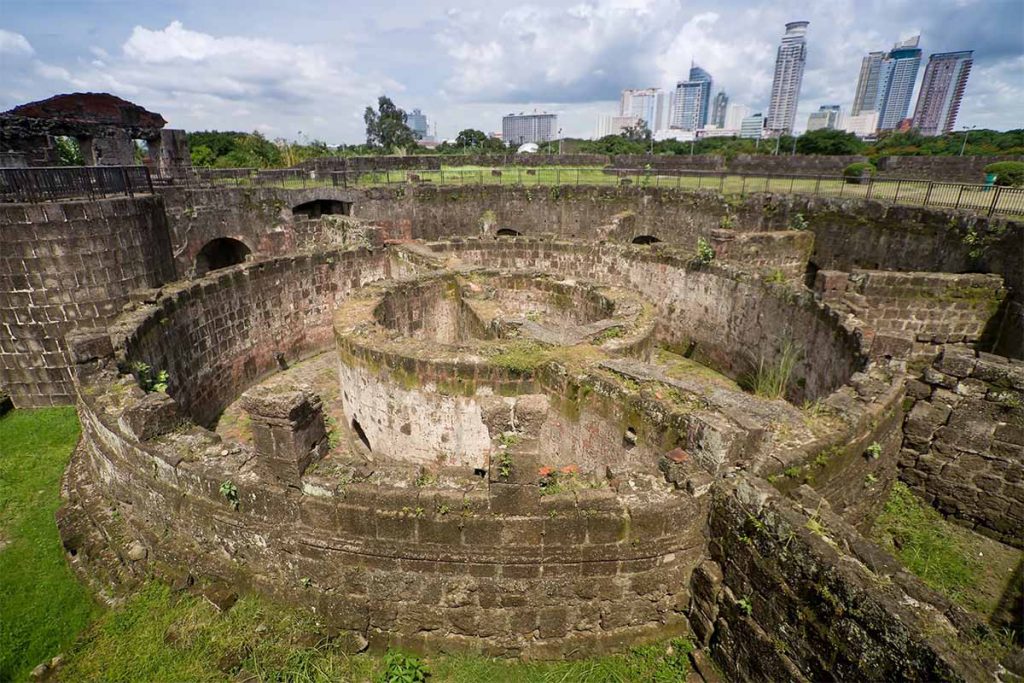
Built in 1571 for Spanish conquistador Miguel Lopez de Legazpi, Fort Santiago or Fuerza de Santiago is the oldest Spanish fortress in the Philippines and one of the major attractions inside Intramuros in Manila. These days, among the Fort’s most well-preserved destinations, are the Japanese-era M4 Sherman container, WWII artillery and subterranean channels used by the Japanese, the former Spanish dungeon of Plaza de Armas, and Rizal Shrine which was the prison cell of the Philippines’ national hero Dr. Jose Rizal. The final footsteps of Rizal before he was executed are signified on the fort’s floor. A museum is also present depicting the brave life and last poetry (Mi Ultimo Adios) of Rizal.
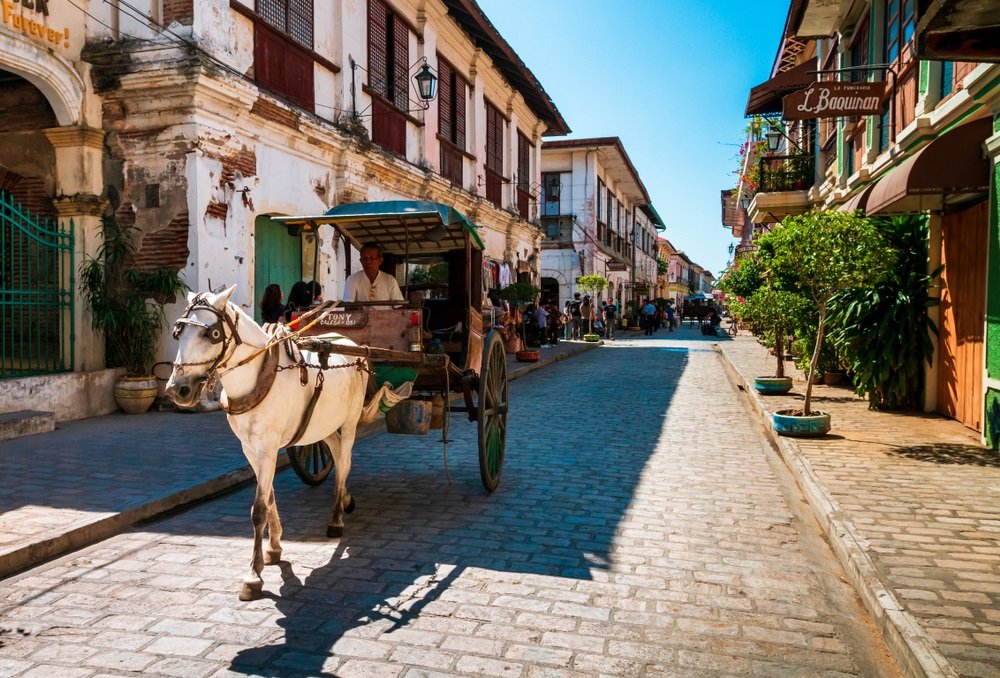
One of the Philippines’ most wonderful places, Vigan features the Spanish record of the nation. This town is in the northern part of the Philippines and its heritage village was known and listed since December 2, 1999, in the UNESCO world heritage list for its unique Spanish colonial history where Spanish monumental buildings built in the 18th century are well preserved up to this day.
Rizal Shrine
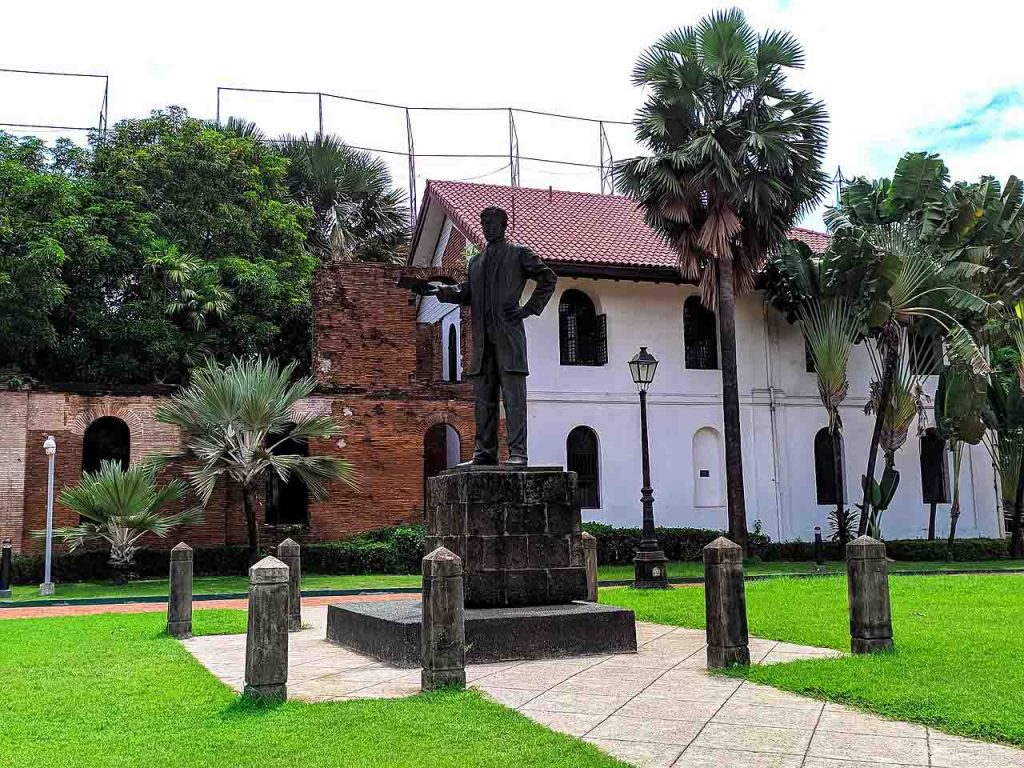
A complex building located on Santa Clara Street, Fort Santiago, Intramuros, Manila. This shrine is dedicated to Dr. Jose Rizal, all his works, collections, memorabilia, and books. This is where he spent his last night before he was executed and where his family found his last famous poem disguised in an oil lamp entitled Mi Ultimo Adios or My Last Farewell. There is also a Rizal Shrine in other places like Dapitan and Laguna.
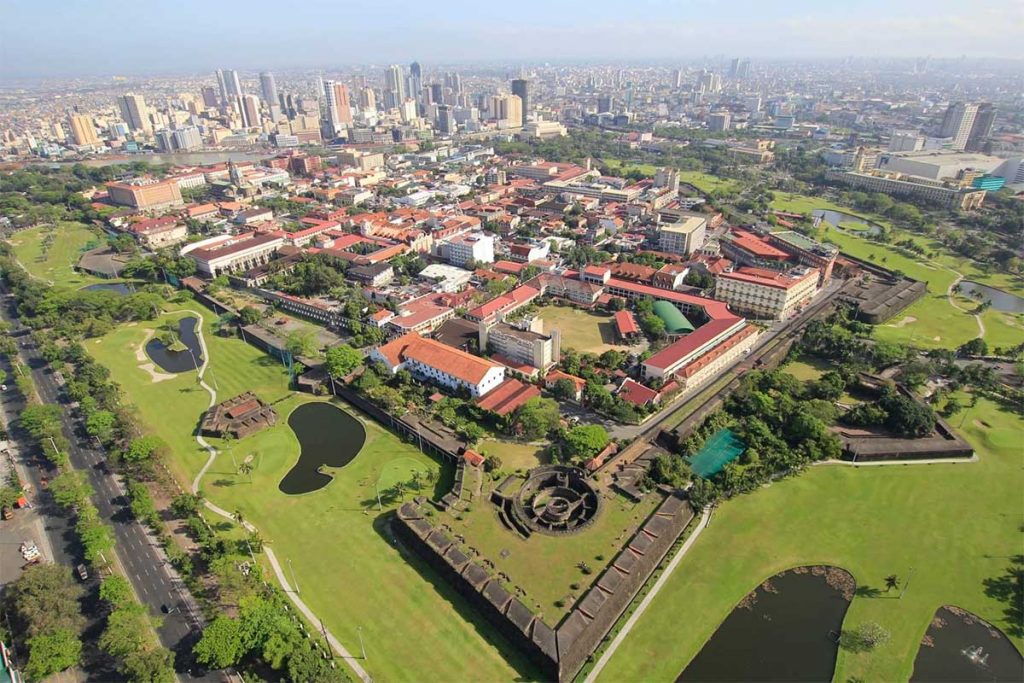
One of the oldest districts and most historical spots in Manila, the name Intramuros came from a Latin word – meaning “within the walls ”. This was also known as Ciudad Murada or “walled city” for its most popular feature: a nearly three-mile-long routine of large rock surfaces and fortifications that almost absolutely encompasses the whole region. You can ride a Kalesa (horse with a cart) to tour the place or take a walk and find Fort Santiago, Rizal’s Shrine, San Agustin Chapel and art gallery, Manila Chapel, many little plazas and contemporary dining places, most of which a combination in the nearby structures.
Malacanang Palace
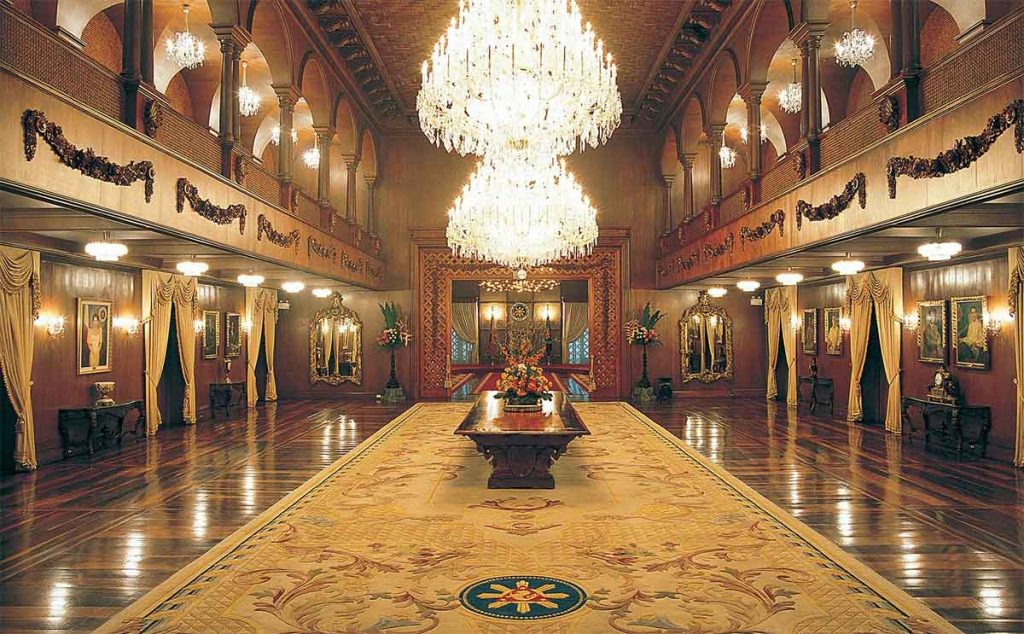
A Spanish Colonial Style house built in 1750 and located at 1000 José P. Laurel Street, San Miguel, Manila. This served as the residence of the Philippine Presidents. To mention a few of what to see in Malacanang Palace are its halls such as Entrance Hall, Heroes Hall, Reception Hall, its grand staircase, museum and library, garden and the Malacanang Park and Bahay Pangarap which was designed as a retreat house. The main features are three buildings used for formal entertainment for government officials, community assemblies, and a rest house across the Pasig River for casual and social activities of the President and the First Family.
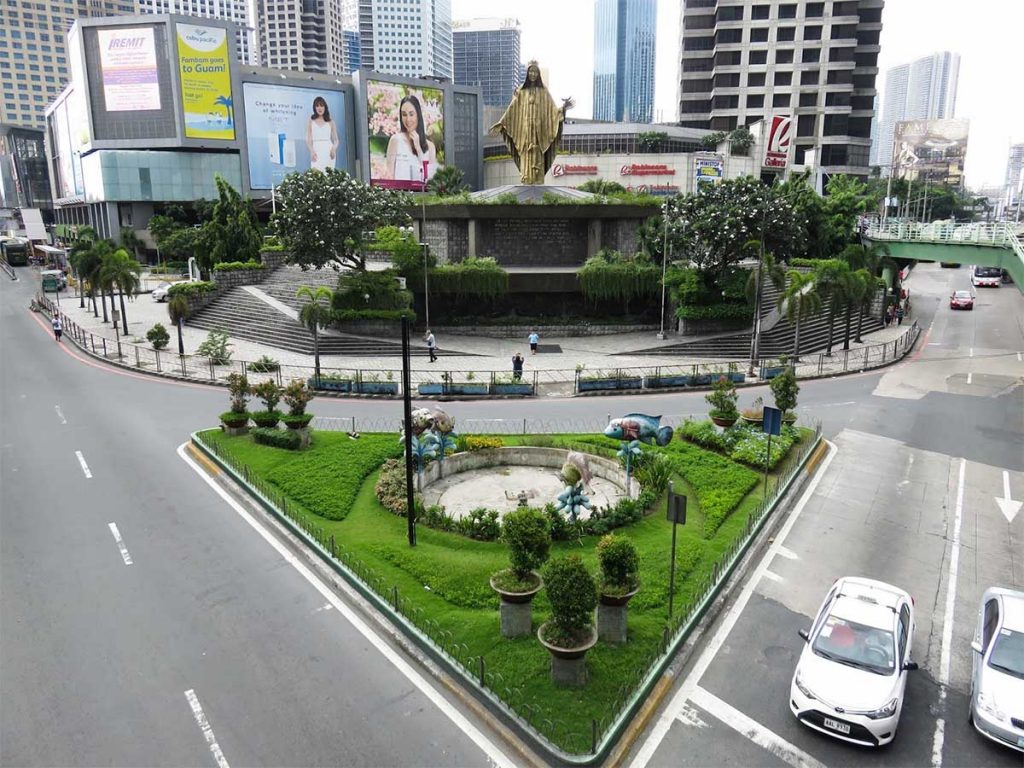
Formally known as the Shrine of Mary, Queen of Peace (Our Lady of EDSA), is located at the crossroads of Epifanio de los Santos (EDSA) Avenue and Ortigas Avenue in Quezon City. This was established on December 15, 1989, as a dedication to Mother Mary who believed to be a miraculous intercessor to end the dictatorship during President Marcos’ time in a peaceful manner which has been known as The People Power Revolution of 1986. This shrine is considered to be a holy ground as it witnessed another peaceful People Power in January 2001 that brought the Philippines moral leadership.
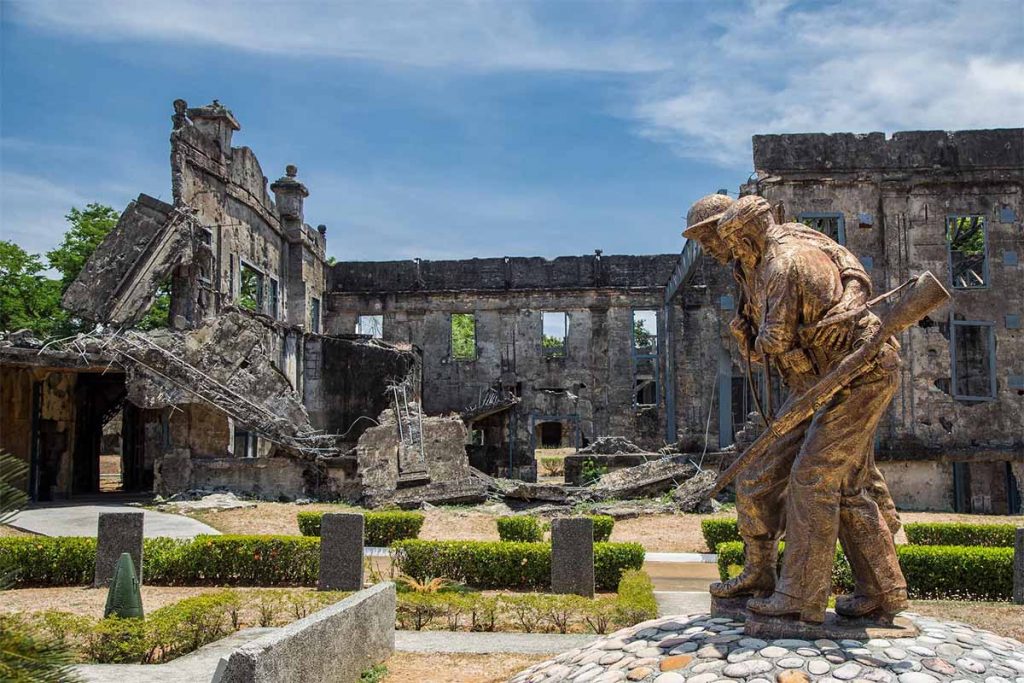
Also known as “the Rock” as it is a small rocky island located at the entrance of Manila Bay. Corregidor served as the headquarters of Allied forces of Filipino and American soldiers who fought against the invading Japanese forces during World War II. Still standing on this island are the big guns which have been the weapons of the great defenders who gave their lives for freedom and justice; ruins of buildings and structures that had protected so many lives; a museum for the different memorabilia and remains of the people who had stayed there especially the former President Manuel L. Quezon; a Pacific War Memorial and the Malinta Tunnel which is a bombed proof where command and communications took place and served as a hospital with 1,000-bed capacity, as well as food and supplies storage. A replica of Corregidor’s jeepney during the Spanish era called “tramvias” is the transportation used for the island tour.
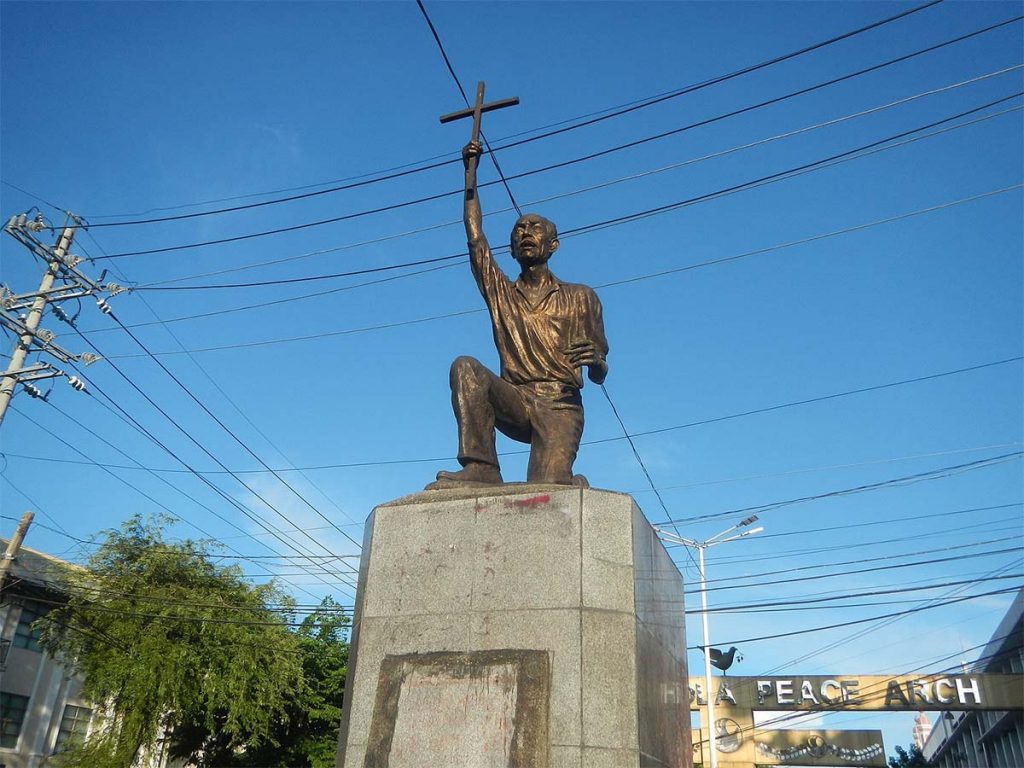
A street in the district of San Miguel, Metro Manila named after Enrique Mendiola, an educator and author. This street is considered to be one of the Philippines’ historical sites as this has always been a part of the many events in Philippine history like the “Battle of Malacanang or Battle of Mendiola Bridge” on January 30, 1970, a protest rally on January 22, 1987, and a protest for former President Joseph Estrada’s arrest on May 1, 2001.
Zapote Bridge
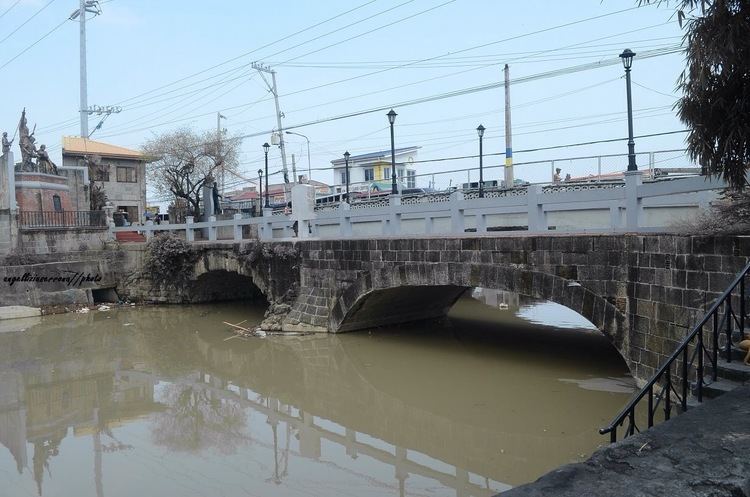
A bridge that connects the Zapote river of Las Pinas City and Bacoor, Cavite, Zapote Bridge played an important role in Philippine history because of the Battle of Zapote Bridge on February 16, 1897, the second largest battle of the Filipino-American War that took place in this site. Monument parks were established on both ends of the bridge These are but just 10 historical places among the rich history the Philippines has. So before one forgets from where he or she came from, sit back, relax, and discover the riches of history that brought us to enjoy the beauty of the Philippine country.
LIKE this article? Post your COMMENT and SHARE it!
About Behold Philippines
You might also like.
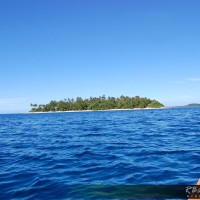
Potipot Island in Candelaria, Zambales
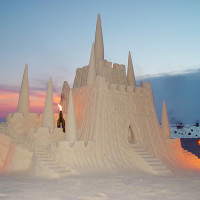
Great Things to Do at White Beach in Boracay
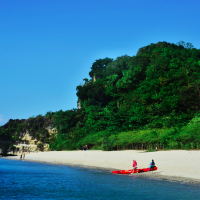
Mindoro and Mother Nature
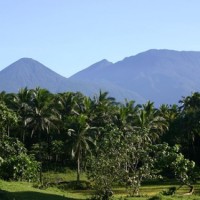
The Province of Quezon: What’s In Store for Travelers?
32 Things to do in The Philippines + Tourist Spots

After visiting 69 of 82 provinces in the Philippines, I’ve had countless beautiful experiences in this archipelagic country of over 7,600 islands. If you’re looking for places to add to your Philippines Itinerary, then this guide is for you!
Let’s start with a list of top destinations that are both easy to reach and exceptionally beautiful. If you’re traveling to the Philippines for the first time, these are the highlights you don’t want to miss. You fit all these places into a two-week itinerary.
Next, I’m going to share the stand-outs. They may not be as easy to get to, but I highly recommend visiting if you’re adventurous and want to see places that truly stand out.
Lastly, I’ve included a long list of popular and interesting destinations in the Philippines so you can enjoy a virtual tour of what my home country has to offer. Consider visiting if you have an extended trip planned in the Philippines or if you’re a fellow Pinoy looking for places to go on your next holiday.”
The Philippines Tourist Spots
What to do & where to go in The Philippines? I got you! Here are places to visit, interesting attractions & things to do in The Philippines for your bucketlist/itinerary.
5. Boracay Island & Aklan
6. balabac islands, 7. batanes islands, 9. banaue, ifugao, 14. puerto princesa, 15. iloilo & guimaras, 16. clark & pampanga, 18. cagayan de oro & beyond, 19. dumaguete & negros oriental, 20. legazpi, bicol & mayon volcano, 21. tacloban, leyte, 22. baguio & benguet, 23. subic bay, 24. tagaytay & taal volcano, 25. lake sebu, 26. laoag & ilocos norte, 27. siquijor, 28. port barton & san vicente, 29. caramoan, 30. calaguas, 31. biri islands, samar, 32. enchanted river & surigao del sur.
Note: Destinations featured above are not listed by rank.

View more travel tips in: Singapore , ALL Destinations .
Find this guide helpful? Share the love & follow Detourista for travel inspo on: Instagram , Facebook , Tiktok , Pinterest .
Top Spots For First-Timers

Cloud 9 Boardwalk sunset in General Luna, Siargao Island, Surigao del Norte, Philippines
Siargao made its first claim to fame as the Philippines’ surfing capital, and recently as the “Best Island in the World” (awarded by Condé Nast readers for 2018).This paradise has been on my favorites list ever since my first trip to the island a decade ago. What impressed me the most were the enchanting lagoons of Sohoton Cove, a natural wonder that’s well worth the 2-hour detour from the Cloud 9 surfing beach. The main island is filled with pristine natural spots as well, including white sand beaches, stunning islets, vast coconut forests, cool tidal pools & more.If you want to enjoy a laidback island lifestyle, Siargao is one of the best places that tourists can go to. You’ll find a mix of “foreign” and “local” here. It is remote yet accessible, and not too crowded despite the coming of new developments in recent years.
Location — Surigao del Norte province, Caraga Region, Northeast Mindanao. Save on Google Maps .
How to go — Located along the eastern coast of the Philippines (facing the Pacific Ocean), Siargao is best reached by air. Fly direct to Sayak Airport (IAO) in Siargao Island from Manila, Cebu, or Clark. Flight duration is 2 hours from Manila or 1 hour from Cebu. From the airport, the land trip to Cloud 9 beach, the main tourist area, takes around 45 minutes. You can also reach Siargao by taking a flight to Surigao Airport (SUG), found in mainland Mindanao. Then, hop on a 1.5-hour fastcraft ferry to Dapa Port in Siargao Island.
Siargao Travel Essentials
Where to stay Tours + discounts Check Fares
Top discounts
Sohoton Cove & Siargao Island Hopping Day Trip
Siargao Land Tour (Daily) – Sugba Lagoon, Magpupungko, Maasin River
Siargao Surfing Lessons

Marcos at Magpupungko Rock Formation in Siargao Island, Surigao del Norte, Philippines Magpupungko Rock Formation, Siargao Island

Cloud 9 surfing in General Luna, Siargao Island, Surigao del Norte, Philippines Cloud 9 surfing, Siargao Island

Cloud 9 Beach in General Luna, Siargao Island, Surigao del Norte, Philippines Cloud 9 beach, Siargao Island

Sohoton Lagoons in Bucas Grade Island, Surigao del Norte, Philippines Sohoton Lagoons near Siargao Island

Cloud 9 Boardwalk surfers in General Luna, Siargao Island, Surigao del Norte, Philippines Cloud 9 Boardwalk, Siargao Island
See more : Siargao travel tips

Matinloc Island in El Nido, Palawan, Philippines
You came to the country to see spectacular beaches and island views. El Nido in Palawan province will not disappoint. In terms of spectacular “over-the-water” sea views, El Nido is my favorite in the Philippines. Imagine hidden lagoons, uninhabited white sand beaches, and massive forest-covered limestone mountains rising out of pristine tropical waters. The “SEAnery” here rivals popular destinations in Asia like Phi Phi/Krabi Islands (Thailand) and Ha Long Bay (Vietnam).The experience of spending a whole day out on the islands is nothing short of incredible. The area of Bacuit Bay is spread over a large area, so spend at least two full days for the island hopping tours (Tour A & Tour C are the best).
Location — Northern Palawan province, MIMAROPA Region (West Central Philippines). Save on Google Maps .
How to go — Most travelers arrive in El Nido on a 1.5-hour flight from Manila to Puerto Princesa Airport (PPS), followed by a 5 to 6-hour shuttle ride to El Nido town proper. If you want to skip the long land journey, fly directly to El Nido from Manila (1 hour), Cebu or Boracay-Caticlan. This is the fastest but more expensive way.
El Nido Travel Essentials
El Nido Tour A – Lagoons and Beaches Island Hopping
El Nido Tour C – Hidden Beaches and Shrines Island Hopping
Puerto Princesa – El Nido Shuttle Transfers

Secret Lagoon Beach in Miniloc Island, El Nido, Palawan, Philippines Secret Lagoon Beach in El Nido, Palawan

Calitang Beach, at Nacpan-Calitang Twin Beaches, in El Nido, Palawan, Philippines Calitang Beach, El Nido

Overlooking Bacuit Bay Islands of El Nido from Taraw Peak, in Palawan, Philippines Overlooking El Nido from Taraw Peak

Umbrella Beach in Miniloc Island, El Nido, Palawan, Philippines Umbrella Beach in Miniloc Island, El Nido
See more : El Nido travel tips

Pro-tip: To make your trip planning easier, I’ve added links to the pin locations on Google Maps. Use the ‘save’ feature on the app to see all your saved locations on one map, visualize your itinerary, and know the best areas to stay near the places you want to go.
Philippines Travel Essentials
Before we go with the rest of the list, here are travel essentials you might need for a hassle-free trip. Click below to see discounts & read traveler reviews.
Where to stay in The Philippines:
Book here Compare rates
Recommended The Philippines Hotels:
Money-saving tip : Use promo code “ KLOOKDETOURISTA ” to grab 5% OFF hotels and 3% OFF tours/activities next time you book on Klook.
Popular tours & discounts booked by other travelers:
Island Hopping in Boracay
Siargao Island Hopping (Daily) – Daku Island, Guyam Island, & Naked Island Day Tour
Cebu Ocean Park Ticket
Enchanted Kingdom Admission Ticket
Tours + discounts Flights Airport transfers WIFI Internet/Data SIM

Kayangan Lake in Coron, Palawan, Philippines. Photo by David Köhler .
In contrast to El Nido’s amazing “over water” views, go to Coron for spectacular underwater views. Here, you can see colorful coral gardens, pristine waters, lots of marine life, and even sunken WWII Japanese shipwrecks. Don’t get me wrong, Coron can hold its own when it comes to scenic views over the water as well. This paradise is home to hidden emerald/blue lagoons surrounded by limestone cliffs. There’s no shortage of incredibly beautiful fine white sand beaches in Coron either.
How to go — Coron Airport is located on the north side of Busuanga Island. Travel time by plane is around 1 hour from Manila. For adventurous travelers who want to maximize their trip in Palawan, you can travel by ferry between Coron and El Nido (mainland Palawan). Travel time is around 4 hours by fastcraft (high-speed ferry).
Coron Travel Essentials
Coron Super Ultimate Day Tour
Coron-Busuanga Airport Shuttle – Shared and Private Transfers
Coron Ultimate Tour
See more : Coron travel tips

Marcos at Osmeña Peak in Dalaguete, Cebu
Cebu is the country’s #1 most visited tourist destination, and for good reason. It is unrivaled in offering the widest range of things to do and attractions. Cebu is like the “Jack of all trades” among tourist spots in the Philippines.You can enjoy scenic natural sites (waterfalls, beaches, mountain views etc.), have exciting wildlife encounters, join a colonial heritage tour, shop at some of the World’s largest malls, or indulge yourself in local food including the prized Cebu Lechon! You can do all of these easily while staying at a luxury resort in Mactan Island, centrally located hotel/airbnb in the city, or a peaceful beachfront resort in the countryside. Your choice!If that’s not enough, you can easily hop to nearby islands like Bohol, Negros (Dumaguete) or other major cities. Take full advantage of Cebu’s strategic location in Central Philippines and well-connected flight/ferry network.
Location — Central Visayas (Central Philippines). Save on Google Maps .
How to go — Cebu-Mactan International Airport in Mactan Island serves direct flights from all major cities in the Philippines as well as international flights from Asia and North America. Flight duration is 1h30m from Manila, 3h 40m from Singapore and 2h50m from Hong Kong. From the airport, the ride to Cebu City center usually takes 30 minutes to 1 hour (or more, depending on traffic conditions).
Cebu Travel Essentials
Cebu-Tagbilaran, Bohol OceanJet Ferry Ticket
Cebu Airport Private Transfers – for Cebu City, Mactan & more
Bohol Day Tour from Cebu

Shangri-la Mactan Resort in Lapu-Lapu City, Cebu, Philippines Shangri-la Mactan Resort, Cebu

The Heritage of Cebu Monument in Cebu City, Philippines The Heritage of Cebu Monument

Canyoneering near Kawasan Falls, Badian, Cebu, Philippines Kawasan-Badian Canyoneering in Cebu

Santiago Bay Beach in Camotes Islands, Cebu, Philippines Camotes Islands, Cebu, Philippines

Sirao Flower Garden in Cebu City, Philippines Sirao Flower Garden, Cebu City
See more : Cebu travel tips

Marcos at White Beach, in Boracay, Malay, Aklan, Philippines
Boracay is a vacationer’s paradise. Taking center stage is 4-kilometer White Beach, prized for its incredibly inviting blue waters, fine white sand, and perfect sunsets. This island is the place to go if you want to take it easy and you’re looking forward to enjoying a tropical resort experience. As you can expect, Boracay caters to a more upscale crowd, but don’t fret, there are many budget-friendly options available.Boracay is small but packs a lot of attractions. Here you can find excellent dining, a wide variety of places to stay, souvenir shopping, and lots of fun water activities, and some nightlife all in one sandy stretch.Boracay’s White Beach is a class of its own when it comes to how fine and white the sand is. From my extensive travels in the country, there’s only one lengthy beach that has sand whiter and finer than White Beach. You can find it in the group of islands featured next on this list.
Location — Aklan province, Western Visayas region (Central Philippines). Save on Google Maps .
How to go — Touchdown at either Boracay-Caticlan Airport (MPH) or Kalibo International Airport (KLO). From Caticlan, the ferry to Boracay only takes less than 20 minutes. Most travelers transit via Kalibo because the airport serves more airlines/flights/destinations and airfares are usually lower. The land trip from Kalibo to Caticlan tales around 1 hour.
Boracay Travel Essentials
Sunset Paraw Sailing in Boracay
Caticlan Airport-Boracay Hotel Shared Transfers – Shuttle+Ferry Ticket

Sunset at White Beach, in Boracay, Malay, Aklan, Philippines Sunset view from Boracay Island

White Beach in Boracay, Malay, Aklan, Philippines White Beach, Boracay

View from Mt. Luho facing White Beach, in Boracay Island, Malay, Aklan, Philippines Mt. Luho view

Kite surfing at Bulabog Beach, in Boracay Island, Malay, Aklan, Philippines Boracay kite surfing

Ati-atihan Festival warriors in Kalibo, Aklan, Philippines Kalibo Ati-atihan Festival in Aklan
See more : Boracay Island & Aklan travel tips

The Standouts
These places take more time to visit but are well worth the journey if you’re up for an adventure.

Onuk Island – Roughton Island in Balabac, Palawan, Philippines
If you’re looking for the best beaches & most vibrant waters in the Philippines, look nowhere else. Balabac is worth a spot at the VERY TOP of your bucketlist.Balabac is the southernmost group of islands in Palawan. It is so far south that Sabah, in East Malaysia is nearer to Balabac than Puerto Princesa, the provincial capital of Palawan.The main draw here are 31 gorgeous islands still vastly undiscovered by tourist crowds. These islands are surrounded by pristine, crystal clear waters and white sand beaches. Yes, the sandy shores of many beaches here are a blinding white to off-white, many even have a blushed pink hue! The best spots you shouldn’t miss in Balabac are (1) Onuk Island & its crystal blue waters sprawling as far as the eye can see; (2) Bugsuk Island, home to the most powdery, whitest sand beach in the Philippines; and (3) the pink sand beach at Camiaran Island.
Location — Southern Palawan province, MIMAROPA Region (West Central Philippines)
How to go — The most convenient jump-off point to the Balabac Islands is Buliluyan Port, located at the southernmost tip of mainland Palawan. From Puerto Princesa Airport (the nearest commercial airport), the land trip to Buliluyan Port takes around 5-6 hours. For a hassle-free trip, arrange your Balabac tour well ahead (before your trip) with a local tour operator. See the list and detailed travel tips at the Balabac Travel Guide .

Punta Sebaring Beach in Bugsuk Island, Balabac, Palawan, Philippines Punta Sebaring Beach, Bugsuk Island, Balabac

Camiaran “Pink” Island, in Balabac, Palawan, Philippines Camiaran “Pink” Island, Balabac

Nasubata Reef – Pulau Bato in Balabac, Palawan, Philippines Nasubata Reef – Pulau Bato

Sicsican Island in Balabac, Palawan, Philippines Sicsican Island

Canabungan Island in Balabac, Palawan, Philippines Canabungan Island
Balabac is remote and not easy to reach, which is why I don’t readily recommend the place to first-timers. You must really want to visit this place. It takes time to visit and you’ll have to let go of touristic conveniences.

Batanes, Philippines. Photo by Rexy Quieta .
Previously, many readers have asked me why I did not include Batanes as one of the best places to go in the Philippines. The answer is simple: I haven’t been there yet. It’s still on my bucketlist! But due to popular demand, I am including Batanes now. So, comment below if you have a place in mind that you think should be included! I might have to add it to my bucketlist too.Batanes is the northernmost province of the Philippines. These remote islands are shaped by volcanic forces and strong typhoons. The natural landscape of Batanes is distinct from other parts of the Philippines. Here, you’ll find vibrant green rolling hills, grazing cows, steep seaside cliffs, sparkling clear blue waters, traditional stone houses, and iconic lighthouses.Travelers often describe its Batanes’ beauty as wild, overwhelming, and incredibly scenic. Looking at pictures and vlogs, I can see why it’s a popular choice among adventure seekers.
Location — Cagayan Valley region (Northern Philippines). Save on Google Maps .
How to go — Touchdown at Basco Airport, located on Batan, the main island of Batanes. Travel time by plane is 2 hours from Manila or 1h40m from Clark. Airlines that fly to Batanes include Philippine Airlines and Skyjet. Flights to Batanes are a lot more expensive compared to other destinations in the Philippines. Expect regular roundtrip fares to cost upwards of P10,000.
Batanes Travel Essentials
Where to stay Check Fares
Batanes-Basco Airport Shuttle – BSO Private Transfers
3 Day North Batan, South Batan, and Sabtang Island Tour
2 Day North Batan and South Batan Tour

Pongas Falls in Sagada, Mountain Province, Philippines
The Philippines isn’t just all about postcard-perfect beaches. It has cool highland destinations too! If you want to be close to nature and the Philippines’ mountain culture, venture north of Manila and visit Sagada. You can find this small town high in the mist-covered Cordillera (mountain range) of Northern Luzon.Surrounded by spectacular mountain views, Sagada is most-known for the bizarre hanging coffins, a burial tradition that has survived for over 2,000 years. When in town, don’t miss the cave connection tour (Sumaging-Lumiang Cave), sunrise view from above a sea of clouds at Kiltepan Peak, the local coffee (best in PH) & hike to the many waterfalls in the area including Bomod-ok Falls and Pongas Falls.
Location — Sagada, Mountain Province, Cordillera region, Luzon (Northern Philippines). Save on Google Maps .
How to go — The bus trip to Sagada from Manila takes around 12 hours. Buses usually depart at 9pm (onwards) from Cubao, Quezon City. You can also catch a bus to Sagada from Baguio. Travel time from Baguio to Sagada is 5-6 hours by bus.
Sagada Travel Essentials

Sumaguing Cave, in Sagada, Mountain Province, Philippines Marcos at Sumaguing Cave, Sagada

Hanging coffins at Echo Valley, Sagada, Mountain Province, Philippines Sagada hanging coffins, Mountain Province

Kapay-aw Rice Terraces in Sagada, Mountain Province, Philippines Kapay-aw Rice Terraces, Sagada

Bomod-ok Falls and Aguinid Rice Terraces, in Sagada, Mountain Province, Philippines 041 Bomod-ok Falls and Aguinid Rice Terraces, in Sagada-150211-082531
See more : Sagada travel tips

Banaue Rice Terraces in Banaue, Ifugao, Philippines
Banaue is home to the famous Banaue Rice Terraces, another must-see attraction in the Cordillera region. Hand-carved by the Ifugao people some 2,000 years ago, these extraordinary rice paddies are terraced like staircases for giants and follows the contours of entire mountainsides. Banaue is also the gateway to the Ifugao Rice Terraces, included in UNESCO’s list of World Heritage Sites.Have a memorable local experience by spending the night at a homestay in one of the small villages like Batad or Banga-an. Get immersed in the culture of the Ifugao people, wake-up to a view of the rice terraces with a hot cup of local coffee, and go on the breathtaking hike to Tappiya Waterfalls.
Location — Ifugao province, Cordillera Region. Save on Google Maps .
How to go — The bus journey to Banaue from Manila takes around 8-9 hours. Bus departures from Manila are in the late evening hours (8pm to 10pm). So, expect to arrive early morning. You can also reach Banaue easily from other destinations in the Cordillera region. The land journey to Banaue takes around 3 hours from Sagada and 6 hours from Baguio
Banaue Travel Essentials

Tappiya Falls near Batad Rice Terraces in Banaue, Ifugao, Philippines Tappiya Falls near Batad Rice Terraces

Igorot farmers at Kiangan Rice Terraces & Open Air Museum, in Kiangan, Ifugao, Philippines Igorot farmers at Kiangan Rice Terraces & Open Air Museum

Batad Rice Terraces near Banaue in Ifugao, Philippines Batad Rice Terraces near Banaue, Ifugao

Bangaan Rice Terraces in Banaue, Ifugao, Philippines Bangaan Rice Terraces near Banaue

Banaue Rice Terraces viewpoint, in Banaue, Ifugao, Philippines Banaue Rice Terraces, Ifugao
See more : Banaue, Ifugao travel tips

Calle Crisologo in Vigan, Ilocos Sur, Philippines
Vigan is the best-preserved Spanish-colonial town in Asia. If you’re a lover of old cities, this UNESCO World Heritage Site is a must-visit.You’ll feel like you’ve traveled back in time (to 16th-century Philippines) as you explore Vigan. This heritage city is filled with cobblestone paths, horse-drawn carriages, centuries-old churches, and buildings. Get the ultimate Vigan experience by booking your room at one of the old Spanish-colonial homes.
Location — Ilocos Norte province, Ilocos region, Luzon (Northern Philippines). Save on Google Maps .
How to go — The nearest airport to Vigan is Laoag Airport, which serves direct flights from Manila. This journey takes around 2 hours (1-hour flight duration PLUS 2-hour land trip). You can also reach Vigan by bus. The land trip takes around 8-9 hours from Manila.
Vigan Travel Essentials

Calle Crisologo in Vigan, Ilocos Sur, Philippines Calle Crisologo, Vigan

See more : Vigan travel tips

Marcos at Tinago Falls in Iligan City, Lanao del Norte, Philippines
Iligan the “City of Majestic Waterfalls” deserves a spot on your bucketlist if you’re a lover of waterfalls (like me). This city in Northern Mindanao is home to many of the Philippines’ most beautiful waterfalls . My favorites in Iligan include (1) Tinago Falls with its incredibly enchanting blue-green pool surrounded by the rainforest, (2) Maria Cristina Falls (massive twin waterfall), and the remote (3) Limunsudan Falls (the highest two-tiered waterfall in the Philippines).
Location — Lanao del Norte province, Northern Mindanao region (Southern Philippines). Save on Google Maps .
How to go — Touchdown at Cagayan de Oro-Laguindingan Airport (CGY), which serves direct flights from Manila, Cebu, Davao, Iloilo, Clark, and Dumaguete. Flight duration is 1h and 40m from Manila or 1h from Cebu. From Laguindingan Airport, the land trip to Iligan City takes around 1.5 hours.
Iligan Travel Essentials
Where to stay

Limunsudan Falls in Iligan City, Lanao del Norte, Philippines Limunsudan Falls, Iligan

Maria Cristina Falls in Iligan City, Lanao del Norte, Philippines Maria Cristina Falls, Iligan City
See more : Iligan travel tips

Popular & Easy To Visit
Sharing these major flight gateways and popular tourist destinations. All of these places have their own special set of bucketlist-worthy attractions. This just goes to show that you can find beautiful spots all over the Philippines and how incredibly difficult it is to select just a few, to make this list of best places to visit. The destinations mentioned below are not listed by rank.

Marcos at Fort Santiago, in Intramuros, Manila City, Metro Manila, Philippines
Manila offers many attractions for travelers. Historic Intramuros is a good place to start. This walled city is filled with Spanish-era architecture including the Manila Cathedral, Fort Santiago, and San Agustin Church (a UNESCO World Heritage Site). Meanwhile, Makati and Bonifacio Global City (BGC) are the best places to go to experience the nightlife, hip food scene, and the modern side of the city. Beat the tropical heat & shop at Manila’s massive malls. Metro Manila is home to many of the World’s largest malls including the ever-expanding Mall of Asia. Looking for a place to go near the airport? Visit the entertainment districts such as Newport City, City of Dreams, Solaire Resort, and Okada Manila.
Location — Metro Manila capital region, Luzon (Northern Philippines). Save on Google Maps .
How to go — Manila’s Ninoy Aquino International Airport (NAIA) is the main international gateway and domestic flight hub of the Philippines. The Manila-NAIA Airport is located in the cities of Pasay and Paranaque (among the 16 cities that comprise the Metro Manila area). Manila does not have a very good public transport system. For safe and easy rides around the metro, use a ride-hailing app like Grab.
Manila Travel Essentials
Manila-Luzon Shuttle – Tagaytay, Baguio, Laguna, La Union & more
Manila Ocean Park Attraction Pass

National Museum of Natural History in Manila City, Philippines National Museum of Natural History, Manila

Intramuros Walled City in Manila City, Metro Manila, Philippines Intramuros Walled City, Manila

San Sebastian Cathedral interiors, in Metro Manila, Philippines San Sebastian Cathedral

Dusk view of Makati's skyline, from Top of the Citi by Chef jessie (rooftop bar), in Makati City, Metro Manila, Philippines Makati Skyline at Dusk

Bonifacio High Street in Bonifacio Global City, Taguig, Metro Manila, Philippines Bonifacio High Street
See more : Manila travel tips

Chocolate Hills sunrise view in Carmen, Bohol, Philippines
Bohol is home to two of the Philippines’ most iconic attractions, often shown on tourism ads: The Chocolate Hills, and the bug-eyed Tarsier, one of the World’s smallest primates. This island in Central Philippines (near Cebu) offers so much more.In Panglao, you can stay at a nice hotel at one of the island’s many white-sand beach areas, go island hopping, enjoy diving, join an island hopping tour, and possibly have a dolphin encounter. If that’s not enough, you can enjoy a relaxing cruise along the pristine Loboc River, see the old Spanish-colonial heritage churches, Can-umantad waterfalls, Cadapdapan Rice Terraces, and remote Anda White Beach.If you plan to visit Cebu, then Bohol should be on your bucketlist too as you can easily see most of Bohol’s major tourist spots on a one-day tour from Cebu City.
How to go — Touchdown at Bohol-Panglao International Airport (TAG), which serves direct flights from Manila, Clark, Davao and Cagayan de Oro. Travel time from Manila to Bohol is 1 hour by plane. You can also go by ferry from Cebu. Travel time from Cebu to Bohol is around 2 hours by fastcraft ferry.
Bohol Travel Essentials
Bohol Countryside Tour w/ Buffet Lunch
Bohol Private Car Charter
Cebu-Bohol Supercat Ferry Ticket (One Way or Round Trip)

Dumaluan Beach in Bolod, Panglao Island, Philippines Dumaluan Beach in Panglao, Bohol

Loboc River Cruise in Bohol, Philippines. Photo by Michelle Simtoco Loboc River Cruise, Bohol

Doljo Beach in Panglao Island, Bohol, Philippines Doljo Beach, Panglao Island

Can-Umantad Falls in Candijay, Bohol, Philippines Can-Umantad Falls, Bohol

Baclayon Church, Bohol
See more : Bohol travel tips

Puerto Princesa Underground River in Palawan, Philippines
Puerto Princesa is the capital and major flight gateway in Palawan. If you’re visiting El Nido, then Puerto Princesa, “The City in the Forest,” is worth a stopover. Start with a trip to Puerto Princesa Underground River, the 2nd longest navigable underground river in the world, listed as a World Heritage Site by UNESCO and New7Wonders of Nature. Then, spend a day beach bumming and snorkeling on an island hopping tour around Honda Bay. Don’t leave without going on the city tour and feasting on fresh seafood.
Location — Central Palawan province, MIMAROPA Region (West Central Philippines). Save on Google Maps .
How to go — Puerto Princesa is 1.5 hours southwest of Manila by plane. Princesa International Airport serves direct flights from Manila, Cebu, Iloilo, Clark, and Davao. You can also go by ferry from Manila or Iloilo (on the RORO ferry-bus).
Puerto Princesa Travel Essentials
Puerto Princesa Underground River Day Tour w/ Buffet Lunch
Honda Bay Island Hopping Tour

Sabang Beach near Puerto Princesa Underground River, Palawan, Philippines Sabang Beach near Puerto Princesa Underground River

Starfish Island in Honda Bay, Puerto Princesa, Palawan, Philippines Starfish Island in Honda Bay, Puerto Princesa

The Baywalk in Puerto Princesa City, Palawan, Philippines The Baywalk in Puerto Princesa

Kinabuch's Seafood dinner, in Puerto Princesa City, Palawan, Philipines Kinabuch's, Puerto Princesa City
See more : Puerto Princesa travel tips

Journey to Heaven, at Garin Pilgrimage Resort in San Joaquin, Iloilo
This is my home, Iloilo! Located at the country’s geographical center, Iloilo is also known as the “Heart of the Philippines.” It is famous for its well-preserved heritage sites, distinct native cuisine, cheap seafood, and pristine natural sites.Bustling yet relaxed Iloilo City is one of the most livable cities in the country. A highly urbanized city that’s keen on preserving its cultural and natural heritage. Within an hour’s travel from the city center, you can find yourself along a peaceful beach in Guimaras Island, home to the World’s sweetest mangoes. Head to the islands of Gigantes, Sicogon, and Concepcion to see the stunning seascapes of Northern Iloilo. A drive to the south takes you to centuries-old Spanish-colonial churches including the Miagao Church, a UNESCO World Heritage Site. From Iloilo, you can also go on a land trip to other provinces in Panay Island — Antique, Capiz (Roxas City), and Aklan (Boracay).
Location — Western Visayas region (Central Philippines). Save on Google Maps .
How to go — Touchdown at Iloilo Airport, which serves direct flights from/to major airports in the Philippines, as well as Hong Kong and Singapore. Travel time to Iloilo by plane is 1h15m from Manila and 50m from Cebu. The airport also serves direct flights from/to Davao, Clark, Puerto Princesa, Cagayan de Oro and General Santos.
Iloilo Travel Essentials
Bacolod-Iloilo OceanJet Ferry Ticket
Iloilo Airport-Iloilo City Hotel Shuttle – ILO Private and Shared Transfers
Gigantes Islands Day Tour from Iloilo City

Calle Real in Iloilo City, Philippines Calle Real in Iloilo City

Tangke Lagoon in Gigantes Sur Island, Carles, Iloilo, Philippines Tangke Lagoon, Gigantes, Iloilo

Tatlong Pulo Beach in Jordan, Guimaras, Philippines Tatlong Pulo, Guimaras

Miagao Church in Miagao, Iloilo, Philippines Miagao Church, Iloilo

Balvan View in Tubungan, Iloilo, Philippines Balvan View, Tubungan, Iloilo
See more : Iloilo & Guimaras travel tips

Puning Hot Springs in Sapang Bato, Angeles City, Pampanga, Philippines
Located within a 2-3 hour drive north of Manila, Clark Airport is a major flight hub and alternative international gateway to the Philippines. Clark is a rapidly developing tourist destination and economic zone. It’s home to Aqua Planet Waterpark, PH’s largest waterpark, and other themed attractions such as Dinosaur Island. From Clark, you can enjoy a heritage tour of nearby Angeles City and sample the famous food of Pampanga, the Culinary Capital of the Philippines.Clark is also a popular jump-off point to explore the Central Luzon provinces of Zambales, Tarlac, Bataan, Bulacan, Nueva Ecija, and Aurora. The best things to do in this region include the (1) offroad adventure to Puning Hot Springs, (2) Mount Pinatubo summit crater trek, (3) Las Casas Filipinas De Acuzar heritage resort, (4) Zambales’ scenic beaches, (5) Subic Bay, and the (6) surfing town of Baler.
Location — Clark Freeport, Pampanga region, Luzon (Northern Philippines). Save on Google Maps .
How to go — Clark Airport serves both domestic and international flights. Because of its location near Manila, it often serves as an alternative to congested Manila-NAIA Airport. Travel time from Manila to Clark is around 2-3 hours. Clark Airport is located within Clark Freeport Zone, which occupies part of Angeles City, Pampanga. The drive between Clark Airport & Angeles City center takes around 20 minutes.
Clark Travel Essentials
Dinosaurs Island Clark Admission Ticket
Zoocobia Admission Ticket in Clark
Clark Safari and Adventure Park Ticket

Pampanga Sisig, at Mila's Tokwa't Baboy in Angeles City, Pampanga, Philippines Pampanga Sisig, at Mila's Tokwa't Baboy

Holy Rosary Parish Church in Angeles City, Pampanga, Philippines Holy Rosary Parish Church, Angeles City, Pampanga

Aqua Planet in Clark, Pampanga, Philippines Aqua Planet, Clark

Marcos at Mount Pinatubo crater lake in Central Luzon, Philippines Mount Pinatubo crater lake, Philippines
See more : Clark & Pampanga travel tips

Isla Reta beachfront in Talucud Island, Samal, Davao del Norte, Philippines
Considering a trip to Southern Philippines? Start with Davao City, the largest urban center in Mindanao. Located at the foot of Mount Apo, the PH’s tallest mountain, this sprawling metropolis is where you can meet the great Philippine Eagle, get a taste of the infamous Durian fruit, and enjoy day trips to refreshing natural sites like Eden Nature Park and Samal Island. Of course, it is also the gateway to beautiful spots in Davao region and Mindanao.Samal Island is easily reached by ferry from Davao City. Enjoy a luxury stay at Pearl Farm Beach Resort, famous for its waterfront stilt cottages, or wander to the peaceful beaches of Talikud Island.
Location — Davao region, Mindanao (Southern Philippines). Save on Google Maps .
How to go — Davao Airport is the busiest airport in Mindanao. Travel time by plane from Manila to Davao is 2 hours. From Davao Airport, it typically takes 30 minutes to get to Davao City center.
Davao Travel Essentials
Davao (DVO) Airport to Hotel/City Private Transfer
Davao 24hr COVID-19 RT-PCR and Rapid Antigen Testing
Davao COVID-19 Rapid Antigen Testing

Philippine Eagle Center, Davao City, Philippines Philippine Eagle Center, Davao

Eden Nature Park city view, in Davao City, Philippines Davao City view from Eden Nature Park

Jack's Ridge in Davao City, Philippines Jack's Ridge, Davao City

Monfort Bat Colony in Samal Island, Davao del Norte, Philippines Monfort Bat Colony, Samal Island
See more : Davao travel tips

Gardens of Malasag Eco-Tourism Village in Cagayan de Oro, Misamis Oriental, Philippines
Cagayan de Oro, the largest city in Northern Mindanao, is dubbed as the “Adventure Capital of the Philippines”. This city is famous for its white water river rafting, river tubing, paragliding, nature parks. Cagayan de Oro is also a convenient hub for tourists visiting the majestic waterfalls of Iligan, scenic sites of Camiguin Island, and cool attractions of Bukidnon province.
Location — Northern Mindanao region (Southern Philippines). Save on Google Maps .
How to go — Touchdown at Cagayan de Oro-Laguindingan Airport (CGY), which serves direct flights from Manila, Cebu, Davao, Iloilo, Clark, and Dumaguete. Flight duration is 1h and 40m from Manila or 1h from Cebu. From Laguindingan Airport, the land trip to Cagayan de Oro City takes around 1 hour.
Cagayan de Oro Travel Essentials
Seven Seas Waterpark Ticket in Cagayan de Oro
Dahilayan Adventure Park Admission Ticket
Philippines Unlimited Data eSIM (QR Email Delivery)

High Ridge in Cagayan de Oro, Misamis Oriental, Philippines High Ridge, Cagayan de Oro

Dahilayan Adventure Park in Bukidnon, Philippines Dahilayan Adventure Park, Bukidnon

White Island in Camiguin, Philippines White Island, Camiguin
See more : Cagayan de Oro & beyond travel tips

Swimming with sea turtles at Apo Island, in Dauin, Oriental Negros, Philippines
Extremely chill Dumaguete is the jump-off point to Apo Island. If swimming with sea turtles is on your bucketlist, one of the best places to go is Apo Island, a protected marine sanctuary with sprawling coral gardens. From Dumaguete, you can also visit Siquijor Island and the many waterfalls, lakes & mountain resorts of Negros Oriental province.
Location — Negros Oriental province, Central Visayas region (Central Philippines). Save on Google Maps .
How to go — Dumaguete Airport is about an hour south of Manila by plane. You can also fly directly from Cebu. The flight only takes 30 minutes. Alternatively, you can get to Dumaguete by bus+ferry from Cebu. The bus+ferry journey takes around 6 hours.
Dumaguete Travel Essentials
Manjuyod Sandbar and Twin Lakes Tour
Siquijor Cambugahay Falls and Heritage Day Trip
Twin Lakes Natural Park with Dumaguete City Tour

Siliman University in Dumaguete City, Negros Oriental, Philippines Siliman University, Dumaguete City

Casaroro Falls in Valencia, Oriental Negros Casaroro Falls, Negros Oriental

Dumaguete Boulevard at night, in Dumaguete City, Oriental Negros, Philippines Dumaguete Boulevard at night
See more : Dumaguete & Negros Oriental travel tips

Daraga Church & Mayon Volcano view from Daraga, near Legazpi City, Albay, Philippines
Legazpi is perhaps the most photogenic city in the Philippines. Here, the skyline view is dominated by Mayon Volcano, recognized as the World’s “perfect” cone-shaped volcano.Legazpi serves as the gateway to Bicol, a region famous for the whale shark watching in Donsol, Sorsogon, gorgeous islands of Caramoan (Camarines Sur), and Calaguas (Camarines Norte), Misibis Bay Resort, and of course, delicious Bicolano dishes (Bicol Express!).
Location — Albay province, Bicol region, Luzon Island (Northern Philippines). Save on Google Maps .
How to go — The fastest way to get to Legazpi is by air. Flight duration to Legazpi Airport is 1 hour from Manila or Cebu. Alternatively, you can also reach Legazpi by bus from Manila. The land trip takes around 9 to 12 hours.
Legazpi Travel Essentials

Cagsawa Ruins & Mayon Volcano in Daraga, near Legazpi City, Albay, Philippines Cagsawa Ruins, Daraga

Mayon Volcano view near Cagsawa ruins in Daraga, near Legazpi City, Albay, Philippines Mayon Volcano view near Cagsawa ruins, Albay
See more : Legazpi, Bicol & Mayon Volcano travel tips

San Juanico Bridge in Leyte-Samar, Philippines
Tacloban City, the regional capital of Eastern Visayas, is home to the San Juanico Bridge, the longest bridge in the Philippines and as the site of U.S. General Douglas MacArthur’s landing, a monumental event during WWII.Eastern Visayas is a region blessed with many of the Philippines’ most awe-inspiring natural sights including Kalanggaman Island’s insanely beautiful sandbar, the incredible rock formations of Biri Island, majestic waterfalls of Samar and alluring Sambawan Island in Biliran province.
Location — Leyte province, Eastern Visayas region (Central Philippines). Save on Google Maps .
How to go — Touchdown at Tacloban-Daniel Z. Romualdez Airport, which serves direct flights from/to Manila, Cebu, and Clark. Travel time from Manila to Tacloban is 1.5 hours by flight. From Tacloban Airport, the ride to the downtown area takes 15 minutes only.
Tacloban Travel Essentials
Philippines 4G Data eSIM (QR Email Delivery)
Asia 4G LTE WIFI Hotspot (Manila Airport Pick Up)

MacArthur Park in Tacloban City, Leyte, Philippines MacArthur Park

Sohoton Caves National Park in Basey, Samar, Philippines Sohoton Caves National Park

Kalanggaman Island in Palompon, Leyte, Philippines Kalanggaman Island

Tinago Falls in Caibiran, Biliran, Philippines Tinago Falls, Biliran

Sambawan Island in Maripipi, Biliran, Philippines Sambawan Island
See more : Tacloban, Leyte travel tips

Wright Park in Baguio City, Benguet, Philippines
Visit the Philippines’ summer capital. Baguio City offers a cool climate, urban comforts, pine-filled parks and an exciting food scene. There are a lot of fun day trips beyond the city as well such as the La Trinidad strawberry fields and flower farms in Benguet.
Location — Benguet province, Cordillera region, Luzon Island (Northern Philippines). Save on Google Maps .
How to go — Land travel to Baguio is approximately 5-6 hours from Manila, 6 hours from Banaue, and 5-6 hours from Sagada.
Baguio Travel Essentials

La Trinidad strawberry fields in Baguio City, Benguet, Philippines La Trinidad strawberry fields near Baguio

Flower farms in Atok, Benguet, Philippines Atok flower farms, Benguet

Camp John Hay Golf Course in Baguio City, Benguet, Philippines Camp John Hay Golf Course, Baguio

Burnham Park Lake in Baguio City, Benguet, Philippines Burnham Park Lake, Baguio City

Bell Church in Baguio City, Benguet, Philippines Bell Church, Baguio City
See more : Baguio & Benguet travel tips

Subic Bay beachfront, near Olongapo City, Zambales
Subic Bay is a popular destination for themed attractions and natural sites. Subic’s top tourist spots include the Pamulaklakin Nature Park, Boardwalk Park, Zoobic Safari, Ocean Adventure, Inflatable Island & duty-Free shopping malls.
Location — Zambales province, Central Luzon region (Northern Philippines). Save on Google Maps .
How to go — The land trip to Subic takes around 2-4 hours from Manila or 1.5 hours from Clark. Aside from buses/shuttle that go directly to Subic, you can also get on buses bound for Olongapo (Zamables). Subic Bay Freeport Zone is a short 10-minute ride away from the bus terminal in Olongapo.
Subic Bay Travel Essentials
Zoobic Safari Admission Ticket in Subic
Ocean Adventure Admission Ticket in Subic Bay
Camayan Beach Resort Day Pass
See more : Subic Bay travel tips

Taal Volcano view from Tagaytay Twin Lakes in Batangas-Cavite, Philippines
Tagaytay is a popular go-weekend vacation spot near Manila? Go on a 2-3 hour drive to Tagaytay, enjoy the cool mountain breeze, and see the iconic view of the highly active Taal Volcano.Taal Volcano is famous for Vulcan Point, the world’s largest island within a lake (Crater Lake) that is situated on an island (Volcano Island/Taal Island) located in a lake (Lake Taal) within an island (Luzon) in the Pacific Ocean.
Location — Cavite-Batangas provinces, Southern Luzon (Northern Philippines). Save on Google Maps .
How to go — You can find Tagataytay-bound buses at Cubao, Buendia or Pasay in Metro Manila. Travel time is around 2 to 3 hours depending on the pace of traffic. Alternatively, you can hop on a shuttle van from EGI Mall near the LRT Gil Puyat Station.
Tagaytay Travel Essentials
Sky Ranch Tagaytay Ride-All-You-Can Day Pass
Paradizoo Admission Ticket in Tagaytay
Tagaytay Day Tour from Manila
See More of the Philippines

Lily Flower Blooms in Lake Sebu, South Cotabato, Philippines
One of my favorite highland destinations in the Philippines is Lake Sebu, the homeland of the T’boli people. This peaceful town in Mindanao offers a cool mountain climate, beautiful waterfalls, and scenic lake views. When in Lake Sebu, do not miss the 7 Falls Zipline. It’s one of the tallest in Asia and offers a breathtaking view of Lake Sebu’s seven waterfalls. Enjoy an early morning canoe ride to see the fields of blooming lotus greet the sunrise.
Location — South Cotabato province,Soccsksargen region, Mindanao Island (Southern Philippines). Save on Google Maps .
How to go — General Santos Airport is around two hours by plane from Manila or around 1 hour from Cebu or Iloilo. Land travel from General Santos to Lake Sebu takes 2 to 3 hours. Alternatively, can book a flight to Davao Airport go on a 2 to 3-hour land trip to General Santos.
Lake Sebu Travel Essentials

Hikong Bente (2nd Falls) in Lake Sebu, South Cotabato, Philippines Hikong Bente (2nd Falls), Lake Sebu

Punta Isla Lake Resort in Lake Sebu, South Cotabato, Philippines Punta Isla Lake Resort, Lake Sebu
See more : Lake Sebu travel tips

Paoay Church (San Agustin Church) in Paoay, Ilocos Norte, Philippines
Ilocos Norte and its capital city, Laoag, is one of the Philippines’ top heritage destinations. See the Paoay Church, included in UNESCO’s list of World Heritage Sites, and many other exquisite Spanish-colonial churches. Go farther north to find the iconic windmills, beautiful beaches, surfing, and coastal landscapes in Pagudpud and Burgos.
Location — Ilocos Norte province, Luzon Island (Northern Philippines). Save on Google Maps .
How to go — Traveling by air is the fastest and most convenient way to Ilocos Norte. Laoag Airport is an hour north of Manila by plane. You can also reach Laoag by land from different areas in Luzon. The land trip to Laoag is around 9 hours from Manila.
Laoag Travel Essentials

Kapurpurawan White Rock in Burgos, Ilocos Norte, Philippines Kapurpurawan White Rock

Cape Bojeador Lighthouse in Burgos, Ilocos Norte, Philippines Cape Bojeador Lighthouse in Burgos, Ilocos Norte

Bangui Windmills in Bangui, Ilocos Norte, Philippines Bangui Windmills
See more : Laoag & Ilocos Norte travel tips

Salagdoong Beach in Siquijor, Philippines
Hop on a ferry from Dumaguete & wander around the mystical island of Siquijor. This island province is famous for its stunning beach coves, waterfalls, and as a home of mountain-dwelling mangkukulam (healers/Filipino witches).
Location — Central Visayas region (Central Philippines). Save on Google Maps .
How to go — Touchdown at Dumaguete-Sibulan Airport, which serves direct flights from Manila and Cebu. From Dumaguete Pier, ride one of the frequent ferries to Siquijor. Travel time by fastcraft (high-speed ferry) is 50 minutes. You can also reach Siquijor on a direct ferry from Cebu or Bohol.
Siquijor Travel Essentials
Where to stay Tours + discounts

Cambugahay Falls in Siquijor, Philippines Cambugahay Falls, Siquijor

Lazi Church in Siquijor, Philippines Lazi Church, Siquijor
See more : Siquijor travel tips

Bato Ni Ning Ning in San Vicente, Palawan, Philippines
Port Barton is a quiet beachside village in the town of San Vicente. It is popular among backpackers and travelers who want to experience a relaxed rural atmosphere. Here, you can go about and explore many pristine offshore islands and venture to Long Beach in San Vicente Town Proper, reputedly the longest white sand beach in the Philippines. San Vicente/Port Barton is located between Puerto Princesa and El Nido, in mainland Palawan.
Location — San Vicente, Northern Palawan province, Palawan province, MIMAROPA region (West Central Philippines). Save on Google Maps .
How to go — The fastest way is by flying directly to the new San Vicente Airport, which serves direct flights from Clark. From San Vicente Airport / Poblacion, you can charter a boat to get to Port Barton. Travel time by boat takes around 1 hour. You can also go by land from other spots in Palawan Island. Travel time to San Vincente takes around 5-6 hours from Puerto Princesa, 2.5-3 hours from El Nido or 1-1.5 hours from Roxas Bus Terminal.
San Vicente Travel Essentials
Port Barton Island Hopping from San Vicente (Join-In Tour)

Port Barton Beach at dusk, in San Vicente, Palawan, Philippines Port Barton Beach, San Vicente, Palawan

Maxima Island in San Vicente, Palawan, Philippines Maxima Island, San Vicente, Palawan

San Vicente Long Beach in San Vicente, Palawan, Philippines San Vicente Long Beach, San Vicente, Palawan

Marcos at Matukad Island in Caramoan, Camarines Sur, Bicol, Philippines
Caramoan rose to fame when the islands became the location of TV reality show “Survivor.” It was featured multiple times not only by Survivor US, but also various international editions of the franchise. After you’ve seen Caramoan, it’s not hard to see why. The islands are blessed with towering limestone cliffs that serve as the perfect backdrop of hidden lagoons and crowdless white sand beaches.
Location — Camarines Sur province, Bicol region, Luzon Island (Northern Philippines). Save on Google Maps .
How to go — Sabang Port in San Jose, Camarines Sur province is the jump-off point to Caramoan. Travel time to Sabang Port by car is 1 hour from Naga City (Naga-Pili Airport) or 3 hours from Legazpi City (Legazpi-Bicol Airport). From Sabang Port, ride a local ferry to Guijalo Port in Caramoan. Travel time is around 1 hour and 45 minutes. From Guijalo, the land trip to Caramoan town proper takes around 30 minutes. From Caramoan town proper, the islands are accessible on whole day island hopping tours.
Caramoan Travel Essentials

Caramoan Islands view from Matudak Island in Camarines Sur, Philippines Caramoan Islands, Camarines Sur

Lahos Island in Caramoan, Camarines Sur, Philippines Lahos Island, Camarines Sur

Tayak Beach in Caramoan, Camarines Sur, Philippines Tayak Beach, Camarines Sur

Caramoan Church (St. Micheal de Archangel Parish Church) in Caramoan, Camarines Sur, Philippines Caramoan Church, Camarines Sur

Mahabang Buhang Beach in Calaguas Island, Vinzons, Camarines Norte, Philippines
Mahabang Buhangin Beach in Calaguas Island is perhaps the only beach in Northern Philippines that can rival the likes of Boracay and the best beaches in Palawan when it comes to powdery fine white sand. Despite its remote location in Camarines Norte, it has risen as one of the top places to visit among beach campers and adventure-seeking tourists. The beachfront is shy of one kilometer in length and has a sprawling view of unbelievably turquoise blue and crystal clear waters.
Location — Vinzons, Camarines Norte province, Bicol region, Luzon Island (Northern Philippines). Save on Google Maps .
How to go — The main jump-off points to Calaguas Island is are the towns of Paracale and Vinzons in Camarines Norte province. From Manila, the land journey to Paracale/Vinzons takes around 8-9 hours. Paracale is the nearer gateway to Calaguas Island. Travel time by ferry from Paracale to Calaguas is around 2 hours. The nearest airport with commercial flights is Naga-Pili Airport (WNP), which is a 2-hour drive away from Paracale/Vinzons.

Marcos at Magasang Rock Formation in Biri, Samar, Philippines
Biri is one of my all-time favorite “off the beaten path” adventures in the Philippines. Facing the Pacific Ocean, this remote island is home to awe-inspiring rock formations carved over time by nature. Scramble up to one of the peaks for an awe-inspiring view of raging sea waves crashing over the rugged landscape.
Location — Northern Samar province, Eastern Visayas region (Central Philippines). Save on Google Maps .
How to go — The nearest airport to Biri is Catarman Airport, which serves direct flights from Clark. From Catarman Airport, you’ll first need to go on a 1-hour land trip to Lavezares Port, the main jump-off point to Biri Islands. From Lavezares Port, hop on a ferry to Biri. The sea crossing takes around 45 minutes. Alternatively, it’s possible to reach Biri from Calbayog Airport or Tacloban Airport. Travel time by land from Tacloban to Lavezares is 6 hours.

Bel-at Rock Formation sunset view, in Biri, Samar, Philippines Bel-at Rock Formations, Biri

Marcos at Magasang Rock Formation in Biri, Samar, Philippines Magasang Rock Formation, Biri

Enchanted River in Hinatuan, Surigao del Sur, Philippines
Endless stretches of white-sand beaches, not your only image of a perfect island getaway? Surigao del Sur province has many extraordinary sights for the off-beat traveler. See the majestic Tinuy-an Falls and bizarre Hinatuan Enchanted River, a magically clear, deep blue river that seems to spring from nowhere.
Location — Hinatuan, Surigao del Sur province, Caraga region, Mindanao (Southern Philippines). Save on Google Maps .
How to go — The Enchanted River is located in the coastal town of Hinatuan in Surigao del Sur province. The nearest airports are Butuan Airport and Davao Airport. Travel time by bus to Hinatuan is around 4 hours from Butuan and 5 hours from Davao. From Hinatuan town proper, the trip to the Enchanted River takes around 20 minutes.
Where to Stay in Philippines
Click below & search recommended Philippines hotels/hostels/home rentals within your budget. Remember to set your min/max price , travel dates, and sort by review ratings . I often book online with these trusted booking sites below for rock-bottom prices & convenient bookings.
Agoda Booking.com
Book sooner rather than later if you already have your dates set. Cheaper-priced rooms and hotels with high reviews tend to get fully booked faster, especially during busy days like weekends, holidays & peak tourist seasons.
Don’t Stop Here
Click below for more travel inspiration:

Don’t leave yet. There’s more!

Discover more blogs and travel tips in:
- Puerto Princesa
- General Santos
- Iloilo City
- Gigantes Islands
- Southeast Asia
Find more posts about:
- Best Travel
- Best Places
- Best Things To Do
Leave a Reply Cancel reply
Your email address will not be published. Required fields are marked *
This site uses Akismet to reduce spam. Learn how your comment data is processed .
August 20, 2015 at 7:12 pm
Thank you for Iligan :) will share!
August 20, 2015 at 10:03 pm
Waterfalls are my weakness. Plus points for the likes of Tinago, where you can enjoy the swimming in the natural pool, and not just appreciate them from a distance. Thanks for dropping by Rain!
August 21, 2015 at 7:20 am
Thank You for featuring Iloilo! The food. The ambiance. It’s a sanctuary! ?
August 21, 2015 at 8:24 pm
My pleasure Jae. More people should discover and explore Iloilo.
August 21, 2015 at 12:01 pm
Should include Batanes in your bucketlist.. ?
August 21, 2015 at 8:22 pm
It already is! I would have included Batanes on this list if I had gone there already. For the next update, I think I’ll be needing help from my travel buddies to convince people why Batanes is worth a go.
August 22, 2015 at 1:02 pm
I definitely agree about Batanes! This may help do some convincing – http://theroadtoneverland.com/the-batanes-great-spaces-list/ :)
February 4, 2016 at 5:27 pm
I’ve been dreaming of going to Batanes too =)
January 17, 2019 at 6:00 pm
I agree. Batanes should be included. Its the most serene and lovely place to go that if you want a peaceful day away from all office tension this is the right place. Not much for food though but the place and people – I’m all thumbs up! Highly recommended!
August 21, 2015 at 1:48 pm
Thanks for featuring Surigao ? You have to visit Turtle Island too in Barobo, Surigao del Sur, with its white beaches, clear sea water, cave, smaller islets around it and its beautiful scenery at the top of it. Brittania beach is so cool too .
August 21, 2015 at 8:21 pm
I love Surigao. Can’t get enough of surfing in Siargao and the lagoons of Sohoton. Thanks for the suggestions. I really want to visit more places in the eastern coast of mainland Surigao del Norte and Surigao del Sur.
August 21, 2015 at 5:17 pm
Boracay Island? i know its not that much of a paradise anymore but i think it does deserve to be on this list
August 21, 2015 at 8:19 pm
I will be including Boracay on the next update. Boracay is a rare beauty not only in the PH, but across the globe.
August 21, 2015 at 9:52 pm
Thanks much for including my hometown SAGADA… Have you been to Bumod-ok Falls? ??? Good luck and God bless!
August 21, 2015 at 10:49 pm
Yes, Bumod-ok Falls and Pongas Falls. I <3 Sagada. Thanks Gamay!
August 22, 2015 at 12:45 am
Hello, Best post I have read from browsing FB today! Have gone visited half, obviously there are still more! Keep on traveling and sharing! It really is more fun in the Phils! :) -kathy
August 22, 2015 at 1:49 am
Love your article. Grew up in Baguio City. Was hoping to see Baguio as one of the list. I guess the City had lost its charm.
August 22, 2015 at 4:53 am
You haven’t been to Antique(san jose, antique. In there we have beaches such as malalison beach. We call the virgin island. Malumpati beach, sira an spring in anini-y antique and many more.
March 1, 2017 at 11:49 am
Nice place Antique.. Mauli gid ako sa Antique Ma’am
August 22, 2015 at 10:56 am
August 22, 2015 at 12:33 pm
Nice compilation and awesome pictures! ;)
August 22, 2015 at 6:00 pm
I had an opportunity to visit the Philippines and I only had a week to stay. I chose Boracay. I had the most wonderful and transformative experience there. Not only was it beyond beautiful with countless experiences to be had, the people were some of the friendliest I’ve experienced in my world travels. I have befriended some and keep contact even now. I’d like to thank Marcos for this glimpse at some of what the country has to offer and beautiful photos. I personally now consider the Philippines to be a home away from home and thank the people there for embracing me. Everything is better in the Philippines. ^_^
August 22, 2015 at 8:55 pm
This is a beautifully presented blog. I have traveled the Philippines quite extensively back in the day but obviously, there’s a whole lot more to see, pick up souvenirs and create memories.
August 28, 2015 at 7:30 pm
thank you for bicol:) i think you should also visit calaguas islands in camarines norte its so beautiful.
August 28, 2015 at 9:39 pm
My pleasure Michelle. I’ve been to Calaguas and it’s way up my list of the Philippines’ most beautiful beaches :)
September 3, 2015 at 12:19 pm
I have been to CDO a lot but didn’t make time for Ma. Cristina falls and Tinago falls. Regret! Should make time next time :)
September 12, 2015 at 10:11 am
Good Job, Marcos… nice one. i love it. Thanks…
September 12, 2015 at 5:50 pm
How about syquijor marcos?
September 14, 2015 at 5:01 am
5 down 6 more to go! Gigantes sur Island is sexy!!! Im gonna share this to all of my friends around the world, it’s more fun in the Philippines indeed!! Thanks for the great post sir!
October 17, 2015 at 5:18 pm
So fascinated with the places you’ve pinned on your blog. Visited four places out of eleven.
Please visit Cagayan Valley,too.
We have plenty of waterfalls, lagoon and jaw-dropping cave esp the Bluewater Cave.
November 21, 2015 at 10:05 am
Hey Marcos,
Greetings from the USA. I am a solo traveler going back into the Philippines February 2k16 for a couple of months. I will be visiting: Cebu, Camotes, Bantanyan, Apo, Palawan and then I will head into Thailand (4 my 4th time there).
Do you have any information on the conditions in Camotes and Bantanyan? I have been scouring the blogs but cannot find out current conditions of these islands. Have they recuperated from the typhoons?
Happy trails, Gregg
November 21, 2015 at 11:40 am
I actually visited Bantayan in Cebu earlier this year. The island is a good place as any to visit. The resorts have recovered from any (recent) typhoons. I haven’t gone to Camotes yet, but I’d go out on a limb and say that the resorts there are operating normally, too.
November 23, 2015 at 1:17 pm
What was the Overall Cost of all trips? Or separately cost of each destination? I just want to see what an estimate of the cost would be for all 11. Thank you!
November 30, 2015 at 7:24 am
If you are near the Romblon Province… you are welcome on Sibuyan Island…the Galapagos of Asia Enjoy 100% pure nature…
February 16, 2016 at 3:53 am
Batanes should be on this list! Much more so than the other places in this list! It’s so weird that it was not included. I had to re-read the list to make sure I just didn’t miss it.
February 16, 2016 at 11:49 am
Pangasinan is also an easy to go for first timers. We have lots of beaches there and tourist spots including Hundred Islands. ?
February 25, 2016 at 2:23 am
Very nice to see Dumaguete in the list :-) Kind Regards
PS: I like your picture plug-in for the small images. would you mid sharing which one you use?
February 25, 2016 at 3:41 pm
Thanks Rhoody ^_^
It’s a premium plug-in called is “Justified Image Grid.’
March 10, 2016 at 6:59 am
Awesome and really helpful article you wrote. Came across your article while searching for Gigantes island. You basically gave me so many ideas on where to take my family when we get there in the next few months! P.S. You should check out Sipalay, Negros Occidental out too and try and head over to Danugan Island Sanctuary – http://www.danjuganisland.ph/ – yes it’s not waterfalls but on the way to Sipalay, you can make a stop over at Mag-aso Falls somewhere in Kabankalan City
Have fun travelling! Maria
April 19, 2016 at 2:44 pm
Thanks for sharing this ideas, last yr we visited Calaguas..3 days are not enough to explore all the breathtaking scenery from that place. love it and its really a good place to hideaway and relax. thank u my khush also
April 28, 2016 at 4:55 am
Lovely places.. thanks for listing them. i’m going to visit the Philippines by the end of this year with my better half. i think this is perfect guide.
May 1, 2016 at 4:02 am
Please visit Aliwagwag Falls, Cateel, Davao Oriental.
May 1, 2016 at 8:49 am
I’ve already been to Aliwagwag! It was very beautiful. I’ve included it on my list of must-visit waterfalls in the Philippines .
May 2, 2016 at 10:59 pm
Can you suggest a 4 days tour in bangkok thailand beside visiting the temples,floating market.thanks
May 4, 2016 at 12:54 pm
Hey Jessica :) You can find my Thailand blogs, guides, and travel tips on this link: https://www.detourista.com/x/search/network/?q=thailand
May 27, 2016 at 11:20 am
Thanks for spending your time traveling around our country and giving people ideas what we can offer here it will helps our tourism industry and most of all thanks for featuring my home city Iloilo.
June 26, 2016 at 7:54 pm
Hello there,
How long did you spend on each island and in the Phillipines in total?
June 27, 2016 at 10:52 am
I live in the Philippines and I visited these places on different trips. Visiting the highlights on each stop on the list should take 3-5 days. Many of these places are located in the same (big) islands like Luzon and Mindanao :)
August 16, 2016 at 10:02 pm
Been to awesome Palawan… next is Bicol… Good article man…
August 17, 2016 at 6:47 am
Thanks Armando! Bicol is beautiful, make sure to visit Calaguas or Caramoan Islands if you want to visit beaches. Of course, don’t miss the view of Mayon Volcano and enjoy the delicious food in Bicol.
September 7, 2016 at 2:43 pm
Great tips. Traveling in June 2017 with 4 adult kids. A lot of the activities esp in Palawan and Cebu are for divers. We aren’t divers but my adult kids are active and me not so much due to aches and pains. Will we find a happy medium in going to Coron, El Nido, Bohol? We enjoy good food and wouldn’t mind some time for pampering.
September 24, 2016 at 2:50 am
Cool Theresa! You can enjoy a lot in those places even if you are not divers. In Coron, for example, you can already see the rich marine life just on a snorkeling/island hopping tour. There are also a lot of amazing places to see & experience above water.
September 10, 2016 at 9:43 am
Hi there i am in cebu now. What would be the best circuit to go for flow here to see some of these cool place ? I wanna surf to buy at present no swell so thought if start a citcuit for a couple of weeks then hit the surf island Should i start with palawan? Or would there be an easy flow direction from cebu? Cheers Prem
September 24, 2016 at 2:48 am
Hello Prim! If you want the best surfing, go to Siargao. There’s a direct Cebu-Siargao flight by Cebu Pacific. To go to Palawan, you need to go back to Cebu by plane & take another flight to Puerto Princesa. If it were me, I would visit Siargao first & then do a more chill trip in Palawan.
November 21, 2016 at 11:06 pm
Thanks for sharing these places! Palawan looks beautiful. And Illocos looks very interesting! Ive written them down for when i go to the Philippines x
November 29, 2016 at 2:32 pm
Thanks for the comment Stephanie. Have fun on your future trips in PH!
January 7, 2017 at 1:52 pm
I’m glad South Cotabato and Northern Mindanao are featured in your list. As someone who’s living here in Mindanao, we’re proud of our tourist spots and beautiful natural resources.
January 8, 2017 at 6:43 am
Thanks for the comment Ana. I love visiting these places :) I had gone to more places in South Cotabato and North Mindanao recently. There are a lot more places to visit in the area :D
May 20, 2017 at 8:25 am
After our tour in iloilo city and Boracay , other towns in Panay island would be another bests. See a real MUMMY in Casanayan for the first time, swim in Dayhagan beach, see the biggest bell in Asia, be amazed of the tallest Marian image in Asia found in Pilar, the very high statue of sacred heart and seafood in Roxas city, the Kawa bath in Antique, the caves and super big acacia trees and waterfalls in Pilar, Sicogon island and Gigantes island . all of these are in Panay island ,3 hour bus ride from iloilo city..
May 29, 2017 at 11:31 am
What about Borocay? How does it compare to the places listed above?
May 29, 2017 at 10:59 pm
Boracay is beautiful & one of the top spots in the Philippines. It’s one of the best places to visit for vacationers. You might want to check out this list of the best beaches in the Philippines to compare with other island destinations in the country.
June 8, 2017 at 2:11 am
Why didn’t you include Batanes? Its so beautiful to miss it?
June 8, 2017 at 2:52 am
Check out this list! https://www.detourista.com/guide/philippines-best-beaches/
June 15, 2017 at 8:49 pm
Love Philippines!!
June 17, 2017 at 3:30 pm
I like this side. I want to visit .
June 27, 2017 at 8:39 pm
awesome blog! Just wanna ask what camera and lenses you used on those lovely photos.
June 27, 2017 at 11:09 pm
Glad you like my photo Sean :)
They were taken on different trips over the last decade or so, haha. I’ve used different cameras (& lenses) but mainly these: Nikon D5000 Panasonic Lumix DSLM Sony A6000
Many photos on my blog are also taken with a mobile phone: Huawei P9
November 6, 2017 at 3:19 am
Wat would be the cost for solo trip for 5 days
November 17, 2017 at 10:19 pm
It depends on what places you want to visit, activities & hotel rates. Generally, a backpacker-friendly budget in the Philippines is around USD 20-50 or PHP 1000-2500 per day.
Check out these posts to get an idea of the costs of traveling in the Philippines: El Nido Travel Guide Blog Boracay Travel Guide Blog
November 13, 2017 at 11:58 pm
Interesting list but I would have to say that my first reaction when I was browsing through the places on the list was to disagree. However upon reading the article thats when I noticed that the list would Be for first time travelers who would like to start discovering beautiful places in the Philippines. I guess A more descriptive title would be better for this article. But interesting list.
November 17, 2017 at 10:03 pm
Thank you Blanne. The Philippines has so many beautiful spots to offer beyond these places listed. They are definitely worth seeking.
You’re right, I wrote this article keeping the ease of traveling to & around these spots in mind.
If you have destinations that you think should be on the article, I and my readers would appreciate including them on your next comment :)
November 24, 2017 at 4:36 am
How many days do you suggest to visit Philippines?
November 24, 2017 at 7:18 am
Depends on how many places you want to visit. Two to four week will be enough to visit the highlights. Or, at least 2 to 5 days per destination.
May 1, 2018 at 5:37 pm
Sir whats better to visit in Kalibo, cebu,davao or puerto princesa or legaspi?I went to corn boracay dumaguete and bohol already
May 3, 2018 at 12:08 am
Hi Sweet, I recommend that you go to Palawan!
September 8, 2018 at 4:51 pm
Hi… Can I asked what hotel in Baguio city and in palawan most expensive and worth it to stay..thank you
September 19, 2018 at 1:53 am
Hey Rosie. You can check the list of hotels here . Just enter your travel dates, sort the results by the highest guest reviews, and use the price/star rating filter.
September 11, 2018 at 11:59 pm
Hi, when having to choose to add days somewhere to stay longer you would go with Cebu/Bohol are or Palawan? :)
September 19, 2018 at 2:08 am
It depends on what kind of places you want to visit. For the best beaches & islands, go for Palawan (esp. El Nido and Coron). Explore more of Palawan if you want to visit more off-beat beaches and islands. If you want to have a more diverse experience, extend your trip in Cebu/Bohol (food, waterfalls, heritage sites, urban comforts etc.)
December 15, 2018 at 8:23 am
Totally agree with your list. Having Cebu and Bohol on your top 3 list is indeed the right thing. Palawan is the most popular to me in terms of local and foreign tourists that visits the place and Cebu as the second best places in your list is indeed correct, for me, and I also agree with your number 3. All in all, I agree with your list. These are indeed the best places in Philippines that every tourists shouldn’t miss
January 17, 2019 at 2:49 am
Thank you for this information I’ve enjoyed reading all your advise . We are a couple in our 50’s hoping to spend 3 weeks in the Philippines soon thinking of port Barton, El I do , Bohol what do you think ? Than you
January 18, 2019 at 4:44 pm
Yes, those are good choices! From El Nido, you can take the ferry to Coron as well. From Bohol, you can continue your trip to Dumaguete & Siquijor Island.
January 24, 2019 at 1:31 am
If I have one week to visit the Philipines, what places do you recommend me to go?
January 24, 2019 at 4:00 am
You can maybe limit to one, two or three places on the list. A good combination would be, Cebu & Palawan.
February 26, 2019 at 3:58 pm
What a fantastic, informative post with beautiful pictures! I am considering an 8 day visit in April and am trying to figure out where to go so this is very helpful. I’d love to see beautiful beaches and the whale shark, maybe the Tarsiers too. Any suggestions on where I could go and the order to go in? Thank you!!
March 1, 2019 at 2:37 pm
With 8 days, I recommend that you limit the no. destinations to 2 or 3 spots. I suggest Palawan and Cebu.
In Palawan, you can either go to Coron… or do the Puerto Princesa-El Nido route.
From Cebu, you can base at Cebu City and visit Bohol / South Cebu on day trips.
Enjoy the Philippines!
April 25, 2019 at 7:26 pm
Marcos, i just want to thank you for the awesome info you’ve provided through your pages. I’m heading to the Philippines in a few weeks for fourteen nights, i’m still quite confused regarding where to spend my time but i’m sure that once i look closer at all you have shared that i will be able to make my destination choices and thoroughly enjoy my time!
April 26, 2019 at 11:49 am
Hi Jason, you can start planning by including Palawan (El Nido and/or Coron) and then add more places that pique your interest. Enjoy the Philippines!
June 30, 2019 at 1:02 pm
Wow, that’s an awesome compilation of the best things to do in the Philippines! I’ll definitely share it as a reference with our readers, both travelers and local organizers. Thanks!
July 3, 2019 at 11:09 am
I’ve been to these places especially in most part of Mindanao and it’s such a rare beauty. That’s why whenever my friends would invite me to visit nearby countries in asia, I always tell them to finish exploring the Philippines first because there are literally thousands of places to visit and enjoy. It’s more fun in the Philippines, indeed :)
July 4, 2019 at 11:18 pm
I am so looking forward to reading this in more depth and checking out all the links, before my first trip to the Philippines at Christmas time
August 14, 2019 at 1:38 pm
Its nice have a safe trip always! share more adventures
August 24, 2019 at 2:50 pm
why have’nt you included Leyte or Southern Leyte two of the most interesting historic areas of the phlippines with tons of interesting stories from the second world war and the adventures of Marco Polo
August 28, 2019 at 1:51 pm
Actually, Phillipines is one of the places in my Bucket list which I have not explored yet. I love the city of Phillipines and the places you shared are so beautiful and so amazing. I really wish that someday I will visit this city as soon as possible. I just fall in love with these places. Thank you so much for this great post.
December 3, 2019 at 5:36 pm
From your article stating Palawan and Puerto Princesa at the very top of your best of list of the Philippines, we went extra to these two places to start our trip. What a shame and a big waste of money! Why not mention that Puerto Princesa, Palawan and particularly El Nido are overpriced tourist traps? How about giving a clear account of the greediness of the hotels, guesthouse and restaurants owners for such a low quality of service and infrastructure? (compared to over places in Asia). You do give an extensive list of nicer places in your article but saying that Palawan is the must destination is a big lie. If you want to be honest and help travelers, then weight your arguments, tell that what is special on Palawan is the island hoping and lagoons, for which the boat tours have a cost as well. And if you want to boost these places for some hidden interest of yours, at least be honest and give a realistic account of the prices and quality of services for each place you present. Thank you
January 30, 2020 at 8:00 pm
Hi Elodie! That is exactly my difficulty choosing where to go.. I am going for the first time to Philippines and i am really excited. However i only have 8 days this time as I am going to do a yoga teaching for a month right after.
my question is: If you are first time travelling to Philippines and have only 8 days should I do 1. Port Barton and el Nido or 2. Siargao ?
I am a lot into exploring and ideally less crowded more paradise like. I dont need any ‘luxury’ and I am going by my self end of Feb. any suggestions?
I know El Nido/Coron is like ‘THE’ place but i am not sure about how busy and tourity it might feel nowdays. In the other side Siargao seems really nice but not sure if the beauty would compare to el Nido.
thoughts please? :)
February 1, 2020 at 9:56 pm
Siargao is beautiful too. You can visit Sohoton Lagoons/Bucas Grande Island, which is one of the most beautiful places I’ve been to in the Philippines.
December 7, 2019 at 8:59 pm
Thanks for a great article. The Philippines is such an underrated country! I fell in love with the place on my first visit in 2014. I even met my wife in Manila.
December 30, 2019 at 6:37 pm
Amazing info! Question – how wheelchair friendly is Palawan, Manila & Cebu? My fiancé is quite mobile – he can around easily but he’s still in a wheelchair. I know it’s hard to say but is difficult yet do-able or completely forget it and don’t go?
December 31, 2019 at 7:32 am
Hi Terry. It’s definitely doable :)
January 24, 2020 at 1:53 pm
Hello Marcos,
Loved your article! I have two weeks in Philippines and I am flying in to Manila from Bali and onward to Hong Kong. I have only booked tickets from A-B-C .. and not inter city flights. I am planning to do Palawan -el nido, coron, Cebu and Bohol in central and sagada and rice fields in north. so my question- it a best option to come back to manila to catch flight to Hong kong or do you suggest to fly out from any other destination? .Thank you
February 1, 2020 at 10:00 pm
You can consider the direct flights to Hong Kong from Cebu or Puerto Princesa (Palawan) as well.
Here’s a route you can take:
Manila (+Sagada/Banaue) Clark to Palawan (Coron or Puerto Princesa) Flight Palawan to Cebu flight Cebu to Hong Kong flight
February 9, 2020 at 6:25 pm
Wishing to see the true natural beauty of Northern Mindanao;) Extremely loving places just like the article.
February 12, 2020 at 5:05 am
Wow! Thank you for sharing your travel adventures in your truly beautiful country. We are planning a trip for March 2020 and would love your advise on our itinerary if you are happy to give us some guidance :)
March 31, 2020 at 4:52 am
Amazing…Lovely the natural travel adventure.I love travelling the World and i read the article of the your adventure liked it.
April 1, 2020 at 4:00 am
Thanks for giving the great response
March 19, 2020 at 1:52 pm
It is true that one of the places in the Philippines that you must visit is Ilo-ilo. They have lots of beautiful tourist spots that you must see and experience. If you are the type person who loves sea or island hopping then I suggest that you try Islas de Gigantes. I recommend that you book your stay at Solina Beach & Nature Resort Iloilo because they are near the island plus they can arrange and accommodate everything for you. They will provide transportation going to the port, the boat that will take you to the islands, food, water, towels and someone who will be your guide.
March 26, 2020 at 8:42 pm
thanks for sharing
April 3, 2020 at 4:46 pm
I will really go to Palawan and Siargao after this COVID-19! I miss the view and breeze of beach!
April 11, 2020 at 3:29 pm
The Philippines is a wonderful country no doubt and the pics which you have shared, its outstanding and now I would like to see all these places. but would like to know these places are far from each other or they are close enough that you can explore these places at the same day.
May 14, 2020 at 1:24 pm
Maybe you should add Bacolod too, there are lots of great things to do there and neighboring areas like Talisay City, the Lakawon island, and more.
June 14, 2020 at 4:48 pm
I hope one day, you would be able to feature the following:
1. Sta. Cruz Island (Pink Sand) of Zamboanga City 2. Onces Islas of Zamboanga City 3. Malamawi Beach of the Province of Basilan 4. All beaches in the Province of Tawi-Tawi 5. Dakak Resort in Dapitan 6. Balut island in the Province of Sarangani
June 19, 2020 at 4:19 pm
Hello. Thank you for sharing this beautiful places in the Philippines. 😍 I used some of your photos as a model and i paint it for my Art vlogs. Thank youu ❤️
July 21, 2020 at 12:54 pm
Mayon Volcano is such a beauty. Its perfect cone is surreal! Imagining myself back in Bicol after this pandemic. Love this post!
October 3, 2020 at 1:34 am
thank you for the sharing of the post and informative Data in the post that is helpfull for me
December 10, 2020 at 6:50 pm
I want to thanks for your time for this wonderful Article!! I definitely enjoying every little bit of it and I have you bookmarked to check out new stuff you blog post.
February 27, 2021 at 7:44 am
Most of my friends tell me that the Philippines is one of the best places to travel during summer. For me, traveling is tied in with looking for new experiences. Furthermore, these experiences become considerably more fun when you can share them with an old buddy. Come and visit my article on Top 7 Destinations to Visit During Summer I hope this will guide you as well.
Thanks Nicki
March 25, 2021 at 6:28 am
This article is very informative. It is a valuable piece of information. I wish to now make a travel plan to the Philippines after reading your blog. Thanks for sharing your knowledge.
April 22, 2021 at 8:54 pm
Thank you for such a broad overview of the sights in the Philippines. This is the best place not only in your country, but in the whole world. Friends went and were very pleased. Hopefully, the quarantine will end a hundred and we will also come to visit you.
May 20, 2021 at 11:56 pm
February 10, 2023 at 4:25 pm
Very informative. Thank you for sharing. I love the Ube Jam from Good Shepherd and the beautiful view in Mines View Park. Baguio is one of the top tourist spot in the Philippines. I will definitely go back there.
February 14, 2023 at 5:37 pm
Hi Loved this artical and learned a lot I’m coming over with my GF from June 3rd till the 17th thinking of landing in Manila and heading towards Cebu would really love if someone could suggest the best places to hit as I’ve never been before and don’t know the Philippines

19 Top-Rated Tourist Attractions & Things to Do in the Philippines
Written by Lana Law , Michael Law , and Anietra Hamper Updated Mar 21, 2024
The Philippines is a tropical paradise in the Pacific Ocean made up of more than 7,000 islands that offer a natural playground for your inner explorer. Collectively, its landscapes feature an array of natural wonders, from volcanoes and rice terraces to underwater rivers and limestone caves, along with beautiful beaches .
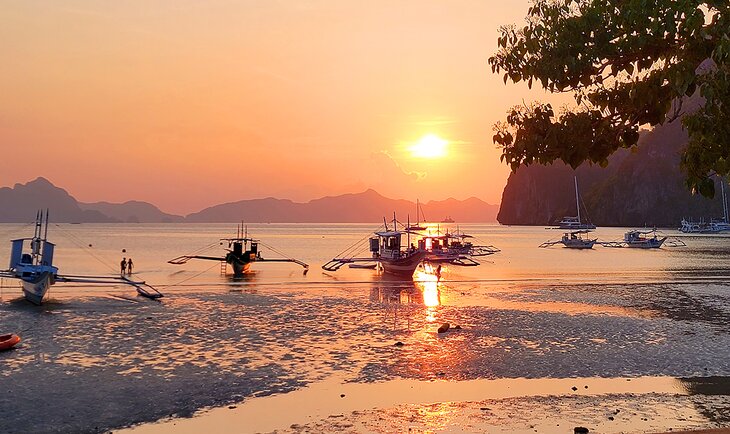
Individually, the islands each offer something unique, whether you are looking for the best place to dive and snorkel or prefer to take in the historical sights in cities like Manila or Vigan .
Since the country is so spread out, a trip to the Philippines requires careful planning and some internal flights. Some destinations, like the Chocolate Hills in Bohol or the Hanging Coffins in Sagada, are remote, but getting there is well worth the effort. It's also important to consider the best time of year to visit the Philippines. The rainy season runs from June to November.
Plan your travels with our list of the top tourist attractions and things to do in the Philippines.
1. White Beach, Boracay
2. relax on the stunning beaches of palawan, 3. chocolate hills, bohol, 4. underground river tour, puerto princesa, 5. hanging coffins, sagada, 6. diving in coron, 7. batad rice terraces, banaue, 8. mayon volcano, albay, 9. island hopping, 10. manila historical sightseeing tour, 11. ride in a jeepney, 12. historic tour of corregidor island, 13. bird-watching, 14. pagsanjan falls, laguna, 15. tour colonial vigan, 16. taal volcano, talisay, 17. jungle training, subic bay, 18. hanging bridge, sevilla, 19. sugba lagoon, siargao, best time to visit the philippines.
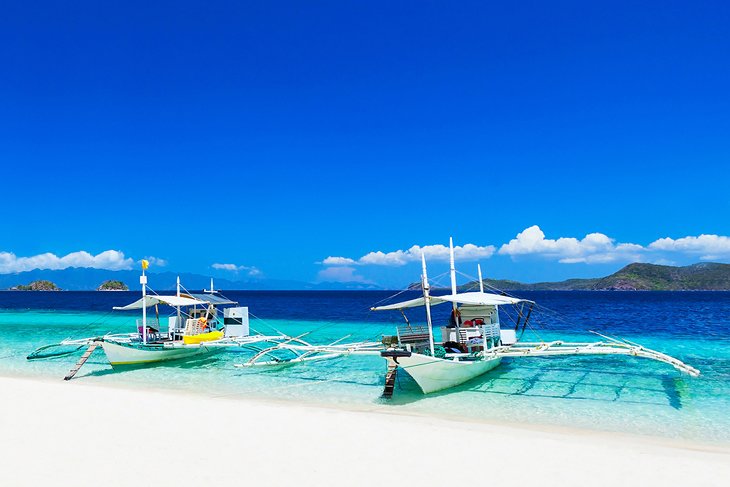
There is no shortage of pristine beaches in the Philippines, but if you are looking for a more active beach scene, one of the best places to visit is White Beach in Boracay . This is the most populous beach on the island but where you will find ample opportunities for boating and other water sports. It's also one of the most beautiful beaches in Asia .
Plenty of chairs and hammocks are beneath the palm trees, so you can relax and enjoy the pure white sand. You can even book a beachside massage. Snorkeling is a popular activity at White Beach, but if you do not want to put in so much work, take a banana boat ride or book a trip on a glass-bottom boat.
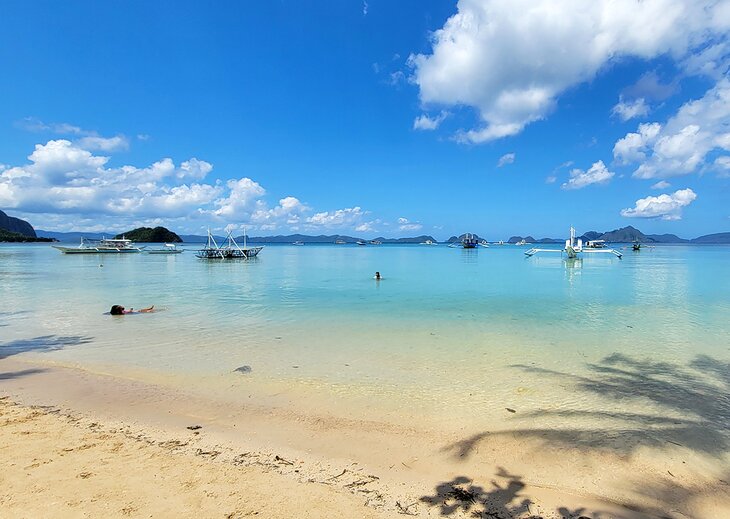
At the northern tip of the Island of Palawan are some of the most scenic beaches in the Philippines, unlike anything else you will find in the country. This is not just stunning soft sand and warm calm waters like you find in other areas of the Philippines. Add to this, limestone cliffs jutting up from the ocean, secrete coves that you can paddle into, and beautiful offshore islands. Some of the islands are also home to boutique luxury resorts.
The main town here is El Nido . A variety of boat trips offer day tours from El Nido to secluded beaches, sandbars, and bays. This is the most popular activity here and something that almost everyone signs up for when visiting. But you do not need to even leave El Nido, you can find this beautiful setting from the beaches around town.
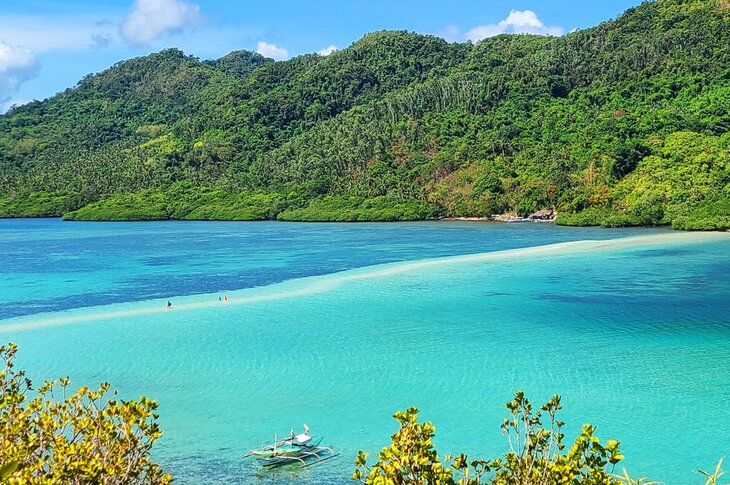
Northern Palawan is not overly developed. It has enough infrastructure to make things comfortable but it's not known for large resorts. If you are looking for luxury, it will be at small resorts and lodges. If you are looking for budget accommodation, you can find this as well in town but off the beach.
Palawan appeals to everyone from adventurous families to backpackers. A small airport in El Nido offers direct flights to Manila. The city of Puerto Princesa is also found on the island of Palawan, about a 5-hour drive from El Nido. If you want to see the Underground River in Puerto Princesa, you may want to fly into El Nido and out of Puerto Princesa or vice versa.
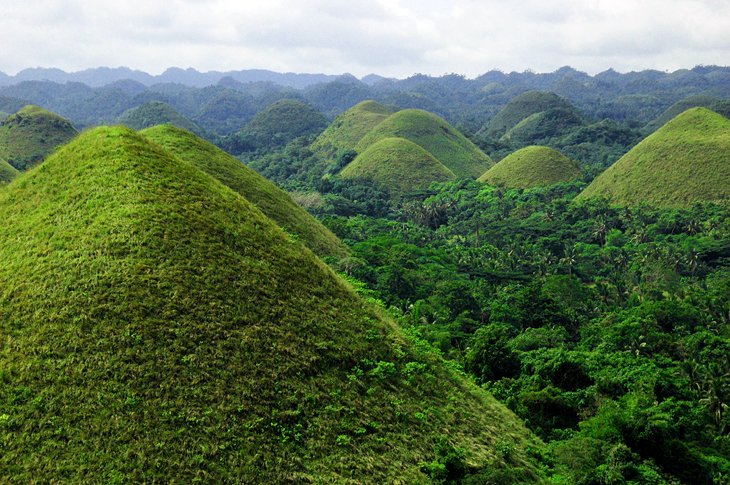
The geological wonder on the island of Bohol known as the Chocolate Hills is a unique natural phenomenon. This UNESCO World Heritage site is a protected area that features more than 1,200 small mountains that emerged above the ground over several centuries.
The area was once under the ocean, and these unique hills expand in every direction. They are green during much of the year, but during the dry season, they turn to a chocolate-brown color, thus the name, chocolate hills.
A convenient path leads to the top of a lookout area, which provides the best view. Be sure to observe the many delicate flowers along the walkway that are unique to this area.
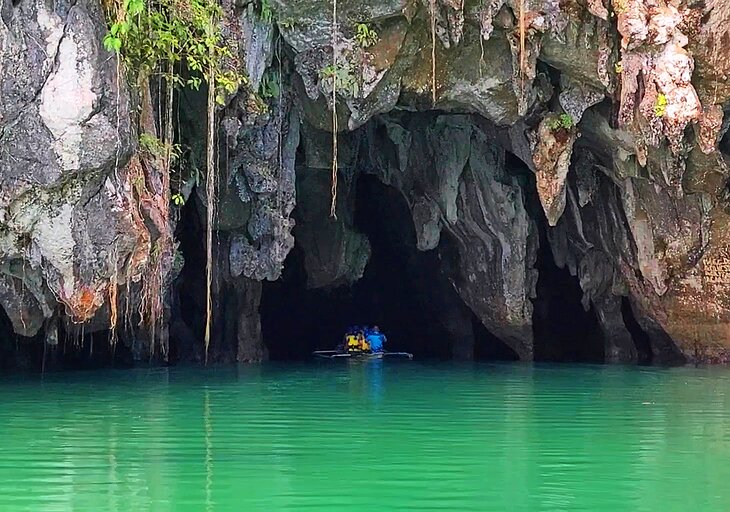
Taking a river tour of the Underground River near Puerto Princesa is one of the most awe-inspiring things to do in the Philippines. The underground river on Palawan Island is inside the Subterranean River National Park , a UNESCO World Heritage site.
The boat tours take you to experience the majestic five-mile river that runs below ground. The trip takes you through an intricate cave system surrounded by vertical limestone cliffs. You can see ancient stalagmite and stalactite formations, as well as bats flying overhead, as the coolness of the cave balances the tropical heat outside.
As you float through the dark caves on emerald water, your guide will identify points of interest and tropical wildlife that live along the river, which flows into the South China Sea .
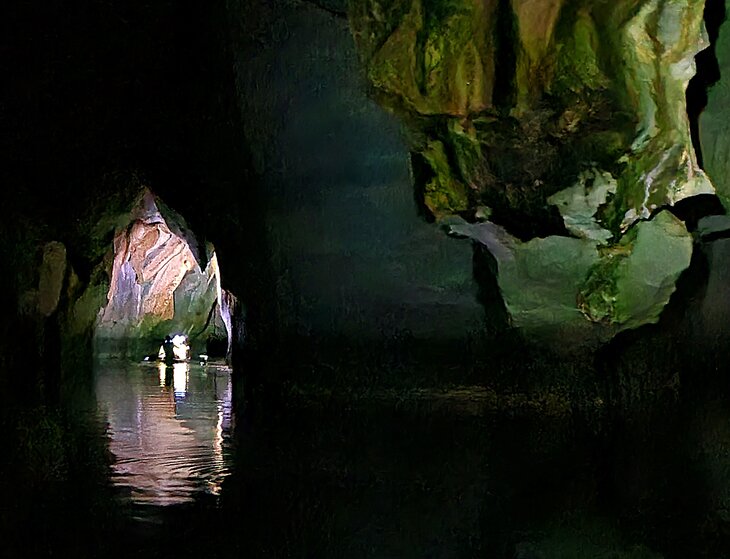
You can take a tour from Puerto Princesa, which is a long day due to the drive time involved. A better alternative is to stay in Sabang (which is about an hour and a half from Puerto Princesa) and hop on a tour boat right from there. This way you can see the cave in a morning or an afternoon. Sabang also has a beautiful beach and decent accommodation and is a nice place to spend a day or two whether or not you are visiting the cave.
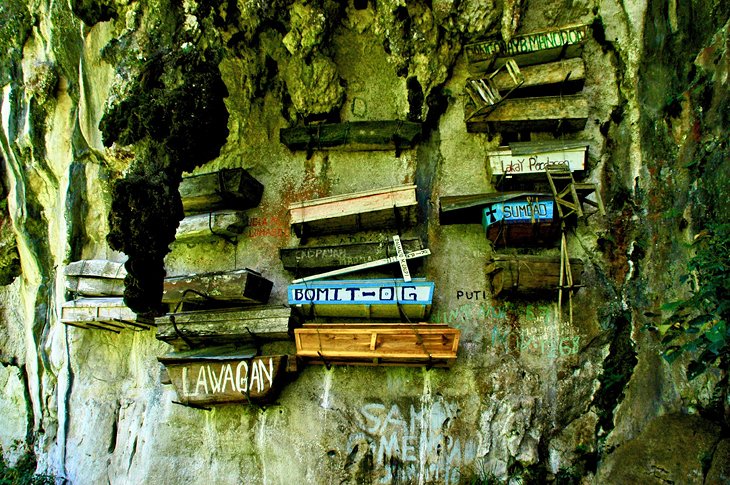
The hanging coffins in Sagada, located in the northern Cordillera Mountains , is one of the most unusual sights in the Philippines. The hanging coffins, some centuries old, are suspended from the cliffs of the Echo Valley . These ceremonial burials were reserved for the wealthy tribesmen.
Getting to the mountainous region requires some travel time. Although transportation to this area is now easier than it used to be, it still requires some physical endurance to hike the steep and narrow paths to the secluded coffins.
You will want sturdy shoes, and you may want to train before your trip to adapt more quickly to the high altitude. The reward is a sight you will never forget and well-earned bragging rights.
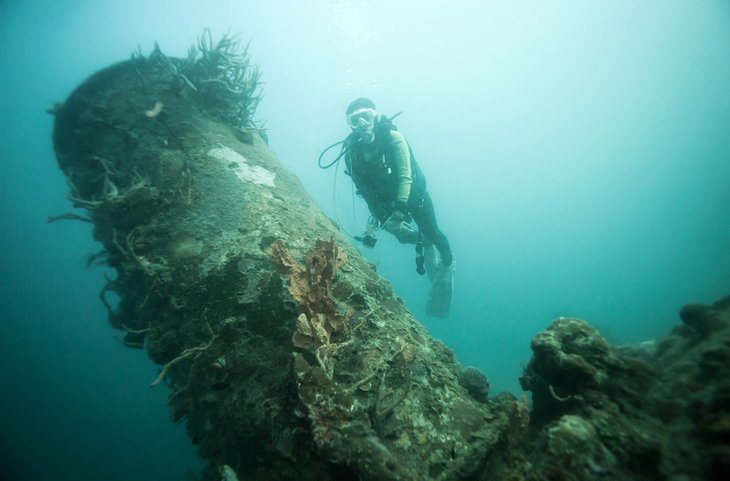
Coron Island in the Philippines, as well as other nearby islands, are popular diving locations in the country due to the abundance of coral reefs and shipwrecks.
The sunken ships to explore on Sangat Island in Coron are some of the best diving sites in the world. The wrecks are at varied depths that are suitable for both deep-water scuba divers and shallow-water snorkeling.
The shipwrecks, many from WWII , have become habitats for diverse fish species. The clear water makes for easy viewing of the shipwrecks and underwater wildlife. Many of the shipwrecks are from an attack on the Imperial Japanese Navy in 1944. Deep divers will want to view the Akitsushima Maru warship, Irako Maru , and the Kyokuzan Maru .
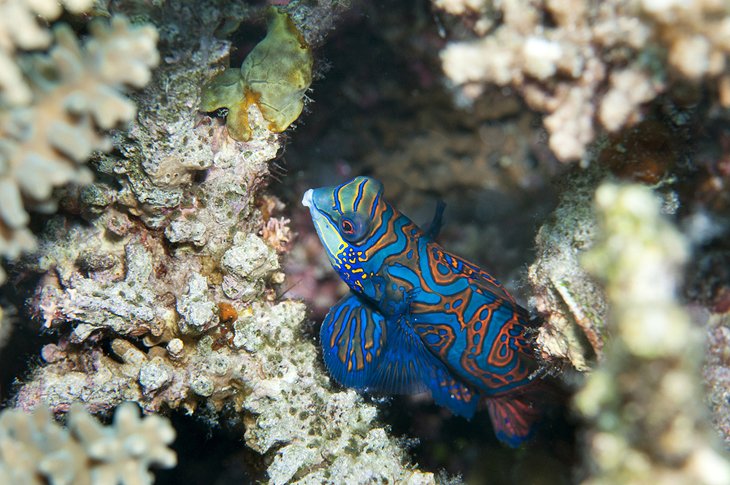
The Coral Garden is a specific site with particularly accessible coral and fish species. Snorkeling and diving tours to the Coral Garden often encompass stops at nearby shipwrecks.
If you are unsure where to snorkel to see some of the best coral, taking an organized trip to the Coral Garden is an easy introduction to the sport. Guides are able to point out sea turtles and fish and offer information about what kinds of coral you are viewing underwater.
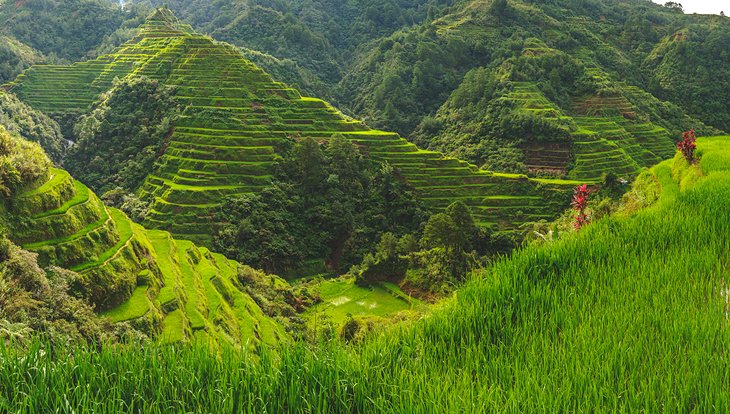
Viewing the Batad rice terraces at sunrise in Banaue is an unforgettable experience. This is especially recommended for landscape photographers who want to capture compelling images of Philippine agriculture. Some of these terraces are more than 2,000 years old and represent a common form of farming in the country.
The stacked terraces are carved by hand into the mountainside, creating vertical farming fields in a region void of flat land. Workers commonly plant rice and vegetables. You can walk some roads above the terraces that give you the best view by looking below. Early morning and dusk provide the best light to illuminate the electric green color of the fields.
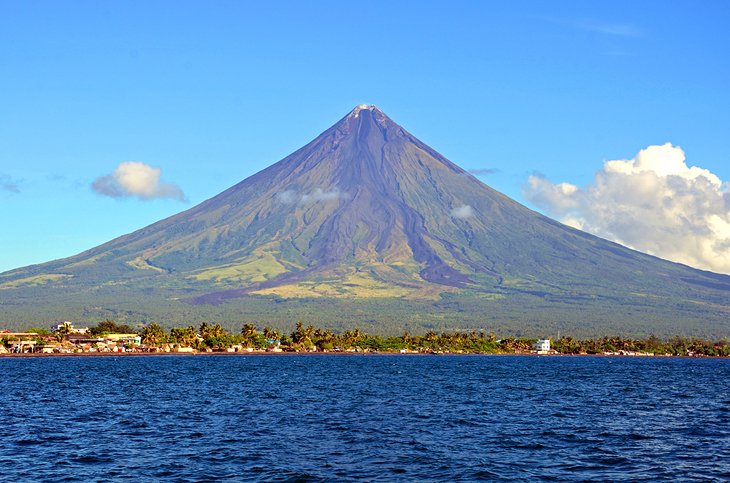
The Mayon Volcano in the Albay province on Luzon Island is a must-see in the Philippines. It is an active stratovolcano with an elevation of more than 2,400 meters. The Mayon volcano has a perfect cone peak.
Most visitors will want to enjoy the volcano by viewing it from the ground. Nature trails in the national park grounds surround the volcano, where you can also see wildlife like parakeets and other birds.
Extreme hikers can apply for a permit to climb the volcano, but it is a difficult trek through forest, and dangerous gases are emitted near the peak, so caution is advised. The ideal time to visit is March through May, outside of the rainy season. You can take an organized trip from Manila to get here.
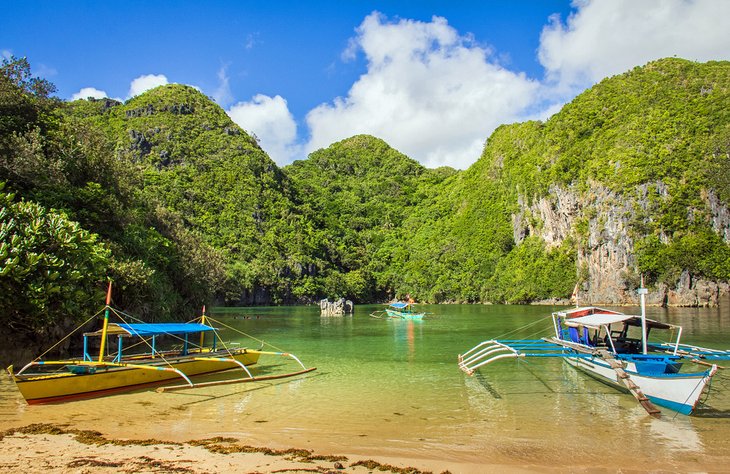
If you just cannot decide what to do or where to go in the Philippines, an island-hopping tour might offer just the right mix. You still have to whittle down choices, but an organized island-hopping tour allows you to see a collection of islands.
You can sample snorkeling, swimming, sightseeing, and dining on local food in multiple locations and eliminate the hassle of trying to plan it on your own. Many of the island hopping tours span several days. One of the most popular island-hopping tours is to the Caramoan Islands , which were made famous after being featured on the hit TV show Survivor.
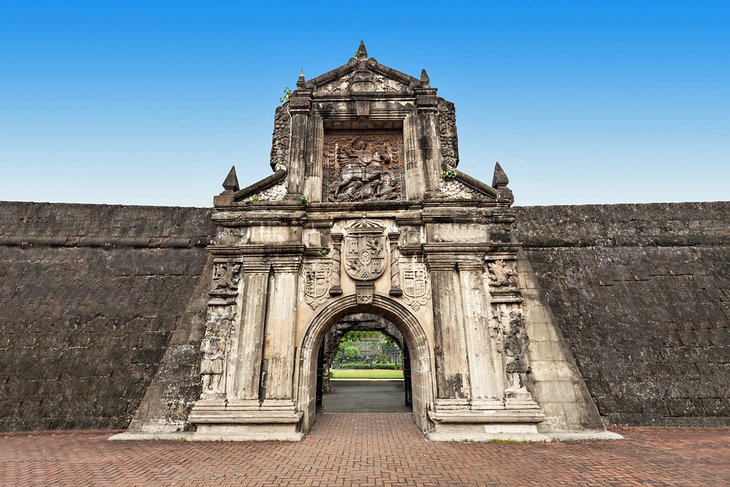
Manila is an exciting and vibrant city that is a thriving metropolis surrounded by centuries-old churches and colonial history. It is easy to walk around Manila on your own, or take a guided sightseeing tour of the oldest district, the Intramuros or walled city, where you'll find some of the most significant tourist attractions and important landmarks and monuments.
This will give you a better appreciation for Manila. You can see the famous San Agustin Church and monuments at Rizal Park and Fort Santiago , each bearing a significant influence on Manila that is best shared by a guide. Some tours are offered by coach, and others are available as walking or biking tours around the city.
After your tour, stop by one of the local restaurants for lunch and enjoy modern-day Manila as you watch the colorful jeepneys flying by on the streets.
- Read More: Top-Rated Tourist Attractions & Things to Do in Manila
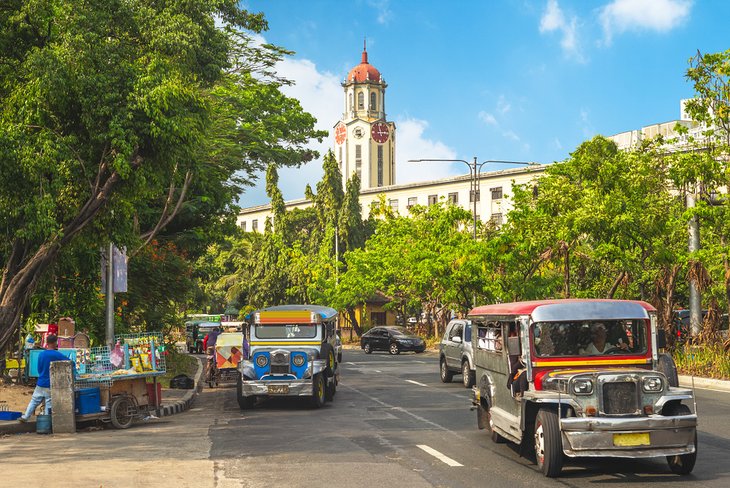
Taking a ride in a jeepney is a must-experience in the Philippines, even if you have no specific destination in mind. The jeepney is one of the main forms of transportation in the Philippines . They are vehicles originally made from post-World War II U.S. army jeeps that have been transformed into colorful and fun forms of transportation.
The jeepney has become synonymous with the Philippines; a national symbol of sorts. It is unique to the country. The decorations and colorful decor on the jeepneys are as chaotic as the traffic on the city streets in places like Manila. Taking a ride in one is a thrill, with the random stops to let people on and off and being truly immersed in the local culture as residents go about their daily lives. Try taking a jeepney to one of the tourist sites you plan to visit or to your dinner spot in the evening. It might just be the cheapest entertainment you find in the country, and it will definitely be one of the most memorable experiences.
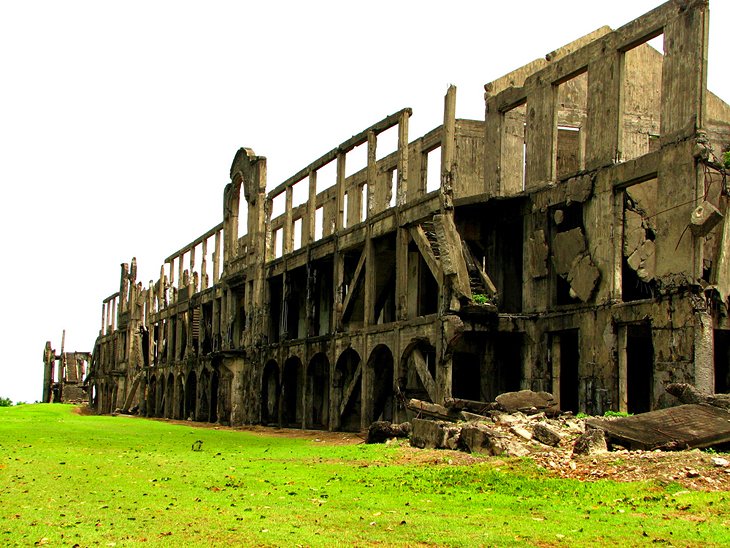
A tour of Corregidor Island is a must-see for history buffs visiting the Philippines. The island played a significant role in World War II and was the location of several battles. The relics left behind from these battles include secret tunnels and bunkers used as hideouts during the war, as well as weapons, barracks, and historical artifacts.
Be sure to take some time at the Pacific War Memorial on-site. Regular guided tours leave from Manila to a ferry that takes you to the island. This requires a full day to visit, but it is well worth the time if you have an interest in WWII history.
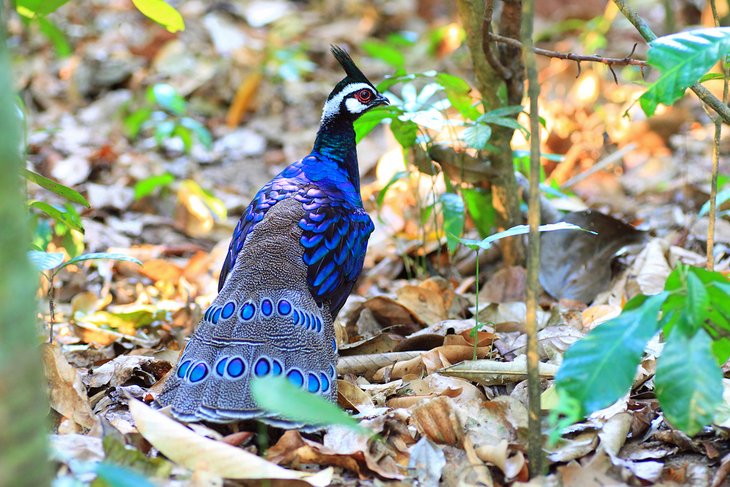
The stunning natural landscapes and ecosystems throughout the Philippines lend themselves to diverse habitats for birds, meaning the bird-watching opportunities are plentiful. Even if you are not an avid birder, it is worth taking a pair of binoculars on your trip to get a glimpse of some unique species that you likely will not encounter in other parts of the world.
With more than 7,000 islands and 94 national parks in the Philippines, it can be tough to narrow down where to start to look for some of the 600 species of birds that either live in or migrate through the country, like the brown-throated sunbird or the Palawan peacock-pheasant.
Some of the best places to start are the locations that cater to bird-watching like La Mesa Eco Park , which is popular among avid birders looking for barred rails, little egrets, osprey, and migratory birds that regularly rest in the park. The Negros and Panay Islands provided habitat for the endangered Walden's hornbill.
In the Luzon region, the Angat Watershed Reserve is a good spot to find many species along the trails and in the nearby Angat Rainforest and Ecological Park . Another spot where you see many migratory birds is in the Candaba Wetlands in Pampanga for species like purple herons.
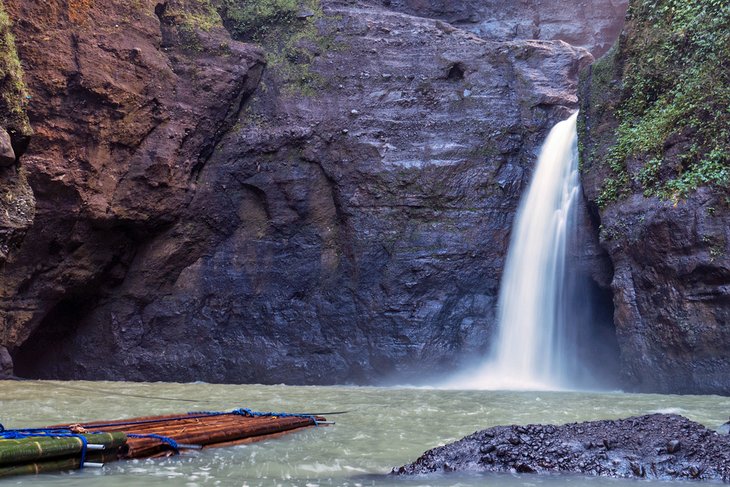
The only thing more exciting than admiring one of the most notable waterfalls in the Philippines is traversing it in a dugout canoe. The Pagsanjan Falls waterfall is part of the Pagsanjan Gorge National Park .
Your trip along the falls will take you upstream through tropical landscapes, where you will be able to swim in natural pools and pass through caves. Once you get used to the leisurely ride, prepare for the main event, as you head downstream at a fast pace through large rocks and churning water for what the locals call "shooting the rapids." It is an exhilarating outdoor adventure, and you can take day trips from Manila.
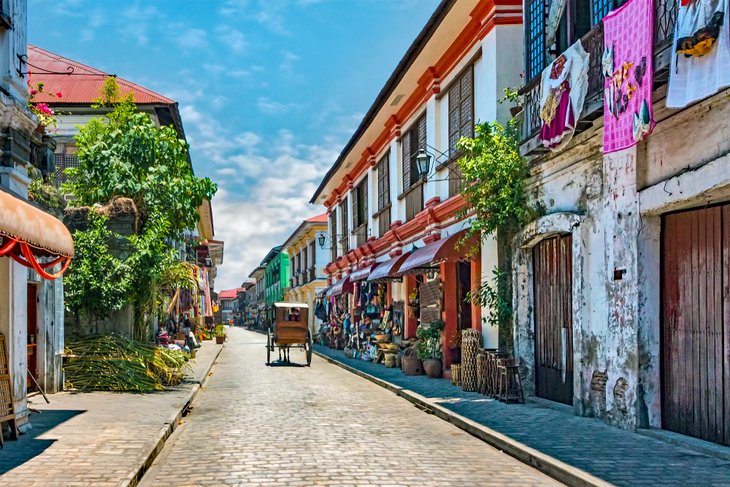
A fun place to visit with a terrific pre-colonial flair is the streets of Calle Crisologo of Vigan City, located in the Ilocos province. It stands out from other cities in the Philippines. The brick streets and traditional horse and carriage mode of transportation are reminiscent of the 16th-century trading hub that used to be for foreign traders coming through the area.
This is a fun city to spend a day or two on your trip. You can take an organized tour to learn about the city's history or stroll on your own to the small vendor shops and eateries along the main street. This is also a prime spot to find souvenirs, from bags to baskets and pottery, for a reasonable price.
Be advised that if you ask your calesa driver to take you to the best shopping area in the city, he or she might instead drop you off at a friend's shop in order to earn a kickback of your purchases. It's better to take a ride, then explore the city street shops on your own.

The Taal Volcano on the island of Luzon is one of the most active in the country. It is in the center of Taal Lake, so just getting to the crater is part of the adventure. The city of Talisay , where you will catch a boat to get to the crater, is less than an hour's drive from Manila. You will catch a boat to go across Taal Lake then hike to the rim of the crater.
There are a number of trails around the volcano. The Spanish Trail goes to the top of the volcano and has some of the most impressive views. The less popular Kenney Trail is a good option if you want to avoid potential crowds or if you think you might want to rest along the way.
This trail has quite a few shade trees. Due to the logistics involved in visiting Taal Volcano, you might want to consider an organized day tour.
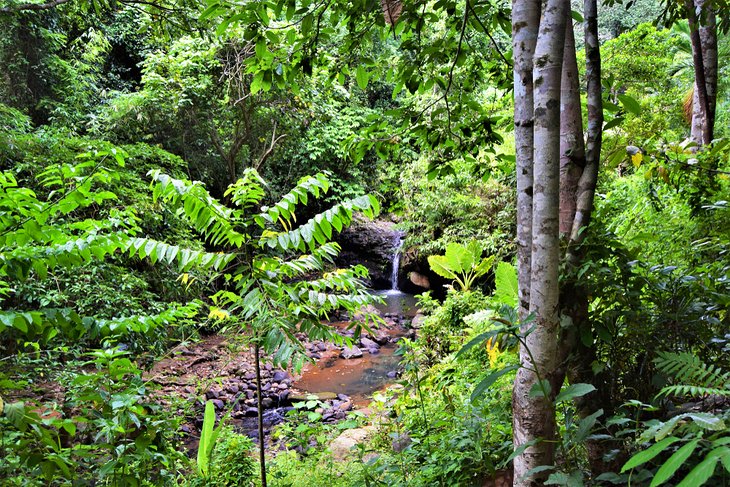
When the United States Navy had an active base on Subic Bay, their Navy Seals received training by indigenous Aetas on how to survive the jungle. Now, you can visit the former base on Subic Bay and even take Jungle Environmental Survival Training from the natives.
You can take a tour of the former Subic Bay Naval Base and tour the converted complex, which has a number of activities on-site. Subic Bay is located on the island of Luzon, so it is an easy day trip from Manila, or you can stay in the region.
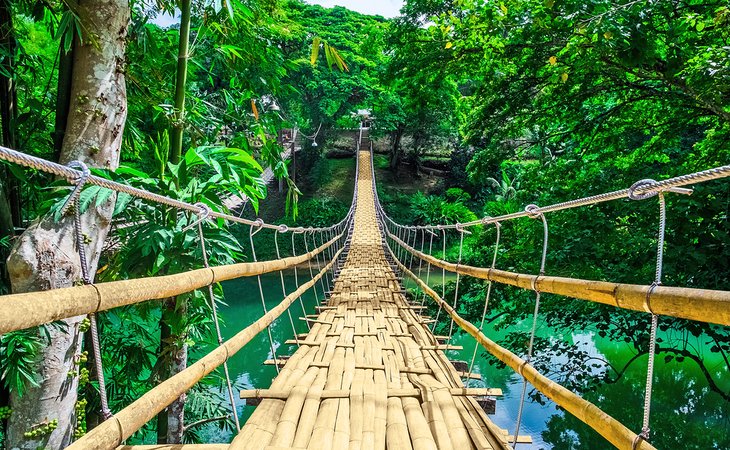
On the island of Bohol, a bridge made entirely of bamboo swings almost 40 meters in the air over the Loboc River . For those with a sense of adventure, or a desire to conquer a fear of heights, the hanging bridge walk will be a vacation experience you will never forget. The hanging bridge is in the town of Sevilla. It is easy to combine this experience with other excursions on Bohol Island.
Over the years, the bridge, which was originally made with woven bamboo, has received some safety reinforcements due to its popularity with tourists. Not to worry though, it still creeks and swings and gives you butterflies in your stomach as you look down at the rushing river below you.
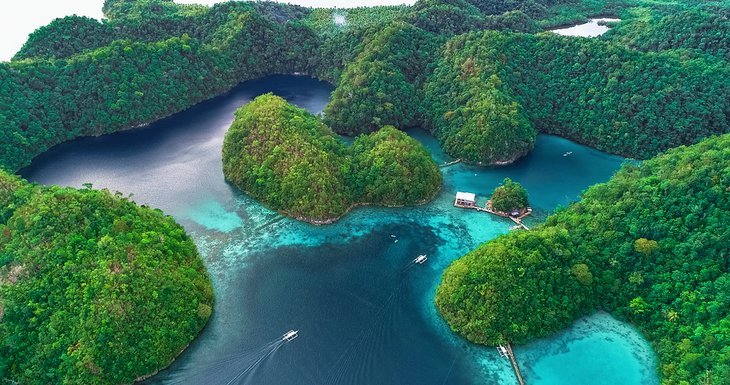
There are so many iconic lagoons in the Philippines that have movie-set quality tranquil blue waters below a towering cliffside, but one of the most spectacular is Sugba Lagoon on the island of Siargao. The lagoon is perfect for just basking in the natural, peaceful surroundings, but there are plenty of activities, too, if you want a more adventurous day.
You can book a day-trip package to the Sugba Lagoon from a nearby city like Del Carmen or General Luna, but you can also go on your own. You must take a boat to the lagoon. If you have the nerves and are not afraid of heights, you can try cliff jumping from the designated area above the lagoon. You can also rent a paddleboard or kayak, and take a more peaceful tour of the lagoon at your own pace.
The best time to go to the Philippines is during the dry season , which is between November and April , when you will have optimal weather conditions and the best opportunities for outdoor experiences throughout the country. This time of year has the least amount of rainfall, which means more favorable beach days , fewer chances of weather-impacted flight delays, and easier accessibility to remote regions and smaller islands.
The dry season is also the high tourist season and the most popular time to visit so you will have increased tourist activity and higher prices for airfare and lodging. During this popular time, the months of December, January and February are the coolest months to visit before the sweltering Asian heat kicks in starting in March. Keep in mind that high temperatures and humidity surge in April and May.

Top 32 Region 7 Tourist Spots
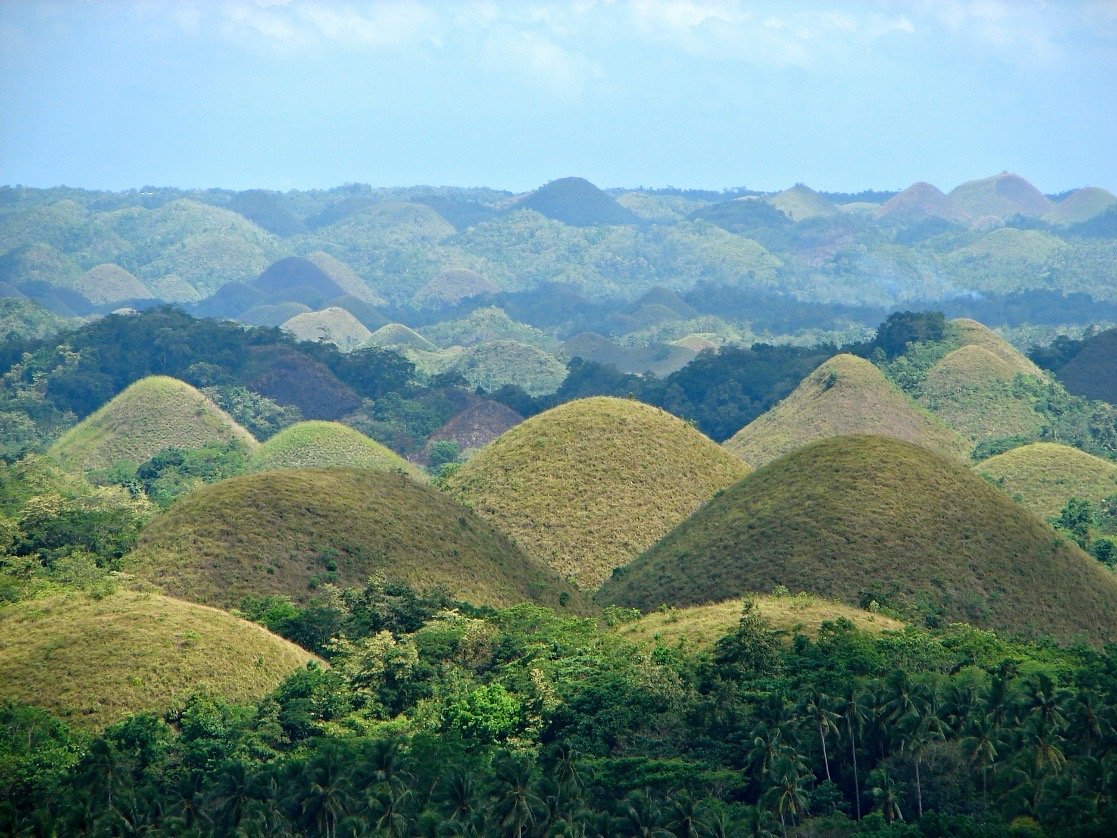
Immerse yourself in the abundant natural wonders and vibrant cultural heritage of the Philippines as we tour the top 30 tourist destinations in Region 7, Central Visayas. From pristine white beaches to historic landmarks, this guide offers an enchanting exploration of a region steeped in historical, cultural, and ecological richness.
Chocolate Hills, Bohol
The iconic Chocolate Hills in Bohol are a unique geological formation consisting of over 1,200 symmetrical mounds spread over an area of 50 square kilometers. The grass-covered hills turn chocolate brown during the dry season, hence the name, offering a surreal landscape that has become a symbol of national pride.
Tarsier Sanctuary, Bohol
Get up close and personal with one of the smallest primates in the world at the Tarsier Sanctuary in Corella, Bohol. This sanctuary is dedicated to the conservation of these endangered species, offering an enlightening experience for wildlife lovers.
White Beach, Moalboal, Cebu
Known for its long stretch of powdery white sand, the White Beach in Moalboal is a popular destination for swimming, snorkeling, and diving. It’s also the gateway to the enchanting underwater spectacle of millions of sardines known as the "Sardine Run".
Oslob Whale Shark Watching, Cebu
Swim with the gentle giants of the sea at Oslob. This coastal town offers visitors a chance to snorkel or dive alongside whale sharks, providing a unique and exhilarating wildlife encounter.
Panglao Island, Bohol
This island paradise in Bohol is renowned for its pristine white beaches, crystal clear waters, and vibrant coral reefs, making it an excellent spot for beach relaxation and underwater exploration.
Siquijor Island
Often associated with mysticism due to its folk healing festivals, Siquijor Island is also known for its stunning beaches, cascading waterfalls, and century-old churches. Don't miss the enchanting Cambugahay Falls and the historical Lazi Church when you visit.
Basilica del Santo Niño, Cebu City
This 16th-century basilica is one of the oldest Roman Catholic churches in the Philippines. It houses the revered Santo Niño de Cebu statue, commemorating the birth of Christianity in the country.
Magellan's Cross, Cebu City
A significant historical landmark, Magellan's Cross marks the spot where Portuguese explorer Ferdinand Magellan planted a cross in 1521, symbolizing the introduction of Christianity to the Philippines.
Kawasan Falls, Badian, Cebu
The three-tiered Kawasan Falls, nestled in the jungles of Badian, is a haven for nature lovers. Visitors can swim in the turquoise waters of its natural pools, relax in the lush surroundings, or partake in canyoneering adventures.
Loboc River Cruise, Bohol
The Loboc River Cruise offers a leisurely journey down a picturesque river. Enjoy a sumptuous local buffet meal while listening to local musicians perform onboard.
Temple of Leah, Cebu City
Often referred to as the "Taj Mahal of Cebu", this grand edifice is a symbol of a husband's undying love for his wife. The temple offers stunning views of Cebu City and houses a museum, a library, and an art gallery.
Apo Island, Negros Oriental
Renowned for its stunning coral gardens and diverse marine life, Apo Island is a paradise for snorkelers and divers. This marine reserve offers an amazing opportunity to swim with turtles in their natural habitat.
Pescador Island, Moalboal, Cebu:
This small, uninhabited island off the coast of Moalboal, Cebu, is a diving paradise. Pescador Island is home to a wide variety of marine life, including sardines, sea turtles, and reef sharks, making it an exceptional spot for scuba diving and snorkeling.
Fort San Pedro, Cebu City
The oldest Spanish fort in the Philippines, Fort San Pedro, serves as a testament to the country's colonial past. The triangular fortress, originally built to repel Muslim raiders, now houses a museum that displays Spanish artifacts and documents.
Osmena Peak, Dalaguete, Cebu
The highest peak in Cebu, Osmena Peak offers panoramic views of the island. Its jagged hills and the sea view make it a popular destination for hikers and photography enthusiasts.
Tumalog Falls, Oslob, Cebu
This ethereal waterfall in Oslob presents a refreshing retreat. Tumalog Falls, also known as 'Toslob Falls' or 'Mag-Ambak Falls,' cascades down a mossy cliff, creating a gentle mist and a serene turquoise pool that invites a refreshing dip.
Taoist Temple, Cebu City
This towering temple provides a glimpse into the practices of Taoism. Its vibrant, intricate design and the panoramic view of Cebu City from the top make it a popular tourist spot.
Sumilon Island, Cebu
Known for its shifting sandbar, Sumilon Island is a stunning natural wonder. The island also features a lush forest, a lagoon, and historical landmarks including a 19th-century lighthouse and a Baluarte, a watchtower from the Spanish colonial era.
Manjuyod White Sandbar, Negros Oriental
Known as the "Maldives of the Philippines", the Manjuyod White Sandbar stretches over 7 kilometers at low tide. Its crystal-clear waters and cottages on stilts provide a picturesque setting for relaxation and marine activities.
Dumaguete Boulevard, Negros Oriental
Also known as Rizal Boulevard, this stretch in Dumaguete City is a bustling hub of activity. With an array of restaurants and bars, it’s an excellent place to sample local cuisine, witness stunning sunsets, and engage in the vibrant local culture.
Mount Kanlaon, Negros Oriental
The highest peak in Central Visayas and one of the most active volcanoes in the Philippines, Mount Kanlaon offers challenging trekking trails leading to its summit. It boasts diverse flora and fauna, including rare and endangered species.
Sirao Flower Garden, Cebu City
Dubbed as the "Little Amsterdam of Cebu," this vibrant flower farm features rows of various blossoming flowers. Its most popular feature is the field of celosia flowers, which turn bright red, yellow, and orange during their peak season.
Lamanok Island, Anda, Bohol
Known for its rich archaeological and anthropological significance, Lamanok Island offers a fascinating journey into prehistoric times. It features a series of limestone caves with ancient red hematite paintings and wooden coffins, believed to be burial sites of early inhabitants.
Simala Shrine, Sibonga, Cebu
This grand religious structure attracts devotees and tourists with its castle-like architecture. Simala Shrine is known for its miraculous statue of the Virgin Mary, making it a popular pilgrimage site.
Lake Balinsasayao, Negros Oriental
This serene crater lake, together with its twin lake, Lake Danao, provides a peaceful retreat into nature. Set amidst a dense forest, it's home to various species of birds and offers activities like kayaking and trekking.
Bantayan Island, Cebu
Bantayan Island is a serene haven known for its powdery white sand beaches, azure waters, and laid-back atmosphere. It is also home to historic structures, such as the St. Peter and Paul Church, one of the oldest in the Philippines.
Heritage of Cebu Monument, Cebu City
This massive tableau encapsulates the rich history of Cebu through sculptures depicting significant moments and figures. Created by national artist Edgardo Castrillo, it provides a quick, visual history lesson on the province.
Twin Lakes of Balinsasayao & Danao, Negros Oriental
These two deep crater freshwater lakes, located at the mountainside of Sibulan town, are separated by a narrow ridge and are both surrounded by lush forests. Perfect for kayaking, trekking, and bird watching, these lakes offer an exhilarating connection to nature.
Camotes Islands, Cebu
Comprising four islands, Camotes offers an array of natural attractions, from stunning white-sand beaches, sparkling turquoise waters, to fascinating caves and lakes. Highlights include Santiago Bay, Lake Danao, and Bukilat Cave.
Malapascua Island, Ceb
Famous among the diving community, Malapascua Island offers the unique opportunity to dive with thresher sharks. Beyond this, the island has immaculate sandy beaches and a vibrant local culture.
Simala Church, Cebu
This magnificent castle-like structure houses a monastery and a church in Sibonga, Cebu. Known as the Monastery of the Holy Eucharist, it attracts both pilgrims and tourists with its stunning architecture and the miraculous Virgin Mary statue.
Casaroro Falls, Negros Oriental
Hidden in Valencia, Negros Oriental, Casaroro Falls is known for its single, narrow stream dropping 30 meters into a deep cold basin before it flows down into a river. Enclosed by lush vegetation and rocky cliffs, it's perfect for nature-lovers seeking tranquility.
Whether you are seeking an adventurous trip filled with adrenaline-pumping activities, a cultural exploration steeped in history, or a serene retreat into nature's lap, Region 7 of the Philippines caters to every type of traveler. This list only scratches the surface of what Central Visayas has to offer, as the region's charm truly lies in the unexplored gems scattered across its vibrant cities and towns. Embark on a journey to this part of the Philippines, and be ready to create unforgettable memories.
Top 30 Region 8 Tourist Spots
Top 30 region 6 tourist spots in the philippines.

- Philippines
15 Best Tourist Spots in the Philippines
As we all know, and I’m sure that you do, the Philippines is home to some of the world’s best and finest tourist attractions you can ever find. All of our country’s 7,641 islands are absolutely worth visiting because each of them offers a stunning surprise that will make you fall in love with the Philippines even more.
We are blessed with countless natural wonders that are simply breathtaking that you shouldn’t miss the chance to witness their beauty at least once in your life. We also have world-class islands such as El Nido, Coron , Siargao, and Boracay that attract tourists from different parts of the world!
Aside from our country’s never-ending list of tourist attractions, we Filipinos are also known for our warm culture and hospitality that foreigners absolutely love. No matter where you’re from, Filipinos will surely make you feel at home. On top of all that, Filipinos are also known to make some of the most amazing food in the world! The food culture in the country is unrivaled and I’m sure that wherever you go, your taste buds will always be satisfied.
The Philippines has a lot of things to offer to everyone. Whether you’re an adrenaline junkie, a solo backpacker, a history buff, or a food connoisseur, you will have the best time of your life in our country. So, are you ready? Come and join me as I help you discover the 15 Best Tourist Spots in the Philippines!
Located in the beautiful province of Surigao Del Norte is a teardrop-shaped island considered to be the Surfing Capital of the Philippines. There’s no doubt that this tropical paradise is the hottest and most in-demand tourist destination in the country right now! Yes, Siargao Island is currently on the top of the list of the best tourist destinations in the Philippines. More and more tourists from different parts of the world are going crazy thanks to the island’s extraordinary natural features, rich culture, and friendly community.

Photo by Alejandro Luengo on Unsplash
Siargao has all kinds of fun and exciting activities prepared for you and I’m sure that you’ll definitely have a good time. Of course, there’s surfing, kayaking, scuba diving, hiking, and many more! But the best part about Siargao is that the island has an endless list of surprises that are yet to be discovered.
Breathtaking white-sand beaches, sparkling waterfalls, majestic mountains, stunning cave systems, and many more are all waiting to make your memorable Siargao trip even more exciting! Some of the must-visit attractions you shouldn’t miss on the island are Cloud 9 Siargao, Magpupungko Rock Pools , and the famous Sohoton Cove National Park.
Siargao is still in the process of developing the island’s establishments and infrastructure to maximize its potential in tourism. So if you want to experience Siargao in its pristine and finest condition, then I suggest that you book a tour now! Trust me, it’s going to be one of the best decisions you’ve made in your life.
Ah, of course! Boracay still remains as one of the supreme icons of Philippine tourism. Known all over the world for its pristine white-sand beaches, Boracay grew to be the favorite beach destination of countless tourists from different parts of the world.

More than its extraordinary natural features, Boracay became a premier tourist destination because of the multiple world-class hotels and resorts offering top-notch accommodation services and all the exciting activities you could ever ask for. There’s island hopping, scuba diving, kayaking, swimming, and more!
From its mesmerizing sunsets to crystalline turquoise waters and long stretches of white-sand beaches, Boracay is truly a tropical paradise worth visiting in the Philippines.
3. Batad Rice Terraces in Ifugao
The truly picturesque and breathtaking view of Batad Rice Terraces has got to be one of the Philippines’ treasured gems. The unparalleled beauty of these rice terraces was recognized to be a UNESCO World Heritage Site in 1995. That fact alone will already give you an idea of how amazing the sights really are!

Batad Rice, Terraces
These awe-inspiring rice terraces were carved and constructed about 2,000 years ago yet it is still perfectly preserved and fully functional to this day. Aside from Batad Rice Terraces’ aesthetic view, more and more tourists are also falling in love with the lovely community behind the landmark. Moreover, it also houses the rich culture and history of the Ifugao tribes residing in the mountains surrounding the rice terraces.
Read the Blog Post: Batad Banaue Ifugao Travel Guide
4. El Nido, Palawan
Another world-class tourist destination you should absolutely visit in the Philippines is no other than El Nido, Palawan. Known for its white-sand beaches, heavenly lagoons, and dramatic black limestone cliffs, El Nido is the best choice for those who want to cast themselves away and enjoy a peaceful escape from reality.

El Nido’s island hopping tours are some of the most magical and enchanting experiences you can ever encounter in the world. Each island possesses a unique beauty that will leave you stunned for a lifetime. That’s why there’s absolutely no doubt how El Nido became one of the best islands in the world.
El Nido has an endless list of tourist attractions you definitely shouldn’t miss including Nacpan Beach , Secret Lagoon, and Shimizu Island.
READ THE BLOG POST: El Nido Palawan Experience and Guide
5. Coron, Palawan
Next up, another tropical treasure of the beautiful island of Palawan is Coron which is known for its world-class wreck diving sites filled with abundant marine and aquatic life. Coron’s crystal clear waters are famous for diving enthusiasts all over the world. Aside from its premier diving spots, the island is best known for its stunning white-sand beaches, karst limestone cliffs, evergreen forests, and magical islands.

Photo by David Köhler on Unsplash
Aside from Coron’s breathtaking natural wonders, the island is also blessed with thriving wildlife and marine biodiversity. The island preserves its pristine condition making it a perfect habitat for multiple species of birds, mammals, reptiles, fishes, and coral reefs. On top of all that, the community in Coron, Palawan is also very friendly and accommodating, making it a suitable place for adventurers and nature lovers.
Some of Coron’s best tourist attractions are Busuanga Island, Banol Beach, and the magical Coron Bay where you can find some of the most popular Japanese shipwrecks surrounded by majestic limestone cliffs and turquoise waters.
6. Cebu Island
Cebu Island is the largest island in the Visayas which is known for its rich Spanish colonial history and is blessed with multiple natural wonders such as majestic mountains, rolling hills, sparkling rivers, falls, and many more. It is also where you can find the iconic Queen City of the South, the island’s capital city, Cebu which is one of the country’s largest metropolises.

Photo by Olga Tsai on Unsplash
Given its particularly rich history, Cebu Island has become a top tourist destination because of its multicultural heritage. From its thriving food culture, countless natural attractions, historical landmarks, and overall incredible experience, Cebu should be on your list for the Philippines’ top tourist destinations.

Photo by Jessa Marie Pedrola on Unsplash
Cebu Island’s most notable and must-visit destinations include Kawasan Falls, Camotes Island, and the enchanting Moalboal Island which is truly a glimpse of a stunning tropical paradise.
READ THE BLOG POST: 15 Best Beach Resorts in Cebu
7. Balabac Islands
Ah, and there it is. Nestled in the south-westernmost and farthermost tip of Palawan lies a secluded island filled with everything that describes paradise on earth. Balacbac Islands is a small group of islands that houses several untouched islets bathing in the crystal clear waters of the Sulu Sea and surrounded by stunning white-sand beaches. Balacbac Islands truly offers a mind-blowing out-of-this-world experience to everyone taking the chance and effort to visit its unspoiled beauty.
Photo by Cris Tagupa on Unsplash
Balacbac Islands is also home to a wide variety of species of animals and plants that make the islands even more beautiful. Prepare yourself to be in awe of everything that Balacbac has to offer because rarely do you get a chance to experience the beauty of nature in its finest condition like this one.
Ah, Batanes is known as the northernmost province of the Philippines. Over the years, Batanes was struck by powerful typhoons causing extreme winds and strong waves to destroy houses each time. This made the locals adapt and in turn construct houses entirely made of stones. That’s why when you visit Batanes, it’s like you’re in a completely different country because of the picture-perfect postcard setting of the province.

Photo by Rene Padillo on Unsplash
The rolling hills, deep blue waters of the Pacific, lighthouses, and the gigantic boulders will make you fall in love and appreciate the simple way of life being practiced in Batanes. The reason why you need to visit and personally witness Batanes’ picturesque beauty is actually simple. It’s simply amazing.
9. Vigan, Ilocos Sur
We all know that the Philippines is a multicultural nation thanks to the countless years of war and colonialism that shaped our history. Our country was under the Spanish Colonial government for 333 years and that’s why they had a huge impact on our culture as Filipinos. And do you know where you can catch a glimpse of the Old World Spanish Colonial Era version of the Philippines? That’s right. Only here at Vigan, Ilocos Sur.

Vigan is known for its perfectly-preserved Spanish Colonial buildings and churches. It is so beautiful that walking around the iconic Calle Crisologo will make you feel like you’re traveling back in time and walking along with the forefathers of our nation. Aside from the truly aesthetic vibes of Vigan, the city is also known for its amazing culture which attracts tourists from different parts of the world.
From discovering hidden gems of antique shops, restaurants, and cafes, you will never get tired of exploring the breathtaking beauty of this U NESCO World Heritage Site .
If you’re looking for some of the most amazing sights and sceneries atop the Philippines’ highest mountain ranges, then Sagada is definitely the perfect place for you. Sagada is a small town in the Cordillera Mountains known for its breathtaking natural attractions and exciting activities for everyone. It is a haven for hikers and trekkers that love the thrill of adventure and rewarding themselves with heavenly views atop the mountains.

Photo by Aldrino on Unsplash
Sagada is also blessed with several natural wonders such as massive caves, sparkling waterfalls, rivers, and cliffs that attract tourists from different parts of the country. That’s why when you visit Sagada, prepare to engage yourself in countless fun and exciting activities such as swimming, waterfall hiking, spelunking, and food trips all day long!
In the Philippines, when we talk about Bohol, there’s only one thing that automatically comes to mind and that’s the majestic beauty of the Chocolate Hills. Trust me, there’s a reason why these jaw-dropping hills are visited by tourists from the farthest parts of the planet and it’s truly worth it. For those who don’t know, the reason why it’s called the Chocolate Hills is because of the color of the hills that changes to brown during the rainy season.

Another reason why tourists visit Bohol is that it’s the only place in the world where the world’s smallest primate, the Tarsier, can be seen. Moreover, Bohol is also known to be blessed with several natural wonders such as majestic islands, evergreen forests, sparkling rivers, rice terraces, and many more!
If you’re ever in Bohol, be sure to not miss the chance of visiting Panglao Island, the Loboc River, and the breathtaking Hinagdanan Cave!
Read the blog post: 10 Best Beach Resorts in Bohol
12. Intramuros, Manila
Located in the capital city Manila, this secluded place filled with countless stories significant in Philippine culture and history will give you an Old World vibe during your visit. Intramuros is known as the Walled City because it is literally surrounded by walls that are meant to protect the Spanish government from enemies.

Photo Credit: Agustin Rafael Reyes via Compfight, Creative Commons
Inside the Walled City are precious Spanish Colonial buildings that served a great purpose during the 333-year rule of Spain over our country. Well-preserved monasteries, government buildings, and schools are situated inside Intramuros that today serve the Filipino people in many ways. Today, Intramuros has become a popular tourist destination that enables visitors to have a glimpse of the Philippines’ rich culture and history.
Oh, and aside from the Walled City’s historical significance, it is also filled with countless shops and restaurants that exude an aesthetic vibe to everyone who’s visiting! You can also ride the kalesa while exploring around, so don’t miss out!
READ THE BLOG POST: 15 Tourist Spots in Intramuros, Manila
13. Mayon Volcano, Albay
The Mayon Volcano ( Albay ) of the Philippines is truly one of the country’s most iconic tourist destinations. Mayon is known all over the world as the volcano that has the most perfect and symmetrical cone-shaped features. Despite the continuous danger that it imposes being the most active volcano in the Philippines, Mayon Volcano has remained as a must-visit tourist attraction in the country.

Mayon Troop!

Photo by Cojo Rosales on Unsplash
Due to the volcano covering a massive area, it has also become the home of many endangered animal and plant species. Moreover, tourists are also in for fun and exciting adventures revolving around the Mayon Volcano such as ATV rides, hiking, trekking, and many more!
READ THE BLOG POST: Albay Tourist Spots in One Day
14. Tubbataha Reef, Palawan
Finally, another gem located off the coast of Palawan is the iconic Tubbataha Reef. This UNESCO World Heritage Site is home to millions of species of stunning coral reefs and marine biodiversity that will simply blow your mind. The reef is located in the middle of the Sulu Sea and is currently considered a protected area.

Credit: Philippine Tourism USA
The Tubbataha Reef is truly a heavenly place and recognized as the number one (1) diving site in the country where you can witness the astonishing sight of large marine animals like sea turtles, manta rays, and shark species. Trust me, scuba diving in the Tubbataha Reef is a life-changing experience that you will forever remember for the rest of your life.
15. Rizal Park, Manila
Of course, visiting the most important historical landmark in the entire country should definitely be on your list. Rizal Park is one of the largest urban parks in Asia covering a wide area of 60 hectares. Also known as Luneta, this park is a shrine dedicated to the Philippines’ national hero, Dr. Jose Rizal.

Credit: Wikimedia Commons
Exploring the huge park will truly give you a glimpse of the Philippines’ rich history because you can visit some historical landmarks such as the statue of Dr. Jose Rizal, Lapu-Lapu, and the National Museum of the Philippines .
Rizal Park is also the perfect chance for tourists to walk around in peace and discover some popular attractions like the Manila Orchidarium, Central Lagoon, and the Chess Plaza where you can challenge your wits and brains in the game of Chess with random strangers.

previous
15 Best ABRA Tourist Spots (Waterfalls, Caves and More)

newer
15 Best Beaches in the Philippines
You might also like.

Samal Island, Davao : Relaxing Clear Blue Waters

15 Best TOURIST SPOTS in MINDANAO 2024 (Beaches, Falls, Rivers & More)

15 Best Waterfalls in the Philippines
One comment.
Armando A. Suñe
You included Rizal Park but you forgot about ILOILO CITY. ILOILO CITY has plenty of well-maintained Spanish and American era plazas,parks, open squares with monuments to heroes and patriots, and its riverside garden Esplanades are about as big in hectarage as the Rizal Park. If history and antiquity is your interest, ILOILO CITY has the most number of museums and art galleries among the cities south of Manila. ILOILO’s delicious cuisine has iconic dishes that are famous nationwide: La Paz Batchoy, Pancit Molo, Villa Chicken Inasal ( which started to become popular since WWII). The delicious Fresh Lumpia Ubod rolls was first time concocted in Molo District where the old Chinese population lived during the Spanish period, and was known as the Parian, much like Binondo. ILOILO CITY has lately become a favorite convention destination because of its besuty, cleanliness, orderliness, and plentiful attractions like it’s numerous Spanish and American era heritage buildings, grand palatial mansions , beautiful Spanish era cathedrals and churches, beautiful bridges, fountains and belfries. ILOILO CITY should be included in the list of the best tourist places in the Philippines.On January 25, 2020, ILOILO CITY received the ASEAN CLEAN TOURIST CITY AWARD 2020-2022 from an ASEAN TOURISM ORGANIZATION.
Leave a Reply Cancel reply
Privacy overview.
- Australia edition
- International edition
- Europe edition

Ruined centuries-old town re-emerges as Philippines dam dries up during heatwave
After a long spell of intense heat and little rain, water levels have fallen to reveal parts of a sunken church, tombstones and foundations at Pantabangan
Ruins of a centuries-old town have emerged at a dam parched by drought in the northern Philippines .
After a prolonged spell of intense heat and little rain, water levels in the dam have fallen to reveal parts of a sunken church, tombstones and the foundations of structures from the 300-year-old town in Nueva Ecija province.
“When I heard about the sunken church of old Pantabangan town resurfacing, I got excited and wanted to see it,” said 61-year-old retired nurse Aurea Delos Santos.
Water levels at the Pantabangan dam have fallen by 26 metres so far this year, with its current level seven metres lower than a year ago.

Some locals have benefited by making it something of an attraction, ferrying tourists to the island. “Back then, I was only earning 200 pesos [$3.50] from fishing, but when the tourists arrived, I’m earning 1,500 to 1,800 per day,” said fisher Nelson Dellera.
The town’s population was relocated in the 1970s during the construction of a dam, which now serves as the main irrigation and water source for Nueva Ecija and nearby provinces, according to the local government.

The Philippines and other countries in south-east Asia have been grappling with extreme heat in recent weeks, prompting schools to suspend classes and governments to urge people to stay indoors to prevent heatstroke.
On Thursday, Cambodia blamed the extreme heat for an explosion at an ammunition storage facility that killed 20 soldiers.
The blast – which destroyed an entire truck of munitions and levelled buildings – also wounded several soldiers and at least one child in rural Kampong Speu province on Saturday.

The defence ministry said that investigators believed the heatwave played a role in the old weapons detonating.
“The incident of the ammunition explosion on April 27, 2024 ... was a technical issue because the weapons are old, faulty, and the hot weather,” the ministry said in a statement.
Human-caused climate breakdown is supercharging extreme weather across the world, driving more frequent and more deadly disasters from heatwaves to floods to wildfires. At least a dozen of the most serious events of the last decade would have been all but impossible without human-caused global heating.
With Agence France-Presse
- Philippines
- Extreme heat
- Asia Pacific
Most viewed
What is slow tourism and which destinations are tourists visiting to experience it?
Digital travel platform Agoda witnessed a spike in searches for slow travel destinations that have become popular among tourists who are adopting slow tourism. Let's take a look at the most-popular places and they are attracting travellers.

Slow travel has emerged as a prominent trend among holidaymakers across the world. An increasing number of travellers are now opting for longer stays at certain destinations to explore local culture and places of historical importance, all the while attempting to save the environment. Digital travel platform Agoda witnessed a spike in searches for slow travel destinations and shared insights associated with eight destinations that have become popular among tourists who are adopting slow tourism. Let's take a look at the most popular slow tourism destinations and how they are attracting travellers. (Image: Reuters)

Khao Lak, Thailand | This destination is merging as one of the top places for slow travel. Khao Lak offers tranquil beaches and serene nature spots where travellers can unwind and escape from the otherwise daily stresses in life. Once in Khao Lak, along Phet Kasem road, visitors can immerse themselves in the local culture by enjoying live Thai folk music and by engaging in multiple leisure activities. (Image: Shutterstock)

Seoul, South Korea | Despite its bustling reputation, there arwe hidden corners perfect for those seeking a slower pace in life. The quaint streets of Buam-dong boast a blend of modern cafes and vintage shops, while the serene Baeksasil Valley provides a peaceful natural retreat amidst lush forests and pristine waters. Literary enthusiasts can explore Seongbuk-dong, home to historic Hanok quarters that once housed renowned Korean writers, offering a glimpse into the city's rich cultural heritage. (Image: Reuters)

Perhentian Islands, Malaysia | The small, uninhabited islands of Susu Dara, Serengeh and Rawa call on travellers with their slow-paced tropical bliss, where turquoise waters meet sandy shores. The islands of Perhentian Kecil and Perhentian Besar offer an ideal sanctuary for relaxation and aquatic adventures like snorkeling and diving amidst serene coral reefs. Once here, travellers can embrace the untouched allure of Perhentian Kecil's Adam and Eve Beach, which is accessible only by trek through lush landscapes. (Image: Shutterstock)

Tokyo, Japan | Although a bustling megacity, travellers in Tokyo can immerse themselves in its charms at a relaxed pace. They can explore lesser-known neighborhoods like Shimokitazawa for vintage shopping, Yanaka for a traditional atmosphere, and Koenji for alternative music scenes. End the day with a craft cocktail in a tiny alleyway in Sangenjaya and savour the little pleasures of Japan's capital. (Image: Shutterstock)

Siargao Islands, Philippines | The Philippines, consists of 7,641 islands, with a total area of 300,000 square kilometres, but it is the Siargao Islands that entice travellers away from the flurry of city life to discover its serene beauty. Dubbed the "Surfing Capital of the Philippines", Siargao offers renowned surf spots like 'Cloud 9' and natural marvels like the Magpupungko Rock Pools and Hagukan Cave. Visitors can traverse the island on rented motorcycles, diving into its pristine landscapes and captivating allure, making it a destination worth regular trips. (Image: Shutterstock)

Pekanbaru, Indonesia | Although known primarily for Bali, Indonesia has many unexplored destinations, but Pekanbaru is that one that intertwines vibrant city life with rich Malay culture and history, offering idyllic escapes like Lake Siak and Lake Kayangan for leisurely days in the water front. Explore the historic alleyways of Kampung Bandar and immerse yourself in the local culture, with the nearby Muara Takus Buddhist temple complex that offers a journey into the past. (Image: Reuters)

Ho Chi Minh City, Vietnam | The Southeast Asian country is developing into a hotspot for international travellers. Its vibrant energy is best enjoyed at a relaxed pace and engaging in local culture will further relax your body and mind. Savour a traditional Ca Phe Sua Da, Vietnamese coffee, in the morning, and indulge in epic street food varieties throughout the day. Seek solace among thousands of trees in Tao Dan Park, discovering diverse experiences in Saigon's bustling streets. (Image: Reuters)


IMAGES
VIDEO
COMMENTS
Find the Best Attractions in Manila. Compare Prices and Book Online. Full Refund Available up to 24 Hours Before Your Tour Date. Quick & Easy Purchase Process.
17. Emilio Aguinaldo Shrine, Kawit, Cavite. Originally the house where the first and youngest President of the Philippines lived, this mansion in Kawit, Cavite also become the site where the Philippine Independence from Spanish rule was declared in 1898. Browse Cavite tours to explore this historical province.
Ongpin St., Binondo. Established in 1594, Binondo is the first and the oldest Chinatown in the world. That alone makes this a worthy historical destination. The location just outside Intramuros was strategic in the sense that the Chinese Catholic immigrants could still continue trading while being monitored by the Spanish government in the 16th century.
The Philippines has long been considered a top tourist destination by people all over the world. Not only does it have plenty of beautiful beaches and scenic spots for people to enjoy, but it also has a rich culture and history that everyone will find interesting.. To give you a quick recall, the Philippines was colonised by the Spaniards for 333 years until the Americans took over for over 40 ...
Today, It is a popular tourist destination, attracting visitors with its historical significance and well-preserved architecture. Visitors can explore the fort's historical monuments, admire its Spanish colonial walls, and learn about its role in the Philippines' rich history. Address: A. Pigafetta Street, Cebu City, 6000 Cebu. Phone: (032 ...
Also called the "Walled City," huge 4.5km walls were used as defenses from invaders and disasters. It's now one of the most famous historical tourist destinations in Manila, where you can learn about the history of the Philippines. Discover gateways, watch cultural performances, and other historical spots in the old district of Intramuros.
6. Rizal Park. Rizal Park serves as a verdant oasis amidst the cityscape and stands as a tribute to the Philippines' national hero, Dr. Jose Rizal. This iconic landmark is not only a place of leisure where families gather and enjoy the manicured gardens, but it is also a site of historical significance.
The Philippines has long been considered a top tourist destination by people all over the world. Not only does it have plenty of beautiful beaches and scenic spots for people to enjoy, it also has a rich culture and history that everyone will find interesting.. To give you an overview, the Philippines was colonised by the Spaniards for 333 years until the Americans took over for over 40 years.
Intramuros, Manila, Basilica Minore del Santo, Corregidor Island, and Paoay Church are must-visit historical sites in the Philippines. These sites showcase the rich religious roots, valor, sacrifice, and architectural marvels of the country. The Banaue Rice Terraces represent ancient agricultural practices and cultural identity, while Magellan ...
Archaeological and Spanish Era Historical Sites in the Philippines. Tabon Caves. Callao Cave. Sunken Cemetery. Cagsawa Ruins. Magellan's Cross. Fort Pilar. Last Updated on July 7, 2022 by Lamudi. Historical sites remind us of how our country evolved and its people thrived.
The best way to truly understand the story of the Philippines is to visit these historical places in person. In this blog, I detail my top 10 favorite historical spots in the Philippines that reveal pages of the country's complicated but fascinating history and give travelers a glimpse into its resilient culture.
Despite being an active stratovolcano that occasionally releases volcanic glass, it remains a popular tourist destination among locals and foreigners alike. In 1938, Mount Mayon and its neighboring areas were designated as a natural park. ... While it is home to many historical places, the Philippines is also home to some newer cultural ...
Here are some of the prominent historical places that make the Philippines a must-visit destination. The Banaue Rice Terraces: Engineering Marvel of the Ifugao. Carved into the mountains of Ifugao, the Banaue Rice Terraces are a testament to the ancient indigenous engineering skills of the Philippine ancestors.
7. Fort Santiago. Fort Santiago, located in Intramuros, is a famous tourist destination in the Philippines. It is a historical structure that is part of the city's famous wall. The attraction of the site is a museum where you can find a replica of Dr. Jose Rizal's prison cell before he was executed.
Top things to do in Tagaytay. Visit the top tourist spots in Tagaytay: People's Park in the Sky, Picnic Grove, Caleruega Church, SkyRanch, etc. Dine-in at Tagaytay's popular restaurants: Breakfast at Antonio's, Sonya's Secret Garden, Bag of Beans, Josephine Restaurant, Mushroomburger, etc.
As a historical site, Intramuros has many interesting attractions. Fort Santiago, a citadel that served as a defence fortress, and San Agustin Church, the oldest stone church in the Philippines, are some of its main highlights.Visitors can wander along cobblestone streets, visit museums, and experience a fusion of Spanish colonial architecture and Filipino culture.
While most people enjoy its different exciting tourist spots and places, some people also love to discover the historical origins that resulted in the beautiful Philippines today. ... This street is considered to be one of the Philippines' historical sites as this has always been a part of the many events in Philippine history like the ...
The best things to do in this region include the (1) offroad adventure to Puning Hot Springs, (2) Mount Pinatubo summit crater trek, (3) Las Casas Filipinas De Acuzar heritage resort, (4) Zambales' scenic beaches, (5) Subic Bay, and the (6) surfing town of Baler. Location — Clark Freeport, Pampanga region, Luzon (Northern Philippines).
The Philippines is a destination that is easy to visit multiple times due to its more than 7,000 islands. The most difficult decision you make as a traveler, is figuring out which places to visit first. The Philippines is divided into the three main island groups of Luzon, Visayas, and Mindanao, representing different regions in the country.
18. Hanging Bridge, Sevilla. 19. Sugba Lagoon, Siargao. Best Time to Visit The Philippines. 1. White Beach, Boracay. White Beach, Boracay. There is no shortage of pristine beaches in the Philippines, but if you are looking for a more active beach scene, one of the best places to visit is White Beach in Boracay.
Immerse yourself in the abundant natural wonders and vibrant cultural heritage of the Philippines as we tour the top 30 tourist destinations in Region 7, Central Visayas. From pristine white beaches to historic landmarks, this guide offers an enchanting exploration of a region steeped in historical, cultural, and ecological richness.
Given its particularly rich history, Cebu Island has become a top tourist destination because of its multicultural heritage. From its thriving food culture, countless natural attractions, historical landmarks, and overall incredible experience, Cebu should be on your list for the Philippines' top tourist destinations.
Ruins of a centuries-old town have emerged at a dam parched by drought in the northern Philippines.. After a prolonged spell of intense heat and little rain, water levels in the dam have fallen to ...
Slow travel has emerged as a prominent trend among holidaymakers across the world. An increasing number of travellers are now opting for longer stays at certain destinations to explore local culture and places of historical importance, all the while attempting to save the environment. Digital travel platform Agoda witnessed a spike in searches for slow travel destinations and shared insights ...